First-Ever Grassland Bird Census in Kaziranga National Park
- 31 Jul 2025
In News:
The first dedicated Grassland Bird Census was conducted in Kaziranga National Park, Assam, marking a significant step in avian biodiversity monitoring in India. The initiative was widely acknowledged, including by Prime Minister Narendra Modi in his Mann Ki Baat broadcast, for its innovative use of Artificial Intelligence (AI) and acoustic monitoring.
Objective and Significance
- Purpose: To systematically monitor the population, breeding patterns, and habitat health of grassland-dwelling bird species, many of which are rare or threatened.
- Conservation Value: Grassland birds serve as ecological indicators of habitat quality, akin to how BMI reflects human health.
- Highlight Species:
- Documented 43 bird species
- Included 1 Critically Endangered, 2 Endangered, and 6 Vulnerable species (IUCN Red List)
- Notably, over 85 nests of the endangered Finn’s Weaver, endemic to the Brahmaputra floodplains, were discovered.
Methodology & Technological Innovations
- Conducted By: Joint effort of forest officials, Kaziranga National Park authorities, conservationists, and researchers including INSPIRE fellow Chiranjib Bora.
- Sites Covered: 185 grassland locations across the national park.
- Tools Used:
- Passive Acoustic Monitoring: Audio recorders placed atop trees to capture bird calls during the breeding season.
- AI Integration:
- BirdNET Software used to automatically identify bird species by analyzing vocalizations.
- Spectrograms enabled visual analysis of sound frequencies for accurate classification.
Key Innovations and Impact
- First of its Kind: India’s first census focused exclusively on grassland bird species, often overlooked in standard bird surveys.
- Non-Intrusive Monitoring: AI-powered audio analysis allowed species identification without disturbing natural behavior.
- Awareness & Biodiversity Education: The census is a powerful example of how technology and sensitivity can together enhance biodiversity understanding and conservation awareness.
Setubandha Scholar Scheme
- 31 Jul 2025
In News:
The Setubandha Scholar Scheme (also referred to as Setubandha Vidwan Yojana) is a pioneering national initiative launched by the Ministry of Education to integrate scholars from traditional gurukuls into India's mainstream research ecosystem—especially at premier institutions like IITs.
Key Highlights:
- Objective: To formally recognise traditional learning and connect Indian Knowledge Systems (IKS) with modern scientific disciplines.
- Implementing Agency: Indian Knowledge System (IKS) division under the Central Sanskrit University (CSU).
- Eligibility: Minimum 5 years of rigorous study in a recognised gurukul and proven expertise in Shastras or traditional knowledge. No formal academic degree is required.
- Age Limit: Maximum 32 years.
Fellowships & Research Grants:
|
Category |
Fellowship (per month) |
Annual Research Grant |
Equivalent Academic Level |
|
Category 1 |
?40,000 |
?1,00,000 |
Postgraduate (Master’s) |
|
Category 2 |
?65,000 |
?2,00,000 |
Doctoral (PhD) |
- Research Domains (18 Fields): Ayurveda, health sciences, mathematics, astronomy, physics, grammar, strategic studies, political theory, cognitive science, architecture, performing arts, and more.
- Notable traditional categories include Anvikshiki Vidya (philosophy), Ganit-Bhaut-Jyotish Vidya (mathematics, physics, astronomy), and Bhaishajya-Arogya Vidya (health sciences).
Policy Context: NEP 2020 and Beyond
The scheme is a direct outcome of reforms envisioned under the National Education Policy (NEP) 2020, which emphasizes integrating traditional Indian knowledge systems with modern education, promoting multidisciplinary learning, and creating a flexible, inclusive research environment.
NEP-Driven Initiatives Linked to Setubandha:
- Nipun Bharat: Improved foundational literacy and numeracy by Class 2.
- Vidya Pravesh & Balvatikas: Early childhood education integration.
- Bharatiya Bhasha Pustak Yojana: Democratizing Indian language access.
- National Digital Depository for IKS: Repository of classical knowledge.
- PM Shri Schools: Model schools aligned with NEP's vision.
- Academic Bank of Credits (ABC) and Multiple Entry-Exit options.
- Anusandhan NRF & PMRF 2.0: Boosting research funding and fellowships.
- Global Outreach: Foreign universities (e.g., Deakin, Wollongong) setting up campuses in India.
Wider Impact and Significance:
- Institutional Recognition: For the first time, gurukul-trained scholars can pursue advanced research alongside IIT peers.
- Inclusivity in Education: Enables non-formal scholars to access elite academic spaces.
- Global Relevance: As interest grows in Ayurveda, Yoga, Sanskrit linguistics, and indigenous governance, India is positioning itself as a global knowledge hub.
- Empowerment of Marginalised Groups: Over 7.12 lakh girls in Kasturba Gandhi Balika Vidyalayas, and hostel schemes for PVTGs reflect NEP’s inclusive approach.
CRIB Blood Group
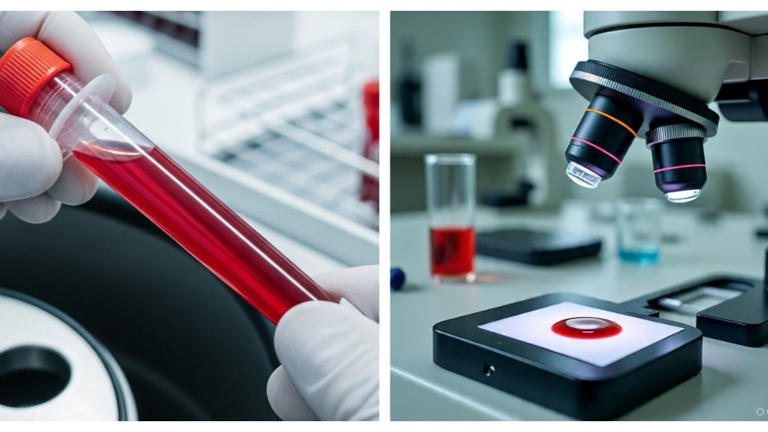
- 31 Jul 2025
In News:
- In a landmark discovery in transfusion science, researchers from India and the UK have identified a new and ultra-rare human blood group named CRIB, with the first case detected at the Rotary Bangalore TTK Blood Centre.
- The CRIB group adds to India’s growing contribution to rare blood immunogenetics and has been officially recognised by the International Society of Blood Transfusion (ISBT) and the International Blood Group Reference Laboratory (IBGRL), UK.
What is the CRIB Blood Group?
- CRIB stands for Cromer India Bengaluru and also symbolically refers to its importance in newborn and fetal medicine.
- It is a new antigen within the Cromer blood group system, which is linked to the Decay-Accelerating Factor (DAF) protein on red blood cells.
- CRIB belongs to the broader INRA (Indian Rare Antigen) blood group system, officially recognised in 2022 by the ISBT.
Discovery and Identification:
- Detected in a 38-year-old South Indian woman undergoing cardiac surgery in Kolar, Karnataka.
- Her blood was pan-reactive, reacting with all samples including O+ blood.
- No match was found even among 20 family members, leading to further analysis.
- After 10 months of genetic study at IBGRL, UK, a novel antigen was confirmed and designated as CRIB.
Scientific and Medical Significance:
- Rare Antigen Profile: Individuals with CRIB blood type lack a high-prevalence antigen, making compatible transfusions highly complex.
- Hemolytic Disease Risk: The CRIB antigen is especially relevant in Hemolytic Disease of the Fetus and Newborn (HDFN), where maternal antibodies attack fetal red blood cells.
- Global First: It is the first discovery of its kind globally, expanding the total number of known human blood group systems.
Implications for India and the World:
- Transfusion Protocols: Requires specialised matching and CRIB-negative donor identification, necessitating rare donor registries.
- Prenatal Care: Early screening could prevent complications in pregnancies involving blood group incompatibilities.
- Healthcare Infrastructure: Highlights the need for investment in genetic screening, rare blood banks, and pan-India awareness among healthcare professionals.
- Research Opportunities: Opens new areas of study in genomics, population diversity, and immune response in transfusions.
Next Steps:
- Development of CRIB-specific antibody panels and diagnostic tests.
- Integration into global and national blood group databases.
- Promotion of international collaboration in transfusion science and rare donor management systems.
Mera Gaon Mera Dharohar Programme

- 31 Jul 2025
In News:
The Mera Gaon Meri Dharohar (MGMD) initiative is a nationwide cultural mapping project launched by the Ministry of Culture on 27th July 2023 as part of the Azadi Ka Amrit Mahotsav. It operates under the National Mission on Cultural Mapping (NMCM) and is implemented by the Indira Gandhi National Centre for the Arts (IGNCA).
Key Highlights:
- Objective: To digitally document and preserve the intangible cultural heritage of all 6.5 lakh villages across India through a comprehensive virtual cultural portfolio.
- Current Status (as of 2025):
- Over 4.7 lakh villages have been culturally mapped.
- The data is accessible on the MGMD web portal.
- Thematic Categories: Each village is documented based on one or more of seven cultural themes:
- Arts and Crafts Villages
- Ecologically Oriented Villages
- Scholastic Villages (linked to texts and scriptural traditions)
- Epic Villages (associated with Ramayana, Mahabharata, Puranas, and oral epics)
- Historical Villages (linked to local or national history)
- Architectural Heritage Villages
- Other culturally significant villages (e.g., fishing, horticulture, pastoral communities)
Significance:
- Preservation of Heritage: Helps safeguard India’s diverse village-level traditions and practices.
- Cultural Inclusion: Recognizes lesser-known cultural narratives and identities.
- Rural Development: Encourages economic and artistic growth through cultural awareness.
- Digital Cultural Infrastructure: Enables access to cultural data via online platforms.
About National Mission on Cultural Mapping (NMCM)
Launched in 2017, the NMCM is a flagship initiative of the Ministry of Culture aimed at documenting and promoting India’s cultural diversity with a focus on grassroots-level heritage.
Key Components:
- Mera Gaon Meri Dharohar (MGMD) – Mapping of village-level cultural assets.
- Sanskritik Pratibha Khoj – Campaigns to discover artistic talent and promote folk and tribal arts.
- National Cultural Workplace (NCWP) – A digital platform and mobile app to create databases of artists, art forms, and cultural services.
This initiative strengthens India’s commitment to heritage conservation, digital documentation, and self-reliant cultural development, in line with Atmanirbhar Bharat.
Exercise Divya Drishti
- 31 Jul 2025
In News:
In July 2025, the Indian Army conducted Exercise Divya Drishti in East Sikkim, showcasing next-generation warfare technologies under high-altitude conditions.
Organised by the Trishakti Corps, the exercise focused on integrating Artificial Intelligence (AI) with battlefield surveillance and decision-making systems, in alignment with the Atmanirbhar Bharat initiative and the Army’s Decade of Transformation roadmap.
Key Features:
- AI-Enabled Battlefield Awareness: The Army deployed AI-integrated sensors capable of real-time surveillance, terrain mapping, and threat detection.
- Sensor-to-Shooter Linkage: Real-time data was transmitted from UAVs, drones, and ground-based sensors to command centres and firepower units, ensuring rapid response capability.
- UAV-Drone-Ground Synergy: Unmanned Aerial Vehicles (UAVs) and drones operated in coordination with ground platforms to simulate operational combat scenarios.
- Secured Communication Networks: Robust digital communication systems enabled seamless and secure data sharing across units.
- High-Altitude Readiness: The technologies were tested in the Himalayan terrain to assess their effectiveness in extreme operational environments.
Strategic Significance:
- Enhanced Situational Awareness: The exercise aimed to improve the Army’s capacity to observe, interpret, and act swiftly on the modern battlefield.
- Faster Decision-Making: AI integration minimizes command delays, improving response speed and operational precision.
- Indigenisation Drive: Demonstrates the Indian Army’s push for self-reliance in defence technology under Make in India.
- Future Warfare Doctrines: The insights will inform new operational strategies for multi-domain and hybrid warfare.
Operation Mahadev
- 30 Jul 2025
In News:
Indian security forces recently launched Operation Mahadev, a joint counter-terror operation near Srinagar, successfully neutralising three high-value terrorists, including Suleiman Shah, the mastermind behind the April 22 Pahalgam attack.
Key Facts about Operation Mahadev
|
Attribute |
Details |
|
Nature |
Precision anti-terror operation |
|
Launched By |
Indian Army (Para SF), CRPF, and J&K Police |
|
Command |
Strategically coordinated under the Chinar Corps |
|
Location |
Lidwas area, near Dara and Harwan, close to Dachigam National Park, Srinagar, Jammu & Kashmir |
Objectives and Outcomes
- Primary Aim: To neutralise Lashkar-e-Taiba-affiliated terrorists, specifically those involved in:
- Pahalgam attack (April 2024)
- Sonamarg Tunnel attack
- Notable Neutralised Terrorists:
- Suleiman Shah (main planner of Pahalgam attack)
- Two other Pakistan-trained terrorists, including a former Pakistani Army personnel
Strategic Significance
- Major blow to cross-border terrorism networks operating in Kashmir
- Reinforces India’s anti-terror posture, especially amidst the ongoing Operation Sindoor policy debate
- Enhances morale of security forces engaged in continuous counter-insurgency in the region
Paithani Sarees
- 30 Jul 2025
In News:
The Prime Minister recently highlighted the cultural and artisanal significance of Paithani sarees during the monthly ‘Mann Ki Baat’ radio programme, bringing national attention to this traditional Maharashtrian textile.
Historical Background
- Origin: Paithani sarees derive their name from Paithan, an ancient town on the banks of the Godavari River in Maharashtra.
- Antiquity: The tradition of Paithani weaving dates back over 2,000 years, with its roots in the Satavahana dynasty (2nd century BCE).
- Royal Patronage: These sarees were patronized by several royal courts, including the Satavahanas, Peshwas of Pune, Nizams of Hyderabad, and Mughal emperors.
Key Features
|
Attribute |
Description |
|
Material |
Woven using pure silk and gold/silver zari |
|
Technique |
Crafted using the tapestry weaving method, all handwoven |
|
Designs |
Intricate motifs like peacocks, parrots, lotuses, and floral vines |
|
Border & Pallu |
Known for distinctive kath (border) and padar (pallu) designs |
|
Size |
Typically six- or nine-yard sarees |
|
Cultural Significance |
Regarded as the ‘Mahavastra’ (great garment) of Maharashtra, traditionally worn by Maharashtrian brides |
Recognition and Cultural Value
- Symbol of Heritage: Paithani sarees are considered a symbol of Maharashtrian cultural identity and artisanal excellence.
- GI Tag: Granted the Geographical Indication (GI) tag in 2010, acknowledging their unique regional origin and craftsmanship.
- Artistic Value: Among the most exquisite and expensive sarees in India, valued for their aesthetic finesse and traditional techniques.
State of Food Security and Nutrition in the World (SOFI) 2025 Report
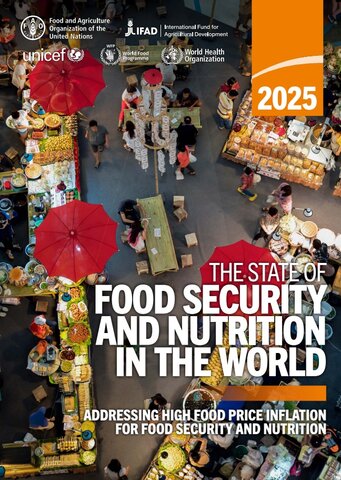
- 30 Jul 2025
In News:
Hunger affected up to 720 million people worldwide in 2024 — around 8.2 per cent of the global population, while 2.3 billion people in the world were estimated to have been moderately or severely food insecure, according to the ‘State of Food and Nutrition in the World’ (SOFI) 2025.
Key Highlights:
- Released by: Jointly published by FAO, IFAD, UNICEF, WFP, and WHO.
- Purpose:
- Annual global assessment to monitor progress on Sustainable Development Goal (SDG) 2:
- Target 2.1: End hunger and ensure access to safe, nutritious food.
- Target 2.2: End all forms of malnutrition.
Key Global Findings (2024 Data)
- Chronic Hunger:
- 720 million people (approx. 8.2% of global population) suffered from chronic hunger in 2024.
- Although lower than 8.5% (2023) and 8.7% (2022), it remains above pre-pandemic (2015) levels.
- 96 million more people are hungry now than in 2015.
- Food Insecurity:
- 2.3 billion people were moderately or severely food insecure in 2024.
- This is 335 million more than in 2019 (pre-COVID) and 683 million more than in 2015.
- Regional Distribution:
- Asia: 323 million undernourished (highest in absolute numbers).
- Africa: 307 million (highest prevalence, over 20% of population).
- Latin America & Caribbean: 34 million.
- Trends & Progress:
- Modest improvements in Southeast Asia, Southern Asia, and South America.
- Worsening hunger in parts of Africa and Western Asia due to conflict and climate stress.
Projections for 2030
- By 2030, 512 million people (6% of global population) may remain chronically undernourished.
- A decline of only 65 million since 2015, far short of the Zero Hunger target.
- 60% of these undernourished people are projected to be in Africa, with 17.6% prevalence.
India-Specific Insights
- Nutritional Affordability:
- 6% of Indians cannot afford a healthy diet despite food surplus.
- Urban areas show improvement due to post-pandemic income recovery.
- Rural areas face continued hardship due to PDS inefficiencies and price volatility.
- Child Malnutrition:
- High rates of stunting and wasting persist.
- Micronutrient deficiencies (hidden hunger) are common due to cereal-heavy diets lacking diversity.
- Policy Recommendations:
- Strengthen inclusion of millets, pulses, and fortified foods in public nutrition schemes.
- Address regional and demographic disparities through targeted interventions.
Major Drivers of Food Insecurity
- Post-COVID Aftermath: Reversed a decade of gains in global food security.
- Climate Events: Floods, droughts, and heatwaves have disrupted food systems.
- Conflicts & Wars: Ongoing wars (e.g. Ukraine) have triggered food price inflation and supply disruptions.
- Inflation:
- Since 2020, food price inflation has outpaced general inflation globally.
- Disproportionately affects low-income and vulnerable populations.
SOFI 2025: Recommendations
- Protect vulnerable populations via targeted fiscal support.
- Align macroeconomic policies to stabilize food markets.
- Invest in resilient agrifood systems and nutrition-sensitive agriculture.
- Strengthen food and nutrition data systems for informed policymaking.
- Promote dietary diversity and nutrition education.
SDG Context & Governance
- SDG 2 (Zero Hunger) is among the 17 UN Sustainable Development Goals adopted in 2015.
- These are non-binding, but serve as guiding principles for national policy and international cooperation.
- The SOFI report tracks progress annually against Targets 2.1 & 2.2.
- With only 5 years left to 2030, the current pace is inadequate for achieving global food and nutrition targets.
Gavri Festival
- 30 Jul 2025
In News:
Gavri is a unique 40-day ritualistic folk festival celebrated annually by the Bhil tribal community of the Mewar region in Rajasthan. It is a vibrant blend of dance, drama, music, and oral storytelling rooted deeply in the Bhil worldview, spirituality, and socio-cultural expression.
Key Features:
- Duration: 40 days, usually observed during the Hindu months of Shravana and Bhadrapada (July to September), coinciding with the monsoon and early harvest season.
- Form: A fusion of dance, drama (khel), mime, and dialogues.
- Theme: Enacts mythological battles between good and evil, primarily featuring Goddess Gauri/Amba and demons such as Bhasmasur or Bhiamwal, symbolizing the triumph of good.
- Performance Spaces: Villages where the performers' married sisters and daughters reside, reinforcing familial ties and social cohesion.
- Characters: All roles, including female ones, are portrayed by male performers, due to prevailing patriarchal norms.
- Narration: A storyteller called Kutkadiya introduces each scene, enhancing audience immersion.
- Costumes & Music: Colorful attire, energetic drumming, and folk instruments create a lively, theatrical atmosphere.
Cultural and Social Significance
- Spiritual Identity: The Bhil community considers themselves descendants of Lord Shiva and Goddess Parvati, viewing Parvati (Gauri) as their divine sister. Gavri is performed to honour her and ensure the well-being of their married women.
- Oral Heritage: The festival preserves centuries-old oral traditions, possibly dating back to the 3rd or 4th century CE, with references to the era of Siddhraj Jai Singh of Gujarat.
- Carnivalesque Spirit: Gavri subverts caste and class hierarchies through humor, parody, and satire. Authority figures, kings, and even gods may be lampooned in the plays.
- Resistance & Nature Worship: Performances like Badliya Hindwa and Bhilurana reflect themes of nature worship, tribal resistance to invaders (Mughals, British), and warnings against ecological destruction.
- Gender Fluidity: Though patriarchal in nature, the performance of female roles by men adds a layer of gender expression and cultural fluidity during the ritual.
Bhil Tribe: An Overview
- One of India's largest Adivasi groups, found mainly in Rajasthan, Gujarat, Madhya Pradesh, and Maharashtra.
- Speak the Bhili language and practice a syncretic faith combining animism with Hindu mythology.
- Their cultural identity is closely tied to forests, nature, and community-based rituals like Gavri.
Golden Jackal

- 30 Jul 2025
In News:
A recent citizen science study conducted by the Aranyakam Nature Foundation estimates that Kerala is home to approximately 20,000 to 30,000 golden jackals (Canis aureus naria), highlighting the species' wide distribution and adaptability across the state’s diverse landscapes.
Key Ecological Facts
- Scientific Name: Canis aureus
- Common Names: Golden Jackal, Common Jackal
- Physical Appearance: Medium-sized canid, smaller than a wolf and larger than a fox; coat ranges from golden to pale brown, varying seasonally.
- Behaviour: Primarily nocturnal in human-dominated areas; lives in monogamous pairs, often uses burrows or rock crevices for shelter.
- Diet: Omnivorous; consumes small mammals, birds, fish, insects, hares, fruits, and is known to scavenge near human settlements.
Habitat and Distribution
- Found in South, Southeast, and Central Asia, extending into Southeastern Europe and North-East Africa.
- In India, widespread from the Himalayan foothills to the Western Ghats, including Kerala, Maharashtra, Rajasthan, and Haryana.
- Preferred Habitats: Open lowland regions, especially below 200m elevation. In Kerala:
- Coconut groves (24%)
- Rural settlements (10%)
- Urban areas (5.6%)
- Rare in protected forest areas (only 2% of sightings)
Key Findings from Kerala Study
- Over 5,000 sightings were recorded across 874 villages, involving 2,200+ participants.
- High adaptability to human-modified landscapes such as peri-urban zones and coastal belts.
- Ecological Concerns:
- Rising cases of poultry predation
- Risk of rabies transmission
- Increasing dependence on organic waste, especially near coastlines
- Threat of hybridisation with stray dogs, posing genetic risks
Conservation Status
- IUCN Red List: Least Concern
- CITES: Appendix III
- Wildlife Protection Act, 1972 (India): Schedule I (highest protection under Indian law)
Veer Parivar Sahayata Yojana
- 29 Jul 2025
In News:
The National Legal Services Authority (NALSA), in a significant step toward safeguarding the legal rights of India’s uniformed forces, launched the Veer Parivar Sahayata Yojana during the North Zone Regional Conference in Srinagar. Themed “Reaffirming the Constitutional Vision of Justice for Defence Personnel and Tribals,” the event spotlighted the urgent need to institutionalize accessible legal assistance for military personnel and their families.
Rationale and Objectives
- Defence and paramilitary personnel frequently serve in remote, conflict-prone, or high-risk environments, which limits their ability to attend to civilian legal matters. Be it land disputes, family conflicts, service-related claims, or bureaucratic issues, legal hurdles can deeply affect their lives. The scheme acknowledges that a soldier stationed on the border cannot readily leave his post to handle legal proceedings back home.
- The Veer Parivar Sahayata Yojana is designed to bridge this critical gap by providing free, competent, and timely legal aid to serving personnel, veterans, and their families.
Key Features of the Scheme
- Joint Collaboration: The initiative is a joint effort between NALSA, the Kendriya Sainik Board (KSB), Rajya Sainik Boards (RSBs), and Zilla Sainik Boards (ZSBs) under the Department of Ex-Servicemen Welfare, Ministry of Defence.
- Legal Clinics Across Sainik Boards: Legal Services Clinics will be established at the district, state, and central levels of the Sainik Boards across India. These will function as the first point of contact for defence families seeking legal assistance.
- Trained Legal Volunteers: The initiative actively involves panel lawyers and trained paralegal volunteers, including ex-servicemen and defence family members, to offer legal services and counselling.
- Back-end Legal Infrastructure: A robust administrative mechanism will support the on-ground functioning of clinics and ensure prompt resolution of legal grievances.
- Coverage for Paramilitary Forces: The scheme will also extend support to paramilitary personnel from forces such as BSF, CRPF, ITBP, and others, who operate under similar hardships and isolation.
Significance and Constitutional Context
- The scheme upholds Article 39A of the Constitution, which mandates equal justice and free legal aid for all citizens. Defence personnel, who make immense sacrifices for national security, often remain underserved when it comes to civilian entitlements, rights, and dispute resolution.
- By reaffirming the constitutional commitment to access to justice, the scheme aligns with the broader goal of legal empowerment of vulnerable and marginalized communities, including those in service of the nation.
Deep Brain Stimulation (DBS)
- 29 Jul 2025
In News:
Over 1.6 lakh individuals globally have benefited from Deep Brain Stimulation (DBS)—a cutting-edge neurological procedure designed to manage complex brain disorders.
What is Deep Brain Stimulation?
DBS is a neurosurgical intervention wherein electrodes are surgically implanted into precise regions of the brain. These electrodes are connected via insulated wires to a pulse generator (similar to a pacemaker), typically placed under the skin near the collarbone.
The device delivers regulated electrical signals to targeted brain circuits. This helps modulate abnormal neural activity or restore disrupted brain function caused by neurological or psychiatric conditions.
How Does It Work?
- The implanted system sends mild, continuous electrical pulses to specific brain areas.
- These pulses help in stabilizing erratic electrical signals, which are often responsible for motor and cognitive dysfunctions.
- The stimulation does not destroy brain tissue and can be adjusted or turned off, offering reversibility unlike traditional ablative surgeries.
Clinical Applications of DBS
DBS has been widely adopted for treating movement disorders, especially when medications become ineffective:
- Parkinson’s Disease
- Essential Tremor
- Dystonia
Beyond motor disorders, DBS has received regulatory approval for use in certain psychiatric illnesses, such as: Obsessive-Compulsive Disorder (OCD)
Research is ongoing to explore its efficacy in conditions like:
- Severe Depression
- Epilepsy
Benefits of DBS
- Reversible and adjustable intervention
- Helps reduce motor symptoms such as tremors, stiffness, and rigidity
- Aims to normalize brain circuit functions at both micro (cellular) and macro (network) levels
- Offers hope in cases resistant to standard pharmacological therapies
Internal Complaints Committees

- 29 Jul 2025
In News:
The tragic case of a student’s self-immolation in Balasore, Odisha, in 2025, has brought renewed focus on the functioning of Internal Complaints Committees (ICCs) in India. The student, alleging sexual harassment by her Head of Department, had approached the college ICC, but her complaint was dismissed. Her family has alleged that the ICC was inadequately trained and biased in favor of the accused, exposing systemic flaws in India’s redressal mechanisms for workplace harassment.
This incident is a stark reminder that even a decade after the enactment of the Sexual Harassment of Women at Workplace (Prevention, Prohibition and Redressal) Act, 2013—popularly known as the POSH Act—the law’s implementation remains inconsistent and often ineffective.
Evolution of ICCs and the Legal Framework
1. Vishaka Guidelines (1997)
The foundation for workplace sexual harassment law in India was laid by the Supreme Court’s judgment in the Vishaka vs. State of Rajasthan (1997). The case stemmed from the gang-rape of Bhanwari Devi, a social worker who attempted to prevent a child marriage. The judgment led to the formulation of the Vishaka Guidelines, which:
- Defined sexual harassment at the workplace.
- Mandated Complaints Committees in institutions.
- Required these committees to be headed by a woman, have at least 50% female members, and include an external member to prevent internal bias.
However, these were non-binding guidelines and lacked statutory force.
2. POSH Act, 2013
The 2012 Nirbhaya gang-rape case spurred public demand for stronger gender-based protections, resulting in the enactment of the POSH Act, which gave legal backing to the Vishaka Guidelines. Key provisions of the POSH Act include:
- Mandatory establishment of Internal Complaints Committees (ICCs) at all workplaces with more than 10 employees.
- Creation of Local Complaints Committees (LCCs) at the district level to cover unorganized or small enterprises.
- ICCs are empowered to inquire, recommend disciplinary action, and facilitate criminal reporting when needed.
Structure and Powers of ICCs
Each ICC must have the following composition:
- Presiding Officer: A senior female employee.
- Two internal members: Preferably with legal knowledge or experience in social work.
- One external member: From an NGO or association committed to women's rights.
- At least 50% women members.
Functions and Powers:
- Can attempt conciliation if requested by the complainant.
- If not, must conduct an inquiry within 90 days.
- Can summon individuals and documents, with powers equivalent to a civil court.
- Can recommend disciplinary action to the employer if allegations are proven.
- The employer must assist the victim in pursuing a criminal complaint if desired.
- All proceedings and identities must be kept confidential.
Challenges in Implementation
Despite a clear legal mandate, the real-world functioning of ICCs has been fraught with systemic issues:
1. Poor Coverage
- Many institutions, especially in the private and informal sectors, have not constituted ICCs.
- Local Committees, intended to help informal workers, are either underreported or ineffective.
2. Inadequate Training and Bias
- ICC members often lack legal training or understanding of trauma-sensitive inquiry.
- As seen in the Balasore case, committees may favor senior male colleagues, reinforcing institutional power hierarchies.
- The absence of external accountability leads to compromised decisions.
3. Lack of Monitoring and Enforcement
- The Ministry of Women and Child Development is the nodal agency for the Act.
- But enforcement responsibility often lies with Labour and Industry Ministries, leading to fragmented oversight.
- The Supreme Court, in a 2024 review, described enforcement as “disquieting”, with serious lapses and poor record-keeping.
4. Breaches of Confidentiality
- There have been reports of identities being leaked, and complainants being stigmatized or retaliated against, violating the core principles of the Act.
Strengthening the POSH Mechanism
To ensure that the POSH Act fulfills its mandate, the following steps are critical:
- Universal Coverage and Registration:
- Mandate public disclosure of ICCs in all eligible institutions.
- Strengthen district monitoring mechanisms for both ICCs and LCCs.
- Capacity Building: Introduce mandatory training for ICC members on legal procedures, gender sensitivity, and trauma-informed handling.
- Robust Monitoring Framework:
- Enable centralized reporting portals for annual compliance.
- Conduct audits and periodic evaluations of ICC functioning.
- Accountability and Penalties:
- Impose penalties on employers for non-compliance or retaliatory action.
- Encourage whistleblower protections for witnesses and complainants.
- Public Awareness Campaigns: Inform women—especially in informal sectors—about their rights and the complaint mechanisms available to them.
Foot and Mouth Disease (FMD)
- 29 Jul 2025
In News:
- In July 2025, a concerning outbreak of Foot and Mouth Disease (FMD) led to the death of 16 spotted deer (chitals) at the Rajiv Gandhi Zoological Park in Pune, Maharashtra.
About Foot and Mouth Disease (FMD)
Nature of the Disease
- Foot and Mouth Disease (FMD) is a highly contagious viral infection caused by the aphthovirus from the Picornaviridae family.
- It affects cloven-hoofed animals, including cattle, buffaloes, goats, pigs, sheep, deer, and camelids.
- FMD is not zoonotic, i.e., it does not affect humans, and it poses no food safety risk.
Global and National Status
- FMD is classified as a Transboundary Animal Disease (TAD).
- It remains endemic in over 77% of the world’s livestock populations, particularly across Asia, Africa, and the Middle East.
- It severely disrupts livestock productivity, animal trade, and rural livelihoods.
Transmission and Symptoms
Transmission Routes
- Direct contact with infected animals.
- Indirect transmission through contaminated feed, equipment, vehicles, human movement, and airborne particles.
- Incubation period: 2–14 days.
- The virus can enter via inhalation, ingestion, or skin wounds.
Clinical Symptoms
- High fever lasting 2–3 days.
- Blisters and ulcers on the tongue, lips, hooves, teats, and mouth.
- Excessive salivation, lameness, and depression.
- Significant drop in milk production, weight loss, and growth retardation.
- In young animals, the disease can cause high mortality, while adults may suffer debilitating effects, affecting long-term productivity.
Strains and Immunity
- There are seven known strains of the FMD virus: A, O, C, SAT1, SAT2, SAT3, and Asia1.
- Immunity to one strain does not protect against others, making strain-specific vaccination critical.
Diagnosis and Institutional Infrastructure
- Confirmatory diagnosis is conducted through laboratory testing at premier institutes such as:
- ICAR-National Institute on Foot and Mouth Disease (NIFMD), Bhubaneswar
- Indian Veterinary Research Institute (IVRI), Bareilly
- National Institute of High Security Animal Diseases (NIHSAD), Bhopal
Government Interventions and Policies
National Animal Disease Control Programme (NADCP)
- Launched in 2019, the 100% centrally funded programme targets eradication of FMD and Brucellosis by 2030.
- Key components include:
- Mass vaccination
- Ear-tagging for traceability
- Cold chain infrastructure
- Disease surveillance and reporting
- Farmer awareness and community participation
Integrated Disease Management
- NADCP is aligned with the Livestock Health and Disease Control Programme (LHDCP).
- Several institutions like NIVEDI Bengaluru and Regional Disease Investigation Laboratories contribute to monitoring and outbreak control.
Preventive Strategies and Recommendations
To strengthen India's preparedness against FMD and other epizootics, the following measures are vital:
- Expand FMD Vaccination Coverage: Include zoo animals, wildlife reserves, and peri-urban livestock in regular vaccination drives.
- Strengthen Veterinary Surveillance: Ensure round-the-year disease surveillance, especially during weather extremes (monsoon and summer).
- Upgrade Infrastructure
- Expand testing capacity at regional levels.
- Deploy mobile diagnostic labs in remote zones.
- Raise Awareness: Educate livestock owners, zoo staff, and veterinary professionals about early symptoms, hygiene practices, and reporting protocols.
- Develop Strain-Specific Vaccines: Increase funding for R&D in strain identification and rapid-response vaccines.
- Leverage Technology: Use AI, GIS mapping, and data analytics to predict outbreaks and monitor disease spread.
Glacial Lake Outburst Floods (GLOFs)
- 29 Jul 2025
In News:
- In recent years, Glacial Lake Outburst Floods (GLOFs) have emerged as a critical concern in the Himalayan region, particularly affecting countries like India, Nepal, Bhutan, and China.
- The July 8, 2025, GLOF in Nepal—which washed away a China-built bridge and crippled hydropower plants supplying 8% of Nepal’s electricity—has drawn urgent attention to the increasing frequency and severity of such events.
- For India, especially in the Indian Himalayan Region (IHR), GLOFs pose an escalating risk to lives, infrastructure, and ecological systems due to climate change and unregulated development.
What is a Glacial Lake Outburst Flood (GLOF)?
A GLOF is the sudden, catastrophic release of water from a glacial lake—typically dammed by ice or moraine (glacial debris). The floodwaters often cause massive downstream destruction, marked by:
- Extremely high discharge volumes
- Destructive debris flows
- Short warning times
Types of Glacial Lakes in the Himalayas
- Supraglacial Lakes: Form on the surface of glaciers due to meltwater accumulation. Highly unstable during summer.
- Example: Cirenma Co in Tibet (1981), July 2024 Nepal GLOF.
- Moraine-Dammed Lakes: Form at glacier snouts, blocked by weak debris. Most vulnerable to outbursts.
- Example: South Lhonak (Sikkim), Tsho Rolpa (Nepal), Shako Cho (Sikkim)
Causes of GLOFs
Natural Triggers
- Glacial Retreat: Rising temperatures accelerate glacial melt, enlarging lakes.
- Ice or Rock Avalanches: Sudden falls into lakes displace water and rupture dams.
- Cloudbursts & Heavy Rainfall: Rapid rise in water levels increases pressure on dams.
- Seismic Activity: Earthquakes can destabilize moraine dams.
- Internal Piping: Seepage within dams weakens structural integrity over time.
Anthropogenic Factors
- Climate Change: Human-induced warming accelerates glacial melt.
- Unregulated Development: Construction near glacial zones—e.g., hydropower—exacerbates risk.
- Example: Teesta-III dam destruction in 2023.
Impacts of GLOFs
On Human Life and Infrastructure
- Casualties: Kedarnath (2013) and Sikkim (2023) GLOFs caused hundreds of deaths.
- Hydropower & Transport Damage: Washed-out roads, bridges, and dams; loss of electricity and connectivity.
- Displacement & Livelihood Loss: Long-term socio-economic disruption in affected regions.
On Environment
- River Course Changes & Silting: Raised riverbeds and reduced flood-carrying capacity.
- Teesta river rose several meters post-2023 flood.
- Habitat Loss & Biodiversity Decline: Ecological imbalance in alpine and riparian zones.
- Long-Term Ecosystem Stress: Sedimentation affects water quality and ecosystem resilience.
The Situation in India
India’s Himalayan arc—covering J&K, Ladakh, Himachal Pradesh, Uttarakhand, Sikkim, and Arunachal Pradesh—houses:
- 28,000 glacial lakes
- 7,500 lakes above 4,500 m altitude
- 11 major river basins
Yet, the region lacks sufficient monitoring infrastructure and early warning systems, primarily due to remoteness and hostile terrain.
Notable GLOF events:
- Kedarnath (2013): Triggered by cloudburst and glacial melt.
- South Lhonak (2023): Avalanche-triggered breach, damaging a $2 billion hydro project.
India’s Institutional Response to GLOF Risks
1. National Disaster Management Authority (NDMA) Initiatives
India has transitioned from reactive relief to proactive risk mitigation, through:
- National GLOF Programme: A ?150 crore initiative targeting 195 high-risk lakes.
- Committee on Disaster Risk Reduction (CoDRR): Coordinates central and state agencies, scientific institutions, and communities.
2. Five-Pronged Strategy
- Hazard Assessment: Classification of lakes by size, dam type, and downstream threat.
- Automated Weather & Water Stations (AWWS): Real-time monitoring (e.g., in Sikkim).
- Early Warning Systems (EWS): ITBP-led manual alerts; multilingual digital alerts in pilot stages.
- Engineering Interventions:
- Bathymetry and ERT scans
- Artificial channels and retention structures
- Community Engagement:
- Sensitization on religious and ecological concerns.
- Involving locals in scientific expeditions for credibility and access.
Technological Interventions
- SAR Interferometry: Satellite-based technique to detect micro-slope changes.
- Electrical Resistivity Tomography (ERT): Detects ice-cores under moraine dams.
- Unmanned Aerial Vehicles (UAVs): High-resolution terrain mapping.
- Remote Sensing: Tracks surface area growth of glacial lakes (but is post-facto).
Status of Mitigation Efforts
- Expeditions to 40 high-risk lakes in 2024 across J&K, Ladakh, HP, UK, Sikkim, and Arunachal Pradesh yielded positive outcomes.
- Installation of AWWS at lakes in Sikkim providing 10-minute interval data and daily lake imagery.
- ITBP trained for early alerts in absence of automated systems.
- More stations and expeditions are planned post-monsoon 2025.
Transboundary Challenges
- Many GLOF-prone lakes lie in Tibet, with rivers flowing into Nepal, Bhutan, and India.
- Nepal has faced multiple transboundary GLOFs recently (2024–25), with little to no warning from China.
- Example: July 8, 2025 GLOF from Tibet triggered floods in Nepal, destroying infrastructure.
- Past major GLOFs: Cirenma Co (1981), Dig Tsho (1985), Tama Pokhari (1998).
Policy Recommendations
- Strengthen Early Warning Systems: Expand AWWS and EWS coverage, integrate with mobile alerts.
- Transboundary Collaboration: Create shared protocols for upstream monitoring and data exchange with China, Nepal, and Bhutan.
- Integrate Climate Adaptation in Planning: Include GLOF risk in disaster risk reduction and infrastructure resilience planning.
- Ban Critical Infrastructure: Avoid siting major installations near vulnerable glacial zones.
- Promote Indigenous Technology: Invest in SAR, ERT, and AI-based modelling to predict GLOF risks.
- Community-Led Risk Reduction: Involve local populations in monitoring, response planning, and implementation.
Exercise Bold Kurukshetra 2025
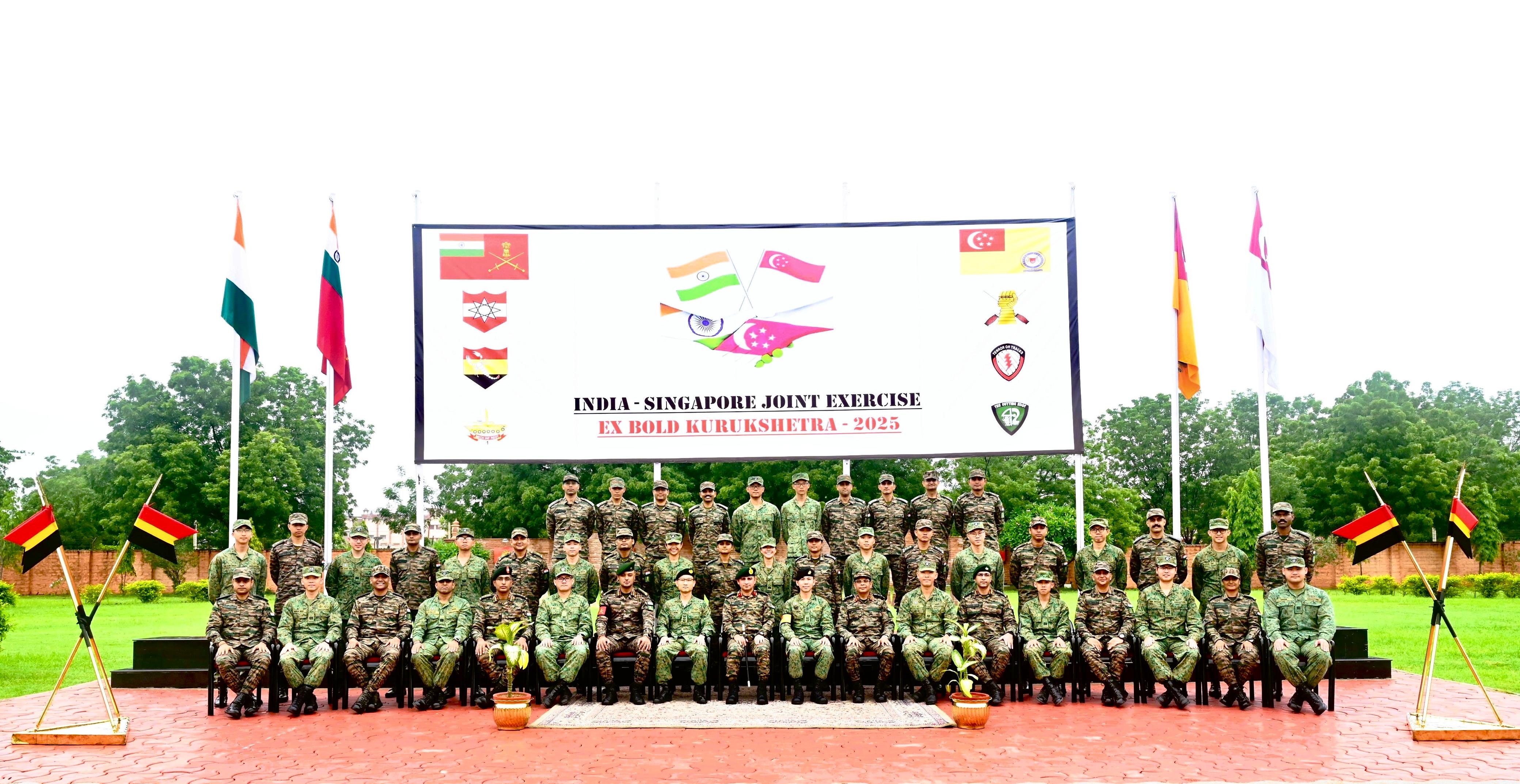
- 28 Jul 2025
In News:
The 14th edition of Exercise Bold Kurukshetra was commenced in Jodhpur, Rajasthan, reinforcing India–Singapore military ties. This bilateral military exercise is a key component of both countries’ growing defence cooperation.
About Exercise Bold Kurukshetra:
|
Feature |
Description |
|
Type |
Bilateral joint military exercise |
|
First Initiated |
2005 |
|
Edition |
14th edition (2025) |
|
Location (2025) |
Jodhpur, Rajasthan |
|
Duration |
28 July – 4 August 2025 |
|
Format |
Tabletop Exercise and Computer-Based Wargame |
|
Objective |
Enhance interoperability, validate mechanised warfare tactics, and simulate UN peacekeeping operations |
Participating Contingents:
|
Country |
Unit/Regiment |
|
India |
Mechanised Infantry Regiment |
|
Singapore |
42nd Armoured Regiment, 4th Singapore Armoured Brigade |
Key Features:
- Mechanised Warfare Focus: Validates joint operational tactics in modern armoured and mechanised operations.
- UN Mandate Simulation: Exercises conducted under simulated Chapter VII of the UN Charter, preparing both armies for peacekeeping and peace enforcement missions.
- Ceremonial Traditions: Enhances military camaraderie through shared symbolism and operational command handovers.
- Equipment Display: The exercise concludes with a display of Indian Army equipment, highlighting India's indigenous defence capabilities.
Strategic Significance:
|
Domain |
Contribution |
|
Defence Diplomacy |
Deepens bilateral military cooperation with Singapore |
|
Indo-Pacific Stability |
Enhances India’s strategic role in maintaining peace in the Indo-Pacific |
|
UN Peacekeeping |
Builds joint operational readiness for multinational UN-mandated missions |
|
Capacity Building |
Boosts joint planning and execution skills for mechanised combat environments |
Sohrai Art of Jharkhand
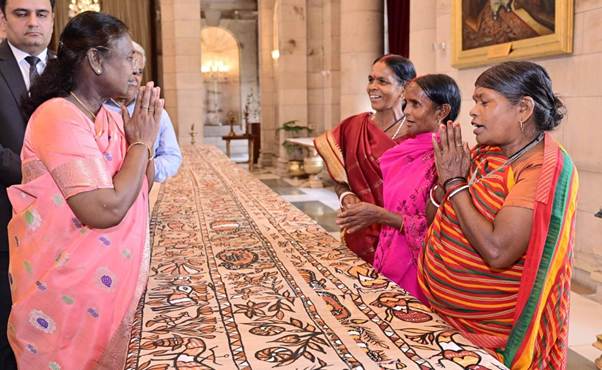
- 28 Jul 2025
In News:
Sohrai Art from Jharkhand was prominently showcased during Kala Utsav 2025 held at Rashtrapati Bhavan, where President Droupadi Murmu hailed it as reflecting the “soul of India.” The event marked a significant national recognition for this traditional tribal art.
About Sohrai Art:
|
Aspect |
Details |
|
Tribal Origins |
Practised by Santhal, Munda, and Oraon tribes in Jharkhand. |
|
Region |
Predominantly in Hazaribagh, Santhal Parganas, and parts of eastern Bihar. |
|
Occasion |
Ritual wall-painting during Diwali and harvest festivals. |
|
Purpose |
Thanksgiving for livestock and land fertility; linked to agrarian rituals and spiritual ecology. |
|
Artists |
Traditionally women; passed down through generations orally and practically. |
Key Features of Sohrai Art:
- Motifs: Stylized animals, birds, trees, and rural life, symbolizing harmony with nature.
- Materials: Uses natural pigments such as red ochre, white kaolin, yellow clay, and black manganese.
- Tools: Made with bamboo twigs, chewed sticks, and cloth instead of synthetic brushes.
- Cultural Essence: Embodies a blend of mythology, agrarian life, womanhood, and sustainability.
Kala Utsav 2025: National Recognition
- Held at Rashtrapati Bhavan as part of the Artists in Residence Programme.
- Ten tribal artists from Hazaribagh showcased their work to a national audience.
- President Murmu lauded the art as a symbol of India’s cultural depth and ecological consciousness.
Institutional Support: IGNCA’s Role
- Indira Gandhi National Centre for the Arts (IGNCA) and its Regional Centre in Ranchi coordinated artist participation.
- IGNCA continues to promote indigenous art forms, ensuring cultural preservation and artist recognition.
Cultural and Policy Relevance:
- Art & Culture: Highlights India’s rich tribal and folk heritage.
- Women Empowerment: Female-centric art practice promoting rural livelihoods.
- Sustainable Development: Use of eco-friendly materials and community-led traditions.
- Tribal Development Schemes: Aligns with objectives of schemes like TRIFED, GI tagging, and cultural promotion under Tribal Affairs Ministry.
Rajendra Chola I
- 28 Jul 2025
In News:
India is commemorating 1,000 years of Rajendra Chola I’s Southeast Asian expedition through cultural events and heritage projects.
Key Highlights:
Rajendra I Chola (r. 1014–1044 CE), son of Rajaraja I, was one of India’s most formidable monarchs, remembered for transforming the Chola Empire into a powerful naval and commercial force that extended influence far beyond the Indian subcontinent.
Background: Rise of the Chola Empire
- Imperial Cholas, based in Thanjavur, rose to prominence after Vijayalaya Chola captured the region around 850 CE.
- Successive rulers like Aditya I and Rajaraja I expanded the empire by defeating the Pallavas, Pandyas, and Rashtrakutas.
- Rajaraja I built the Brihadeeswarar Temple (1010 CE) and initiated overseas campaigns, laying the foundation for maritime expansion.
Rajendra I Chola’s Expansionist Vision
- Ascended the throne in 1014 CE, though anointed in 1012 CE.
- Sought to establish Chola supremacy across land and sea.
- Completed the conquest of Sri Lanka, capturing King Mahinda V and consolidating the southern frontier.
- Defeated the Western Chalukyas, Pandyas, Cheras, and Palas, earning the title Gangaikonda Chola (“the Chola who conquered the Ganges”).
New Capital – Gangaikondacholapuram
- To commemorate northern victories, Rajendra founded Gangaikondacholapuram, an imperial capital that served as a political, administrative, and cultural hub.
Naval Expeditions to Southeast Asia
Motivation:
- Establish maritime supremacy, protect trade routes, and forge strategic alliances.
- Respond to shifting alliances in Southeast Asia (Khmer Empire vs Srivijaya).
The Campaign (c. 1025 CE):
- Launched a massive naval expedition targeting the Srivijaya Empire (modern-day Indonesia, Malaysia).
- Conquered strategic regions like:
- Kadaram (Kedah)
- Pannai (Sumatra)
- Malaiyur (Malay Peninsula)
- Tambralinga, Pegu, and Kalingga
Significance:
- Asserted dominance over key trade routes to Song China.
- Cemented Chola-Khmer alliance.
- Extended Tamil commercial and cultural influence across Southeast Asia.
Commercial and Cultural Legacy
- Promoted merchant guilds such as Manigramam, Ayyavole, and Ainnurruvar, which flourished in overseas ports.
- Tamil inscriptions, artifacts, and temple architecture found across Indonesia, Malaysia, Cambodia, and China.
- Tamil loanwords persist in the Karo language of Sumatra.
- Contributed to a Tamil diaspora that influenced art, architecture, trade, and religion in Southeast Asia.
Military and Administrative Excellence
- Maintained a vast army and navy.
- Efficient administrative system with support from Krishnadeva Kendras (early research and extension centers).
- Built upon the model of divine kingship with Nataraja (Shiva as cosmic dancer) symbolizing spiritual legitimacy.
Global Recognition and Commemoration
- India’s training ship TS Rajendra, commissioned in 1972, honours his naval prowess.
- Chinese accounts from the 11th century describe the Chola court’s wealth, discipline, and grandeur.
- The Coromandel Coast derives its name from Cholamandala ("realm of the Cholas").
Conclusion
Rajendra I Chola stands out in Indian history as a maritime emperor, who not only expanded territorial frontiers but also projected Indian influence across Southeast Asia. His legacy lies in blending military conquests with trade diplomacy, and establishing cultural ties that endured for centuries. His reign marks one of the earliest and most successful examples of Indian soft power abroad.
Climate-Resilient and Organic Agriculture: Parliamentary Committee Report Highlights
- 28 Jul 2025
In News:
The Committee on Estimates (2024–25) has submitted its Sixth Report to Parliament, emphasizing the pressing need for a climate-resilient and ecologically sustainable agricultural system in India. The report presents a roadmap aimed at tackling the vulnerabilities posed by climate change, soil degradation, and unsustainable farming practices.
Key Challenges in Indian Agriculture:
1. Climate Vulnerability:
- Projected Yield Decline: Crop yields may fall by 4.5% to 9% in the medium term due to climate-induced stresses.
- District-Level Risks: Out of 310 climate-vulnerable districts identified by the IPCC,
- 109 are at ‘very high risk’,
- 201 are categorized as ‘highly vulnerable’.
2. Soil Health Crisis:
- Extent of Degradation: Nearly 30% of India's land suffers from soil degradation.
- Root Causes: Excessive chemical inputs (urea and pesticides) and loss of organic matter have disrupted nutrient cycles and reduced fertility.
3. Economic Pressures: The Green Revolution model now shows diminishing returns, with rising input costs contributing to farmer indebtedness and suicides.
Policy Shift Towards Sustainable Farming:
1. Natural Farming:
- National Mission on Natural Farming (NMNF): Launched in 2023–24 as an independent scheme, expanding upon the earlier Bhartiya Prakritik Krishi Paddati (BPKP).
- Focus: Chemical-free agriculture, soil regeneration, and farmer self-reliance.
2. Organic Farming Initiatives:
- Paramparagat Krishi Vikas Yojana (PKVY): Promotes cluster-based organic farming using Participatory Guarantee Systems (PGS) for certification.
- MOVCDNER: Aims to develop organic value chains in the North Eastern Region, leveraging traditional practices and rich biodiversity.
Challenges in Transition:
- Yield reductions during the initial switch.
- Complex and often expensive certification procedures.
- Weak market linkages and poor consumer awareness.
- Training and knowledge gaps among farmers.
- Financial risks for small and marginal farmers lacking safety nets.
Recommendations of the Committee:
- Integrate climate-resilient agriculture into national schemes like PM-KISAN, MGNREGA, and RKVY.
- Provide green subsidies to farmers offering ecological services.
- Establish a national agroecological transition framework combining research, training, and market access.
- Empower Krishi Vigyan Kendras (KVKs) with digital tools and decentralized funding for field-level implementation.
Scaling Up Climate-Resilient Strategies:
National Innovations in Climate Resilient Agriculture (NICRA):
- Launched: 2011 by the Indian Council of Agricultural Research (ICAR).
- Objective: Equip farming systems to adapt to climate variability.
Key Components:
- Strategic research on climate-tolerant varieties.
- Technology demonstrations in vulnerable districts.
- Capacity building for farmers and extension staff.
- Infrastructure enhancement at research institutions.
Notable Achievements in NICRA Villages:
- 2,900+ climate-resilient varieties developed (e.g., heat-tolerant wheat, drought-resistant rice).
- 28–37% rise in crop productivity.
- 10–12% increase in livestock productivity.
- 35–40% higher farm incomes compared to non-NICRA areas.
Way Forward:
- Expand NICRA initiatives to cover more vulnerable districts with dedicated funding.
- Create agroecological clusters to support localized natural/organic farming models.
- Simplify and support organic certification and branding to enhance marketability.
- Promote ministerial convergence among Agriculture, Environment, and Rural Development departments for cohesive implementation.
Environmental Flow (E-Flow) in Indian Rivers
- 28 Jul 2025
In News:
Union Jal Shakti Minister Shri C.R. Patil recently chaired a crucial meeting focused on the Environmental Flow (E-Flow) of the Ganga River and its tributaries, with particular attention to the Yamuna River. This initiative is a part of the broader effort to ensure the ecological sustainability of India’s river systems.
What is Environmental Flow (E-Flow)?
Environmental Flow refers to the quantity, timing, and quality of water flow necessary to sustain freshwater ecosystems and the livelihoods dependent on them. It ensures that rivers maintain their ecological integrity, supporting aquatic life, estuarine health, and human usage in a sustainable manner.
Why is E-Flow Important?
- Maintains ecological balance in rivers and estuaries.
- Supports aquatic biodiversity, especially key fish species.
- Provides long-term ecological and economic benefits.
- Balances human needs and environmental sustainability, especially in overexploited river basins.
Challenges in Maintaining E-Flow:
- Construction of dams and barrages.
- Pollution and urban encroachments.
- Over-extraction of water for agriculture and industry.
These interventions disrupt natural flow patterns, threatening riverine ecosystems and dependent communities.
Government Initiatives and Studies:
Environmental Flow Notification (2018):
- Introduced by the government to regulate minimum required flows in the Ganga. However, a review of its impact is now being undertaken to determine its effectiveness and the need for improvements.
Recent Meeting Outcomes:
- Emphasis on strengthening the e-flow framework, especially for the Yamuna River, which faces severe pollution and over-extraction issues.
- Need for a robust, inclusive, and scientific approach to water management.
Studies Approved Under National Mission for Clean Ganga (NMCG):
|
Institution |
Rivers/Sub-Basins Assigned |
|
NIH Roorkee |
Chambal, Son, Damodar |
|
IIT Roorkee |
Ghaghara, Gomti |
|
IIT Kanpur |
Kosi, Gandak, Mahananda |
These studies aim to assess current flow conditions and recommend sustainable flow levels.
Way Forward:
- Expedite assessments under NMCG and ensure multi-stakeholder participation.
- Develop comprehensive water flow strategies for heavily impacted rivers like the Yamuna.
- Strengthen decision-making frameworks to balance ecological and human needs.
Decline of Coral Reefs in Lakshadweep: A 24-Year Study

- 27 Jul 2025
In News:
A recent 24-year study (1998–2022) of coral reefs in the Lakshadweep Archipelago revealed that live coral cover has declined by nearly 50%, from about 37.2% to 19.1%. The research, conducted across three atolls—Agatti, Kadmat, and Kavaratti—highlights the severe impact of repeated marine heatwaves linked to climate change.
What are Corals?
Corals are small, soft-bodied marine invertebrates belonging to the Cnidaria group. Individual corals, called polyps, secrete a calcium carbonate exoskeleton, forming vast reef structures. Coral reefs provide crucial habitats for about 25% of marine life and support over 1 billion people worldwide with food, livelihoods, and coastal protection.
Types and Distribution:
India’s coral reefs are mainly found in the Gulf of Kutch, Gulf of Mannar, Andaman & Nicobar Islands, Lakshadweep Islands, and Malvan.
Causes of Coral Decline:
- Marine Heatwaves & Climate Change: Rising sea surface temperatures disrupt the symbiotic relationship between corals and their algae (zooxanthellae), causing bleaching and mortality.
- Ocean Acidification: Increased CO? lowers ocean pH, hampering coral skeleton formation.
- Pollution: Land runoff with fertilizers, pesticides, and heavy metals harms coral health.
- Physical Damage: Coastal development, sedimentation, and unsustainable fishing.
- Overfishing: Imbalance in reef ecosystems due to loss of algae-eating fish.
Key Findings from the Lakshadweep Study:
- Coral mortality from bleaching has decreased over time but so has the reefs’ recovery rate.
- Heat-sensitive coral species have largely disappeared, leaving more stress-tolerant species like Porites dominant.
- Recovery accelerates only if reefs are given at least a six-year gap between bleaching events.
- The 2010 marine heatwave was the most severe, with a Degree Heating Week (DHW) value of 6.7, indicating significant heat stress.
- The study emphasizes the need for longer recovery periods between bleaching for coral regeneration.
Implications for Conservation:
- The study provides a predictive framework to identify reefs vulnerable to bleaching and prioritize restoration.
- Local conservation must be combined with urgent global climate action to reduce the frequency of heatwaves.
- Without global intervention, even resilient coral species may not survive repeated disturbances.
This study underscores the vulnerability of India’s coral reefs, especially in Lakshadweep, to climate change and highlights the urgent need for integrated local and global conservation efforts.
ICJ Declares Clean Environment a Human Right
- 27 Jul 2025
In News:
In a historic advisory opinion delivered on 23rd July 2025, the International Court of Justice (ICJ) recognized the right to a clean, healthy, and sustainable environment as a fundamental human right. The opinion was issued at the request of the UN General Assembly (2023) following lobbying by Vanuatu and supported by over 130 countries, mainly small island developing states (SIDS) vulnerable to climate change.
Key Legal Questions Addressed:
- What are states’ obligations under international law to mitigate climate change?
- What are the legal consequences of failing to act on climate commitments?
Major Highlights of the ICJ Advisory Opinion:
1. Environment as a Human Right
- The Court affirmed that access to a clean, healthy, and sustainable environment is inherent to the enjoyment of other human rights.
- Based on customary international law, UNGA Resolution 76/300 (2022), and international human rights treaties.
2. Binding Legal Duties
- States are bound under UNFCCC, Kyoto Protocol, and Paris Agreement to:
- Implement mitigation and adaptation policies.
- Submit and update Nationally Determined Contributions (NDCs).
- Facilitate technology transfer and climate finance.
3. Due Diligence and Liability
- States must prevent significant transboundary environmental harm and regulate both public and private actors (e.g., fossil fuel companies).
- Failure to act amounts to an internationally wrongful act, triggering:
- Cessation,
- Guarantees of non-repetition,
- Compensation or restitution.
4. Historical Emissions & Responsibility
- The ICJ accepted that cumulative emissions can be legally attributed to specific states.
- Supports legal claims for reparations and accountability based on historic contributions to climate change.
5. Climate Obligations as Erga Omnes
- These duties are owed to the entire international community.
- Any state can seek enforcement, regardless of direct injury.
6. Scientific Attribution Accepted
- Climate science was admitted as legal evidence.
- Allows courts to establish causal links between emissions and environmental harm.
Geopolitical & Legal Implications:
- Empowers SIDS and developing nations in climate negotiations.
- Opens doors to domestic and international litigation based on environmental rights.
- Highlights inadequacy of current global agreements in ensuring timely climate action.
- Major emitters like USA and Russia have resisted legally binding obligations through courts.
Relevance for India:
- Reinforces Article 21 (Right to Life) and Article 48A (Protection of Environment) of the Indian Constitution.
- Can influence Indian courts and tribunals (e.g., NGT, Supreme Court) in:
- Air and water pollution cases,
- Waste management,
- Climate adaptation litigation.
This ruling marks a critical shift in international environmental law, signaling greater legal accountability for climate action and strengthening the legal foundation for future climate justice claims.
National Cooperation Policy 2025
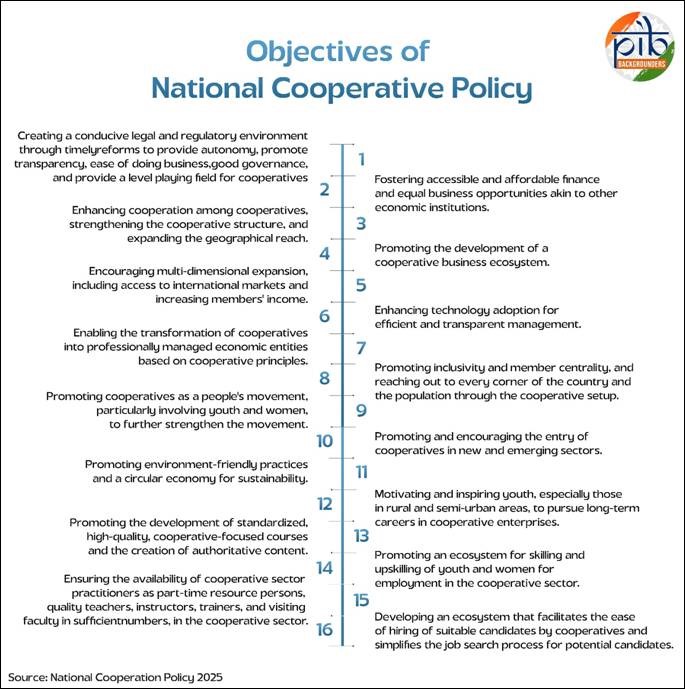
- 27 Jul 2025
In News:
- The National Cooperation Policy (NCP) 2025 marks a strategic roadmap for revitalizing India’s cooperative sector to meet the nation’s goal of becoming “Viksit” by 2047.
- Rooted in the ethos of Sahkar-se-Samriddhi, this policy aims to build on the unique strengths of India’s cooperative tradition, promote economic democratization, and uplift rural economies through collective participation.
- Mission: To create an enabling legal, economic, and institutional framework that will strengthen and deepen the cooperative movement at the grassroots level and facilitate the transformation of cooperative enterprises into professionally managed, transparent, technology-enabled, vibrant, and responsive economic entities to support production by the masses.
What is a Cooperative?
A cooperative is an autonomous association of persons, united voluntarily to meet their common economic, social, and cultural needs and aspirations through a jointly owned and democratically member-controlled enterprise.
Difference between Credit & Non-Credit Cooperatives
|
Aspect |
Credit Cooperatives |
Non-Credit Cooperatives |
|
Function |
Provide financial services like loans and savings |
Provide goods/services like farming inputs, housing, etc. |
|
Examples |
PACS, Urban Cooperative Banks |
Dairy, Marketing, Consumer, Housing Cooperatives |
The Indian cooperative movement has been the flag bearer of a participatory, people-led development model aimed at socio-economic upliftment at the grassroots level for more than a century.
Strategic Pillars:
The policy is structured around six mission pillars and 16 objectives:
- Strengthening the Foundation – Legal reforms, better governance, access to finance, digitalization.
- Promoting Vibrancy – Creating business ecosystems, expanding exports and rural clusters.
- Making Cooperatives Future-Ready – Technology integration, professional management, cooperative stack.
- Promoting Inclusivity and Deepening Reach – Promoting cooperative-led inclusive development and cooperatives as a people’s movement.
- Entering New and Emerging Sectors – Biogas, clean energy, warehousing, healthcare, etc.
- Shaping Young Generation for Cooperative Growth – Courses, training, employment exchanges.
Key Highlights of the Policy
Legislative and Institutional Reforms
- Encourage States to amend cooperative laws (Cooperative Societies Acts and Rules) to enhance transparency, autonomy and the ease of doing business.
- Promote digitalization of registrar offices and real-time cooperative databases.
- Revive sick cooperatives with institutional mechanisms.
Financial Empowerment
- Preserve and promote the three-tier Primary Agriculture Credit Societies - District Central Cooperative Bank - State Cooperative Bank credit structure.
- Promote cooperative banks and umbrella organizations (like National Urban Cooperative Finance & Development Corporation).
- Enable cooperative banks to handle government businesses.
Business Ecosystem Development
- Model cooperative villages with multipurpose PACS as growth engines.
- Encouraging States/UTs to develop at least one model cooperative village.
- Develop rural economic clusters (e.g., honey, spices, tea).
- Support branding under the ‘Bharat’ brand.
Model Cooperative Village
A Model Cooperative Village is a self-reliant rural unit developed through a cooperative-led, household-focused approach to enhance livelihoods and productivity.
Future-Readiness & Technology
- Develop a national ‘Cooperative Stack’ integrating with Agri-stack and databases.
- Promote Open Network for Digital Commerce (ONDC) and Government e-marketplace (GeM) platform integration.
- Encourage research and innovation through cooperative incubators and Centres of Excellence.
Open Network for Digital Commerce (ONDC)
The ONDC is a transformative initiative by the Department for Promotion of Industry and Internal Trade (DPIIT), Ministry of Commerce, Government of India aimed at democratizing digital commerce. Launched in April 2022, ONDC aims at promoting open networks for all aspects of exchange of goods and services over digital or electronic networks.
Government e-Marketplace (GeM)
GeM is an online platform for public procurement in India. The initiative was launched on August 09, 2016 by the Ministry of Commerce and Industry with the objective to create an open and transparent procurement platform for government buyers.
Inclusivity Measures
- Active participation of youth, women, SC/STs, and differently-abled in cooperatives.
- Model bye-laws for gender representation and transparent governance.
- Cooperative awareness campaigns in schools and colleges.
Model Bye-Laws
The Model Bye-laws are simply a representative sample and a guide to frame bye-laws of a multi-state cooperative society.
Sectoral Diversification
- Promote cooperatives in new and emerging sectors such as:
- Renewable energy,
- Waste management,
- Health and education,
- Mobile-based aggregator services (e.g., for plumbers, taxi drivers),
- Organic and natural farming,
- Biogas and ethanol production, etc.
Youth-Oriented Capacity Building
- Develop cooperative-focused courses in higher education institutions (HEIs).
- Build a national digital cooperative employment exchange.
- Promote financial and digital literacy among youth.
- Recruit quality cooperative teachers and resource persons.
Implementation and Monitoring
A robust multi-tier implementation structure is proposed:
- Implementation Cell within the Ministry of Cooperation with technical Project Management Unit support for effective and timely implementation of the policy.
- National Steering Committee on Cooperation Policy chaired by the Union Cooperation Minister will be constituted for overall guidance, inter-ministerial coordination, periodic policy review, etc.
- Policy Implementation and Monitoring Committee headed by the Union Cooperation Secretary for coordination with States, troubleshooting implementation bottlenecks, periodic monitoring and evaluation, etc.
India Skills Accelerator Initiative

- 27 Jul 2025
In News:
The Ministry of Skill Development and Entrepreneurship (MSDE), in collaboration with the World Economic Forum (WEF), deliberated on the “India Skills Accelerator” initiative.
Key Highlights:
- Launched by: Ministry of Skill Development and Entrepreneurship (MSDE)
- Collaborating Partner: World Economic Forum (WEF)
- Announced on: 8th April 2025 during a high-level roundtable at Kaushal Bhawan, New Delhi
- Objective: To strengthen India's skilling ecosystem through inclusive upskilling and reskilling, enhanced government-industry collaboration, and investment in lifelong learning, particularly in high-growth sectors such as Artificial Intelligence, robotics, and clean energy.
- Key Features:
- Public-Private Collaboration: Structured as a national platform bringing together government and private sector stakeholders; notably, 2 of the 4 co-chairs are from the private sector.
- Focus Areas:
- Promotes scalable and adaptive training models
- Facilitates agile career transitions for the workforce
- Aligns education and training with evolving industry demands
- Strategic Approach:
- Raising awareness and changing perceptions about future skills
- Encouraging cross-sectoral collaboration and sharing of best practices
- Reforming institutional frameworks to support a responsive and dynamic skilling system
- Significance: The initiative is aligned with India’s goal of building a future-ready workforce by addressing skill mismatches and preparing youth for rapidly transforming industries. It contributes to the broader national missions like Skill India, Digital India, and Make in India.
AI for India 2.0 Programme
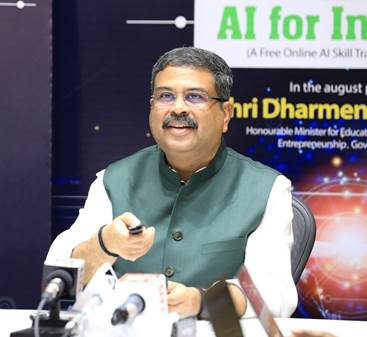
- 27 Jul 2025
In News:
The Minister of State (Independent Charge), Ministry of Skill Development and Entrepreneurship (MSDE), informed the Rajya Sabha about AI for India 2.0 Programme.
Key Highlights:
- Launched: 15th July 2023, on the occasion of World Youth Skills Day
- Implementing Bodies: Joint initiative by Skill India and GUVI (an ed-tech platform incubated by IIT Madras and IIM Ahmedabad)
- Accreditation: Recognized by NCVET and IIT Madras
- Objective: To democratize access to emerging technologies like Artificial Intelligence (AI) and Machine Learning (ML), especially among youth from non-English-speaking and rural backgrounds.
- Key Features:
- Free Online Training: Offers no-cost courses in AI and ML.
- Vernacular Focus: Educational content provided in 9 Indian languages including Hindi, Telugu, and Kannada, enhancing accessibility for non-English speakers.
- Target Audience: College students, recent graduates, and early-career professionals, with a focus on learners from rural regions.
- Course Content: Includes expert-curated Python programming courses designed to enhance technical proficiency.
- National Recognition: The programme is nationally accredited, ensuring quality and credibility.
- Significance: This initiative aims to empower the Indian youth by equipping them with industry-relevant digital skills, thus aligning with the broader goals of digital inclusion and skilling under Digital India and Skill India missions.
HOPS-315 Discovery
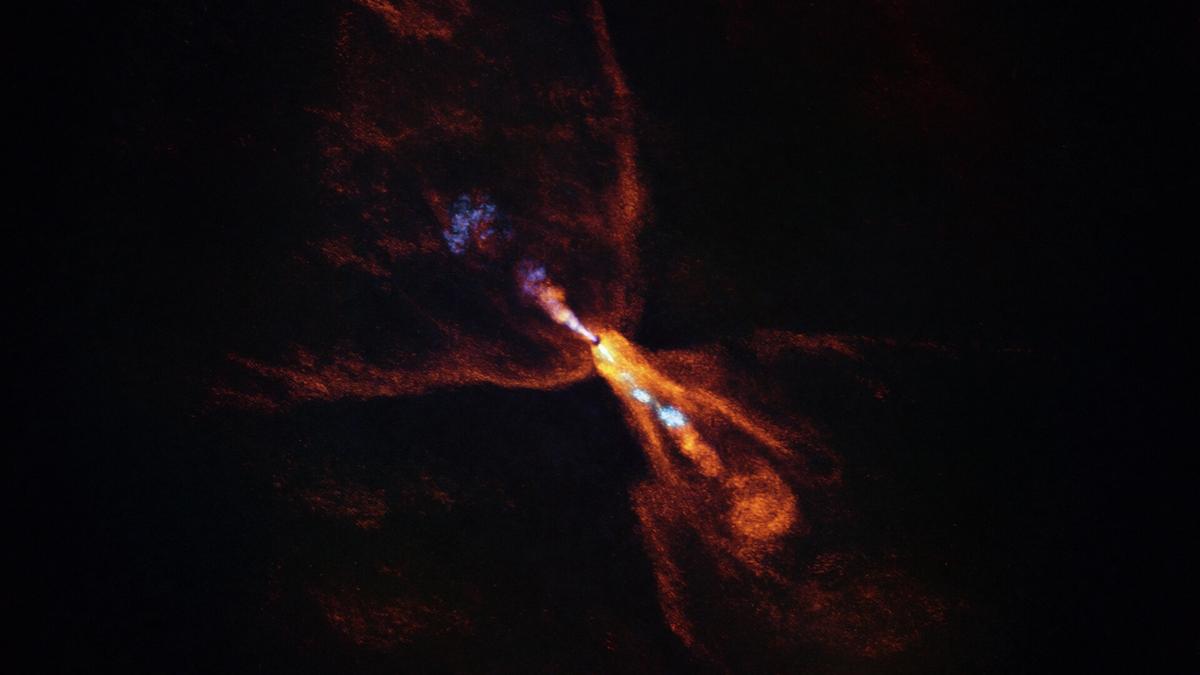
- 26 Jul 2025
In News:
Astronomers, for the first time, have observed solid rock condensation from vapor around a newborn protostar, HOPS-315, located in the Orion Molecular Cloud. This breakthrough offers unprecedented insight into the earliest stages of rocky planet formation, similar to how Earth likely formed.
About HOPS-315
- Type: Protostar (young, still-forming star)
- Location: Orion constellation (~1,300 light-years from Earth)
- Key Feature: Surrounded by a tilted protoplanetary disc of dust and gas, allowing deep observational access to its planet-forming region.
Instruments & Research Collaboration
- Telescopes Used:
- James Webb Space Telescope (JWST) – Spectral analysis via NIRSpec and MIRI instruments.
- Atacama Large Millimeter/submillimeter Array (ALMA) – Millimeter-wavelength mapping of gases and dust.
- Research Consortium: Scientists from France, the Netherlands, Sweden, Taiwan, and the USA.
- Published In: Nature (2025)
Key Observations & Findings
- Crystallization Process:
- Initial heating vaporizes dust (~1300 K near 1 AU from star).
- Subsequent cooling condenses vapor into refractory minerals (e.g., forsterite, enstatite, silica).
- Spectroscopic Evidence:
- Silicon monoxide (SiO) gas detected at ~470 K.
- Presence of crystalline silicates within 2.2 AU of the star — the zone where rocky planets typically form.
- ALMA Findings:
- Cooler gas in outer disc.
- Absence of slow SiO outflows confirms crystals are part of the disc atmosphere — not stellar jets.
Why It Matters
|
Significance |
Explanation |
|
First-Ever Observation |
Direct evidence of solid rock condensing from vapor around a protostar. |
|
Planet Formation Insight |
Confirms the earliest phase of rocky planet creation — from vapor to mineral solidification. |
|
Solar System Parallel |
Chemistry mirrors early Earth meteorites, suggesting universal mechanisms in rocky planet formation. |
|
Rare Viewing Geometry |
Tilted disc of HOPS-315 provided rare access to inner disc regions, usually obscured in other systems. |
National Sports Governance Bill 2025
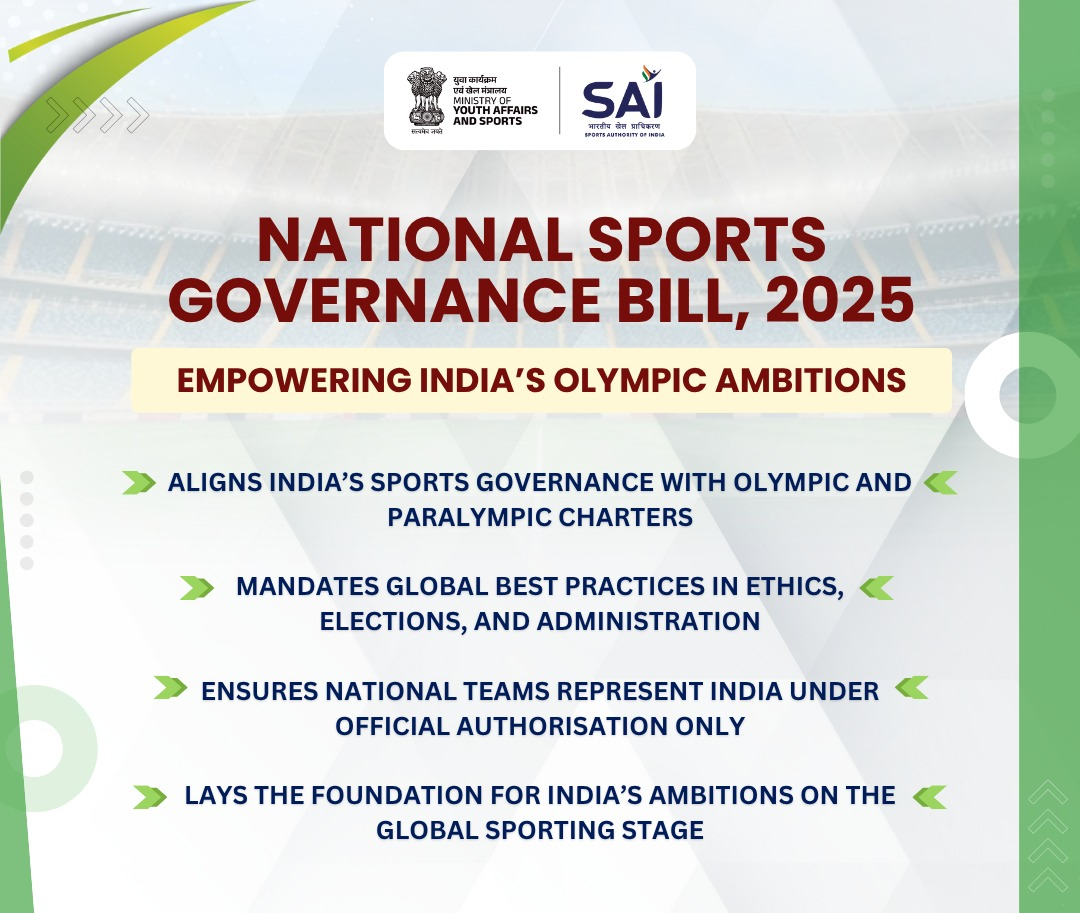
- 26 Jul 2025
In News:
The National Sports Governance Bill, 2025, introduced in the Lok Sabha, marks a significant legislative effort to restructure and reform India's sports administration framework. It seeks to replace the non-binding National Sports Code of 2011 with a statutory, enforceable law that prioritizes transparency, athlete welfare, and institutional accountability.
Key Objectives of the Bill
- Establish a uniform governance system across all sports federations.
- Legally regulate bodies like the Board of Control for Cricket in India (BCCI).
- Align Indian sports governance with international standards, particularly ahead of India’s 2036 Olympic bid.
- Introduce dedicated institutions for oversight, dispute resolution, and electoral transparency.
Major Structural Changes
1. Statutory Institutions Established
|
Institution |
Function |
|
National Sports Board (NSB) |
Recognition, funding eligibility, ethics compliance, and oversight of NSFs. |
|
National Sports Tribunal |
Dispute resolution (e.g., selection, elections, governance conflicts). |
|
National Sports Election Panel |
Ensures free, fair, and independent elections of sports bodies. |
Governance Reforms in National Sports Bodies
- Recognition & Regulation: All National Sports Federations (NSFs), including the BCCI, must seek annual recognition from the NSB.
- Affiliation: National bodies must have aligned state and district units, and comply with international federations' statutes.
- Code of Ethics: Mandatory for members, athletes, coaches, sponsors, and officials.
- Grievance Redressal: Internal mechanisms must be instituted by each federation.
Administrative Structure of National Bodies
- General Body: Equal representation from all affiliates and ex-officio members.
- Executive Committee: Maximum 15 members, mandatory inclusion of at least 4 women and 2 elite athletes.
- Age Limit: Officials must be aged 25–70 years (exceptions up to 75 years if permitted by international rules).
- Term Limit: Max three consecutive terms of four years in the same or different posts, with a cooling-off period.
Role of the National Sports Board (NSB)
The NSB acts as a central regulatory authority, similar to SEBI in financial markets.
Powers and Functions:
- Granting/suspending/canceling recognition of sports bodies.
- Investigating misuse of funds or violation of athlete welfare norms.
- Issuing guidelines for ethics, governance, and international compliance.
- Forming ad-hoc bodies in case of international de-recognition.
Composition: Chairperson and members with expertise in sports governance, law, and public administration. Appointed by the central government through a search-cum-selection committee.
National Sports Tribunal
A quasi-judicial body to resolve disputes involving federations, athletes, and administration.
Composition:
- Chairperson: Sitting/former Supreme Court Judge or Chief Justice of a High Court.
- Two expert members from sports, law, or public administration.
Appointed by: A committee comprising the Chief Justice of India (or nominee), the Law Secretary, and the Sports Secretary.
Appeals: Lie directly to the Supreme Court, except where international regulations mandate the Court of Arbitration for Sport (CAS) in Switzerland.
Jurisdiction Excludes: Disputes related to international sports events and internal matters of global sports bodies.
Electoral Oversight
A National Sports Election Panel will be constituted, comprising:
- Former Election Commissioners of India
- Former Chief Electoral Officers and Deputy Election Commissioners
Purpose:
- Supervise elections of executive committees of national federations.
- Ensure electoral integrity at the state and district levels via affiliate panels.
Legal Enforceability vs. Sports Code 2011
|
Parameter |
Sports Code 2011 |
Governance Bill 2025 |
|
Legal Status |
Advisory guidelines |
Statutory law |
|
Enforceability |
Non-binding |
Legally enforceable |
|
Gender/Athlete Representation |
Not mandated |
4 women & 2 elite athletes required |
|
Dispute Resolution |
Ministry-driven |
National Sports Tribunal |
|
BCCI Regulation |
Outside purview |
Brought under framework |
|
Election Oversight |
Ministry oversight |
Independent election panel |
|
RTI Applicability |
Exempt (BCCI) |
Mandatory for recognized bodies |
Bringing BCCI Under the Legal Framework
Historically resisting regulation, the BCCI will now be required to:
- Register annually with the NSB.
- Submit to the National Sports Tribunal for disputes.
- Comply with RTI Act provisions, if it seeks government recognition and funding.
This change is significant as cricket is now part of the 2028 Los Angeles Olympics, making BCCI subject to international governance norms under the Olympic Charter.
Provision for Exemptions
The central government may exempt specific sports bodies from certain provisions of the Bill, in the public interest or for the promotion of specific sports disciplines.
Parallel Legislation: Anti-Doping Amendment
The National Anti-Doping (Amendment) Bill, 2025 was also introduced, addressing World Anti-Doping Agency (WADA) concerns. It:
- Retains the National Board for Anti-Doping, but strips it of oversight over NADA.
- Restores NADA’s independence, aligning Indian anti-doping efforts with international norms.
Henley Passport Index 2025
- 26 Jul 2025
In News:
The Henley Passport Index 2025 reveals significant shifts in global mobility, highlighting increased visa-free access for citizens worldwide. India has made notable progress in the latest rankings, climbing eight places to reach the 77th position, up from 85th in 2024. Indian passport holders can now access 59 countries without a prior visa.
What is the Henley Passport Index?
The Henley Passport Index is a global ranking of passports based on the number of destinations their holders can enter without a visa or with visa-on-arrival. It is compiled by Henley & Partners using data from the International Air Transport Association (IATA). The index, started in 2006, now covers 199 passports and 227 travel destinations.
India’s Passport Performance:
- Current Rank (2025): 77th
- Visa-Free Access: 59 countries
- Previous Rank (2024): 85th
- Lowest Rank: 90th in 2021
- Best Rank: 71st in 2006
India's improved standing reflects enhanced global engagement and evolving diplomatic relations. However, it still trails far behind leading Asian and Western nations in terms of travel freedom.
Top 10 Most Powerful Passports (2025):
- Singapore – 193 visa-free destinations
- Japan, South Korea – 190 destinations
- Germany, France, Italy, Spain, Ireland, Denmark, Finland – 189 destinations
- Sweden, Austria, Belgium, Portugal, Netherlands, Luxembourg, Norway – 188 destinations
- Greece, Switzerland, New Zealand – 187 destinations
- United Kingdom – 186 destinations
- Australia, Czechia, Poland, Malta, Hungary – 185 destinations
- Canada, Estonia, United Arab Emirates (UAE) – 184 destinations
- Croatia, Latvia, Slovakia, Slovenia – 183 destinations
- United States, Iceland, Lithuania – 182 destinations
Note: The UAE is the only significant climber in the top 10, jumping from 42nd to 8th over the past decade.
Bottom 10 Least Powerful Passports (2025):
99. Afghanistan – 25 destinations
98. Syria – 27 destinations
97. Iraq – 30 destinations
96. Pakistan, Yemen, Somalia – 32 destinations
95. Libya, Nepal – 38 destinations
94. Bangladesh, Eritrea, Palestinian Territories – 39 destinations
93. North Korea – 40 destinations
92. Sudan – 41 destinations
91. Sri Lanka – 42 destinations
Global Trends in Passport Power:
- The global average of visa-free destinations has risen from 58 in 2006 to 109 in 2025, indicating increasing global mobility.
- Asian dominance continues, with Singapore, Japan, and South Korea topping the list.
- European Union countries maintain strong positions, reflecting widespread bilateral agreements.
- The United States and United Kingdom, once top-ranking, have seen a decline in influence. The US ranks 10th (182 destinations), while the UK stands at 6th (186 destinations).
- Afghanistan remains at the bottom of the list, with access to just 25 countries, highlighting stark global disparities in travel freedom.
Significance:
- The Henley Passport Index reflects soft power, diplomatic ties, and economic standing of nations.
- India's rising passport strength indicates improved bilateral relations, trade diplomacy, and international mobility.
National Critical Mineral Mission
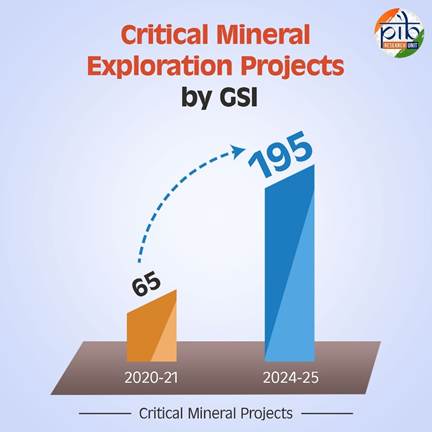
- 26 Jul 2025
In News:
The National Critical Mineral Mission (NCMM), launched by the Government of India in 2025, represents a strategic initiative to secure India's access to essential critical minerals, vital for clean energy, advanced electronics, defence, and emerging technologies. It aims to address India’s dependence on imports, strengthen domestic capacity, and build resilient supply chains.
What are Critical Minerals?
Critical minerals are those essential to economic development and national security, often marked by limited domestic availability and a high risk of supply disruption. These include lithium, cobalt, nickel, rare earth elements (REEs), graphite, and silicon, which are central to electric vehicles (EVs), solar panels, semiconductors, wind turbines, and defence applications.
Why NCMM? Strategic Context
- Energy Transition: India is 100% import-dependent for lithium, cobalt, and rare earths—crucial for EVs and energy storage.
- Tech Sovereignty: Strategic autonomy in AI, defence, and semiconductors depends on secure mineral access.
- Geopolitical Concerns: China controls 70–90% of global critical mineral processing. Diversifying supply chains is essential.
- Industrial Push: Schemes like PLI for EVs, electronics, and solar energy require a reliable mineral base.
- Climate Commitments: India aims to reduce emissions intensity by 45% (from 2005 levels) and reach net-zero by 2070.
Components of the National Critical Mineral Mission (NCMM)
Key Features of NCMM
1. Legal and Policy Framework
- Enacted under the Ministry of Mines in 2025.
- 30 critical minerals identified (24 inserted into Part D of the First Schedule of the MMDR Act, 1957).
- The Centre now has exclusive authority to auction mining leases for these minerals.
2. Domestic and Foreign Sourcing Targets (2024–2030)
|
Objective |
Target |
|
Domestic Exploration Projects |
1,200 |
|
Overseas Projects by PSUs |
26 |
|
Overseas Projects by Private Sector |
24 |
|
Recycling Incentive Scheme (in kilotons) |
400 |
|
Strategic Mineral Stockpile |
5 |
3. Capacity Building and Innovation
|
Objective |
Target |
|
Patents in Critical Mineral Tech |
1,000 |
|
Workforce Trained |
10,000 |
|
Processing Parks |
4 |
|
Centres of Excellence |
3 |
Sectoral Applications of Critical Minerals
- Solar Energy: Silicon, tellurium, indium, and gallium in photovoltaic cells; India’s solar capacity is 64 GW.
- Wind Energy: Neodymium and dysprosium in turbine magnets; target capacity: 140 GW by 2030.
- EVs: Lithium, nickel, cobalt in batteries; goal: 6–7 million EVs by 2024.
- Energy Storage: Lithium-ion battery storage systems; key for grid balancing and renewables.
Implementation Highlights
Exploration and Domestic Production
- 195 GSI projects launched in 2024–25, including 35 in Rajasthan.
- Over 100 mineral blocks identified for auction.
- Offshore exploration for polymetallic nodules (cobalt, REEs, nickel, manganese) underway.
- UNFC classification and MEMC Rules, 2015, guide the exploration methodology.
Asset Acquisition Abroad
- KABIL (Khanij Bidesh India Ltd):
- MoU with CAMYEN (Argentina) for lithium over 15,703 hectares.
- Ties with Australia for cobalt/lithium via Critical Mineral Office (CMO).
- Public–Private Partnership support via funding, MEA coordination, and guidelines for overseas investments.
Recycling and Circular Economy
- Incentives for mineral recovery from e-waste, fly ash, and tailings.
- Emphasis on building a formal recycling infrastructure.
- Current battery and electronics recycling sector is informal and lacks scale.
Processing and Midstream Infrastructure
- Development of dedicated Mineral Processing Parks.
- Encourage public–private partnerships and offer PLI-style incentives for refining technologies.
Challenges in India’s Critical Mineral Ecosystem
- High Import Dependence: 100% for lithium, cobalt, REEs.
- Underdeveloped Infrastructure: Lack of domestic refining, separation, and conversion capacity.
- Low Private Sector Participation: Technical and financial barriers deter participation.
- ESG Concerns: Mining zones often overlap with ecologically or tribally sensitive regions.
- Legal Bottlenecks: Environmental clearance delays due to weak ESG compliance.
- Informal Recycling Ecosystem: Fragmented, unregulated battery/e-waste recovery systems.
Strategic Roadmap Ahead
- Strengthen Exploration: Expand GSI capabilities; fund viability gap to attract investment.
- Diversify Global Sources: Engage in “friendshoring” with Australia, Argentina, U.S., etc.
- Build Midstream Capacity: Set up refining zones, mineral parks, and conversion units.
- Sustainable and Inclusive Mining: Implement ESG mandates and tribal welfare frameworks.
- Enhance Circular Economy: Provide tax breaks and subsidies for high-efficiency recovery systems.
Institutional Support
- IREL (India) Limited:
- Produces ilmenite, zircon, sillimanite, and rare earths.
- Operates Rare Earth Extraction Plant (Chatrapur, Odisha) and Refining Unit (Aluva, Kerala).
- Profitable PSU with ?14,625 million turnover (2021–22), including ?7,000 million exports.
Conclusion
India's National Critical Mineral Mission (NCMM) is pivotal for achieving strategic autonomy, industrial growth, and clean energy goals. By integrating domestic exploration, international partnerships, midstream processing, recycling, and regulatory reform, NCMM lays the foundation for a resilient and self-reliant mineral ecosystem. Its success is critical for India’s leadership in green technologies, manufacturing, and strategic geopolitics—making it a cornerstone initiative under Atmanirbhar Bharat and India's 21st-century industrial vision.
India–UK Comprehensive Economic and Trade Agreement (CETA)
- 26 Jul 2025
In News:
India and the United Kingdom signed the Comprehensive Economic and Trade Agreement (CETA) in July 2025, marking a landmark Free Trade Agreement (FTA) between India and a major developed economy. The agreement is part of the broader India–UK Vision 2035, aiming to strengthen bilateral ties across trade, technology, defence, climate, and education.
Key Features of CETA
1. Trade in Goods
- Zero-duty access for 99% of Indian exports to the UK, covering major sectors:
- Labour-intensive: textiles, leather, footwear, gems & jewellery, toys, marine products.
- High-growth: auto components, engineering goods, organic chemicals.
- Improved access for Indian agricultural products (tea, spices, coffee, fruits, meats) to UK’s $63.4 billion agri-market (dairy excluded).
2. Trade in Services
- First-of-its-kind comprehensive services commitment by the UK.
- Expands Indian access in: IT/ITeS, financial & legal services, architecture, education, telecom, consulting, and engineering.
3. Labour Mobility
- Liberalised visa norms for:
- Contractual Service Suppliers
- Intra-Corporate Transferees
- Independent Professionals (e.g. chefs, yoga instructors, musicians)
- Double Contribution Convention (DCC):
- Exempts Indian professionals and their employers from UK social security contributions for up to 3 years.
4. Inclusive Growth
- Benefits designed for MSMEs, women entrepreneurs, artisans, farmers, and startups.
- Provisions include:
- Dedicated SME contact points
- Digital trade facilitation
- Paperless customs
India–UK Vision 2035: 5 Strategic Pillars
1. Growth and Jobs
- Target: Double bilateral trade from USD 56 bn to USD 112 bn by 2030.
- Initiatives:
- New Bilateral Investment Treaty (BIT)
- UK–India Infrastructure Financing Bridge
- British International Investment (BII)
- Regulatory harmonisation in legal and financial services.
2. Technology and Innovation
- Focus Areas: AI, 6G, semiconductors, biotech, cybersecurity, biomaterials.
- Key Initiatives:
- Joint AI research centre
- India–UK Critical Minerals Guild
- Startup collaboration via incubators and biofoundries.
3. Defence and Security
- Launch of 10-Year Defence Industrial Roadmap: R&D in electric propulsion, underwater warfare, directed energy weapons.
- Deepening:
- 2+2 Ministerial Dialogue
- Military exercises, intelligence sharing
- Indian Ocean logistics cooperation
4. Climate and Clean Energy
- Areas of Collaboration: Offshore wind, small modular nuclear reactors (SMRs), carbon markets, blue carbon research.
- Joint commitment to:
- International Solar Alliance (ISA)
- One Sun One World One Grid (OSOWOG)
- Net Zero Innovation Partnership
5. Education and People-to-People Ties
- UK universities allowed to open campuses in India.
- Launch of dual degree programmes, mutual qualification recognition.
- Young Professionals Scheme for career mobility.
- Green Skills Partnership to bridge climate tech skill gaps.
Strategic Importance for India
|
Sector |
Impact |
|
Economy |
Enhances export potential, promotes Make in India, and attracts FDI. |
|
Employment |
Boosts jobs in textiles, IT, food processing, and engineering. |
|
Mobility |
Facilitates professional migration and global exposure. |
|
Technology |
Drives domestic innovation in AI, semiconductors, climate tech. |
|
Defence |
Supports self-reliance in high-tech military R&D. |
|
Climate Action |
Aids India’s Net Zero goals via access to green finance and clean energy tech. |
|
Global Positioning |
Strengthens India’s influence in WTO, UN, IMF, and other multilateral fora. |
Paika Rebellion (1817)
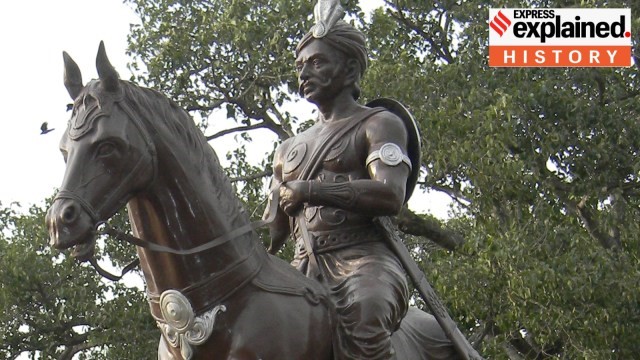
- 25 Jul 2025
In News:
The recent exclusion of the Paika Rebellion of 1817 from NCERT’s Class VIII history textbook triggered political backlash in Odisha. Former Chief Minister Naveen Patnaik termed the omission a “huge dishonour” to the Paika warriors, prompting NCERT to clarify that the topic would be included in the second volume of the textbook to be released later in 2025.
Who were the Paikas?
- The Paikas (literally "foot soldiers") were military retainers traditionally employed by the Gajapati kings of Odisha since the 16th century.
- In exchange for military service, they were granted hereditary rent-free lands (nish-kar jagirs), which they cultivated during peacetime.
- Under British rule, their privileges eroded, and they faced land dispossession, economic hardship, and social marginalisation.
Background to the Revolt
- In 1803, the British East India Company annexed Odisha. Colonel Harcourt marched from Madras to Cuttack, defeating feeble Maratha opposition.
- A deal with King Mukunda Deva II of Khurda promised ?1 lakh and four parganas (Lembai, Rahanga, Surai, Chabiskud) for safe passage, but the British defaulted.
- Jayee Rajguru, the king’s adviser, mobilised 2,000 Paikas to confront the British. Though part payment was made, the parganas were not returned.
- Rajguru was arrested and executed on 6 December 1806 for waging war against the British. The king was dethroned and exiled, and the Barunei Fort was demolished.
Causes of the Paika Rebellion
- Loss of Traditional Privileges:
- Confiscation of rent-free lands after British land settlements.
- End of royal patronage.
- Land Alienation & Tax Burden:
- Local Odia landowners were forced to sell land to Bengali absentee landlords.
- Revenue demands shifted to rupee payments, affecting marginal farmers and tribal communities.
- Salt Monopoly & Trade Restrictions: British control over salt trade, particularly after 1814, increased hardship for inland hill populations.
- Cultural and Political Suppression: The decline of local leadership and traditions under colonial authority contributed to growing dissent.
Course of the Rebellion (1817)
- In March 1817, approximately 400 Kondh tribal fighters from Ghumusar marched toward Khurda.
- They were joined by Bakshi Jagabandhu Bidyadhar, the former commander-in-chief of Khurda and ex-holder of the Rodanga estate.
- The rebels:
- Attacked the police station at Banpur
- Burned colonial buildings
- Looted the treasury
- Killed several British officials
- The rebellion spread across southern and central Odisha. Despite initial successes, the British suppressed the revolt.
- Jagabandhu evaded capture for years and surrendered in 1825 under negotiated terms.
Contemporary Significance and Political Debate
- The Paika Rebellion is widely regarded in Odisha as an early expression of anti-colonial resistance.
- In 2017, the Odisha government demanded that the uprising be recognised as the “First War of Independence”, predating the 1857 revolt.
- The Union Government, while not granting this status, acknowledged it as one of the early popular uprisings against colonial rule.
- National Recognition Efforts:
- In 2017, PM Narendra Modi felicitated over 200 descendants of Paika rebels.
- In 2019, President Ram Nath Kovind laid the foundation for a Paika Memorial at Barunei foothills, the rebellion’s epicentre.
- In 2024–25, the new BJP-led government in Odisha announced fast-tracked development of the Paika Academy and Memorial.
U.S. withdraws from UNESCO for the third time

- 25 Jul 2025
In News:
In 2025, the United States announced its decision to withdraw from the UNESCO, citing perceived bias against Israel. This move comes just two years after rejoining the organization in 2023 and marks the third U.S. exit, and the second under the Trump administration.
What is UNESCO?
- Full Form: United Nations Educational, Scientific and Cultural Organization
- Founded: 16th November 1945
- Headquarters: Paris, France
- Membership: 194 Member States and 12 Associate Members
- India's Role: A founding member of UNESCO
Mandate and Key Functions
- Education: Promote inclusive and equitable lifelong learning (aligned with SDG 4)
- Culture: Safeguard tangible and intangible cultural heritage through tools like the World Heritage List
- Science: Advance climate science, AI ethics, and sustainable development
- Global Understanding: Foster mutual respect, peace, and international cooperation
Timeline of U.S. Exits from UNESCO
|
Year |
Administration |
Reason for Exit |
|
1984 |
Reagan |
Accusations of mismanagement and pro-Soviet bias |
|
2017 |
Trump (1st Term) |
Alleged anti-Israel bias after Palestine was accepted as a member in 2011 |
|
2025 |
Trump (2nd Term) |
Continued allegations of bias; exit scheduled by December 2026 |
- Rejoined: Under Biden Administration in 2023
Global Implications of U.S. Withdrawal
1. Financial Consequences
- The U.S. was a major contributor to UNESCO.
- Its exit leaves a budget deficit, affecting:
- Education initiatives
- Cultural heritage projects
- Climate and AI research
- Past example: U.S. and Israel froze funding after Palestine’s admission in 2011.
2. Geopolitical Rebalancing
- China’s influence may expand in UNESCO’s absence, potentially altering agendas and narratives.
- Risk of geopolitical polarization in multilateral agencies.
3. Weakening of Multilateralism
- Unpredictable U.S. engagement weakens global cooperation mechanisms.
- Undermines trust and support for UN agencies, especially in developing countries.
4. Impact on Science and Education
- Reduced backing for global programs in:
- STEM education for girls
- AI ethics frameworks
- Climate change awareness and mitigation
Implications for India
Opportunities
- Diplomatic leverage: Greater voice in shaping global agendas on education, AI, and heritage.
- Soft power expansion: Through advocacy for Indian culture and World Heritage nominations.
- South-South cooperation: Leadership in global education and sustainable development dialogue.
Challenges
- Funding constraints could affect:
- Ongoing Indian UNESCO projects (e.g., Nalanda, Sundarbans)
- Educational programs in rural/tribal regions
- Increased pressure on India to contribute more financially
- Rising Chinese influence could marginalize India’s strategic interests
Long-Billed Bush Warbler
- 25 Jul 2025
In News:
In a significant ornithological event, a team of birders has confirmed the first Indian sighting in 46 years of the elusive Long-billed Bush Warbler (Locustella major). The bird was observed in dense willow thickets at an altitude of over 3,200 metres in Suru Valley, Ladakh.
About Long-Billed Bush Warbler
- Scientific Name: Locustella major
- Common Name: Long-Billed Bush Warbler (formerly Long-billed Grasshopper Warbler)
- Type: Medium-sized, skulking songbird of the bush warbler group
- Size: Approximately 15–17 cm in length
- Plumage:
- Brownish-olive upperparts with fine streaking
- Pale underparts (whitish or buff)
- Both sexes appear similar
- Call: Produces an insect-like clicking sound used for territory marking and mate attraction
Distribution and Habitat
- Global Range:
- Limited distribution in the mountains of Central Asia
- Documented in India, Pakistan, China, and Tajikistan
- Preferred Habitat:
- Altitude: 2,400–3,600 metres
- Found on grassy slopes with bushes and weeds
- Upland terraced cultivation and forest edge clearings
- Often observed among Rumex, sea buckthorn, and Ribes gooseberry shrubs near spruce forests
Conservation Status
- IUCN Red List: Near Threatened (NT)
- Reasons for decline include habitat loss, especially due to conversion of bushland into agricultural fields.
Significance of the 2025 Sighting
- The last confirmed Indian record was in 1979 near Sankoo in Kargil, by researchers from Southampton University.
- Historically, the species was relatively common in Dras and Suru valleys until the early 20th century.
- The recent sighting aligns with records from nearby Gilgit-Baltistan (2022–2025), where the species has been increasingly documented at similar altitudes (3,000–3,100 m).
Preah Vihear Temple Dispute
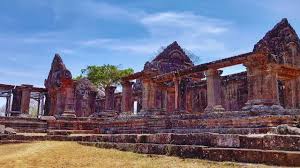
- 25 Jul 2025
In News:
Tensions between Thailand and Cambodia have sharply escalated in recent months, marked by armed clashes, airstrikes, and diplomatic fallout, all centering around the Preah Vihear Temple—a centuries-old Hindu monument of immense cultural and geopolitical significance.
About Preah Vihear Temple
- Location: Preah Vihear Province, northern Cambodia, atop a cliff in the Dangrek Mountain range, near the Cambodia–Thailand border.
- Religious Affiliation: Hindu temple dedicated to Lord Shiva.
- Historical Background:
- Constructed during the Khmer Empire, primarily in the 11th and 12th centuries.
- Key patrons: King Suryavarman I (1002–1050) and King Suryavarman II (1113–1150).
- UNESCO World Heritage Site: Inscribed in 2008 for its exceptional architectural and historical value.
Architectural Features
- Exemplifies Khmer temple architecture with a linear arrangement of sanctuaries linked by pavements and staircases over an 800-metre-long axis.
- Contains over five gopuras (monumental gateways) connected by a raised path and tiered platforms.
- Mixture of stone and wooden roofing, though many structures are partially in ruins.
Territorial Dispute Overview
- Historical Basis:
- Dispute stems from differing interpretations of a 1907 French map, which placed the temple inside Cambodian territory.
- Thailand disputes the map, arguing lack of formal acceptance.
- International Court of Justice (ICJ) Rulings:
- 1962: ICJ ruled the temple belongs to Cambodia, citing Thailand’s implicit acceptance of the 1907 map.
- Thailand was ordered to withdraw troops and return artifacts taken since 1954.
- 2013 (Reaffirmation): ICJ clarified that surrounding areas—particularly a 4.6 sq. km. disputed zone—also belong to Cambodia.
Major Flashpoints in the Conflict
- 2008: Cambodia registers Preah Vihear as a UNESCO World Heritage Site, triggering nationalist backlash in Thailand.
- 2008–2011: Border skirmishes escalate, culminating in a 2011 clash that killed at least 15 people.
- 2025 Escalation:
- Renewed violence erupted in July 2025, after a series of provocations:
- May 2025: Cambodian soldier killed.
- July 2025: Two Thai soldiers injured in landmine blasts.
- July 24, 2025: Armed conflict intensifies—Thai airstrikes target Cambodian positions near the temple.
- Casualties: At least 9 civilians killed, 14 injured in Thai provinces bordering Cambodia.
- Both nations expelled ambassadors and blamed each other for violations of sovereignty.
- Renewed violence erupted in July 2025, after a series of provocations:
Significance of the Dispute
- Cultural: Preah Vihear is a sacred site and national symbol for both nations.
- Strategic: Its location atop a cliff offers military advantage and control over surrounding terrain.
- Diplomatic: The temple remains a fault line in bilateral ties, with unresolved territorial claims despite multiple ICJ verdicts.
Palna Scheme
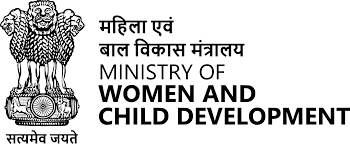
- 25 Jul 2025
In News
Launched by the Ministry of Women and Child Development (MoWCD) under the Samarthya vertical of Umbrella Mission Shakti, the Palna Scheme aims to provide safe, accessible, and quality day care (crèche) facilities for children aged 6 months to 6 years across all States and Union Territories, effective from 1st April 2022.
Key Features:
- Objective: To support working mothers by providing crèche services ensuring:
- Safety and well-being of children
- Nutritional support
- Early childhood care and cognitive development
- Health check-ups, growth monitoring, and immunization
- Target Beneficiaries: All children aged 6 months to 6 years. Services are irrespective of mothers' employment status, covering both organized and unorganized sectors.
- Types of Crèches:
- Standalone Crèches
- Anganwadi-cum-Crèches (AWCCs)
Anganwadi-cum-Crèche (AWCC) Model
- Utilizes existing Anganwadi Centres, the world’s largest public childcare infrastructure, to provide full-day childcare services.
- Ensures last-mile delivery of services in a safe and secure environment.
- Supports women’s workforce participation by relieving unpaid childcare burden.
Timings & Flexibility
- Crèches to operate for 26 days/month and 7.5 hours/day, with timings adapted to local needs.
- States/UTs may adjust timings under Standard Operating Procedures based on community work patterns.
Funding Pattern
|
Category |
Centre:State Funding Ratio |
|
General States |
60:40 |
|
North Eastern & Special Category States |
90:10 |
|
UTs with Legislature |
60:40 |
|
UTs without Legislature |
100% Central Assistance |
Integrated Services Offered
- Day care and sleeping facilities
- Early stimulation for children below 3 years
- Pre-school education for 3–6 years
- Supplementary nutrition (locally sourced)
- Growth monitoring, health check-ups & immunization
Implementation Status (As of July 2025)
- Total Envisioned AWCCs (FY 2022–26): 17,000
- AWCCs Approved by MoWCD (as of July 2025): 14,599
- Implemented based on proposals from States/UTs with cost-sharing as per applicable funding norms.
Significance
- Addresses the rising need for formal childcare due to:
- Increasing nuclear families
- Greater women’s participation in the workforce
- Migration, urbanization, and limited informal support structures
- Aligns with SDG 8 (Decent Work and Economic Growth) by formalizing care work and supporting inclusive economic participation.
Manual Scavenging
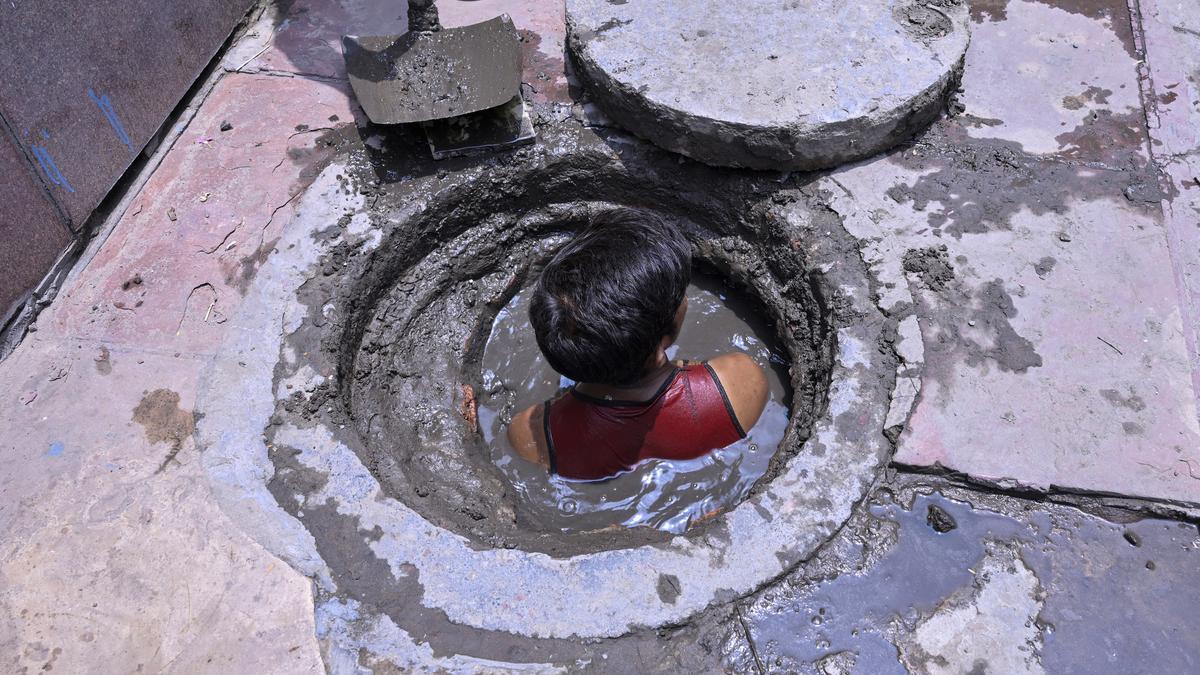
- 24 Jul 2025
In News:
A recent social audit conducted by the Ministry of Social Justice and Empowerment has exposed alarming lapses in the safety and legal safeguards meant to protect sanitation workers. The study, which examined 54 sewer-related deaths across 17 districts in eight States and Union Territories during 2022 and 2023, found that over 90% of the workers who died had no access to basic safety gear or mechanised equipment. Despite legal bans and policy interventions, manual scavenging and hazardous sewer cleaning continue, often resulting in fatalities, primarily among marginalized communities.
What is Manual Scavenging?
Manual scavenging involves the manual handling of human excreta from dry latrines, open drains, sewers, and septic tanks. Although officially prohibited under the 2013 Act, the practice continues under different forms, particularly through hazardous sewer and septic tank cleaning.
Key Findings from the Social Audit (2022–2023)
- 150 deaths from hazardous cleaning were recorded nationally during the two-year period.
- In 49 of the 54 deaths audited, no safety equipment was provided.
- In only five cases, the deceased had gloves; just one worker had both gloves and gumboots.
- No mechanised equipment was available in 47 cases; training was provided in only one instance.
- Informed consent was missing in 27 cases; in the 18 cases where consent was obtained, no counselling on risks was given.
- Most workers were individually contracted and not hired through government channels, evading institutional accountability.
- Post-death awareness drives were conducted in only seven locations, and even these were only partially executed.
Constitutional and Legal Safeguards
Constitutional Provisions:
- Article 21: Ensures the right to life with dignity, including safe working conditions.
- Article 23: Prohibits forced labour, applicable when workers are compelled into hazardous tasks.
- Article 42: Calls for humane working conditions and maternity relief.
Legal Framework:
- Prohibition of Employment as Manual Scavengers and their Rehabilitation Act, 2013:
- Bans manual scavenging.
- Mandates rehabilitation of identified workers.
- Supreme Court Judgment (2014 – Safai Karamchari Andolan v. Union of India):
- Ordered ?10 lakh compensation for each sewer/septic tank death.
- Held the State responsible for implementation failures.
Government Initiatives
NAMASTE Scheme (2023)
The National Action Plan for Mechanised Sanitation Ecosystem (NAMASTE) aims to eliminate hazardous cleaning practices.
- 84,902 workers have been identified across 36 States/UTs.
- Around 50% of them have been provided with PPE kits.
- In Odisha, 100% of identified workers (1,295) have received PPE kits, supported by the Garima Scheme.
- ?20 crore in capital subsidies distributed to 707 sanitation workers.
- 1,000 awareness workshops conducted.
- The scheme has also identified 37,800 waste pickers for support.
Other Key Initiatives:
- Swachh Bharat Abhiyan: Aims to reduce dependence on manual scavenging through sanitation infrastructure.
- Rashtriya Garima Abhiyaan: Campaign to eliminate manual scavenging and ensure rehabilitation.
- Bandicoot Robot: India’s first manhole-cleaning robot, developed in Kerala, which became the first fully robotised state for manhole cleaning in 2023.
Financial Inclusion Index (FI-Index)
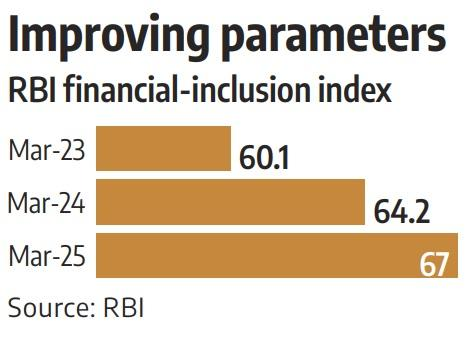
- 24 Jul 2025
In News:
The Reserve Bank of India’s Financial Inclusion Index (FI-Index) saw a 4.3% rise in FY2024-25, climbing from 64.2 in March 2024 to 67 in March 2025. This growth signals India’s ongoing success in expanding access to financial services, particularly in underserved regions, and enhancing the depth and quality of financial inclusion.
Understanding Financial Inclusion
- Financial inclusion refers to ensuring that individuals and businesses have accessible, affordable, and appropriate financial services such as banking, insurance, pensions, and investments. These services should be delivered responsibly and sustainably, supporting long-term economic empowerment.
What is the Financial Inclusion Index (FI-Index)?
- Developed by the RBI, the FI-Index offers a comprehensive measure of financial inclusion in India. It was formulated in consultation with the government and relevant financial sector regulators and captures progress across diverse financial domains—including banking, insurance, postal services, investments, and pensions.
- The Index is expressed as a single score between 0 and 100, where 0 denotes complete exclusion and 100 indicates full financial inclusion.
Components of the FI-Index
- Access (35% weight): Availability of financial services to the public.
- Usage (45% weight): Frequency and extent of usage of financial services.
- Quality (20% weight): Incorporates factors such as financial literacy, consumer protection, and equality in service delivery.
Key Insights from FY2024–25
- The FI-Index rose to 67 in March 2025, indicating broader and deeper financial engagement.
- All three sub-indices—access, usage, and quality—showed improvement.
- Notably, the rise was primarily driven by enhanced usage and service quality, reflecting the success of financial literacy campaigns and improved consumer trust in financial systems.
Importance of Financial Inclusion
Financial inclusion is not just an economic tool—it is a developmental imperative. It:
- Fuels entrepreneurship and employment generation.
- Advances gender empowerment, especially among women-led households.
- Helps in poverty alleviation and the resilience of vulnerable groups against financial and climate-related shocks.
- Supports at least seven of the United Nations Sustainable Development Goals (SDGs), including reducing inequalities and promoting inclusive economic growth.
Major Government Initiatives Driving Financial Inclusion
India's focused efforts have resulted in widespread access to formal financial services:
- Pradhan Mantri Jan Dhan Yojana (PMJDY): Over 54.58 crore bank accounts opened; deposits crossed ?2.46 lakh crore by January 2025.
- Atal Pension Yojana (APY): Enrolments surged to 7.33 crore, with 89.95 lakh new subscribers in FY25 alone.
- Pradhan Mantri Jeevan Jyoti Bima Yojana (PMJJBY): Covered 22.52 crore people, disbursing over ?17,600 crore for 8.8 lakh claims.
- Pradhan Mantri Suraksha Bima Yojana (PMSBY): Provided insurance to 49.12 crore individuals, settling claims worth ?2,994.75 crore.
- Pradhan Mantri Mudra Yojana (PMMY): Sanctioned loans worth ?32.36 lakh crore across 51.41 crore accounts; 68% to women and 50% to SC/ST/OBC beneficiaries.
- Stand-Up India Scheme: Loans worth ?53,609 crore sanctioned to 2.36 lakh entrepreneurs, promoting SC/ST and women entrepreneurship.
MiG-21 Fighter Jets
- 24 Jul 2025
In News:
- The Indian Air Force (IAF) is set to retire its final two squadrons of the iconic MiG-21 Bison fighter jets in September 2025, marking the end of an era that spanned over six decades.
- First inducted in 1963, the MiG-21 played a pivotal role in shaping India's aerial combat capabilities and remains a symbol of India's early steps toward defence self-reliance.
MiG-21: An Overview
- Origin: Designed by the Mikoyan-Gurevich Design Bureau of the Soviet Union in the 1950s.
- Type: Single-engine, supersonic jet fighter.
- Speed: Capable of speeds over Mach 2.0, making it one of the fastest jets of its time.
- Induction in India: Entered IAF service in 1963; licensed production began in the 1960s by Hindustan Aeronautics Limited (HAL).
- Significance: India’s first combat aircraft of non-Western origin and a key asset for air superiority during the Cold War and beyond.
Operational Legacy
The MiG-21 became the backbone of the IAF from the 1970s until the early 2000s, remaining in service even after the induction of more advanced aircraft like the Su-30MKI.
Wars and Combat Contributions
- 1965 & 1971 Indo-Pak Wars: Played a crucial role in establishing air superiority.
- During the 1971 war, MiG-21s conducted multiple successful bombing missions, including attacks on Pakistani airbases, contributing significantly to India’s decisive victory and the creation of Bangladesh.
- The aircraft famously outmatched Pakistan’s F-104 Starfighters in dogfights.
Strengths
- All-weather operations capability.
- Versatility in roles: air-to-air combat, ground attacks, and reconnaissance.
- Compatibility with a variety of air-to-ground and air-to-air weapons.
Limitations and Controversy
Despite its legendary status, the MiG-21's later years were marked by increasing technical limitations and a poor safety record:
- Nicknamed "Flying Coffin" due to over 400 crashes since the 1970s.
- Resulted in the deaths of over 200 pilots and 50 civilians.
- Upgraded variants like the MiG-21 Bison included radar and avionics improvements but could not overcome structural and safety limitations.
- Retirement was delayed multiple times due to shortages in the IAF’s squadron strength.
Retirement and Replacement
- The last two MiG-21 Bison squadrons will be phased out by September 2025.
- India had produced over 600 MiG-21s under license.
- Replacement underway with indigenously developed Tejas Mk-1A fighter jets, part of India’s push for self-reliance under Atmanirbhar Bharat.
- The IAF currently operates 29 squadrons—well below the sanctioned strength of 42.5 squadrons.
Fungus-Resistant Pineapple
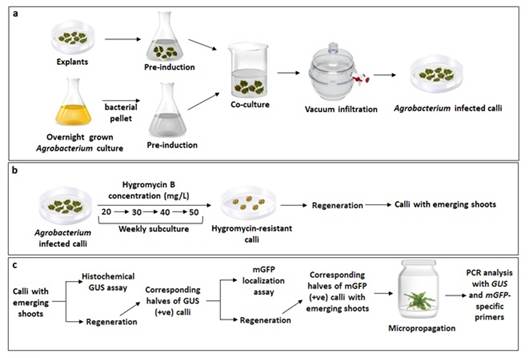
- 24 Jul 2025
In News:
- Pineapple (Ananas comosus L. Merr.), the most economically significant fruit of the Bromeliaceae family, plays a crucial role in nutrition and agriculture across tropical regions.
- In India, pineapple cultivation contributes significantly to rural livelihoods, particularly in northeastern and southern states. However, the productivity of this high-value fruit is severely impacted by Fusariosis, a destructive fungal disease caused by Fusarium moniliforme.
- A recent breakthrough by Indian scientists promises a potential game-changer in combating this challenge using indigenous genetic innovation.
Fusariosis
- Fusariosis is a devastating fungal infection that warps the stem, blackens the leaves, and rots the fruit internally, leading to heavy crop losses.
- Traditional breeding methods have struggled to provide effective resistance due to the rapid evolution of fungal pathogens. For farmers, this translates into unreliable harvests and financial instability.
The Biotechnological Solution: AcSERK3 Gene Overexpression
Researchers from the Bose Institute, an autonomous body under the Department of Science and Technology (DST), have successfully identified and overexpressed a gene in pineapple that significantly enhances resistance to Fusariosis.
- The gene, AcSERK3 (Somatic Embryogenesis Receptor Kinase 3), is part of the pineapple’s natural genome.
- It is known to regulate somatic embryogenesis and strengthen plant responses to biotic and abiotic stress.
- By genetically overexpressing this gene in pineapple plants, the researchers were able to trigger enhanced internal defence mechanisms.
- The transgenic lines exhibited increased production of stress-associated metabolites and antioxidant enzyme activity, enabling them to survive fungal attacks that severely damaged wild-type plants.
This is the first documented instance of overexpression of an indigenous pineapple gene to impart fungal disease tolerance while simultaneously improving regenerative capacity.
Significance of the Research
- The study, published in In Vitro Cellular & Developmental Biology – Plants, lays the foundation for developing multi-fungal tolerant pineapple varieties.
- These genetically enhanced lines are not dependent on foreign genes, thereby addressing biosafety concerns.
- Field trials, if successful, could lead to the commercial deployment of these varieties using conventional propagation methods like slips and suckers.
- This offers a sustainable, farmer-friendly solution, especially for smallholder pineapple growers in India.
Pineapple Cultivation in India: Key Facts
- Climatic Conditions: Grows well in 15–30°C temperature range and 600–2500 mm annual rainfall (optimum: 1000–1500 mm).
- Soil: Requires well-drained soils; intolerant to waterlogging.
- Tolerant to Drought: Possesses water-storing tissues making it suitable for rainfed cultivation.
- Cultivation Pattern: Can be grown as a monocrop or intercropped with coconut.
- Major Producing States: Assam, Meghalaya, Tripura, Manipur, West Bengal, Kerala, Karnataka, and Goa.
- Global Producers: Thailand, Philippines, Brazil, China, Nigeria, Mexico, Indonesia, Colombia, and the USA.
Stablecoins
- 24 Jul 2025
In News:
In the evolving landscape of digital finance, stablecoins have emerged as a promising innovation. Unlike volatile cryptocurrencies such as Bitcoin, stablecoins are designed to maintain a consistent value by pegging their worth to stable assets like fiat currencies or commodities. Recent legislative and technological developments, particularly in the United States, indicate growing global interest in integrating stablecoins into everyday financial systems.
What are Stablecoins?
Stablecoins are a type of cryptocurrency whose value is anchored to an external asset, commonly a fiat currency like the US dollar, or commodities such as gold. This pegging mechanism aims to minimize price volatility, making them more suitable for routine transactions.
There are three primary categories of stablecoins:
- Fiat-collateralized: Backed by actual reserves of fiat currency.
- Crypto-collateralized: Secured using other cryptocurrencies as collateral.
- Algorithmic (non-collateralized): Use smart contracts to automatically manage the coin’s supply based on demand.
Although designed for stability, these digital assets still carry some risks, especially if reserve management is opaque or unregulated.
Technological Foundation
Stablecoins, like other cryptocurrencies, are built on blockchain technology—a decentralized, distributed ledger system that records transactions in a secure, transparent manner. Blockchains operate through consensus mechanisms without needing a central authority, making stablecoins capable of direct peer-to-peer transactions without traditional banking intermediaries.
Recent Policy Development: The GENIUS Act
In a landmark move, the GENIUS Act (Generating Emergency National Income Using Stablecoins) was recently signed into law by the US President. It provides a regulatory framework specifically for US dollar-pegged stablecoins like USDC (by Circle) and USDT (by Tether). This legislative support is expected to accelerate the mainstream adoption of stablecoins, especially in cross-border payments.
Applications of Stablecoins
- Remittances and Cross-Border Transfers:
- Traditional remittance services like Western Union or MoneyGram charge high fees and delays.
- Stablecoins offer instant, low-cost transactions, benefiting especially those in countries facing hyperinflation or capital controls.
- Companies can also pay overseas workers in stablecoins, bypassing complex financial systems and exchange rate risks.
- E-Commerce and Retail:
- Online merchants can reduce reliance on credit card networks, which collected over $187 billion in fees in the US in 2023 alone.
- Stablecoins eliminate intermediaries, reducing transaction fees and improving profit margins.
- Enterprise and Supply Chain Payments:
- Businesses can benefit from faster and cheaper cross-border payments.
- Chinese conglomerate JD.com suggests stablecoins could cut transaction costs by 90% and reduce settlement time from days to seconds.
- Custom Stablecoins by Corporations:
- Giants like Amazon, Walmart, and JD.com are exploring the issuance of proprietary stablecoins to support in-house payment systems, customer loyalty programs, and even financial services.
- This could potentially shift customer deposits away from traditional banks, affecting their lending capacity.
- Integration with Artificial Intelligence: Emerging AI agents may autonomously execute and manage stablecoin-based transactions, particularly in business-to-business ecosystems, improving operational efficiency.
Opportunities and Challenges
Advantages:
- Faster, cheaper international payments
- Improved financial inclusion
- Enhanced efficiency in e-commerce and global business operations
Concerns:
- Regulatory uncertainty, especially across jurisdictions
- Security risks, including fraud and hacking
- Potential disruption to traditional banking systems
SASCI Scheme
- 23 Jul 2025
In News:
The Ministry of Tourism has issued operational guidelines for the SASCI Scheme – Special Assistance to States for Capital Investment – Development of Iconic Tourist Centres to Global Scale – aiming to comprehensively upgrade iconic tourist destinations across India.
About the SASCI Scheme
- Objective: To develop iconic tourist centres into world-class destinations, ensuring global branding and promotion, and enhancing the overall tourist experience.
- Ministry in Charge: Ministry of Tourism, Government of India.
- Nature of Assistance: Central Government provides financial support to State Governments for selected tourism projects under capital investment mode.
Key Features of the Scheme
- Integrated Development:
- Creation of end-to-end tourist experiences, including infrastructure, amenities, and accessibility.
- Strengthening all points of the tourist value chain – from entry to exit.
- Proposal-Based Implementation:
- Projects are selected based on proposals submitted by State Governments.
- These proposals are evaluated based on several prescribed parameters.
- Evaluation Parameters Include:
- Connectivity to the site
- Existing tourism ecosystem
- Carrying capacity of the site
- Sustainability measures (environmental, social)
- Operation and maintenance mechanisms
- Project impact and value creation
- Tourism marketing strategies
- Design & Sustainability:
- Projects to leverage high-quality expertise for planning, design, and execution.
- Emphasis on sustainable development and maintenance of tourist centres.
Implementation Timeline & Funding
- Timeline:
- Projects to be completed within a maximum of 2 years from sanction.
- Deadline for Central funding: 31st March 2026.
- Execution Responsibility: Entirely with the respective State Governments under the guidance of the Ministry of Tourism.
Promotional Strategy
- The Ministry promotes these destinations through:
- International and domestic events
- Social media campaigns
- Dedicated tourism websites
- Other promotional and branding platforms
Ambrosia Beetle
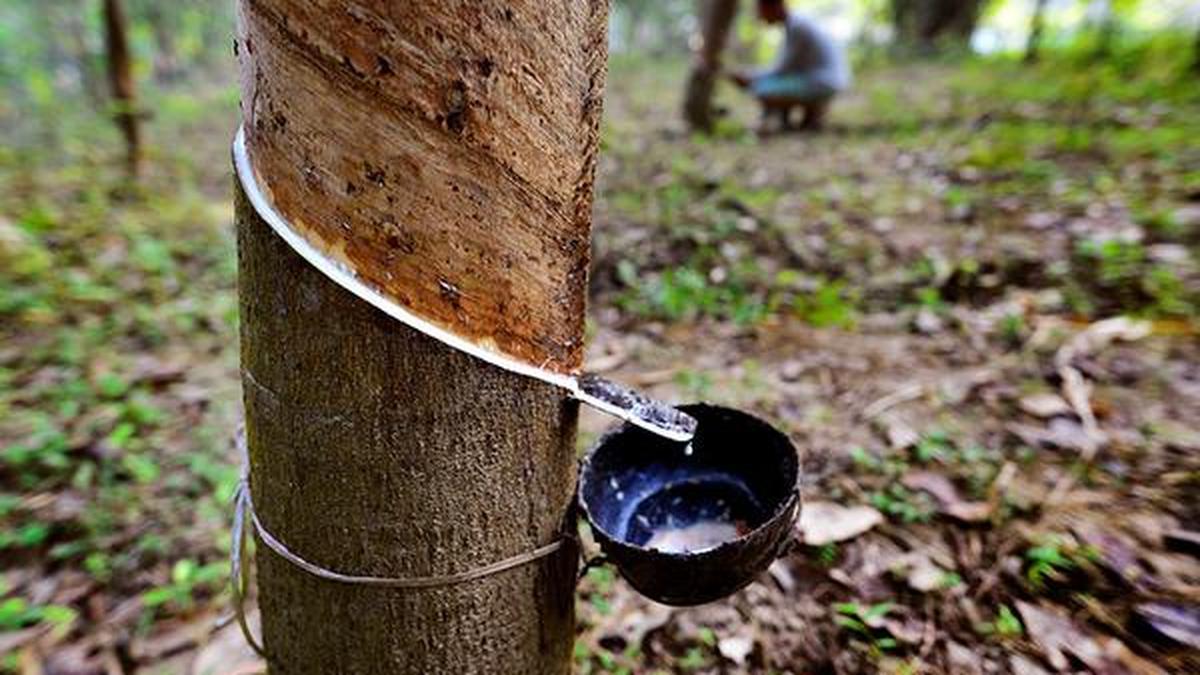
- 23 Jul 2025
In News:
Rubber plantations in Kerala, the heart of India’s natural rubber production, are under significant threat due to an invasive insect-fungal association. A mutualistic relationship between the ambrosia beetle (Euplatypus parallelus) and two fungal species (Fusarium ambrosia and Fusarium solani) has caused widespread tree damage, including leaf fall, trunk drying, and reduction in latex yield. This development poses a serious risk to India's rubber economy, biodiversity, and public health.
Key Highlights:
Ambrosia Beetle
- Origin: Native to Central and South America.
- First reported in India: In 2012, from cashew trees in Ponda, Goa.
- Current host: Rubber trees in Kerala, especially in Irrity-Kannur region.
Fungal Partners
- Fusarium ambrosia
- Fusarium solani — first time reported in association with adult ambrosia beetles in India.
Mutualistic Relationship
- The beetles do not feed on wood, but carry fungi into tunnels (galleries) bored into the tree bark.
- The fungi feed on wood, releasing enzymes that degrade plant tissue.
- Beetles and their larvae then feed on the nutrient-rich fungal mycelia.
- This association causes systemic infections in trees, often leading to their death.
Impact on Rubber Trees
- Weakens wood structure
- Causes severe leaf fall and drying of trunks
- Blocks xylem vessels, reducing water transport
- Leads to reduced latex production
- Long recovery time and high tree mortality
- The infection is hard to treat, as fungi lodge deep in plant tissues where fungicides and insecticides are ineffective.
Wider Implications
Scientific Concerns
- Fungi like Fusarium solani can evolve to associate with other beetles, expanding the range of infection to cashew, coconut, coffee, mango, and teak.
- These fungi can spread through soil or be carried by insect vectors, making containment difficult.
Health Hazards
- Fusarium species are opportunistic pathogens in humans.
- Workers in plantations may be exposed to these fungi, especially those with compromised immunity.
India’s Rubber Sector at Risk
- India is the 6th largest producer of rubber globally.
- Kerala accounts for 90% of national production and 72% of cultivation area.
- The economic stakes are high, as the beetle-fungi threat endangers not only latex yields but also the livelihoods of thousands of smallholder farmers.
Response Measures and Strategies
Current Management Practices
- Use of antifungal agents
- Pruning or burning infected parts
- Installation of ambrosia beetle traps
- Chipping infected wood to prevent spread
Challenges
- No mycangia (fungal sacs) found in beetles in India — raises questions on fungal transmission mechanisms.
- Soil- and insect-mediated spread of fungi makes conventional phytosanitary measures ineffective for broadleaf trees like rubber.
Suggested Solutions
- Genetically modified (GM) rubber plants to resist fungal infection (debated).
- Use of antagonistic fungi or microbial consortia inside plants to outcompete pathogens.
- Location-specific strategies based on geography and host tree characteristics.
- Greater collaboration between researchers and policymakers to monitor and contain the threat.
Winter Fog Experiment (WiFEX)
- 23 Jul 2025
In News:
The Winter Fog Experiment (WiFEX) has completed ten successful years since its launch in 2015. Initiated at the Indira Gandhi International Airport (IGIA), New Delhi, WiFEX has emerged as a pioneering long-term scientific initiative aimed at understanding and mitigating the impact of dense winter fog over the Indo-Gangetic Plain (IGP) — one of the most fog-prone regions in the world.
What is WiFEX?
- Launched in Winter 2015 at IGIA, New Delhi.
- Led by the Indian Institute of Tropical Meteorology (IITM) under the Ministry of Earth Sciences (MoES).
- Supported by:
- India Meteorological Department (IMD)
- National Centre for Medium Range Weather Forecasting (NCMRWF).
- One of the world’s few open-field long-term experiments exclusively dedicated to studying winter fog.
Objectives of WiFEX
- To develop accurate now-casting (up to 6 hours) and forecasting systems for fog events over North India.
- To reduce the adverse impact of fog on:
- Aviation (flight delays, diversions, safety).
- Surface transport (road and rail accidents).
- Economy and public safety.
How it was Conducted
Observational Framework
WiFEX deployed cutting-edge scientific equipment, including:
- Micrometeorology towers
- Ceilometers
- High-frequency sensors
- Radiometers
- Wind profilers
These were installed at multiple locations including:
- IGIA, Delhi
- Jewar Airport, Noida
- Hisar, Haryana
Key Parameters Studied
- Atmospheric temperature stratification
- Relative humidity and soil heat flux
- Wind speed and turbulence
- Aerosol concentration
- Urban heat island effects
- Land-use changes
This comprehensive data helped scientists decode how dense fog forms, persists, and disperses.
Major Achievements of WiFEX
High-Resolution Forecasting Model
- A 3-km resolution probabilistic fog prediction model was developed.
- Achieved over 85% accuracy in forecasting very dense fog (visibility <200 meters).
- Provides insights on:
- Onset and dissipation timing
- Fog density
- Duration of fog events
Operational Impact
- Significantly reduced flight diversions and delays at IGIA.
- Enhanced airport safety and efficiency in fog conditions.
- Helped airlines and transport authorities activate timely contingency plans.
Scientific Contributions
- Showcased how air pollution, aerosols, urbanization, and land-use changes influence fog behavior.
- Facilitated improvements in early warning systems for North India.
- Informed urban planning and air quality policies for fog-prone areas.
United Nations Educational, Scientific and Cultural Organization (UNESCO)
- 23 Jul 2025
In News:
In a significant development, the United States has announced its decision to withdraw from UNESCO (United Nations Educational, Scientific and Cultural Organization) by December 2026, citing what it perceives as the agency’s anti-Israel bias and its recognition of the State of Palestine as a full member. This marks the third withdrawal of the U.S. from UNESCO and the second under President Donald Trump’s leadership, having previously exited in 2018 and rejoined in 2023 under the Biden administration.
Reasons for U.S. Withdrawal
According to the U.S. State Department, the decision stems from:
- UNESCO’s admission of the State of Palestine as a member state, which contradicts official U.S. policy.
- Allegations that UNESCO promotes divisive social and cultural causes.
- Concerns about the proliferation of anti-Israel rhetoric within the organization.
About UNESCO
Founding and Mandate
- Founded: 16 November 1945 (Constitution in force from 1946).
- Headquarters: Paris, France.
- Parent Body: United Nations Economic and Social Council (ECOSOC).
- Membership: 194 member states and 12 associate members.
- Origin: Born out of post–World War II efforts to foster peace through education, science, and culture.
Objectives
UNESCO aims to build global peace and security by:
- Promoting international cooperation in education, science, culture, and communication.
- Supporting literacy, educational access, and free universal education.
- Acting as a clearinghouse of knowledge, especially in global South nations.
Focus Areas
UNESCO operates in five major sectors:
- Education
- Natural Sciences
- Social and Human Sciences
- Culture
- Communication and Information
Key Functions and Initiatives
Flagship Initiatives
- World Heritage Convention (1972): Protects cultural and natural sites of outstanding universal value.
- Man and the Biosphere Programme (1971): Promotes sustainable development through biosphere reserves.
- Convention for Safeguarding Intangible Cultural Heritage (2003): Preserves oral traditions, performing arts, and rituals.
- Global Education Coalition (2020): Formed during COVID-19 to ensure education continuity.
- Recommendation on the Ethics of Artificial Intelligence (2021): Sets global standards for ethical AI development.
Important Publications
- Global Education Monitoring Report
- World Water Development Report
- World Trends in Freedom of Expression and Media Development
Strategic Importance of UNESCO
- Acts as a platform for intercultural dialogue and peacebuilding.
- Enhances scientific cooperation for issues like climate change and disaster preparedness.
- Supports freedom of expression and combats misinformation globally.
- Promotes equity in global education and digital access.
- Plays a key role in setting ethical standards in science and technology.
U.S. and UNESCO: A Tumultuous Relationship
- The U.S. has historically had a strained relationship with UNESCO:
- 1984: First withdrawal under Ronald Reagan, citing mismanagement and politicization.
- 2002: Rejoined under George W. Bush.
- 2011: Stopped funding after UNESCO admitted Palestine as a member.
- 2018: Withdrew under Donald Trump.
- 2023: Rejoined under Joe Biden.
- 2026: Set to withdraw again.
Implications of U.S. Withdrawal
- Financial Impact: The U.S. has historically contributed around 22% of UNESCO’s budget.
- Geopolitical Signal: Reflects a broader American skepticism towards multilateral institutions.
- Operational Effect: May hamper UNESCO’s work, especially in politically sensitive or conflict regions.
- Diplomatic Fallout: Could weaken the U.S.'s soft power and global cultural influence.
Resignation of Vice-President of India
- 23 Jul 2025
In News:
Vice-President of India, Jagdeep Dhankhar, resigned from office on health grounds on July 2025, invoking Article 67(a) of the Constitution. This created a rare mid-term vacancy in the Vice-President’s office, necessitating immediate action by the Election Commission of India (ECI) to conduct fresh elections.
Constitutional Provisions and Duties of the Vice-President
Articles Related to Vice-President:
- Article 63: Provides for the post of Vice-President.
- Article 64: Vice-President acts as ex-officio Chairman of Rajya Sabha.
- Article 65: Vice-President acts as President in case of a vacancy in the office of the President.
- Article 66: Deals with election of the Vice-President.
- Article 67(a): Vice-President may resign by writing under his hand addressed to the President.
- Article 68: Covers election in case of a vacancy and mandates that it be filled as soon as possible.
- Article 324: Vests the Election Commission of India (ECI) with the authority to conduct the election.
Resignation of the Vice-President
Key Facts:
- Jagdeep Dhankhar, 74, resigned before completing his 5-year term (2022–2027).
- The resignation was addressed to the President of India as per Article 67(a).
- No formal acceptance is necessary; it becomes effective upon submission.
- Constitutionally, no method of succession is provided other than fresh elections.
Historical Precedents:
- V.V. Giri (1969): Resigned to contest Presidential election.
- Bhairon Singh Shekhawat (2007): Resigned after losing Presidential race.
- Jagdeep Dhankhar (2025): Resigned for health reasons.
Election Process for Vice-President
Electoral College:
- Comprises both elected and nominated members of the Lok Sabha and Rajya Sabha.
- Unlike the Presidential election, MLAs are not part of the Vice-Presidential electoral college.
Voting System:
- Election is held by proportional representation through single transferable vote (STV).
- Voting is by secret ballot.
- All votes carry equal value, unlike in Presidential elections.
Nomination Procedure:
- Requires at least 20 proposers and 20 seconders, all of whom must be MPs.
- Security deposit: ?15,000.
- Nomination papers must be submitted between 11 a.m. and 3 p.m. on appointed days.
Returning Officer:
- Typically, the Secretary-General of the Lok Sabha or Rajya Sabha, appointed by rotation.
- Two Assistant Returning Officers from Parliament Secretariat also assist.
Eligibility Criteria for Vice-President
A candidate must:
- Be a citizen of India.
- Have completed 35 years of age.
- Be qualified for election to the Rajya Sabha.
- Not hold any office of profit under the Union or State Government or any subordinate authority.
If an MP is elected Vice-President, they vacate their parliamentary seat on assuming office.
Dispute Resolution
- Supreme Court exclusively handles disputes related to Vice-Presidential elections.
- Cases are heard by a five-judge bench, and its decision is final.
Implications of Vacancy
- The post of Vice-President cannot remain vacant, even temporarily.
- In the interim, the Deputy Chairman of the Rajya Sabha presides over its proceedings.
- The ECI is mandated to conduct elections immediately after such a vacancy occurs, although no fixed constitutional timeline is prescribed for Vice-Presidential elections (unlike Presidential elections which must occur within six months).
Tenure and Re-election
- The Vice-President holds office for five years but continues until a successor is elected and takes office.
- There is no bar on re-election to the office.
Meri Panchayat App
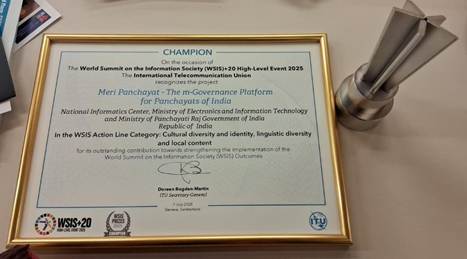
- 22 Jul 2025
In News:
India’s digital governance model received global recognition as the Meri Panchayat mobile application won the prestigious WSIS Prizes 2025 Champion Award under the category Cultural Diversity and Identity, Linguistic Diversity and Local Content. The award was presented during the WSIS+20 High-Level Event 2025 held in Geneva, Switzerland.
Key Highlights:
- The award was conferred by the International Telecommunication Union (ITU) as part of the World Summit on the Information Society (WSIS) initiative.
- The WSIS+20 event commemorated 20 years of WSIS, providing a platform to assess digital progress, address new challenges, and promote inclusive information societies.
- The event was co-hosted by ITU and the Swiss Confederation, and co-organized by UNESCO, UNDP, and UNCTAD.
About the “Meri Panchayat” App:
- A flagship m-Governance platform developed by the Ministry of Panchayati Raj in collaboration with National Informatics Centre (NIC) under the Ministry of Electronics and IT (MeitY).
- Designed to empower 2.65 lakh Gram Panchayats, the app caters to over 950 million rural residents and 25 lakh elected Panchayat representatives.
Key Features:
- Real-time Access: Budgets, receipts, payments, and Panchayat-level development plans.
- Transparency & Accountability: Social audit tools, geo-tagged fund utilization, and grievance redressal mechanisms.
- Participatory Governance: Enables citizens to propose projects, rate completed works, and view Gram Sabha decisions.
- Multilingual Support: Interface available in 12+ Indian languages, enhancing local inclusivity.
- Weather and Civic Info: Gram Panchayat-level weather forecasts, civic services, and infrastructure details.
Significance:
- The app strengthens participatory democracy by digitally integrating rural citizens into governance.
- It aims to bridge the digital divide and promote linguistic and cultural inclusivity in rural India.
- Recognized globally for promoting citizen-centric governance and local content diversity.
Bima Sakhi Yojana
- 22 Jul 2025
In News:
Life Insurance Corporation of India (LIC) has signed a Memorandum of Understanding (MoU) with the Department of Rural Development, Ministry of Rural Development, to implement the Bima Sakhi Yojana in rural areas. The agreement was formalized during the ‘Anubhuti’ national conclave on financial inclusion held in Goa.
About Bima Sakhi Yojana:
- Implementing Body: Life Insurance Corporation of India (LIC) in collaboration with the Union Ministry of Rural Development.
- Objective: To promote financial inclusion and women empowerment by facilitating their participation in the insurance distribution sector.
- Target Group: Rural women aged 18–70 years, with at least a Class 10 qualification.
Key Features:
- Stipendiary LIC Agency Scheme:
- Women are inducted as LIC agents with all associated privileges.
- The scheme offers a monthly stipend for the initial three agency years:
- ?7,000 in the first year
- ?6,000 in the second year
- ?5,000 in the third year (Subject to performance and terms and conditions)
- Commission Benefits:
- In addition to stipends, Bima Sakhis are eligible for sales commissions.
- A commission of ?48,000 (excluding bonuses) is provided in the first year for qualifying agents.
- Training & Career Path:
- Selected candidates undergo specialized training to build capacity in insurance awareness and financial literacy.
- Post-training, they function as LIC agents.
- Graduates among them may be eligible to become LIC Development Officers.
- Scale of Implementation: The scheme aims to appoint 2 lakh Bima Sakhis over a period of three years, with focus on enhancing rural outreach and insurance penetration.
Eligibility Criteria:
- Age Limit: 18 to 70 years
- Minimum Education: Must have passed Class X
- Preference: Women from rural areas are prioritized
Ineligibility Conditions:
- Women who are:
- Related to existing LIC agents or employees (including spouse, children, siblings, parents, and in-laws)
- Retired LIC employees or ex-agents
- Currently working as LIC agents
Significance:
- Promotes gender empowerment and financial literacy in rural India.
- Part of government’s push for inclusive financial growth through public-private partnerships.
- Illustrates convergence between LIC’s social responsibility and government rural development goals.
Hatti Tribe
- 22 Jul 2025
In News:
Recently, two brothers from the Hatti tribe in the Trans-Giri region of Sirmaur district, Himachal Pradesh, married the same woman under the traditional custom of polyandry. The wedding, held in Shillai village, was conducted openly and witnessed by hundreds, reviving attention to this rare tribal practice.
About the Hatti Tribe
- The Hatti community derives its name from the traditional occupation of selling agricultural produce, meat, and wool in local markets called haats.
- They reside primarily in the Himachal–Uttarakhand border region, especially in the basins of the Giri and Tons rivers, both tributaries of the Yamuna.
- The Hattis are divided into two major groups:
- One in Trans-Giri, Sirmaur district (Himachal Pradesh)
- Another in Jaunsar-Bawar (Uttarakhand)
- They maintain similar cultural practices, and intermarriage between these clans is common.
- The community follows a traditional council system called ‘Khumbli’ for resolving social issues.
- As of 2023, the Hatti tribe in Himachal Pradesh was granted Scheduled Tribe (ST) status, while Jaunsar-Bawar in Uttarakhand received tribal status in 1967.
- Their economy is largely agrarian, with a focus on cash crops due to favorable climatic conditions.
The Tradition of Polyandry ("Jajda")
- Polyandry in the Hatti community is locally called “Jajda” and was historically practiced to prevent division of ancestral land.
- The ritual includes a marriage procession of the bride to the groom’s village and a ceremony called “Seenj”.
- Local priests chant mantras in the native language and conclude the ceremony with blessings and offerings like jaggery.
- This practice has declined in recent decades due to increasing literacy among women, social modernization, and economic shifts.
Legal and Social Acceptance
- Polyandrous marriages are informally recognized under Himachal Pradesh revenue laws, where the practice is referred to as “Jodidara”.
- Though rare, such marriages continue to be socially accepted in some remote villages of Trans-Giri, Kinnaur, and Jaunsar-Bawar.
Demographics
- As per the 2011 Census, the Hatti population was around 2.5 lakh, and estimates now suggest about 3 lakh people across 450 villages in the Trans-Giri region alone.
Cultural and Practical Rationale
According to Hatti elders and community leaders:
- Land Preservation: Prevents fragmentation of ancestral property.
- Joint Family Bonding: Promotes unity and mutual understanding among brothers.
- Labor Sharing: Ensures adequate manpower to manage scattered agricultural lands in hilly terrain.
- Security: A larger family offers greater social and economic protection in tribal settings.
Cy-TB Test
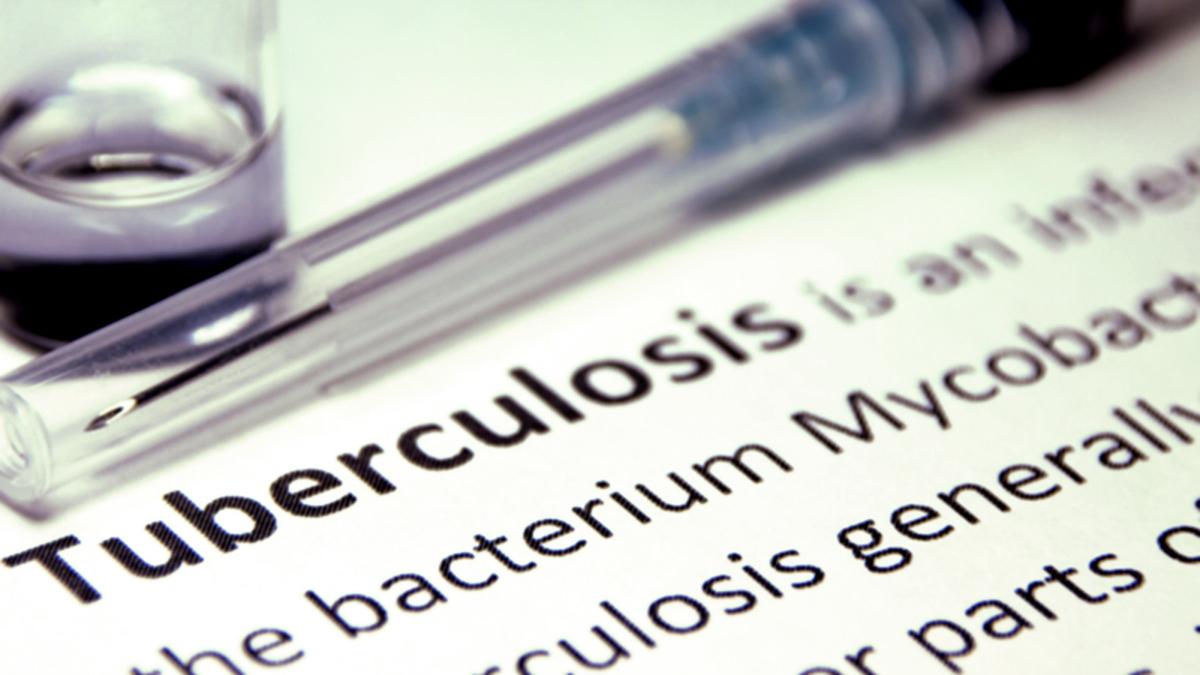
- 22 Jul 2025
In News:
Kerala has introduced Cy-TB, a new intradermal diagnostic tool, under the National TB Elimination Programme (NTEP) to identify and manage latent tuberculosis infections (LTBI).
What is the Cy-TB Test?
- Cy-TB is a third-generation skin test approved by the Central TB Division, Government of India.
- It involves the intradermal injection of 0.1 ml of Mycobacterium tuberculosis-specific antigens (ESAT-6 and CFP-10) into the inner forearm.
- If an individual develops a raised area of 5 mm or more within 48–72 hours, it indicates TB infection.
- The test is:
- Highly specific, accurate, and user-friendly
- Administered by a trained nurse
- Requires follow-up for reading the result
- A cost-effective alternative to the Interferon Gamma Release Assay (IGRA), which requires lab support
TB Infection vs. Active TB Disease
- TB infection means that a person harbours Mycobacterium tuberculosis bacteria in a dormant form and shows no symptoms.
- These individuals are not contagious.
- If left untreated, about 5–10% may progress to active TB when their immune system weakens.
Why Focus on Latent TB?
Kerala is prioritising treatment of latent TB infections as part of its last-mile strategy in TB elimination. Despite a 40% reduction in TB transmission over six years, the state faces challenges due to subclinical (asymptomatic) TB and a high burden of comorbidities such as diabetes, chronic kidney disease, and alcohol abuse.
Key Study in Thiruvananthapuram (2022)
- A cross-sectional community study found that 20.5% of adults had TB infection.
- Prevalence increased with age, from 11.5% (18–35 years) to 30.3% (above 58 years).
- State-level estimates suggest around 22% of Kerala’s general population is latently infected.
Burden of Tuberculosis (India & Global)
According to the WHO Global Tuberculosis Report 2024:
- India accounts for 26% of global TB cases – the highest worldwide.
- TB continues to be the leading infectious disease killer.
- Each year, around 10 million people fall ill globally, and 1.5 million die of TB.
- TB is the top cause of death among people with HIV and a major driver of antimicrobial resistance (AMR).
Implementation of Cy-TB in Kerala
- The Cy-TB test will be used in district TB centres, taluk hospitals, dialysis centres, and some block-level facilities.
- It will also be used to screen residents of old age homes, especially where pulmonary TB cases have emerged.
- The test is also available in major private hospitals.
High-Risk Groups for Preventive Therapy
Only high-risk individuals who test positive for latent TB are recommended for TB preventive therapy (TPT). These include:
- People on dialysis or awaiting transplants
- Patients on immunosuppressive or anti-TNF therapy
- Individuals with silicosis
- Healthcare workers exposed to TB
- Elderly in institutional settings
Preventive TB Treatment Regimens
- 3HP: 3 months of weekly doses of Isoniazid and Rifapentine
- 6H: 6 months of daily Isoniazid. These regimens use fewer drugs and are shorter than active TB treatment protocols.
Guryul Ravine Fossil Site
- 22 Jul 2025
In News:
The Geological Survey of India (GSI) has raised an alarm over a serious threat to the Guryul Ravine fossil site located in Khonmoh, on the outskirts of Srinagar, Jammu & Kashmir. The site holds immense geological significance and is facing the risk of degradation due to human activity.
About the Site
The Guryul Ravine is situated near Khonmoh in Jammu & Kashmir, close to the Dachigam National Park. Geologically, the area is part of the Vihi district. It falls within the ecologically sensitive Khonmoh Conservation Reserve.
- This fossil site is globally significant because it contains sedimentary layers that preserve evidence of the Permian–Triassic mass extinction event. These geological layers date back around 260 million years and represent one of the most catastrophic periods in Earth’s biological history.
- Remarkably, the site also shows signs of what is believed to be the world’s earliest recorded tsunami, with the imprint still visible in the exposed strata.
Significance of the Permian–Triassic Extinction Event
- Also referred to as the “Great Dying,” the Permian–Triassic extinction event occurred around 251.9 million years ago. It marks a major boundary between the Permian and Triassic geological periods and also separates the Paleozoic and Mesozoic eras.
- This event was the most severe extinction episode in Earth’s history. It led to the loss of nearly 90–95% of marine species and about 70% of terrestrial vertebrate species. The extinction dramatically reshaped life on Earth and paved the way for the rise of dinosaurs in the subsequent Mesozoic era.
Conservation Concerns
- The GSI has warned that this invaluable geo-heritage site is under threat due to encroachment and unregulated activities. It has recommended urgent steps to protect the fossil-rich area to preserve its scientific and educational value.
Allographa effusosoredica
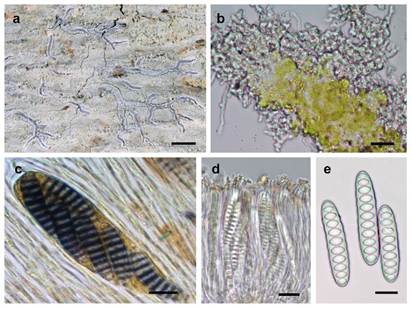
- 20 Jul 2025
In News:
A team of Indian scientists from MACS-Agharkar Research Institute, Pune (under the Department of Science & Technology) has discovered a new species of lichen named Allographa effusosoredica in the Western Ghats, a UNESCO World Heritage Site and biodiversity hotspot. This crustose lichen exhibits effuse soredia and contains norstictic acid, a rare secondary metabolite within its genus.
Scientific and Molecular Significance
- The species was examined through polyphasic taxonomy, integrating:
- Morphological traits
- Chemical profiling
- Molecular sequencing using genetic markers:
- Fungal DNA markers: mtSSU, LSU, RPB2
- Algal symbiont marker: ITS
- The lichen’s photobiont was identified as a species of Trentepohlia, advancing the understanding of tropical algal diversity in lichens.
- Though morphologically similar to Graphis glaucescens, it is phylogenetically closest to Allographa xanthospora.
Symbiosis in Lichens
- Lichens are composite organisms, formed by a symbiotic association between:
- A fungal partner (mycobiont) — provides structure and protection.
- A photosynthetic partner (photobiont), such as green algae or cyanobacteria — produces nutrients via photosynthesis.
- This discovery supports the concept of locally adapted symbiosis, emphasizing co-evolution in tropical ecosystems.
Ecological Importance of Lichens
- Lichens are vital for:
- Soil formation
- Feeding insect populations
- Acting as bioindicators of air quality and ecosystem health.
Conservation and Biodiversity Impact
- Allographa effusosoredica is:
- The 53rd Allographa species reported from India.
- The 22nd species of this genus documented in the Western Ghats.
- The first Indian Allographa species validated using molecular tools.
- The study was supported by the Anusandhan National Research Foundation (ANRF) and contributes to the growing inventory of India’s cryptic biodiversity.
Global Measles Resurgence
- 20 Jul 2025
In News:
Virologists raise alarm over surge in measles cases worldwide.
What is Measles?
- Measles is a highly contagious viral disease caused by the Measles morbillivirus (from the paramyxovirus family).
- It primarily affects children, but any non-immune person (unvaccinated or without immunity) is at risk.
- The virus spreads via airborne transmission—through coughing, sneezing, and respiratory droplets. It can remain in the air or on surfaces for up to 2 hours.
- Infectivity: ~90% of unvaccinated individuals exposed will contract the virus.
Global Surge in Cases (2023–2025)
- The World Health Organization (WHO) and US CDC reported a 30-fold global surge in measles cases from 10,000 in 2022 to 10.3 million in 2023.
- Outbreaks have been recorded in Africa, Europe, Southeast Asia, and the Americas.
- Africa: Nearly half of global outbreaks.
- Europe: 41 of 53 countries reported cases.
- United States: Worst outbreak since 1992 with 1,300+ cases across 40 states, including Texas, Ohio, and California.
- Americas (2025): 11-fold increase in cases due to international travel.
Symptoms and Progression
- Incubation: Symptoms appear 7–14 days after exposure.
- Early signs: High fever, cough, runny nose, conjunctivitis (red, watery eyes), and white spots in the mouth (Koplik spots).
- Rash: Starts on the face and neck, spreads to the entire body, lasting 5–6 days.
- Contagious: 4 days before and after rash onset.
Complications
- Common: Pneumonia, diarrhoea, encephalitis (brain inflammation), deafness.
- Severe:
- 1–3 per 1,000 unvaccinated children may die.
- Can cause blindness, subacute sclerosing panencephalitis (SSPE) (a fatal brain disorder).
- In pregnancy: Can lead to stillbirth or premature delivery.
Vaccination and Prevention
- No specific antiviral treatment exists; only preventive vaccination is effective.
- MMR Vaccine (Measles, Mumps, Rubella):
- Two doses recommended:
- 1st dose: 12–15 months
- 2nd dose: 4–6 years
- During outbreaks or travel: Can be given from 6 months of age.
- Two doses recommended:
- Herd Immunity Threshold: 95% vaccination coverage needed to prevent outbreaks.
- Current US rate: 92.7%, with rising nonmedical exemptions at 3.3%, falling short of safety threshold.
Causes of Resurgence
- Vaccine hesitancy, misinformation, and declining immunisation rates.
- Conflict zones, weak health systems, and interrupted vaccination drives in developing regions.
- Post-COVID travel rebound accelerating transcontinental spread.
Call to Action by Scientists and WHO
- Global Virus Network (GVN) and virologists urge:
- Urgent vaccination of unvaccinated children and vulnerable adults.
- Strengthening public health infrastructure.
- Enhancing outbreak surveillance and public awareness.
- Focused outreach in rural and underserved communities.
Exercise SIMBEX
- 20 Jul 2025
In News:
The Indian Navy is participating in the 32nd edition of the Singapore-India Maritime Bilateral Exercise (SIMBEX) in Singapore in July 2025. It marks one of the longest uninterrupted bilateral naval exercises India has with any country.
What is SIMBEX?
- SIMBEX stands for Singapore-India Maritime Bilateral Exercise
- It is an annual naval exercise conducted between the Indian Navy and the Republic of Singapore Navy (RSN)
- Origin: Initiated in 1994 as Exercise Lion King
- It has evolved into a complex maritime engagement, showcasing interoperability in surface, subsurface, and air operations
Significance
- It supports India’s Vision SAGAR (Security and Growth for All in the Region) and the Act East Policy
- Promotes regional maritime security cooperation and ensures the safety of sea lanes of communication (SLOCs)
- Reinforces commitment to a rules-based international maritime order, especially amidst rising piracy and threats from non-state actors
Indian Navy’s Participation (2025 Edition)
- The Indian naval contingent includes:
- INS Delhi – Guided missile destroyer
- INS Satpura – Stealth frigate
- INS Shakti – Fleet replenishment tanker
- INS Kiltan – Anti-submarine corvette
- These vessels are indigenously designed and equipped with advanced systems for high-seas operations
Strategic Engagement Highlights
- SIMBEX is a critical part of India’s expanding maritime diplomacy in the Indo-Pacific
- The naval exercise is conducted alongside a goodwill visit to Singapore, coinciding with the 60th anniversary of India-Singapore diplomatic ties
- Following Singapore, the Indian Navy’s Eastern Fleet is also scheduled to visit the Philippines and Vietnam
Broader Defence Cooperation with Singapore
In addition to SIMBEX, India and Singapore engage in:
- Exercise Agni Warrior (Army)
- Joint Military Training (JMT) (Air Force)
India also engages with ASEAN through:
- ASEAN-India Maritime Exercise (First held in 2023, co-hosted by Singapore)
- Participation in ASEAN-led forums like:
- ADMM-Plus
- ASEAN Regional Forum
- East Asia Summit
Vision SAGAR & Maritime Security
India’s Vision SAGAR emphasizes:
- Collaborative maritime partnerships
- Combating common maritime threats (e.g., piracy, trafficking, and disasters)
- Securing economic and strategic interests in the Indian Ocean Region (IOR)
Chronic Venous Insufficiency (CVI)
- 20 Jul 2025
In News:
Former U.S. President Donald Trump, aged 79, was recently diagnosed with Chronic Venous Insufficiency (CVI) — a common vascular condition, especially among individuals above 70 years. This brings attention to a condition affecting millions globally.
What is Chronic Venous Insufficiency (CVI)?
CVI is a circulatory disorder where the veins in the legs fail to return blood effectively to the heart. This results in blood pooling in the lower limbs due to damaged or weak vein valves, increasing venous pressure.
- Typically begins in one leg and may progress to both.
- Common symptoms include:
- Leg pain, swelling
- Varicose veins
- Cramps, skin discoloration, or thickening
- In advanced cases: venous ulcers
- In some cases, patients may be asymptomatic in early stages.
Epidemiology
- Affects approximately 1 in 20 adults
- Risk significantly increases with age
- Particularly common among individuals over 70
- People with CVI are about 60% more likely to also have cardiovascular disease compared to those without the condition
Risk Factors and Causes
CVI can result from or be worsened by:
- Obesity and pregnancy
- Family history of vein disorders
- Leg injury, surgery, or prior blood clots
- High blood pressure, smoking
- Lack of physical activity or prolonged sedentary lifestyle
Management and Treatment
Lifestyle Modifications
- Regular physical activity
- Avoid prolonged sitting or standing
- Weight management
- Elevating the legs to aid venous return
Medical Interventions
- Compression therapy: Use of compression stockings or bandages to support vein function
- Medications that enhance venous tone and reduce inflammation
Surgical/Minimally Invasive Procedures
- Endovenous laser ablation
- Vein glue therapy: Seals off malfunctioning veins
- Vein ligation/stripping (less common today due to invasive nature)
These newer techniques often ensure quicker recovery than traditional surgery.
Global Wetland Outlook 2025
- 20 Jul 2025
In News:
The Global Wetland Outlook (GWO) 2025, released by the Ramsar Convention on Wetlands, highlights alarming degradation trends in global wetlands—especially in Africa, Latin America, and the Caribbean—with implications for climate resilience, biodiversity, and socio-economic wellbeing.
What are Wetlands?
A wetland is a land area saturated with water—either permanently or seasonally—and functions as a distinct ecosystem. Wetlands include:
- Inland: Lakes, rivers, swamps, peatlands
- Coastal: Mangroves, tidal flats, coral reefs, estuaries
- Human-made: Rice paddies, reservoirs, wastewater ponds
Key Findings:
- Produced by: Scientific and Technical Review Panel (STRP) of the Ramsar Convention
- Global Wetland Loss: Since 1970, the world has lost 411 million hectares of wetlands—a 22% decline in extent.
- Current loss rate: ~0.52% annually
- Regional Degradation:
- Most severe in Africa, Latin America, and the Caribbean
- Africa’s wetlands are deteriorating faster than they can be restored, especially in South Africa
- Drivers of degradation:
- Africa, Latin America & Caribbean: Urbanisation, industrialisation, infrastructure development
- Europe: Drought
- North America & Oceania: Invasive species
- Economic Valuation:
- Global value of wetlands: $7.98 to $39.01 trillion/year
- Africa’s wetlands (2023): $825.7 billion, vs Asia’s $10.58 trillion
- Restoration Costs vs Conservation:
- Restoration: $1,000 to $70,000 per hectare/year
- Conservation is cheaper and more effective long-term
- Policy Insight: Most wetlands in Least Developed Countries (LDCs) are in poor condition, while those in high-income countries are in better health.
Africa’s Wetlands: A Deepening Crisis
- Millions depend on wetlands for food, water, disaster protection, and climate resilience.
- The Kafue Flats (Zambia) restoration example shows:
- $300,000 investment revived flooding
- Supported biodiversity and over a million people
- Boosted artisanal fisheries worth $30 million annually
- Warning from Ramsar Secretariat: Loss of wetlands is a major barrier to achieving global climate, biodiversity, food, and poverty targets.
India and Wetlands
- India has ~4.6% of its land as wetlands
- Hosts 91 Ramsar Sites – largest in South Asia and third in Asia
- Wetland types: Himalayan high-altitude lakes, Gangetic floodplains, mangroves (e.g., Sundarbans), coastal lagoons
Importance of Wetlands:
|
Function |
Explanation |
|
Biodiversity Hotspots |
Support endangered and endemic species |
|
Water Purification |
Trap pollutants and sediments |
|
Flood Regulation |
Act as natural buffers |
|
Carbon Sequestration |
Slow decomposition stores carbon |
|
Livelihoods |
Sustain agriculture, fisheries, tourism |
Ramsar Convention on Wetlands
- Adopted: 1971, Ramsar, Iran | Came into force: 1975
- India joined: 1982
- Goal: Conservation and wise use of wetlands globally
- Ramsar Site Criteria: Supports endangered species, ≥20,000 waterbirds, or critical fish spawning grounds
Key Framework: Kunming-Montreal Global Biodiversity Framework (GBF)
- Adopted in 2022 (COP15 to Convention on Biological Diversity)
- Dubbed “Paris Agreement for Nature”
- Targets:
- Halve invasive species spread
- Cut harmful subsidies by $500 billion/year
- 30x30 Target: Protect 30% of land + marine areas by 2030
- Restore 30% of degraded ecosystems by 2030
Recommendations from GWO 2025
- Increase Wetland Financing:
- Incorporate wetlands in KM-GBF finance targets
- Mobilise private-public funding
- Cross-Border Collaboration: Enhance regional conservation partnerships, especially in Africa
- Value Nature in National Accounts: Recognise GDP contributions from wetlands, forests, biodiversity
- Invest in Nature-Based Solutions: Wetlands can buffer climate shocks and reduce disaster response costs
Marungur Excavation
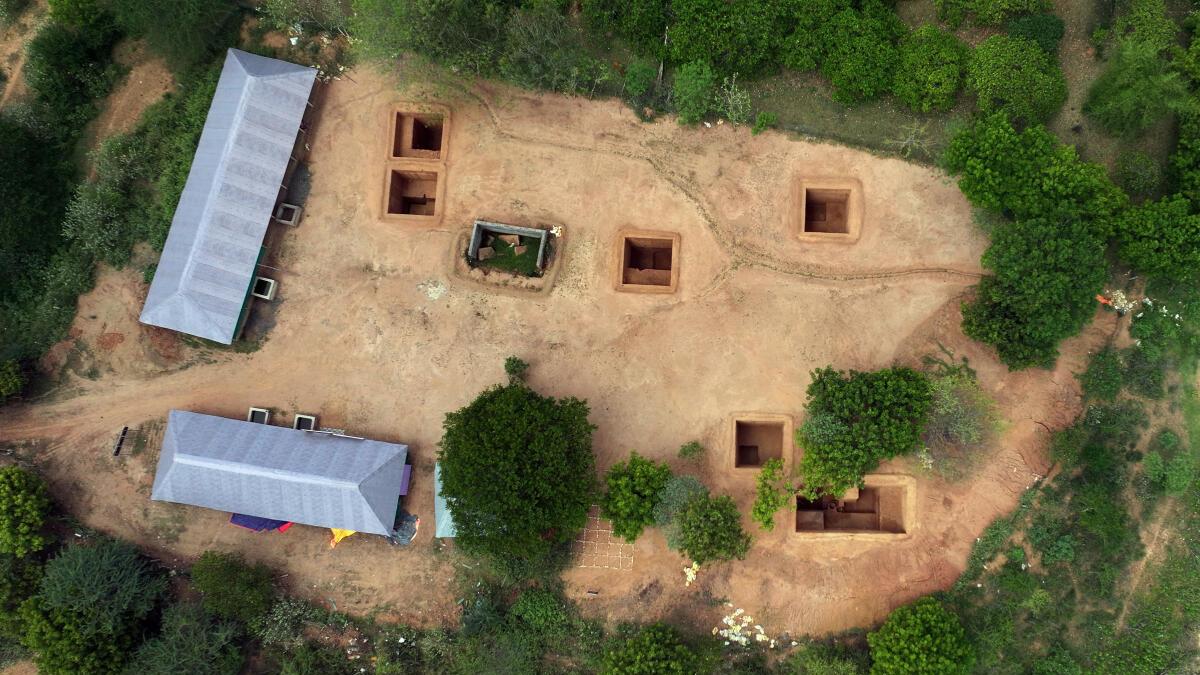
- 21 Jul 2025
In News:
The Tamil Nadu State Department of Archaeology (TNSDA) has completed a landmark archaeological excavation at Marungur village, located in Panruti taluk, Cuddalore district, uncovering a habitation-cum-burial site dating from the Iron Age to the Early Historic period. This multidisciplinary excavation offers significant insights into the cultural evolution of ancient Tamil Nadu’s Naduvil Mandalam (Central Territorial Division), between the Thenpennai and Vada Vellar rivers.
Key Features:
1. Rare Dual Site Discovery
- Both a habitation mound and an associated burial site were found together — a rarity in Tamil Nadu.
- The site is situated at 100 metres above mean sea level, adjacent to a pond and covered by laterite soil.
2. Chronological Context
- Dated tentatively to the transition from late Iron Age to Early Historic Period.
- Radiocarbon dating (AMS) of charcoal samples, phytolith studies, and Optically Stimulated Luminescence (OSL) analysis are underway to confirm dates.
3. Advanced Techniques Used
- UAV Mapping, LiDAR (Light Detection and Ranging), stratigraphic trenching, and archaeo-botanical studies.
- Collaboration with Beta Analytic Laboratory (USA) and the French Institute of Pondicherry for dating and pollen analysis.
Major Discoveries
A. Habitation Mound (8 Trenches Excavated)
- Pottery: Rouletted ware, red-slipped ware, black-and-red ware, grey ware, coarse red ware, and graffiti-inscribed potsherds (some resembling Indus signs).
- Artifacts (95 antiquities): Bone tools (points), burnishing stones, terracotta pipes, and beads (carnelian, agate, quartz, glass, terracotta).
- Iron implements: Crescent-shaped chisels, knives.
- Conch shell cores and antimony rods (ornamental use).
- Copper coin of Raja Raja Chola I from upper layers.
- Large terracotta storage jars (1.25 m), one containing six bone tools.
B. Burial Site (2 Trenches Excavated in Cashew Grove)
- Megalithic Stone Circles (Laterite):
- Two concentric circles (outer and inner), capstone-protected burial urns.
- Total of 10 urns recovered.
- Grave Goods:
- Iron swords, red jasper beads, black-and-red ware, red-slipped ware.
- Offering pots around urns — evidence of complex burial rituals.
C. Tamil-Brahmi Inscribed Potsherds
- Found in urn burials and dated paleographically to 2nd–3rd century BCE.
- Inscriptions include terms like “a-ti-y(a)-ka-n”, “a-ma-?”, and “a-ta”.
- Significance: Among earliest epigraphic evidence of Tamil-Brahmi in burial contexts.
Significance:
|
Aspect |
Significance |
|
Cultural Chronology |
Sheds light on the transition from the Iron Age to Early Historic society. |
|
Urban & Trade Patterns |
Proximity to ancient port cities like Arikamedu and Poompuhar hints at external trade. |
|
Script & Literacy |
Tamil-Brahmi inscriptions expand understanding of early Tamil epigraphy. |
|
Burial Practices |
Megalithic urn burials with grave goods indicate complex socio-religious beliefs. |
|
Scientific Advancement |
Integration of modern remote sensing and dating techniques in Indian archaeology. |
Future Steps
- Radiometric Dating: Charcoal to be analyzed using Accelerator Mass Spectrometry (AMS) in the USA.
- Pollen and phytolith analysis to reconstruct ancient diet and environmental conditions.
- Thermoluminescence and petrology studies to date ceramics and sediment exposure.
- TNSDA proposes further surveys at Manikkollai (30 km from Marungur) for 2025–26.
India Emerges as Global Leader in Real-Time Digital Payments
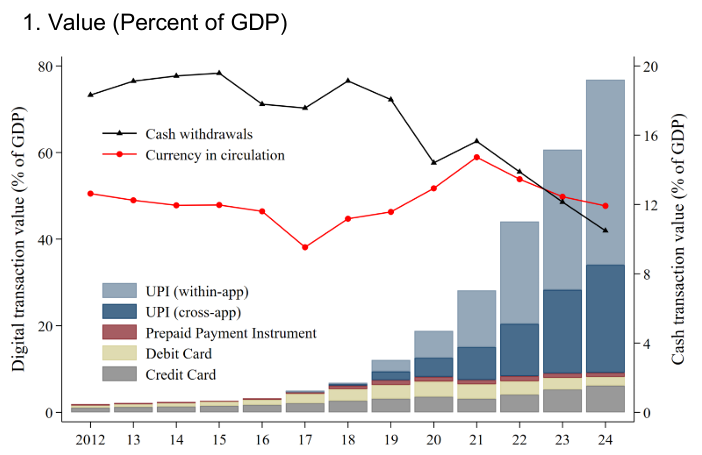
- 21 Jul 2025
In News:
India has cemented its position as the world’s foremost digital payments economy, with the Unified Payments Interface (UPI) registering 18.39 billion transactions in June 2025, according to a report jointly prepared by the International Monetary Fund (IMF) and FIS Global.
About the Report: Fast Payments 2025
- Prepared by: IMF and FIS Global
- Focus: Assessment of digital public infrastructure enabling real-time payments
- Key Metric Introduced: Faster Payment Adoption Score (FPAS) – a benchmark for evaluating the scale and effectiveness of fast payment systems across 30 countries
India’s Standout Performance
- Top Global Rank: India scored 87.5% on FPAS, ranking highest globally—outpacing Brazil, Singapore, the United Kingdom, and the United States.
- UPI Ecosystem Scale:
- Handles over 640 million daily transactions
- Caters to approximately 491 million users and 65 million merchants
- Supported by a network of 675+ banks
- Speed and Cost Efficiency:
- Payment settlement within 5 seconds
- Transactions are virtually cost-free for users
- International Footprint:
- UPI services are now live in seven countries, including France, UAE, and Singapore
- India is advocating its adoption within the BRICS+ grouping as a model for cross-border payment interoperability
Key Strengths of UPI Infrastructure
- Interoperability: Seamless transactions across multiple platforms (PhonePe, Google Pay, Paytm, etc.) and banks
- Inclusivity Features:
- Aadhaar-based linking
- USSD-based services for feature phones
- Multilingual interfaces to facilitate rural access
- Built on India Stack: Utilizes digital infrastructure components like Aadhaar, eKYC, DigiLocker, and Account Aggregator
- Security Framework:
- Real-time fraud detection
- Tokenization and robust regulatory oversight
- Collaborative Ecosystem: A joint effort of NPCI, fintech players, and RBI, ensuring scalability and resilience
88th Executive Committee Session of the Codex Alimentarius Commission (CCEXEC88)
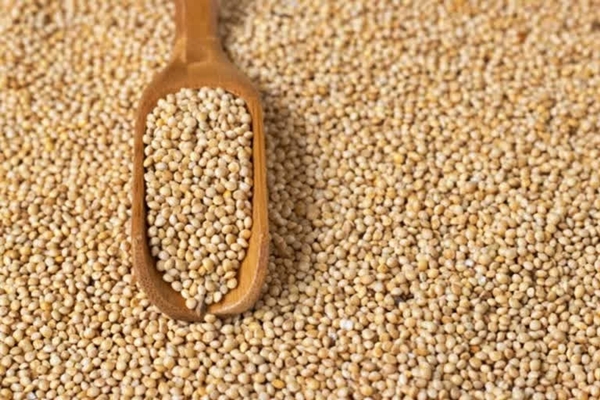
- 21 Jul 2025
In News:
India’s contributions were widely appreciated at the 88th Executive Committee Session of the Codex Alimentarius Commission (CCEXEC88) held at FAO Headquarters, Rome.
What is the Codex Alimentarius?
- A collection of internationally recognized food standards, guidelines, and codes of practice.
- Promotes consumer health protection, food safety, and fair-trade practices.
- Recognized under the WTO Agreement on the Application of Sanitary and Phytosanitary (SPS) Measures as a global reference point.
Codex Alimentarius Commission (CAC)
|
Feature |
Detail |
|
Established |
1963 by FAO and WHO |
|
Type |
Intergovernmental food standards body |
|
Headquarters |
Rome, Italy |
|
Objectives |
To protect consumer health and ensure fair practices in the food trade |
|
Members |
189 members: 188 countries + European Union |
|
India’s Membership |
Since 1964 |
Structure of CAC:
- Codex Commission
- Executive Committee (CCEXEC)
- Codex Secretariat
- Subsidiary Bodies and Committees
Meetings alternate between Geneva and Rome annually. Funded by regular budgets of FAO and WHO.
India’s Contributions at CCEXEC88 (2025):
1. Millet Standards: India chaired the development of Codex group standards for whole millet grains, alongside Mali, Nigeria, and Senegal. These standards are up for final approval at CAC48.
2. Strategic Planning (2026–2031):
- India led discussions on SMART (Specific, Measurable, Achievable, Relevant, Time-bound) indicators for monitoring Codex outcomes.
- These KPIs will guide Codex’s strategic direction and will be adopted at CAC48.
3. Regional Capacity Building:
- India mentored Bhutan, Nepal, Bangladesh, Sri Lanka, and Timor Leste under the Codex Trust Fund (CTF).
- Urged other developing countries to use the CTF for mentorship and twinning programs.
Other Leadership Roles by India in Codex:
|
Domain |
India's Role |
|
Spices & Herbs |
Chairs Codex Committee on Spices and Culinary Herbs (CCSCH) since 2014 |
|
Fresh Produce |
Led standard development for dates, co-chaired for turmeric and broccoli |
|
Digital Participation |
Promotes transparent, inclusive discussions in Codex committees |
National Codex Contact Point (NCCP), India
- Constituted by: Food Safety and Standards Authority of India (FSSAI)
- Role:
- Liaison with the Codex Secretariat
- Coordinate India’s input via National Codex Committee
- Facilitate domestic stakeholder consultation for Codex decisions
Kashi Declaration
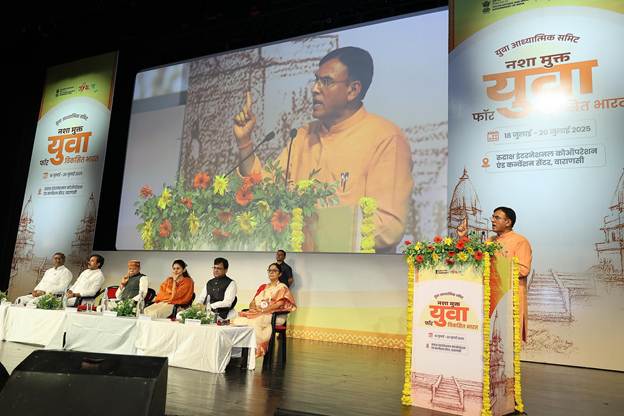
- 21 Jul 2025
In News:
The Youth Spiritual Summit 2025 concluded at the Rudraksh International Convention Centre, Varanasi, with the formal adoption of the Kashi Declaration — a landmark roadmap to combat drug abuse through youth and spiritual leadership.
- Organised by: Ministry of Youth Affairs and Sports
- Theme: "Drug-Free Youth for Developed India"
What is the Kashi Declaration?
The Kashi Declaration is a national action plan to counter substance abuse in India. It integrates spiritual wisdom, youth empowerment, and institutional coordination to establish a Nasha Mukt Yuva (Drug-Free Youth) by 2047, aligning with the vision of Viksit Bharat @2047.
Key Objectives:
- Eradicate Drug Abuse: Mobilise youth to build a drug-free society by 2047.
- Spiritual Mobilisation: Leverage India’s spiritual heritage as a tool for transformation and healing.
- Whole-of-Society Approach: Involve families, schools, communities, and institutions in prevention and rehabilitation.
- Empower Youth Volunteers: Enable MY Bharat clubs to conduct awareness, outreach, and de-addiction drives.
- Institutional Coordination: Establish a Joint National Committee for multi-ministerial convergence and periodic reporting.
Major Features:
|
Feature |
Details |
|
Plenary-Driven Agenda |
Covered themes of psychology, drug trafficking, awareness, and spiritual rehabilitation. |
|
Multi-Ministerial Action |
Involves Ministries of Youth Affairs, Social Justice, Home Affairs, Labour, and Culture. |
|
Annual Review Mechanism |
Progress tracked via the Viksit Bharat Young Leaders Dialogue 2026. |
|
Digital Monitoring |
Measures proposed to curb online targeting of schoolchildren for drugs. |
|
Community Outreach |
Grassroots campaigns, pledge drives, and support services launched through the MY Bharat platform. |
Institutional Mechanisms Proposed:
- Joint National Committee: For inter-ministerial coordination and implementation oversight.
- Annual Progress Reporting: Ensures transparent monitoring and accountability.
- National Platform: To connect affected youth with rehabilitation and support services.
Biostimulants
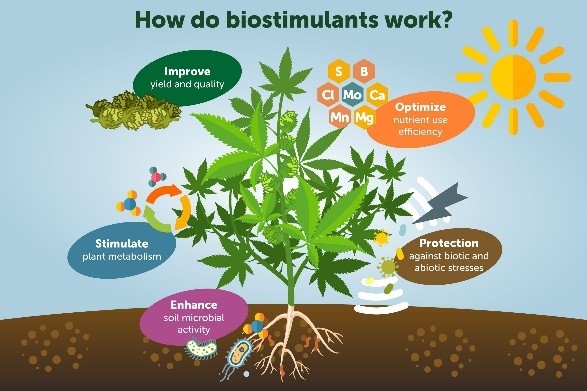
- 21 Jul 2025
In News:
Union Agriculture Minister Shivraj Singh Chouhan last week wrote to Chief Ministers of all states to immediately stop the “forced tagging” of nano-fertilisers or biostimulants along with conventional fertilisers.
What are Biostimulants?
Biostimulants are substances or microorganisms that enhance nutrient uptake, plant growth, yield, and stress resistance in crops. They are distinct from fertilisers and pesticides, as they do not directly supply nutrients or control pests.
- Composition: Often derived from plant waste, seaweed extracts, or microbes.
- Function: Stimulate physiological processes in plants.
- Not classified as: Fertilisers (under nutrient input) or Pesticides (regulated under Insecticides Act, 1968).
Official Definition (FCO, 1985): A substance or microorganism whose primary function is to stimulate physiological processes in plants, enhancing nutrient uptake, growth, and yield—but not including pesticides or plant growth regulators.
Regulatory Framework
- Governing Law: Fertiliser Control Order (FCO), 1985 – amended in February 2021 to include biostimulants.
- Central Biostimulant Committee (CBC): Established in April 2021 for five years to advise the Ministry on:
- Product approval and specifications
- Sampling/testing methods
- Lab and data standards
Toxicity and Safety Requirements:
To be approved, biostimulants must undergo:
- 5 acute toxicity tests: Oral, dermal, inhalation (rat), skin, and eye irritation (rabbit)
- 4 eco-toxicity tests: Impact on fish, birds, honeybees, and earthworms
- Field trials: At 3 agro-ecological zones, with 3 doses, for one crop season
No biostimulant shall contain pesticide beyond 0.01 ppm.
Why Tightened Regulation?
- Previous Lack of Oversight: Biostimulants operated in a regulatory vacuum for years.
- Market Flooded with Unapproved Products: Over 30,000 unregulated products were in circulation.
- Farmer Complaints: Rising concerns over efficacy and “forced sales” with subsidised fertilisers like urea and DAP.
- Judicial Push: A 2011 Punjab & Haryana HC observation prompted states to monitor biostimulant sales more stringently.
Recent Government Measures
- Provisional Registration (2021–2024): Allowed 2-year sale of products while testing was underway. Deadline extended repeatedly until June 16, 2024. Post-June 2024: Unsold stocks from unregistered firms are no longer permitted for sale.
- Retailer Misuse: Reports of retailers forcing farmers to buy biostimulants with subsidised fertilisers prompted Union Agriculture Minister Shivraj Singh Chouhan to direct states to halt such practices.
- Product Crackdown: From over 8,000 products four years ago, the number of approved products is now down to 650.
- Crop-Specific Specifications (May 2025): Government notified biostimulant standards for crops including tomato, chilli, brinjal, paddy, cotton, potato, soybean, maize, etc.
Prithvi-II and Agni-I Ballistic Missiles
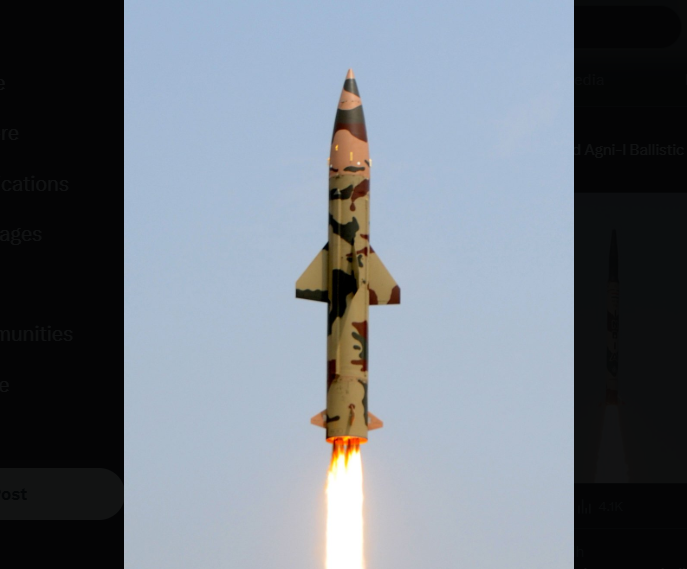
- 19 Jul 2025
In News:
India recently conducted successful test-firings of its nuclear-capable short-range ballistic missiles Prithvi-II and Agni-I from the Integrated Test Range (ITR), Chandipur, Odisha. The trials aimed to validate operational readiness and technical reliability of India’s strategic missile systems.
These tests follow closely on the heels of the Indian Army's successful high-altitude test of the Akash Prime air defence system in Ladakh, underscoring India’s advancing indigenous defence capabilities.
Strategic Significance
- Conducted by: Strategic Forces Command (SFC) under routine training and validation exercises.
- Developed by: Defence Research and Development Organisation (DRDO) under the Integrated Guided Missile Development Programme (IGMDP).
- Purpose:
- To validate accuracy, technical parameters, and combat readiness.
- To reinforce India’s nuclear deterrence and second-strike capability.
- To ensure strategic preparedness post the May 2025 Indo-Pak conflict.
Prithvi-II Missile: Key Features
|
Parameter |
Details |
|
Type |
Short-range, surface-to-surface ballistic missile |
|
Range |
~350 km |
|
Propulsion |
Liquid-fuelled |
|
Payload Capacity |
Up to 500 kg |
|
Warhead Type |
Conventional and nuclear |
|
Navigation |
Advanced inertial navigation system |
|
Deployment |
Road-mobile launcher |
|
Speed |
Above Mach 1 |
|
Role |
Part of India’s tactical nuclear strike capability |
Agni-I Missile: Key Features
|
Parameter |
Details |
|
Type |
Short-range, single-stage ballistic missile |
|
Range |
700–900 km |
|
Propulsion |
Solid-fuelled |
|
Payload Capacity |
Up to 1,000 kg |
|
Warhead Type |
Conventional and nuclear |
|
Accuracy |
High precision with advanced guidance |
|
Induction |
Early 2000s, operational with Indian Army |
|
Strategic Role |
Integral to India’s minimum credible deterrence posture |
Green Synthesis of Hydrogen Peroxide
- 19 Jul 2025
In News:
Indian scientists at the S.N. Bose National Centre for Basic Sciences (SNBNCBS) have developed a novel, eco-friendly method to synthesize hydrogen peroxide (H?O?) directly from sunlight and water using a photocatalyst called Mo-DHTA COF. This innovation marks a significant advancement in green chemistry and sustainable industrial practices.
What is Hydrogen Peroxide (H?O?)?
- A colorless, bitter-tasting liquid with powerful oxidizing properties.
- Environmentally friendly: Decomposes into water and oxygen without leaving harmful residues.
- Naturally present in trace amounts in the atmosphere.
- Unstable and decomposes readily, releasing heat.
- Found in household use (3–9% concentration) for disinfection, bleaching, and wound cleaning.
Applications
- Medical: Disinfectant, wound cleaner.
- Industrial: Textile and paper bleaching, foam rubber production, and rocket propellant.
- Environmental: Wastewater treatment, green sterilization.
- Energy & Chemistry: Fuel cells, chemical synthesis, and potentially in CO? reduction and water splitting.
Limitations of Conventional H?O? Production
- Energy-intensive and environmentally hazardous.
- Costly and not sustainable for large-scale, decentralized applications.
The Innovation: Mo-DHTA COF
What is it?
- Mo-DHTA COF stands for dimolybdenum paddlewheel-embedded Covalent Organic Framework.
- Developed by a DST-supported research team at SNBNCBS.
- Published in the journal Small.
Photocatalytic Mechanism
- Made from α-hydroquinone-based organic linkers and dimolybdenum units.
- Upon visible light exposure, the material generates excitons (electron-hole pairs).
- Electrons reduce oxygen to superoxide radicals, which then convert to H?O? through further reactions.
- Functions in various media (ethanol, benzyl alcohol, and even pure water).
Advantages of Mo-DHTA COF
|
Feature |
Description |
|
Eco-Friendly |
Uses only water and sunlight—no harmful by-products. |
|
High Photocatalytic Efficiency |
Effective even in pure water, not just organic solvents. |
|
Stability |
Structurally stable and recyclable, suitable for long-term use. |
|
Enhanced Performance |
Overcomes limitations of earlier photocatalysts like metal oxides, g-C?N?, and MOFs. |
|
Scalable |
Promising for industrial upscaling and decentralized chemical production. |
Significance and Future Potential
- Green Chemistry: Sets a foundation for cleaner chemical production methods.
- Healthcare & Pharma: Enables low-cost production of disinfectants.
- Environmental Remediation: Supports sustainable water purification and sterilization.
- Energy & Materials Science: Potential use in CO? reduction, water splitting, and fuel cell technologies.
- Research Outlook: Future focus includes optimization of metal-embedded COFs and exploring other catalytic systems for broader applications.
Akash Prime Missile System

- 19 Jul 2025
In News:
India has successfully conducted a high-altitude trial of the Akash Prime surface-to-air missile system in Ladakh, marking a major step in strengthening indigenous air defence capabilities, particularly for mountainous and high-altitude terrains.
What is Akash Prime?
Akash Prime is an upgraded variant of the Akash Surface-to-Air Missile (SAM) system, developed by the Defence Research and Development Organisation (DRDO). It is designed to operate efficiently in high-altitude, low-oxygen environments—ideal for India’s sensitive border regions like Ladakh and Sikkim.
Developers
- DRDO – Lead developer
- In collaboration with:
- Bharat Dynamics Limited (BDL)
- Bharat Electronics Limited (BEL)
Key Features
|
Feature |
Description |
|
Purpose |
Neutralizes aerial threats like enemy aircraft, drones, and cruise missiles |
|
Altitude Performance |
Successfully tested at 15,000 ft; engineered for deployment above 4,500 metres |
|
Seeker Technology |
Equipped with an indigenous Radio Frequency (RF) seeker for precise target acquisition during terminal phase |
|
Guidance System |
Hybrid: Command guidance + terminal active homing |
|
Range & Speed |
Operates within 25–30 km range; travels at Mach 2.5 |
|
Mobility |
Mounted on mobile platforms for rapid deployment across terrains |
|
All-Weather Capability |
Functions in extreme cold and low-density atmospheric conditions |
|
Kill Probability |
88% (single missile); up to 98.5% in dual-salvo mode |
Operational Significance
- High-Altitude Readiness: Specifically tailored for mountainous regions such as the Line of Actual Control (LAC).
- Versatile Deployment: Protects mobile, semi-mobile, and fixed military installations.
- Strategic Feedback Integration: Incorporates enhancements based on feedback from armed forces for use in vital installations.
Strategic Importance
- Aatmanirbhar Bharat: Fully indigenous system contributing to self-reliance in defence manufacturing.
- Cost Efficiency: Reduces dependency on imported air defence systems.
- Force Multiplier: Strengthens India’s layered air defence network against modern aerial threats.
Swachh Survekshan 2024–25
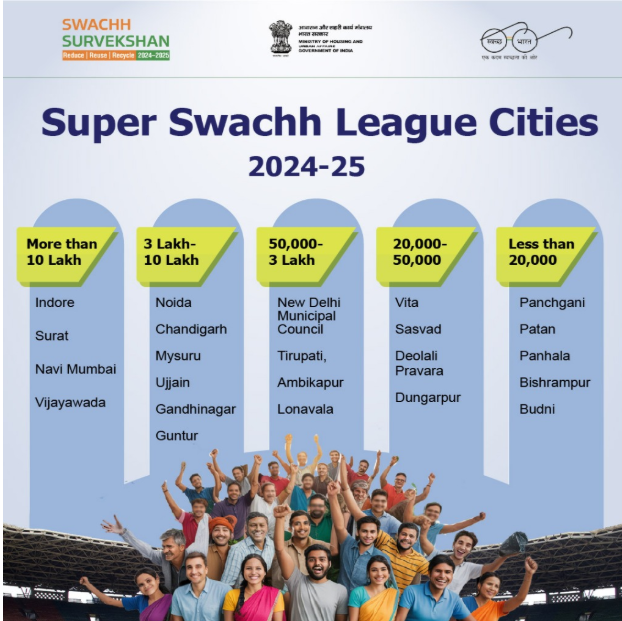
- 19 Jul 2025
In News:
Swachh Survekshan 2024–25, the world's largest urban sanitation survey, has marked a new milestone in India’s cleanliness journey under the Swachh Bharat Mission–Urban (SBM-U). Conducted by the Ministry of Housing and Urban Affairs (MoHUA), this 9th edition evaluated 4,500+ Urban Local Bodies (ULBs), reflecting deepened citizen engagement and growing competition among cities.
Key Highlights
- Cleanest Big City (10+ lakh population): Ahmedabad (Gujarat) ranked 1st for the first time, Bhopal (Madhya Pradesh), Surat (Gujarat).
- Swachh Bharat Super League 1.0: Introduced for cities with sustained performance—Indore, Surat, and Navi Mumbai led the league.
- Top Mid-Sized Cities (3–10 lakh): Mira-Bhayandar (1st), Bilaspur (2nd), Jamshedpur (3rd).
- Top Small Cities (<1 lakh): Sasvad (1st), Lonavala, Vita.
- Best Ganga Towns: Prayagraj, Varanasi, and Bijnor.
- Cleanest Cantonment: Secunderabad Cantonment Board.
- Best Performing States: Maharashtra, Madhya Pradesh, Chhattisgarh.
- Cleanest State Capital: Bhopal.
- Sanitation Worker Safety Awards: Visakhapatnam, Jabalpur, and Gorakhpur were recognised under SafaiMitra Surakshit Shehar.
Swachh Survekshan Framework
- Launched: 2016 under SBM-U.
- Objective: Foster competition among cities for sanitation and cleanliness.
- 2024–25 Innovations:
- One City, One Award principle for fair evaluation across population sizes.
- Super Swachh League: Honours cities with consistent top-tier performance.
- Real-time monitoring: Integrated Command and Control Centres (ICCCs) used for validation.
- Digital citizen engagement: Over 14 crore citizens participated via apps and feedback systems.
- 3R Emphasis: Focus on Reduce, Reuse, Recycle as a sustainability principle.
Super Swachh League (SSL)
- A newly created elite category within the survey.
- Aim: To promote continuous excellence in urban sanitation.
- Criteria:
- Minimum 3-star Garbage Free City (GFC) rating.
- Consistent top performance in waste management, segregation, ODF++ status, and citizen engagement.
- Population Brackets:
- 10 lakh+ (e.g., Ahmedabad, Indore, Surat)
- 3–10 lakh (e.g., Mysuru, Noida, Chandigarh)
- Below 3 lakh (with revised benchmarks)
Recognitions and Best Practices
- Waste-to-Wealth Initiatives: Recycled waste used to create artistic gifts for dignitaries.
- “Each One Clean One” Mentorship: Top 78 cities to mentor one lower-performing city each.
- Clean Kumbh Operations: Prayagraj efficiently managed waste during the Mahakumbh, which witnessed a footfall of 66 crore pilgrims.
- AI-Based Monitoring: Artificial intelligence tools deployed for cleanliness validation.
- Citizen-Centric Innovations: Apps and grievance portals boosted accountability.
Impact on Governance and Society
- Decentralised Sanitation Success: Cities like Bilaspur and Jamshedpur emerged as sanitation leaders.
- Inclusion of Smaller Towns: Simplified evaluation allowed small towns to compete on equal footing.
- Women & Youth Engagement: SHGs and youth campaigns played a major role in waste segregation drives.
- Job Creation & Entrepreneurship: Growth in green jobs and circular economy-based startups.
- Sanitation Worker Welfare: Greater focus on dignity, safety, and health of SafaiMitras.
Swachh Bharat Mission–Urban (SBM-U)
- Launched: October 2, 2014
- Phase II (SBM-U 2.0): Running from October 1, 2021 to 2026
- Goals:
- Eliminate open defecation
- Ensure 100% scientific waste management
- Make cities “Garbage-Free”
- Aligned with: India’s SDG 2030 goals and Viksit Bharat 2047 vision
Gujarat launches India’s First Tribal Genome Sequencing Project
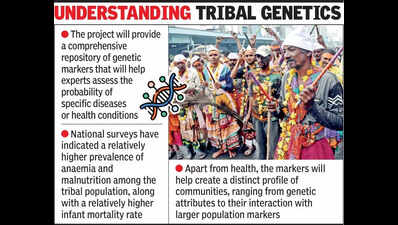
- 19 Jul 2025
In News:
Gujarat has become the first Indian state to launch a genome sequencing initiative specifically targeting tribal communities. The Tribal Genome Sequencing Project, announced in July 2025, aims to identify genetic health risks among tribal populations and develop precision healthcare strategies.
About the Project
- Name: Creation of Reference Genome Database for Tribal Population in Gujarat
- Launched by: Gujarat Biotechnology Research Centre (GBRC)
- Coverage: 2,000 individuals from tribal communities across 17 districts in Gujarat
- Budgetary Support: Part of the Gujarat State Budget 2025–26
Objectives
- Identify genetic risk markers for inherited disorders such as:
- Sickle cell anaemia
- Thalassaemia
- Hereditary cancers
- Develop personalised healthcare protocols tailored to tribal genetic profiles.
- Detect natural immunity markers to aid targeted medical interventions.
- Promote data-driven tribal health equity and science-led empowerment.
Key Features
- Establishes advanced infrastructure for:
- Sample collection
- Genome sequencing
- Genetic data interpretation
- Enables early detection and targeted treatment for genetically inherited diseases.
- Involves community engagement for inclusive participation and awareness.
- Represents diverse tribal groups, ensuring comprehensive genomic mapping.
Significance
- Healthcare Equity: Bridges the healthcare gap by enabling affordable, preventive, and precision medicine for marginalised tribal communities.
- Scientific Advancement: Provides a genomic reference database for long-term public health research and policy planning.
- Scalability: Sets a precedent for other Indian states to replicate region-specific genomic initiatives aimed at health inclusion.
What is Genome Sequencing?
- A genome is the complete set of DNA in an organism.
- Human DNA comprises 23 pairs of chromosomes, made up of millions of nucleotide bases: Adenine (A), Thymine (T), Guanine (G), Cytosine (C)
- Whole Genome Sequencing (WGS) decodes the exact sequence of these bases, helping identify genetic disorders and traits.
ADEETIE Scheme
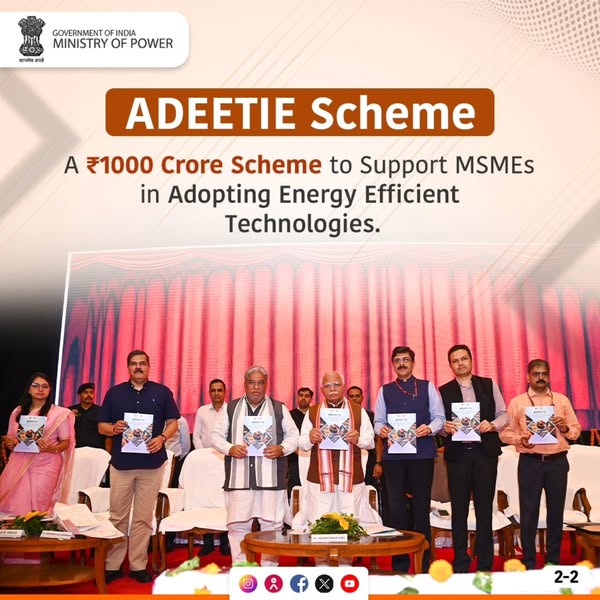
- 18 Jul 2025
In News:
The Ministry of Power launched the Assistance in Deploying Energy Efficient Technologies in Industries & Establishments (ADEETIE) scheme to promote energy efficiency in Micro, Small, and Medium Enterprises (MSMEs).
Key Details:
- Objective: To reduce energy consumption by 30–50%, enhance the power-to-product ratio, and facilitate the creation of green energy corridors in MSME industrial sectors.
- Implementing Agency:
- o Bureau of Energy Efficiency (BEE), under the Ministry of Power
- o Legislative backing: Energy Conservation Act, 2001
- Duration & Funding
- o Period: FY 2025–26 to 2027–28 (3 years)
- o Budgetary Outlay: ?1000 crore
- Target Beneficiaries
- Eligible Enterprises: MSMEs with Udyam ID
- Must demonstrate a minimum 10% energy savings using implemented technologies
- Sectoral Coverage: Targets 14 energy-intensive sectors, including: Brass, Bricks, Ceramics, Chemicals, Fisheries, Food Processing, etc.
- Implementation Strategy Phased Roll-out:
- Phase 1: 60 industrial clusters
- Phase 2: Additional 100 clusters
Scheme Components
|
Component |
Details |
|
Interest Subvention |
- 5% for Micro & Small Enterprises |
|
Technical Assistance |
- Investment Grade Energy Audits (IGEA) |
|
Financial Support |
- Incentives for adoption of efficient technologies |
Other BEE Initiatives for MSMEs
|
Initiative |
Purpose |
|
BEE-SME Programme |
Promote energy efficiency in MSMEs |
|
National Programme on Energy Efficiency & Technology Upgradation |
Modernize and reduce energy intensity |
|
SIDHIEE Portal |
Digital tool providing energy efficiency insights and handholding support |
Bureau of Energy Efficiency (BEE)
- The Government of India set up the Bureau of Energy Efficiency (BEE) on March 1, 2002 under the provisions of the Energy Conservation Act, 2001.
- The mission of the Bureau of Energy Efficiency is to assist in developing policies and strategies with a thrust on self-regulation and market principles, within the overall framework of the Energy Conservation Act, 2001 with the primary objective of reducing the energy intensity of the Indian economy.
- BEE coordinates with designated consumers, designated agencies and other organizations and recognises, identifies and utilises the existing resources and infrastructure, in performing the functions assigned to it under the Energy Conservation Act.
- The Energy Conservation Act provides for regulatory and promotional functions.
Prime Minister Professorships Scheme
- 18 Jul 2025
In News:
To strengthen India’s research and innovation ecosystem, the Anusandhan National Research Foundation (ANRF) has launched the Prime Minister Professorships under its flagship Promoting Advanced and Inclusive Research (PAIR) programme.
Objective
The scheme aims to:
- Utilize the expertise of retired scientists, industry professionals, and Professors of Practice
- Mentor faculty and students in State universities with emerging research ecosystems
- Address gaps in R&D capacity and promote globally competitive research
Key Features of the Prime Minister Professorship Scheme
|
Aspect |
Details |
|
Implementing Agency |
Anusandhan National Research Foundation (ANRF), under DST |
|
Eligibility |
- Superannuated scientists/faculty from reputed Indian/foreign institutions |
|
Host Institutions |
Category A State universities classified as spoke institutions under the PAIR programme |
|
Relocation Requirement |
Full-time presence at the host university is mandatory |
|
Tenure |
Up to 5 years, based on performance review |
|
Financial Support |
?30 lakh/year fellowship ?24 lakh/year research grant ?1 lakh/year overhead for host university |
|
Restrictions |
Cannot draw parallel fellowship/salary from other institutions; IP rights governed by host institution norms |
About PAIR Programme
|
Component |
Description |
|
Goal |
To foster inclusive, high-quality research in institutions with limited R&D capacity |
|
Hub Institutions |
Top 25 in NIRF rankings or Institutions of National Importance (within top 50) |
|
Spoke Institutions |
Central & State public universities, select NITs and IIITs |
|
Mentorship Ratio |
One hub can mentor up to 7 spoke institutions |
|
Participation Criteria |
|
Responsibilities of Selected Professors
- Mentor students and faculty for world-class research
- Guide establishment of labs and research facilities
- Promote interdisciplinary collaboration
- Facilitate industry-research linkages
- Provide 6-month internships at advanced labs or institutions
Significance for India’s R&D Ecosystem
- Addresses regional imbalance in research infrastructure
- Strengthens the research culture in State universities
- Enables structured national and international collaborations
- Promotes grassroots innovation and scientific leadership
India’s First Digital Nomad Village in Sikkim
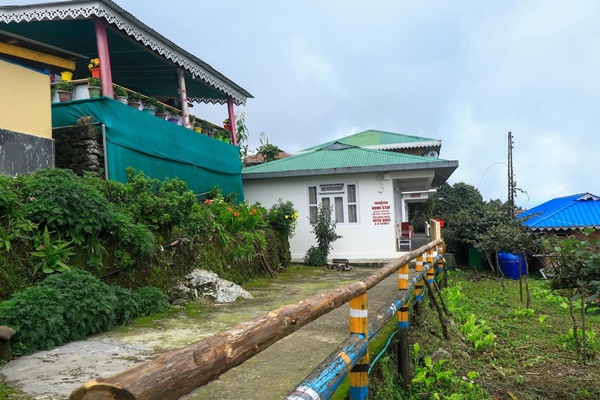
- 18 Jul 2025
In News:
Yakten, a village in Pakyong district, Sikkim, was officially declared India’s first Digital Nomad Village under the ‘Nomad Sikkim’ initiative.
Objective of the Initiative
- Transform strategic locations in Sikkim into year-round hubs for digital professionals from India and abroad.
- Ensure sustainable income for homestay owners during the lean tourism season (April–October).
- Promote sustainable tourism, remote work, and grassroots entrepreneurship.
Key Features:
|
Feature |
Details |
|
Connectivity |
Village-wide Wi-Fi, dual internet lines |
|
Electricity |
Inverters for uninterrupted power supply |
|
Eco-Initiatives |
Zero-waste management, eco-friendly practices |
|
Water Security |
Long-term solution planned under Jal Jeevan Mission |
|
Employment Focus |
Aligned with CM’s “One Family, One Entrepreneur” mission |
Who is a Digital Nomad?
A digital nomad is a person who uses technology to work remotely while traveling or residing in different locations, often in scenic or peaceful areas.
Implementation Partners
- District Administration (Pakyong)
- NGO Sarvahitey
Sikkim: A Pioneer in Sustainable Development
Sikkim holds the distinction of being:
- India’s first fully organic state (2016)
- First state to achieve 100% ODF status (2016)
- First to introduce organic aquaculture
Quantum Noise and Intraparticle Entanglement
- 18 Jul 2025
In News:
A collaborative study led by the Raman Research Institute (RRI), Bengaluru, in association with Indian and international institutions, has made a groundbreaking discovery: quantum noise, often seen as a disruptive factor in quantum systems, may facilitate or even revive quantum entanglement under specific conditions.
Key Scientific Concept: Quantum Entanglement
- Quantum Entanglement: A quantum phenomenon where particles remain interconnected such that the state of one particle instantly influences the state of another, regardless of distance.
- Intraparticle Entanglement: A lesser-known form of entanglement occurring between different properties (degrees of freedom) of a single particle, as opposed to interparticle entanglement (between two or more particles).
The Discovery
- Contrary to long-held assumptions, quantum noise, specifically amplitude damping, can:
- Revive lost intraparticle entanglement
- Generate entanglement in initially unentangled intraparticle systems
- In contrast, interparticle entanglement under similar noise conditions only decays without revival.
Types of Quantum Noise Studied
- Amplitude Damping: Simulates energy loss, akin to an excited state relaxing to a ground state.
- Phase Damping: Disrupts phase relationships, impacting quantum interference.
- Depolarizing Noise: Randomizes the quantum state in all directions.
- Key Finding: Intraparticle entanglement is more robust and less susceptible to decay across all three noise types.
- Scientific Tools Used
- Derived an analytical formula for concurrence (a measure of entanglement)
- Developed a geometric representation of how entanglement behaves under noise
Institutions Involved
- Raman Research Institute (RRI) – Lead Institute (Autonomous under DST)
- Indian Institute of Science (IISc)
- Indian Institute of Science Education and Research (IISER), Kolkata
- University of Calgary
- Funded by:
- India-Trento Programme on Advanced Research (ITPAR)
- National Quantum Mission (NQM), Department of Science and Technology (DST)
Applications and Significance
- Could lead to more stable and efficient quantum systems
- Implications for Quantum Communication and Quantum Computing
- Results are platform-independent (applicable to photons, trapped ions, neutrons)
- Provides a realistic noise model (Global Noise Model) for practical quantum technologies
Maglev Technology
- 18 Jul 2025
In News:
China has successfully tested magnetic levitation (Maglev) technology, potentially enabling trains to travel faster than aircraft.
What is Maglev Technology?
Magnetic Levitation (Maglev) is an advanced transportation technology that uses electromagnetic forces to levitate and propel trains without physical contact with the track. The train is lifted off the track using opposing magnetic fields, eliminating friction and enabling extremely smooth, silent, and high-speed travel.
Origin and Development
- Inventors: Robert Goddard (USA) and Emile Bachelet (French-American) first conceptualized maglevs in the early 1900s.
- Commercial Use: Maglev systems have been operational since 1984.
How Maglev Works
Maglev trains operate on three core principles:
- Levitation: Magnets lift the train above the guideway.
- Guidance: Electromagnets maintain lateral stability.
- Propulsion: Linear motors create magnetic fields that push/pull the train forward.
- The system involves superconducting magnets or electromagnets embedded in both the train and the track (guideway).
- Recent advancements include the use of high-temperature superconducting levitation and vacuum tubes, reducing air resistance and energy loss.
Recent Breakthrough: China's Supersonic Maglev
- Developed by: China Railway Rolling Stock Corporation (CRRC)
- Top Speed Achieved: 620+ mph (998+ km/h), faster than commercial aircraft (547–575 mph).
- Latest Test Site: Donghu Laboratory, Hubei Province, June 2024.
- A 1.1-ton train accelerated to 404 mph in under 7 seconds on a 1,968-foot track inside a vacuum tube.
- Design:
- Sleek, aerodynamic nose to reduce drag.
- Spacious interior with digital displays for passenger comfort.
Future Potential
- Travel Time Reduction:
- Beijing–Shanghai: From 5.5 hours (current high-speed rail) to 2.5 hours.
- Delhi–Kolkata (if implemented in India): Estimated to take under 2.5 hours for ~1,200 km.
- Ongoing Projects: Full-scale high-speed maglev tracks expected to be completed in China by end of 2025.
Key advantages of Maglev
|
Feature |
Benefits |
|
Speed |
Exceeds 600 km/h; faster than short-haul flights |
|
Efficiency |
Lower energy loss; high acceleration/deceleration capacity |
|
Eco-Friendliness |
Zero direct emissions; compatible with renewable energy |
|
Low Maintenance |
No physical contact = minimal wear & tear |
|
Passenger Comfort |
Silent ride with negligible vibration |
Behdeinkhlam Festival
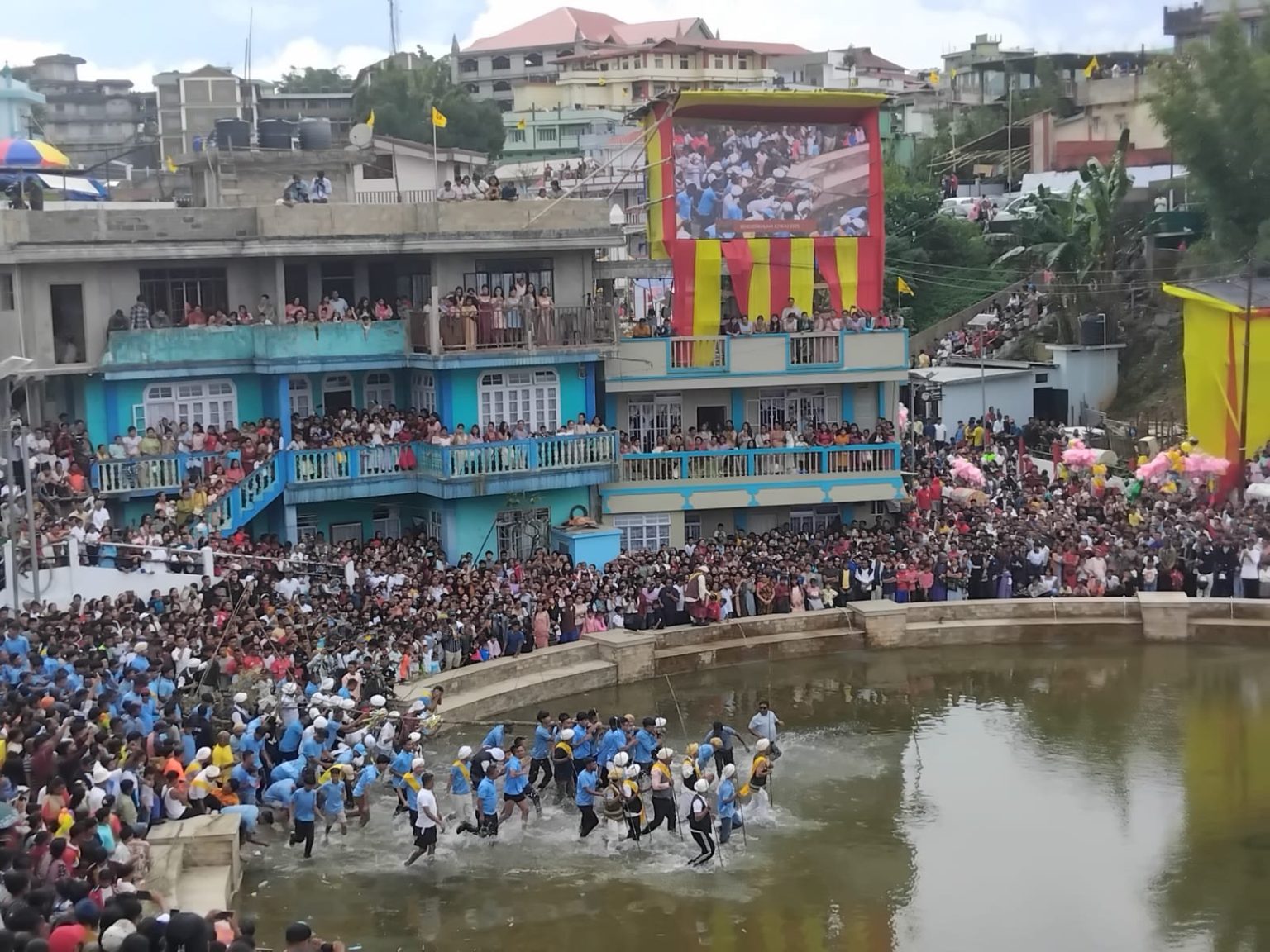
- 17 Jul 2025
In News:
The Behdeinkhlam Festival, a vibrant cultural and religious celebration of the Pnar community in Jowai, Meghalaya, was recently observed with great enthusiasm. Blending age-old indigenous rituals with contemporary social messages, the festival reflects the rich cultural heritage and evolving societal concerns of the Jaintia Hills region.
Etymology and Meaning
- The term “Behdeinkhlam” comes from the Pnar language:
- “Beh Dien” – to drive away with sticks or prayers.
- “Khlam” – refers to plague, pestilence, or disease.
- Thus, the name signifies a ritual expulsion of illness, evil spirits, and misfortune, historically associated with diseases like cholera.
Cultural and Religious Significance
- Primarily celebrated by the Pnars, a sub-tribe of the Jaintia community, the festival is a symbolic act of:
- Protecting society from disease.
- Invoking blessings for a bountiful harvest.
- Promoting community health, peace, and prosperity.
- It plays a crucial role in preserving the Niamtre faith, the indigenous religion of the Jaintia people, through intergenerational participation in ritual practices.
Timing and Duration
- Held annually in July, right after the sowing season, the festival lasts for three days.
- The timing is agriculturally significant, linking health rituals with hopes for a successful farming cycle.
Key Rituals and Celebrations
- Symbolic Rituals:
- Men go around beating the roofs of houses with bamboo poles to drive away evil spirits and symbolic disease.
- Tree trunks known as Dein Khlam and Khnong—rounded, straight, and polished—are brought from the forest and used in the main rituals.
- Community Processions:
- A sacred wooden post called Symbud Khnong is carried around the town and installed as a spiritual safeguard.
- Gender Roles in Rituals:
- Men perform dances, carry the sacred logs, and lead the processions.
- Women play a vital ceremonial role by preparing sacrificial food for ancestral spirits.
- Dance and Music: On the final day, the community gathers at Aitnar, where both young and old dance to the rhythmic beats of pipes and drums.
- Dad-Lawakor – Traditional Game: A unique football-like game called Dad-lawakor is played at Mynthong, showcasing indigenous sporting traditions and community bonding.
Contemporary Relevance
- In recent years, the festival has evolved to incorporate modern themes such as:
- Awareness against drug abuse
- Prevention of alcoholism
- Climate change consciousness
- These additions reflect a harmonious blending of tradition and modernity, where festivals serve both spiritual and civic functions.
Sierra Leone’s First UNESCO World Heritage Site
- 17 Jul 2025
In News:
In a landmark achievement for global environmental conservation, Sierra Leone has secured its first UNESCO World Heritage Site with the inscription of the Gola-Tiwai Complex, comprising the Tiwai Island Wildlife Sanctuary and the Gola Rainforest National Park (GRNP). This milestone is the result of over three decades of environmental activism led by Tommy Garnett, founder of the Environmental Foundation for Africa (EFA).
About the Gola-Tiwai World Heritage Site
Location
- Southern Sierra Leone, along the Moa River, near the Liberia border.
Components
- Tiwai Island Wildlife Sanctuary
- Area: Only 12 sq. km
- Biodiversity: Home to 11 primate species, including:
- Western Chimpanzee (endangered)
- Diana Monkey
- *King Colobus Monkey
- Serves as a biodiversity research hub and ecotourism destination in West Africa.
- Gola Rainforest National Park
- Sierra Leone’s largest tropical rainforest
- Biodiversity Highlights:
- Pygmy Hippopotamus
- Critically Endangered African Forest Elephant
- Numerous bird, insect, and plant species
- Provides critical services such as:
- Carbon sequestration
- Climate regulation
- Genetic biodiversity conservation
Ecological and Global Significance
- Biodiversity Hotspot: The Gola-Tiwai complex is one of the most biologically diverse areas in West Africa.
- Sustainable Development Model:
- Combines community engagement, scientific research, and eco-tourism.
- Sets a precedent for post-conflict environmental restoration.
- Global Climate Importance: The rainforest acts as a carbon sink, playing a role in mitigating climate change.
- Cultural-Ecological Linkages: Local communities depend on forests for livelihoods, traditions, and spiritual practices.
Geographical Context: Sierra Leone
Capital: Freetown
- Located on a peninsula with one of the world’s largest natural harbours.
Neighbouring Countries: Guinea (North and East), Liberia (Southeast), Atlantic Ocean (Southwest)
Key Geographical Features:
- Mountains:
- Mount Bintimani (Loma Mansa) – Highest peak at 1,948 m (6,391 ft)
- Tingi Hills, Sula Plateau, Kambui Schists
- Rivers:
- Major rivers: Moa, Sewa, Mano, Rokel
- Originate in Fouta Djallon highlands in Guinea
- Coastal Plains: Include mangrove swamps, lateritic soils, and seasonally flooded Bolilands
- Climate: Tropical with high rainfall and Harmattan winds in dry seasons
Natural Resources:
- Rich in diamonds, gold, rutile, and bauxite
- Economy based on mining and agriculture
Noctilucent Clouds
- 17 Jul 2025
In News:
Recently, rare noctilucent clouds were sighted over parts of Scotland, drawing attention due to their unique shimmering appearance in the night sky. These occurrences are significant in the context of climate studies and upper atmospheric science.
What are Noctilucent Clouds?
- Definition: Noctilucent clouds (NLCs), also known as polar mesospheric clouds, are high-altitude ice crystal clouds that appear thin, wispy, and glow with a blue or silvery hue after sunset.
- Etymology: The term “noctilucent” is derived from Latin—"nocto" (night) and "lucent" (shining)—meaning "night shining."
Atmospheric Location
- These are the highest clouds in Earth’s atmosphere, found in the mesosphere, around 76–85 km above the Earth's surface.
- In contrast, most other cloud types form in the troposphere, the lowest atmospheric layer.
Seasonal and Geographical Occurrence
- Seasonality:
- Northern Hemisphere: Visible from late May to early August, peaking during June and July.
- Southern Hemisphere: Much rarer; may appear from late November to early February, most commonly in December and January.
- Latitude Range: Typically occur between 45° and 80° latitude, both north and south of the equator.
- Visibility Conditions:
- Seen only during summer months, shortly after sunset or just before sunrise.
- The Sun remains just below the horizon, illuminating these high clouds from below, creating a glowing effect while the lower atmosphere is in darkness.
Formation Mechanism
- Composition: Made up of tiny ice crystals.
- Temperature Conditions: The mesosphere becomes extremely cold during summer, enabling the formation of ice on fine particles.
- Sources of Dust Nuclei:
- Natural: Micrometeorites, volcanic dust.
- Anthropogenic: Rocket exhaust particles and other upper-atmospheric pollutants.
- Optical Phenomenon: These ice crystals reflect sunlight even when the lower atmosphere is dark, giving them their luminous appearance.
Significance
- Serve as indicators of mesospheric conditions, especially temperature and humidity.
- Their increasing frequency and intensity in recent decades may be linked to climate change and human activities, including space exploration.
- Valuable for understanding upper atmospheric dynamics, particularly in the context of atmospheric chemistry and space weather.
Pradhan Mantri Divyasha Kendra (PMDK)
- 17 Jul 2025
In News:
The Union Ministry of Social Justice & Empowerment has recently inaugurated the 75th Pradhan Mantri Divyasha Kendra (PMDK) at the Government Medical College, Badaun, Uttar Pradesh, marking a significant milestone in India's efforts toward inclusive social welfare.
About PMDK
The Pradhan Mantri Divyasha Kendra (PMDK) is a flagship initiative of the Government of India aimed at delivering integrated rehabilitation and assistive services under one roof. It caters primarily to:
- Persons with Disabilities (Divyangjan), as identified under the Rights of Persons with Disabilities Act, 2016.
- Senior Citizens, especially those from economically weaker sections (EWS).
These centres offer comprehensive services including:
- Assessment and evaluation
- Counselling
- Distribution of assistive devices
- Post-distribution follow-up care
Institutional Framework
PMDKs operate under the aegis of the Ministry of Social Justice & Empowerment, and are implemented by the Artificial Limbs Manufacturing Corporation of India (ALIMCO), a Central Public Sector Undertaking under the Department of Empowerment of Persons with Disabilities (DEPwD).
Schemes Implemented through PMDKs
- Assistance to Disabled Persons for Purchase/Fitting of Aids and Appliances (ADIP Scheme): Aims to assist Divyangjan with suitable, durable, and scientifically manufactured aids and appliances.
- Rashtriya Vayoshri Yojana (RVY): Focuses on providing free-of-cost assistive devices to senior citizens from BPL or economically weaker backgrounds.
Beneficiary-Oriented Impact
- With the inauguration of the latest centre in Badaun, the total number of operational PMDKs in the country has reached 75.
- These centres have collectively benefited over 1.4 lakh individuals, distributing assistive devices worth ?179.15 lakh.
- Devices offered include:
- Tricycles, wheelchairs, walkers
- Hearing aids and artificial limbs
- Other mobility and sensory support equipment
Significance and Relevance
The PMDK initiative plays a crucial role in addressing the accessibility gap in health and welfare services for Divyangjan and elderly citizens. By establishing these centres at regional medical hubs, the government is:
- Reducing the travel burden and logistical challenges for beneficiaries.
- Ensuring dignified, timely, and localised support.
- Strengthening the implementation of constitutional and legal mandates under Articles 41 and 46, which call for state support to the vulnerable sections of society.
Machilipatnam
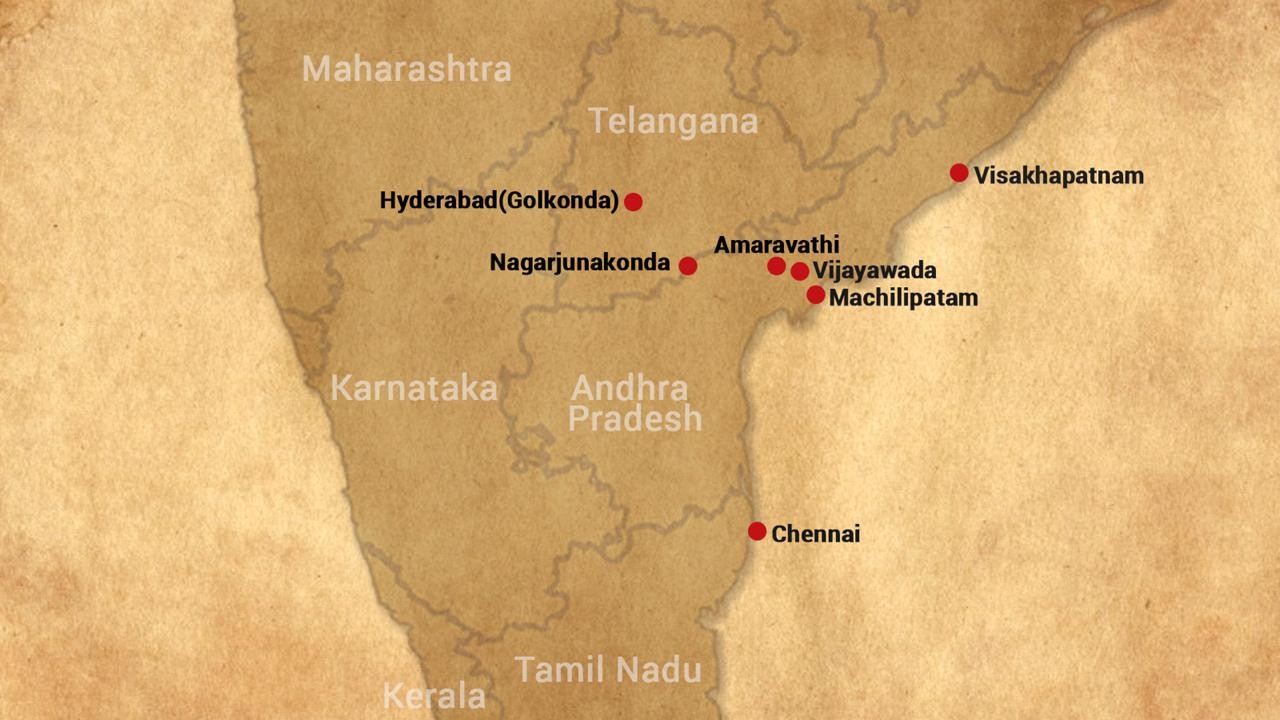
- 17 Jul 2025
In News:
Located at the confluence of the Krishna River and the Bay of Bengal, Machilipatnam—historically known as Masulipatnam—is a port town with a rich maritime legacy. Once a prominent node in ancient and medieval trade networks, the town is now experiencing renewed attention and developmental revival.
Ancient Maritime Significance
- Known in classical sources such as the Periplus of the Erythraean Sea (1st century CE) as Maisolos, Machilipatnam played a crucial role in early Indian Ocean trade.
- Its strategic position on the Coromandel Coast made it a conduit for commercial exchange between the Deccan Plateau and distant civilizations, including Rome, the Arab world, and Southeast Asia.
- Archaeological and literary evidence points to Machilipatnam's role as a trans-shipment point for goods like spices, textiles, and pearls.
Flourishing Under the Satavahanas (1st BCE – 3rd CE)
- During the reign of the Satavahana dynasty, the port witnessed significant expansion.
- It became renowned for the export of fine muslin fabrics, precious stones, and aromatic goods.
- Inland trade links with Amaravati and Dharanikota—important urban and Buddhist centres—further enhanced the port’s economic significance.
Medieval Resurgence and Colonial Trade
- From the 16th to 18th centuries, the port was revitalized under the Golconda Sultanate.
- It emerged as a hub for European maritime powers such as the Dutch, British, and French East India Companies.
- Despite its early importance, Machilipatnam’s influence declined in the 18th century when colonial powers shifted their focus to Madras (now Chennai), which offered better access and facilities for long-distance trade.
Port Cities in Indian Maritime History
The historical prominence of Machilipatnam can be viewed in the broader context of ancient Indian port cities:
|
Port City |
Region/Modern State |
Period/Dynasty |
|
Lothal |
Gujarat |
Indus Valley Civilization |
|
Arikamedu |
Puducherry |
Cholas, Early Tamil Kingdoms |
|
Kaveripattinam |
Tamil Nadu |
Cholas |
|
Sopara |
Maharashtra |
Satavahanas |
|
Tamralipta |
West Bengal |
Mauryas and Guptas |
|
Barygaza |
Bharuch, Gujarat |
Indo-Greek and Kushan Periods |
These ports collectively illustrate India’s extensive maritime interactions across time, with Machilipatnam serving as a significant node in this network during multiple historical phases.
Contemporary Relevance
- Recent efforts to revitalize Machilipatnam’s port infrastructure are aimed at restoring its economic utility and cultural relevance.
- Its historical importance makes it a potential candidate for heritage tourism, as well as a case study in urban renewal based on historical identity.
RhoDIS India
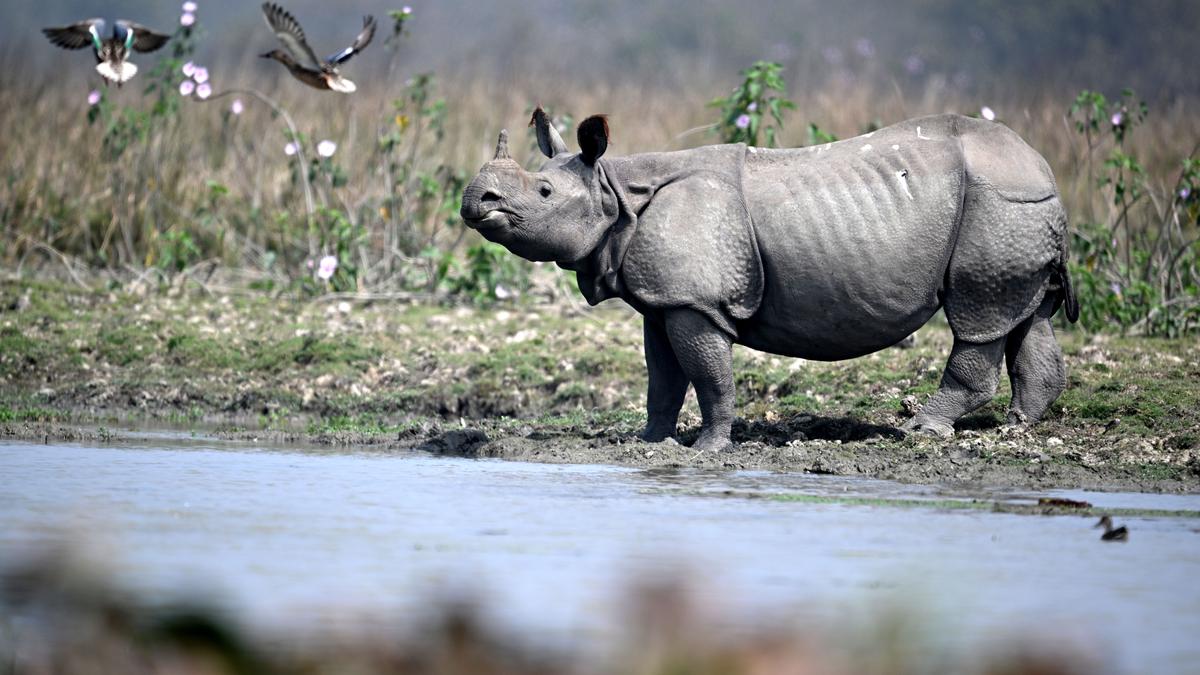
- 16 Jul 2025
In News:
A specialised team has begun the genetic analysis of 2,573 rhino horn samples in India, with the goal of enhancing rhino conservation and curbing wildlife crimes. This is part of the RhoDIS India (Rhino DNA Index System) initiative.
About RhoDIS India Programme:
- Launched in 2016 by the Ministry of Environment, Forest and Climate Change (MoEFCC) in collaboration with:
- Wildlife Institute of India (WII), Dehradun
- State forest departments of Assam, West Bengal, and Uttar Pradesh
- WWF India
- Objective:
To create a DNA database of individual rhinos for:- Aiding wildlife crime investigations
- Supporting scientific management of the rhino population
- Implementation:
The genetic lab at WII Dehradun handles DNA profiling using a standardised protocol approved by the MoEFCC. It involves short tandem repeat (STR) allele analysis for generating unique genetic signatures for each rhino.
Recent Developments in Assam:
- In September 2021, the Assam Forest Department verified and destroyed 2,479 rhino horns stored in state treasuries, excluding horns under court cases or of special scientific interest.
- Prior to destruction, tiny samples from 2,573 horns were preserved for DNA and chemical analysis. These samples have now been repackaged and transported to WII for genetic sequencing.
- This analysis will help track temporal genetic changes and improve understanding of the rhino population’s genetic health across Assam.
- The entire repackaging process was recorded and monitored by independent experts to ensure transparency.
Significance of RhoDIS:
- Provides individual identification of rhinos from horn samples, helping track poaching incidents and illegal wildlife trade.
- Strengthens forensic evidence in courts related to wildlife crime.
- Assists in population management through genetic diversity assessments.
What is a Rhino Horn?
- Composed of keratin, the same protein found in human nails and horse hooves.
- Contains sulphur-rich amino acids like cysteine, and minerals such as calcium carbonate and phosphate.
- Greater one-horned rhinos (found in India) have a single horn, unlike African species with two.
Jarawa Tribe

- 16 Jul 2025
In News:
The 16th Census of India, scheduled for 2026–27, will include a special effort to enumerate the six main indigenous tribes of the Andaman and Nicobar Islands, including the Jarawa, one of the world’s oldest surviving tribal groups.
About the Jarawa Tribe:
- Status: Recognized as a Particularly Vulnerable Tribal Group (PVTG).
- Location: Reside in Middle and South Andaman Islands, primarily in dense tropical forests and coastal zones.
- Lifestyle:
- Nomadic hunter-gatherers living in small groups of 40–50.
- Depend on forest produce, marine fishing, and traditional medicine.
- Exhibit robust health, with low incidence of lifestyle diseases.
- Cultural Characteristics:
- Minimal attire suited to the climate.
- Known for strong territorial identity and historical resistance to outsiders.
- Maintain a natural diet and traditional healing practices.
Population Trends:
- 1998 Estimate: ~260 individuals (based on limited contact).
- 2011 Census: 380 individuals (out of 28,530 STs in A&N Islands).
- 2025 Official Estimate: 647 individuals.
- Increase attributed to improved healthcare, trust-building, and non-intrusive welfare policies.
Government Interventions & Welfare Initiatives:
- Healthcare: Preventive medical support (measles, hepatitis, malaria) provided without interfering in traditional practices.
- Welfare Access: Increased interaction since 1998 has enabled better outreach, aiding accurate population tracking.
- PM-JANMAN Scheme: Under the Pradhan Mantri Janjati Adivasi Nyaya Maha Abhiyan, 191 PVTG individuals have been identified in the islands for targeted welfare.
Challenges & Ethical Considerations:
- Andaman Trunk Road (ATR): Provides physical access but raises concerns of cultural intrusion.
- Expert Opinion: Minimum intervention is essential for preserving the Jarawa way of life. Trust and respect for autonomy remain key.
16th Census of India: Timeline & Relevance:
- Reference Dates:
- October 1, 2026: Snow-bound areas (e.g., Ladakh, A&N Islands).
- March 1, 2027: Rest of India.
- Special Feature: Will include caste enumeration, the first since 1931.
- Jarawa Inclusion: Officials expect smooth access to PVTGs like the Jarawas due to longstanding trust and contact.
Exercise Talisman Sabre 2025
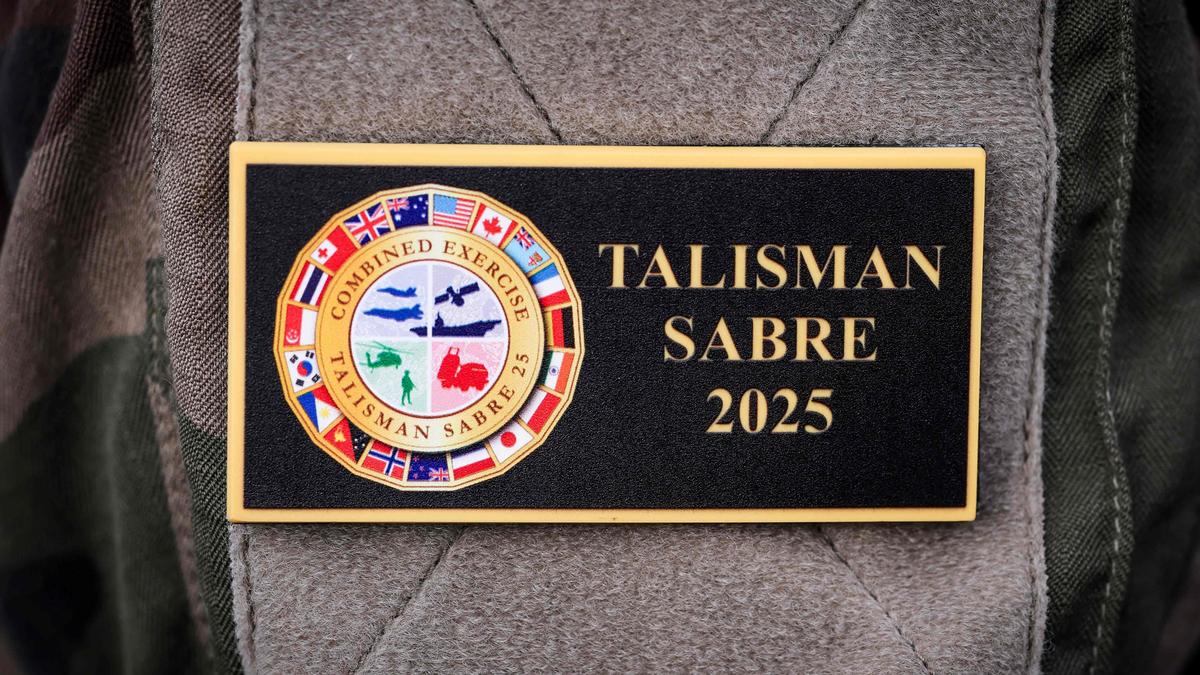
- 16 Jul 2025
In News:
India is participating in Exercise Talisman Sabre 2025, a major multinational military exercise led by Australia and the United States, now in its 11th edition. The exercise commenced on July 13, 2025, and includes over 35,000 military personnel from 19 nations.
About Exercise Talisman Sabre:
- Origin & Nature:
- A biennial bilateral military exercise between Australia and the United States since 2005.
- Designed to promote a free and open Indo-Pacific and strengthen interoperability and strategic partnerships among allies.
- Multinational Participation (2025):
- Participants: Australia, United States, India, Canada, Fiji, France, Germany, Indonesia, Japan, Netherlands, New Zealand, Norway, Papua New Guinea, Philippines, Republic of Korea, Singapore, Thailand, Tonga, United Kingdom.
- Observers: Malaysia and Vietnam.
- Geographical Scope: Exercises are being conducted across Queensland, Northern Territory, Western Australia, New South Wales, Christmas Island, and for the first time, in Papua New Guinea (outside Australian territory).
Significance for India and the Indo-Pacific:
- Strengthens India's defence diplomacy and military interoperability with Indo-Pacific allies.
- Reinforces commitment to collective security and rules-based international order.
- Enhances India's operational exposure in multidomain warfighting scenarios alongside major powers.
Who is an ‘Ordinarily Resident’?
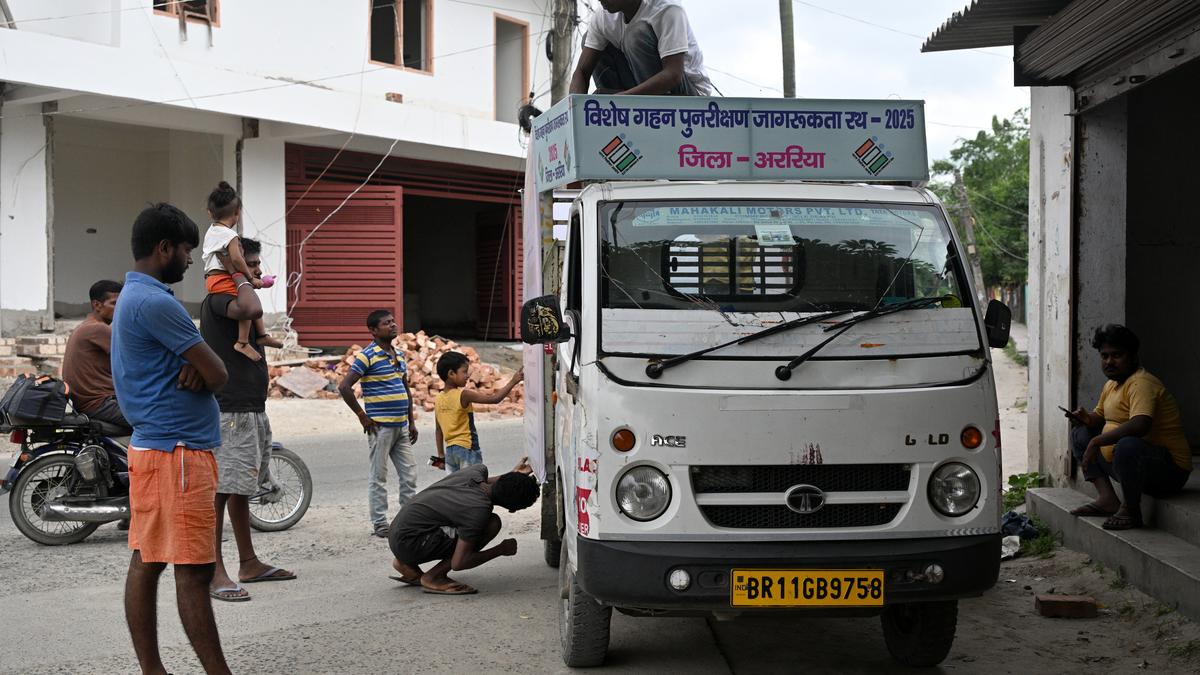
- 16 Jul 2025
In News:
The Election Commission of India (ECI) has initiated a Special Intensive Revision (SIR) of electoral rolls in Bihar, sparking debate over the eligibility of migrant workers and the interpretation of ‘ordinarily resident’ under electoral law.
Legal Basis of ‘Ordinarily Resident’
- Representation of the People Act, 1950:
- Section 19: Only persons ordinarily resident in a constituency are eligible for enrolment in its electoral roll.
- Section 20: Defines ‘ordinarily resident’ and clarifies that:
- Ownership or possession of a house alone does not qualify one as ordinarily resident.
- A person temporarily absent from their usual place of residence (due to work, travel, etc.) continues to be ordinarily resident there.
- Certain categories are deemed to be ordinarily resident in their home constituency even if posted elsewhere:
- Members of armed forces,
- State police serving outside their State,
- Central government employees posted abroad,
- Persons holding constitutional offices declared by the President in consultation with the ECI,
- Their spouses are also covered.
- Section 20A (added in 2010):
- Allows Non-Resident Indians (NRIs) to register and vote from the address mentioned in their passport, even if they reside abroad long-term.
Rules Governing Electoral Rolls
- The Registration of Electors Rules, 1960 (RER):
- Notified by the Central Government in consultation with the ECI.
- Govern the preparation, revision, and correction of electoral rolls.
- Electoral Registration Officers apply and verify the concept of ‘ordinarily resident’ during the enrolment process.
Judicial Interpretation
- Gauhati High Court (Manmohan Singh Case, 1999):
- Defined ‘ordinarily resident’ as one who is habitually and permanently living in a place.
- The person must intend to reside there, and society must reasonably accept them as a resident.
3I/Atlas: Third Interstellar Object Discovered
- 16 Jul 2025
In News:
Scientists have confirmed the discovery of 3I/Atlas, the third-known interstellar object, which could be over 7 billion years old — predating the Solar System by nearly 3 billion years. It was detected on July 1, 2025, by the Asteroid Terrestrial-impact Last Alert System (ATLAS) telescope in Río Hurtado, Chile.
Key Features:
- Interstellar Origin: 3I/Atlas is not gravitationally bound to the Sun and follows a hyperbolic trajectory, indicating it entered the Solar System from interstellar space.
- High Speed: It is traveling at approximately 60 km/s — too fast to be retained by the Sun’s gravity at a distance of 670 million km from the Sun.
- Current Location: The object is now roughly 917 million km from Earth, close to the orbit of Jupiter.
- Age Estimation: Estimated to be around 7 billion years old, making it potentially the oldest comet ever observed.
Understanding Interstellar Objects
- Definition: Interstellar objects are celestial bodies that originate outside the Solar System and pass through it without being gravitationally bound to the Sun.
- Known Interstellar Objects:
- 1I/?Oumuamua (2017)
- 2I/Borisov (2019)
- 3I/Atlas (2025)
How do scientists confirm Interstellar Origin?
- Trajectory Analysis: Objects within the Solar System follow closed elliptical orbits. Interstellar objects exhibit open hyperbolic orbits — they have a perihelion (closest point to the Sun) but no aphelion (no return).
- Velocity Measurement: A high velocity at a great distance from the Sun, such as with 3I/Atlas, suggests that the object was not accelerated within our Solar System and must have originated externally.
- Example: At 670 million km from the Sun, 3I/Atlas’s speed of 60 km/s indicates a hyperbolic escape path, unaffected significantly by the Sun’s gravitational pull.
Why is it Significant?
- Clues to Alien Planetary Systems: The chemical composition of interstellar objects offers insights into the formation conditions of other star systems.
- Rare Opportunity: These objects provide a direct sample of exoplanetary material, potentially long before space missions can reach other star systems.
- Scientific Value: If rich in ices, as expected in long-distance comets, it implies ejection from a cold, outer region of a distant planetary system—likely influenced by large planets like Jupiter or Neptune analogues.
e-Truck Incentive Scheme
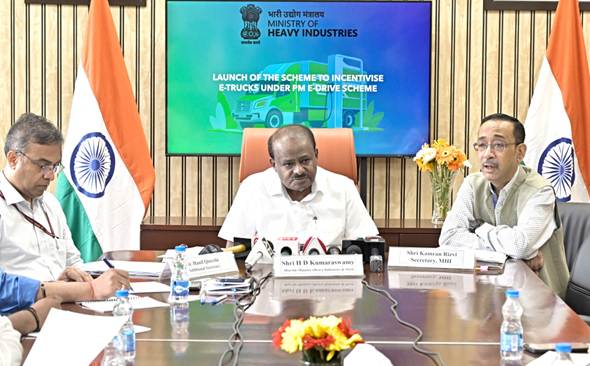
- 15 Jul 2025
In News:
The Government of India, under the PM E-DRIVE initiative, has launched the country’s first dedicated financial incentive scheme for electric trucks (e-trucks). Spearheaded by the Ministry of Heavy Industries (MHI) and launched by Union Minister H.D. Kumaraswamy, the initiative is a key component of India's push toward green freight mobility, net-zero emissions by 2070, and cleaner urban air quality.
Key Features of the Scheme
- Scope & Objective: Aimed at reducing emissions from the freight sector, lowering logistics costs, and encouraging indigenous e-truck manufacturing under Atmanirbhar Bharat.
- Target Vehicle Categories:
- N2 Category: Trucks with Gross Vehicle Weight (GVW) between 3.5 to 12 tonnes
- N3 Category: Trucks with GVW above 12 tonnes and up to 55 tonnes (In case of articulated vehicles, only the N3-category puller tractor is eligible.)
- Eligibility Conditions:
- Mandatory scrapping of old diesel trucks for availing incentives
- Battery warranty: 5 years or 5 lakh km
- Vehicle and motor warranty: 5 years or 2.5 lakh km
- Incentives Structure:
- Maximum incentive: ?9.6 lakh per e-truck
- Incentive amount based on GVW
- Disbursal: Upfront reduction in purchase price; reimbursed to OEMs via PM E-DRIVE portal (first-come, first-served)
Implementation Timeline and Financial Outlay
- Duration: October 1, 2024 – March 31, 2026
- Budget:
- ?500 crore earmarked for e-trucks within an overall outlay of ?10,900 crore under PM E-DRIVE
- Dedicated ?100 crore allocation for 1,100 e-trucks registered in Delhi to combat air pollution
Wider PM E-DRIVE Ecosystem (formerly EMPS-2024)
- EV Categories Covered:
- Electric 2-Wheelers: Incentive of ?5,000/kWh (capped at ?10,000 in Year 1, ?5,000 in Year 2)
- Electric 3-Wheelers: ?25,000 in Year 1, ?12,500 in Year 2
- L5 Cargo EVs: ?50,000 in Year 1, ?25,000 in Year 2
- E-buses and e-ambulances: Covered under future extensions
- e-Vouchers: Introduced for digital verification and incentive tracking. One vehicle per Aadhaar; required for OEM reimbursement.
- Charging Infrastructure: The scheme promotes setting up EV Public Charging Stations (EVPCS) in high EV penetration cities and along major highways.
Strategic Importance and Impact
- Environmental: Diesel trucks constitute only 3% of the vehicle fleet but contribute to 42% of transport-related GHG emissions.
- Deployment Goal: Support for 5,600 e-trucks across India
- Sectoral Focus: Logistics, cement, steel, and port sectors
- Industry Participation: OEMs like Tata Motors, Ashok Leyland, Volvo Eicher are actively engaged
- CPSE Involvement: SAIL to procure 150 e-trucks and electrify 15% of hired vehicles.
Sanchar Mitra Scheme
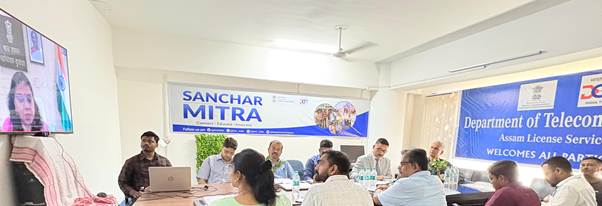
- 15 Jul 2025
In News:
The Sanchar Mitra Scheme, launched by the Department of Telecommunications (DoT), Ministry of Communications, is a nationwide volunteer-based initiative aimed at promoting digital literacy, telecom safety, and cybersecurity awareness among citizens.
Initially piloted in select institutions, the scheme has now been scaled up nationally due to its successful outreach and impact.
Key Highlights:
- Who are Sanchar Mitras?
- Selected university student volunteers from streams such as telecom, electronics, computer science, and cybersecurity who act as digital ambassadors to spread awareness at the grassroots level.
- Core Objectives:
- Promote digital safety and cyber hygiene
- Raise awareness on cyber frauds, EMF radiation concerns, and responsible mobile usage
- Bridge the communication gap between telecom services and citizens
- Training & Exposure: Sanchar Mitras receive specialized training from:
- National Communications Academy–Technology (NCA-T)
- DoT Media Wing: Training covers topics such as 5G, 6G, Artificial Intelligence, Cybersecurity, and telecom technologies.
- Community Engagement: Volunteers organize awareness campaigns, collaborate with NGOs, and engage in door-to-door outreach to promote informed digital behavior.
- Assessment & Incentives: Participants are evaluated on innovation, consistency, and outreach impact. Top performers receive:
- Internship opportunities
- Involvement in national telecom projects
- Invitations to forums like the India Mobile Congress
- Participation in International Telecommunication Union (ITU) events
Recent Developments:
- The first expanded rollout was initiated in Assam, where DoT partnered with 18 top engineering institutions including IIT, IIIT, and NIT.
- Chaired by senior DoT officials, sessions in BSNL Bhawan, Guwahati, introduced the scheme and invited collaboration from academic institutions.
Significance for India:
- Digital Inclusion: Empowers citizens to participate securely in the digital ecosystem.
- Youth Engagement: Mobilizes Yuva Shakti as a force for nation-building and technological awareness.
- Cybersecurity Shield: Acts as a grassroots defense against increasing cyber threats and misinformation.
- Alignment with National Priorities: Supports India’s vision of leadership in the 4 Ds – Democracy, Demography, Digitization, and Delivery.
Astra Missile
- 15 Jul 2025
In News:
The Astra missile, developed by the Defence Research and Development Organisation (DRDO), is India’s first indigenous Beyond-Visual-Range Air-to-Air Missile (BVRAAM). Recently, the Indian Air Force (IAF) and DRDO successfully flight-tested the missile from a Sukhoi-30 MKI fighter jet off the coast of Odisha.
Key Features:
- Range: Over 100 km, enabling engagement of distant aerial targets.
- Speed: Capable of flying at speeds exceeding Mach 4.
- Operational Ceiling: Effective up to 20 km altitude.
- Seeker: Equipped with a fully indigenous Radio Frequency (RF) Seeker, enhancing precision targeting.
- Guidance System: State-of-the-art navigation and guidance technologies ensure high accuracy.
- All-weather Capability: Operable in day and night across diverse weather conditions.
Recent Tests:
- Conducted against high-speed unmanned aerial targets at varying ranges and conditions.
- Achieved pinpoint accuracy in both launches.
- All subsystems, including the RF seeker and tracking systems, functioned flawlessly.
- Tests were conducted at the Integrated Test Range (ITR), Chandipur.
Strategic Significance:
- Boosts India’s air-to-air combat capability.
- Reduces dependency on foreign missile systems.
- Supports the vision of Aatmanirbhar Bharat in defence technology.
- Over 50 Indian public and private sector industries, including Hindustan Aeronautics Limited (HAL), contributed to its development.
Lake Turkana Basin
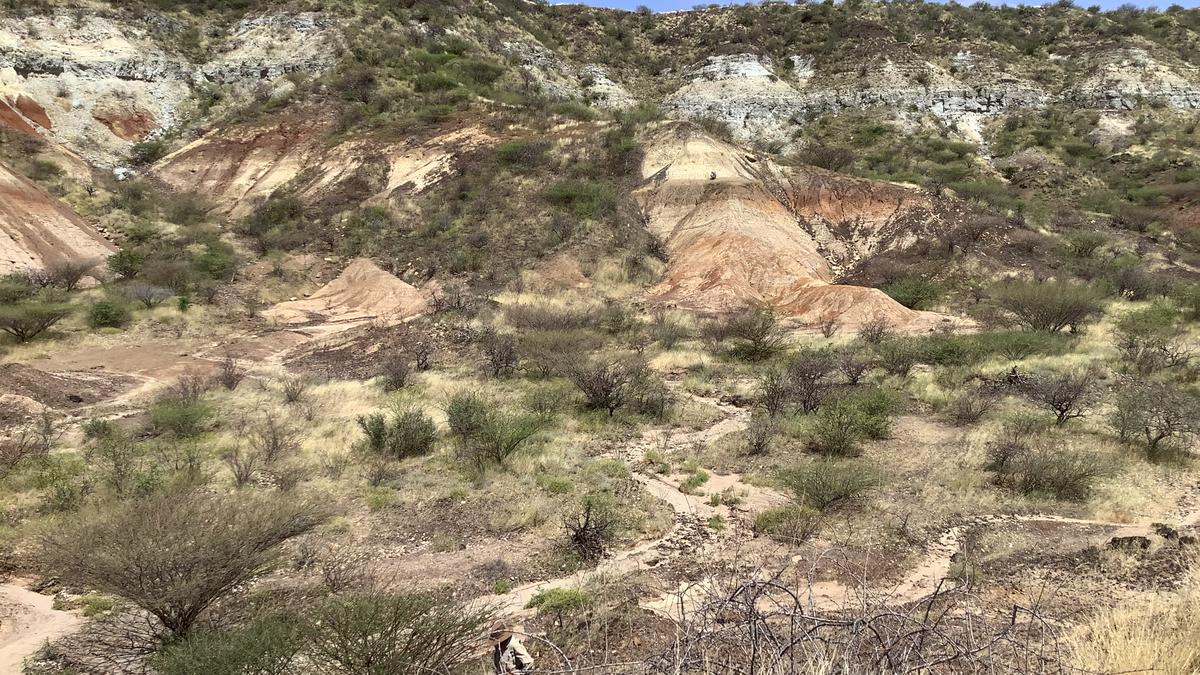
- 15 Jul 2025
In News:
For the first time, scientists have successfully extracted and analyzed 18–24 million-year-old enamel proteins from extinct mammal fossils—pushing the frontiers of biomolecular preservation and reshaping our understanding of mammalian evolution. The groundbreaking findings were published in Nature (July 2025) and draw from fossils found in Lake Turkana Basin (Kenya) and the Haughton Impact Crater (Canada's High Arctic).
Key Highlights:
What was Discovered?
- Enamel proteins, trapped in the dense tooth enamel of extinct mammals, were recovered from fossils dating back 18–24 million years.
- These proteins are now the oldest biomolecular sequences ever recovered, exceeding the time limits of ancient DNA (which typically degrades within 1 million years).
Significance of Enamel Proteins:
- Enamel—being the hardest biological substance—acts as a molecular vault, shielding proteins from environmental degradation.
- These ancient proteins provide crucial phylogenetic information, even in hot tropical zones like Lake Turkana, where preservation was previously thought improbable.
Methodology:
- Researchers extracted structural enamel proteins like amelogenin, enamelin, and ameloblastin.
- Advanced mass spectrometry and rigorous contamination controls ensured data integrity.
- Over 1,000 peptides and 7 different enamel proteins were recovered from a 21–24 million-year-old rhinoceros tooth in the Arctic.
- Diagenetic alterations (e.g., oxidation, glycation) were used as authenticity markers.
Site-Wise Discoveries:
Lake Turkana Basin (Kenya):
- Fossils from a hot, arid region yielded enamel proteins up to 18 million years old.
- Demonstrated exceptional preservation due to fluviodeltaic sedimentation, which allowed rapid burial and protection from oxygen and heat.
- The Turkana Basin is a major palaeontological site in Eastern Rift Valley and home to species like proboscideans, rhinocerotids, hippopotamids, and hominoids.
- Enamel samples ranged from 1.5 to 29 million years old.
- Turkana Lake, the world’s largest permanent desert lake and a UNESCO World Heritage Site, lies in this region.
Haughton Impact Crater (Nunavut, Canada):
- Ancient enamel from a permafrost site enabled recovery of 21–24 million-year-old proteins.
- The site was once a temperate lake, aiding preservation under low oxygen (anoxic) conditions.
- Researchers reconstructed rhinocerotid evolution, showing Epiaceratherium diverged before the Elasmotheriinae-Rhinocerotinae split, revising long-held fossil-based phylogenies.
Scientific Implications:
|
Aspect |
Enamel Proteins |
Ancient DNA |
|
Age limit |
>20 million years |
<1 million years |
|
Preservation |
High in enamel |
Poor in hot climates |
|
Resolution |
Useful for deep-time splits |
High for closely related species |
|
Data Type |
Protein sequence |
Genetic sequence |
|
Application |
Tree of life reconstruction, evolutionary history |
Genome mapping, ancestry |
Agricultural Monitoring and Event Detection (AMED) API
- 15 Jul 2025
In News:
Google has introduced a set of artificial intelligence (AI)-based innovations to advance India’s agricultural practices and enhance the cultural and linguistic relevance of global AI models.
Agricultural Monitoring and Event Detection (AMED) API
- Launched by: Google DeepMind and Google’s Partnerships Innovation Team
- Collaborators: TerraStack, IIT-Kharagpur, and other local partners
- Foundation: Built on the Agricultural Landscape Understanding (ALU) API launched in 2023
- Key Features:
- AI-Based Field Monitoring: Offers field-level insights using satellite imagery and deep learning to monitor crops and agricultural activity.
- Crop-Specific Data: Provides details on crop type, season, field size, and three years of historical cropping and land-use data.
- Event Detection: Detects agricultural changes at individual field levels, improving yield prediction and input management.
- Biweekly Updates: Data refreshed every two weeks to ensure real-time agricultural monitoring.
- Open Access for Innovation: Available for integration by agri-tech startups, financial institutions, and government bodies to support data-backed rural lending, climate adaptation, and sustainable farming practices.
- Objectives and Utility:
- Empower agriculture stakeholders with granular, real-time intelligence.
- Facilitate precision agriculture by tailoring support for soil, water, and climatic needs.
- Strengthen India's resilience to climate-related risks and promote informed policymaking.
- Help financial services design location-specific rural credit systems.
Amplify Initiative: Cultural and Linguistic Localization of AI
Google is also working to enrich AI systems with deeper understanding of India’s diversity through the Amplify Initiative, piloted earlier in Sub-Saharan Africa.
Indian Collaboration:
- Partner Institution: IIT-Kharagpur
- Goal: Create hyperlocal annotated datasets in multiple Indic languages related to healthcare, safety, and social issues.
- Aims to ensure that Large Language Models (LLMs) are better aligned with India’s cultural plurality and linguistic complexity.
Global Impact:
- Builds on success in Africa, where 8,000+ queries in 7 languages were developed by 155 experts to address issues such as chronic illness and misinformation.
INS Nistar

- 14 Jul 2025
In News:
In a significant stride towards self-reliance in defence manufacturing under the Aatmanirbhar Bharat initiative, the Indian Navy has inducted INS Nistar, its first indigenously designed and built Diving Support Vessel (DSV). Developed by Hindustan Shipyard Limited (HSL), Visakhapatnam, INS Nistar enhances India’s capabilities in deep-sea rescue, submarine emergency response, and underwater operations, placing India among a select group of nations with such advanced maritime assets.
Key Features and Capabilities
- Size and Endurance:
- Length: ~118–120 meters
- Displacement: Over 10,000 tonnes
- Endurance: Capable of operating for over 60 days at sea
- Diving and Rescue Capabilities:
- Equipped for saturation diving up to 300 meters and side diving stage operations up to 75 meters
- Integrated with Remotely Operated Vehicles (ROVs) for diver monitoring and salvage missions up to 1000 meters below sea level
- Serves as the Mother Ship for the Deep Submergence Rescue Vehicle (DSRV), crucial for submarine crew evacuation in emergencies
- Medical and Operational Infrastructure:
- Includes an 8-bed hospital, ICU, operation theatre, and hyperbaric chambers for diver treatment and recovery
- Fitted with a 15-tonne subsea crane, helicopter landing deck, and Side Scan SONAR for multi-role logistics and salvage operations
- Navigation and Control: Integrated Dynamic Positioning System (DPS) ensures precision during complex underwater missions
Indigenous Content and Industrial Participation
- Indigenous Content: Approximately 75–80%
- Over 120 Indian MSMEs contributed to the vessel’s construction
- Compliant with Indian Register of Shipping (IRS) classification standards
Strategic and Symbolic Significance
- Bridges critical capability gaps in submarine rescue, deep-sea salvage, and maritime disaster response
- Strengthens India’s strategic posture in the Indian Ocean Region (IOR), ensuring rapid and self-reliant response to undersea emergencies
- Reinforces India’s position as an emerging blue water navy
- Symbolically revives the legacy of the erstwhile Soviet-origin INS Nistar (commissioned in 1971), reaffirming continuity and progress in naval capabilities
TALASH Initiative

- 14 Jul 2025
In News:
The National Education Society for Tribal Students (NESTS), under the Ministry of Tribal Affairs, in collaboration with UNICEF India, has launched TALASH — Tribal Aptitude, Life Skills and Self-Esteem Hub — a first-of-its-kind national initiative aimed at fostering the holistic development of tribal students enrolled in Eklavya Model Residential Schools (EMRSs).
Launched in July 2025, TALASH reflects a focused effort to promote self-awareness, life skills, and career clarity among tribal youth across India. The initiative aligns with the vision of the National Education Policy (NEP) 2020, emphasizing inclusive, equitable, and holistic education.
Key Objectives:
- Support all-round development of over 1.38 lakh EMRS students across 28 States and 8 Union Territories.
- Strengthen academic learning, while building life skills, self-esteem, and career readiness.
- Bridge educational and psychological gaps for tribal youth, especially in remote and underprivileged areas.
Core Features of TALASH
- Digital Self-Discovery Platform: TALASH is an innovative digital portal that equips students with tools for career planning, aptitude assessment, and personal development.
- Psychometric Assessments: Inspired by NCERT’s Tamanna initiative, it offers a standardized aptitude test to identify students’ strengths, interests, and potential career paths.
Students are provided with Career Cards based on test results. - Career Counselling Support: Helps students make informed choices by aligning their aspirations with personal aptitude and career opportunities.
- Life Skills & Self-Esteem Modules: Includes interactive content to build problem-solving abilities, emotional intelligence, communication skills, and self-confidence.
- E-Learning for Educators: Offers a dedicated teacher portal for capacity building, enabling educators to mentor and support students effectively.
Implementation and Outreach
- The program is being rolled out in phases, starting in select EMRSs for smooth execution.
- So far, 189 teachers from 75 EMRSs have been trained as master trainers.
- By the end of 2025, TALASH aims to be active in all EMRSs nationwide.
Institutional Backing and Vision
- NESTS: An autonomous body under the Ministry of Tribal Affairs, responsible for the establishment and administration of EMRSs to ensure quality education for tribal students.
- UNICEF India: Brings global expertise in child development, focusing on equitable access, well-being, and digital empowerment.
Earth Intelligence

- 14 Jul 2025
In News:
In a major forecast shaping the future of data-driven decision-making, Gartner Inc. estimates that Earth Intelligence will emerge as a $20 billion industry between 2025 and 2030, with enterprise spending surpassing government and military investments by the end of the decade. This signals a pivotal shift in how space-based Earth observation data is being transformed into actionable insights across industries.
What is Earth Intelligence?
Earth Intelligence refers to the application of artificial intelligence (AI) to Earth observation data—mainly derived from satellite imagery, remote sensors, and complementary datasets like social, economic, and policy data—to generate domain-specific, actionable insights.
It involves:
- Data collection: Satellite and sensor-based Earth observation.
- Data transformation: Converting raw data into tailored formats.
- Insight generation: Using AI, analytics, and modeling to support business and policy decisions.
This integrated approach also increasingly draws on local and Indigenous knowledge, enhancing its relevance for climate resilience, urban planning, resource management, and disaster response.
Key Applications
Gartner highlights several real-world use cases:
- Disaster Response: Identifying fallen trees on railway lines post-storms.
- Industrial Monitoring: Tracking metal refinery temperatures to gauge global supply chains.
- Urban Analytics: Counting vehicles to study traffic and consumer behavior.
- Trade Analysis: Monitoring sea cargo movement to assess global shipping trends.
Trends and Projections
- In 2024, less than 15% of Earth Intelligence spending came from the private sector.
- By 2030, enterprises are expected to contribute over 50% of total spending—outpacing government and military usage.
- The annual revenue from Earth Intelligence is projected to grow from $3.8 billion (2025) to $4.2 billion (2030).
- The cumulative revenue opportunity for tech and service providers is estimated at $20 billion (2025–2030).
Polycyclic Aromatic Hydrocarbons (PAHs)

- 14 Jul 2025
In News:
In a significant development in astrochemistry, researchers from Australia, Sweden, and the UK have discovered how polycyclic aromatic hydrocarbons (PAHs)—complex organic molecules—can survive in the harsh environment of space, particularly within the Taurus Molecular Cloud 1 (TMC1). Their findings offer fresh perspectives on the origins of life and the chemical evolution of the universe.
What are PAHs?
Polycyclic Aromatic Hydrocarbons (PAHs) are flat, ring-shaped molecules composed of carbon and hydrogen. They are believed to constitute up to one-fifth of all carbon in interstellar space. While on Earth PAHs are typically formed through the incomplete combustion of organic matter such as fossil fuels and biomass, in space they are thought to be delivered by meteors and may have contributed to the early building blocks of life on Earth.
Astrochemical Puzzle: PAHs in TMC1
TMC1 is a cold, dense molecular cloud located about 430 light-years away in the Taurus constellation, composed primarily of molecular hydrogen (H?) along with dust, plasma, and organic compounds like ammonia (NH?) and carbon monoxide (CO). Despite constant exposure to high-energy starlight, which should destroy fragile molecules, small, closed-shell PAHs—those with paired electrons—are found in unexpectedly high concentrations in TMC1.
Scientific Breakthrough: The Indenyl Cation (C?H??)
To investigate this anomaly, researchers focused on a fragment of a PAH molecule known as the indenyl cation (C?H??). This molecule was studied under ultra-cold conditions at Stockholm University’s DESIREE facility, which allows ions to circulate without collisions at temperatures near –260°C.
Key findings:
- C?H?? ions exhibit an efficient cooling mechanism, enabling them to survive rather than disintegrate.
- The cooling occurs through recurrent fluorescence—where energy is gradually lost as electrons shift between excited and ground states—and infrared emission via molecular vibrations.
- This mechanism is crucial for stabilizing small PAHs (<50 carbon atoms), which have increasingly been detected in space through radioastronomy.
Scientific Significance:
- Validates how organic molecules can survive and grow in interstellar environments.
- Refines astrochemical models of molecular evolution in space.
Implications for the Origin of Life:
- Supports the hypothesis that PAHs delivered by meteors may have seeded early Earth with prebiotic carbon, aiding the emergence of life.
Relevance to Space Research:
- Enhances understanding of interstellar chemistry, useful for missions like James Webb Space Telescope (JWST) and future astrobiology missions.
MALE Drone Procurement
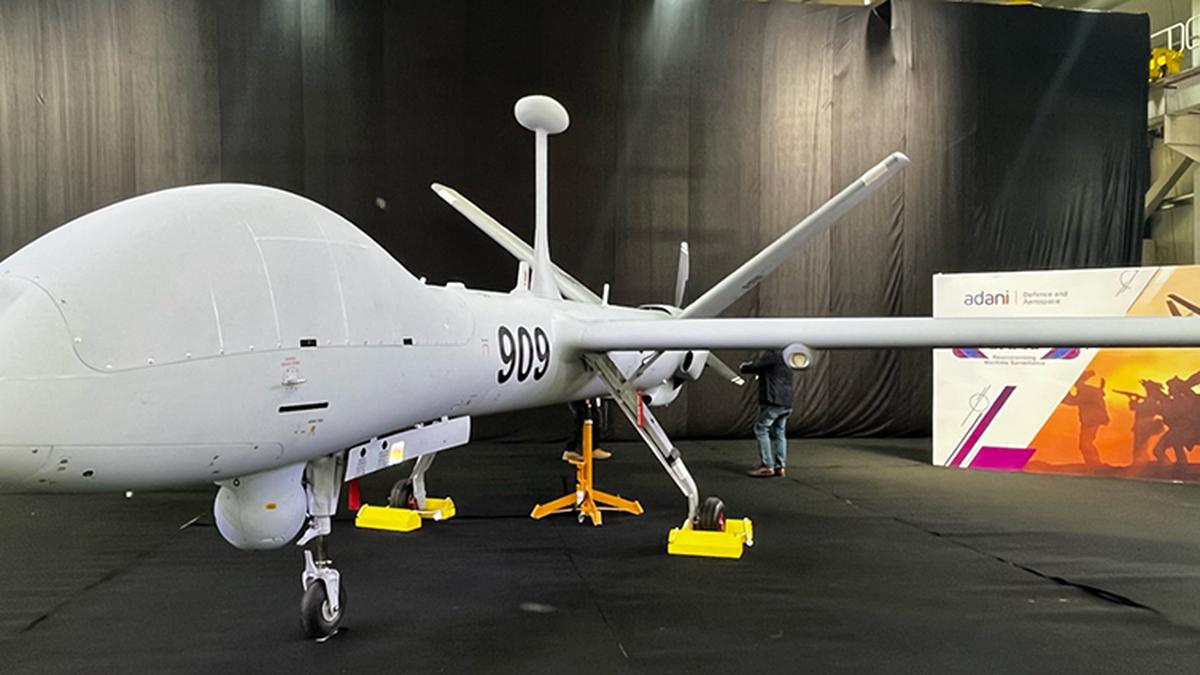
- 14 Jul 2025
In News:
In a significant stride towards self-reliance in defence technology, India has expedited the procurement of 87 Medium Altitude Long Endurance (MALE) drones from domestic manufacturers under the ?20,000 crore initiative, marking a major step in strengthening border surveillance and operational readiness.
What are MALE Drones?
MALE (Medium Altitude Long Endurance) drones are unmanned aerial vehicles (UAVs) capable of flying at altitudes of up to 35,000 feet and sustaining flight for over 30 hours. These drones are equipped for Intelligence, Surveillance, and Reconnaissance (ISR) and can undertake limited combat missions.
Key Features
- Endurance: Operational capacity exceeds 30 hours.
- Altitude Range: Effective at 35,000 feet or higher.
- Payload: Equipped with Electro-Optical/Infrared (EO/IR) cameras, radar systems, and combat modules.
- Real-time ISR: Provides persistent surveillance over diverse terrain.
- Remote Operations: Ground stations with secure communication links manage operations.
- Indigenous Content: Over 60% of components are locally manufactured, promoting import substitution.
Strategic Applications
- Border and Maritime Surveillance: Enhances India’s ability to monitor land borders with Pakistan and China, and maritime boundaries in the Indian Ocean Region.
- Tri-Service Integration: These drones will be deployed across the Army, Navy, and Air Force, improving joint situational awareness.
- Counter-Insurgency Support: Useful in operations in Naxal-affected and insurgency-prone areas, providing tactical aerial intelligence.
- Disaster Relief and Mapping: Can aid in real-time mapping and coordination during natural disasters and humanitarian crises.
Strategic Importance
- Fills the capability gap between smaller tactical UAVs and high-altitude surveillance drones like the MQ-9B Sea/ Sky Guardians.
- Replaces India’s earlier dependence on Israeli UAVs (e.g., Heron drones), boosting the ‘Make in India’ initiative in defence manufacturing.
- Enhances 24×7 real-time surveillance, thereby strengthening national security architecture.
Extended Range Anti-Submarine Rocket (ERASR)
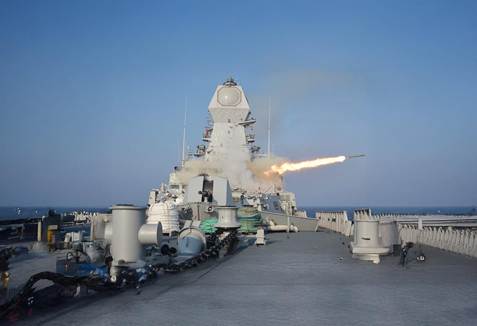
- 13 Jul 2025
In News:
India recently conducted successful user trials of the Extended Range Anti-Submarine Rocket (ERASR) from INS Kavaratti, marking a significant milestone in strengthening the country’s anti-submarine warfare (ASW) capabilities through indigenously developed technologies.
What is ERASR?
The ERASR is a state-of-the-art anti-submarine rocket system designed to neutralize hostile submarines from Indian naval warships. It is specifically intended for launch from Indigenous Rocket Launchers (IRLs) onboard Indian Navy ships.
- Developed by: Defence Research and Development Organisation (DRDO), specifically the Armament Research & Development Establishment (ARDE), Pune, in collaboration with the High Energy Materials Research Laboratory and Naval Science & Technological Laboratory.
- Production partners: Bharat Dynamics Limited (Hyderabad) and Solar Defence & Aerospace Ltd. (Nagpur).
Key Features
- Twin Rocket Motor System: Enables engagement of both short- and long-range submarine targets with high accuracy and consistency.
- Electronic Time Fuze: Fully indigenously developed to ensure precise detonation near underwater threats.
- High Operational Reliability: Demonstrated through consistent warhead detonation and fuze performance.
- Launch Compatibility: Designed to be fired from frontline warships equipped with Indian-made rocket launchers.
Highlights of User Trials
- Conducted from: INS Kavaratti under simulated maritime combat conditions.
- Number of Rockets Tested: 17
- Parameters Evaluated:
- Range performance
- Fuze timing reliability
- Warhead detonation effectiveness
- Outcome: All trial objectives were met; system demonstrated full battlefield readiness.
Significance
- Strengthens India’s ASW capabilities in the Indian Ocean Region, a vital strategic space.
- Boosts Atmanirbharta in defence by reducing reliance on foreign imports.
- Economically efficient, as the scalable domestic production replaces high-cost foreign systems.
- Reflects DRDO’s technological maturity in delivering mission-ready, indigenous defence solutions.
Optical Atomic Clock

- 13 Jul 2025
In News:
In a landmark advancement, an international team of 65 scientists from six countries conducted the world’s largest and most accurate optical atomic clock comparison across three continents. This is a major step towards redefining the SI unit of time — the second — using optical atomic clocks instead of current caesium-based clocks.
Current Definition of a Second
- Defined since 1967 by the International System of Units (SI):
One second is the time it takes for 9,192,631,770 cycles of microwave radiation emitted during the transition between two hyperfine levels of the ground state of a caesium-133 atom.
- In India, the National Physical Laboratory (NPL) in New Delhi maintains the time standard using five caesium atomic clocks, disseminating the output via INSAT satellites, telecom signals, and fibre links.
Why Redefine the Second?
Limitations of Caesium Clocks:
- Frequency: 9.19 billion Hz (microwave range).
- Stability: Drifts by 1 second every 300 million years.
- Insufficient for the growing precision demands of:
- Global Positioning Systems (GPS, NavIC, Galileo)
- Climate science (e.g., measuring gravity changes due to ice loss)
- Radio astronomy (e.g., black hole imaging)
- Quantum technologies and space navigation
Optical Atomic Clocks: The Next Time Standard
Advanced atomic clocks that use visible light (optical frequencies) rather than microwaves to measure atomic transitions, allowing much higher precision.
Atoms Used:
- Strontium-87 (Sr)
- Ytterbium-171 (Yb)
- Charged Ytterbium Ions (Yb? E2, Yb? E3)
- Charged Strontium-88 (Sr?)
- Indium-115 ions (In?)
Working Principle:
- Atoms are held in optical lattices or ion traps.
- A laser, tuned to the atom’s natural frequency, stimulates atomic transitions.
- The resulting oscillations — which occur hundreds of trillions of times per second — are counted to define one second.
Superior Attributes:
- Frequency range:
- Strontium: 429 trillion Hz
- Ytterbium: 642 trillion Hz (≈ 10,000 times greater than caesium clocks)
- Unmatched stability: Drift of 1 second in 15 billion years in some cases
- Precision: Agreement between clocks within 10?¹? to 10?¹?, enabling ultra-precise synchronization globally
The Global Clock Comparison: Key Highlights
Objective:
To test whether optical clocks across the world remain synchronized at ultra-high precision, a prerequisite for redefining the SI second.
Experiment Overview:
- Duration: 45 days (Feb 20 – Apr 6, 2022)
- Participants: 10 optical clocks across six countries (Germany, France, Italy, Japan, Finland, UK)
- Atoms used: Sr, Yb, Sr?, Yb? (E2 & E3), In?
- Techniques:
- Optical fibre links between countries
- Advanced GPS method: Integer Precise Point Positioning (IPPP)
- Backups: GPS-based clocks during maintenance downtime
Key Outcomes:
- 38 independent frequency ratios measured — most extensive comparison to date
- 4 new ratios measured for the first time, including:
- Yb?(E3) to Yb
- In? to Yb
- Sr? to Sr
- Sr? to Yb
- Precision Achievements:
- Sr clocks in Germany and France: differed by < 2 × 10?¹?
- In? and Yb?(E3) clocks in Germany: matched within 4.4 × 10?¹?
- Germany–UK clocks: matched within 3 × 10?¹? via GPS, even with downtime
Challenges & Corrections Identified
- Italy’s Yb clock showed a consistent offset of 4 × 10?¹? in GPS-based ratios due to a signal distribution glitch.
- France and Germany’s Sr clocks showed small but real mismatches (~2 × 10?¹?), needing further investigation.
- Error Correlation Matrix: A 38×38 matrix with 242 non-zero correlation coefficients was created to responsibly combine data and avoid double-counting.
Significance for India and the World
- By 2030, optical atomic clocks are expected to officially redefine the second.
- India, through NPL, will need to upgrade infrastructure to remain in sync with the new global standard.
- Enhanced time precision will benefit:
- ISRO’s navigation and deep space programs
- Disaster response using satellite geolocation
- Quantum communication and computing
Catastrophe Bonds (Cat Bonds)
- 13 Jul 2025
In News:
Life insurance is common in India, but disaster risk insurance is not. Low coverage leaves most assets and livelihoods uninsured and vulnerable to loss. Globally, after the late-1990s U.S. hurricanes impacted even re-insurers, catastrophe risk began shifting to financial markets via catastrophe bonds (cat bonds).
What are Catastrophe Bonds (Cat Bonds)?
Catastrophe bonds (cat bonds) are insurance-linked securities (ILS) that convert disaster risks into tradable debt instruments, allowing countries or insurers to transfer the financial burden of natural disasters to capital markets.
- They are high-yield bonds issued by governments or insurance entities (sponsors) via intermediaries like the World Bank or Asian Development Bank.
- In case of a pre-defined disaster event (e.g., a 7.0 magnitude earthquake or 250 km/h cyclone), investors lose part or all of the principal, which is used by the sponsor for relief and reconstruction.
- If no disaster occurs, investors receive attractive coupon payments and their principal is returned at maturity.
- A Special Purpose Vehicle (SPV) is created to manage funds, isolate risks, and ensure legal and financial transparency.
Why Cat Bonds Matter
India is one of the most disaster-prone countries in the world, experiencing regular cyclones, floods, landslides, earthquakes, and forest fires. Despite this:
- Insurance penetration remains low, leaving individual property and livelihoods largely uninsured.
- The fiscal burden of post-disaster recovery typically falls on government budgets, disrupting planned expenditure and long-term development projects.
As a solution, cat bonds offer pre-arranged, parametric-trigger-based disaster financing, enabling faster payouts and risk diversification.
Advantages of Cat Bonds
|
Benefit |
Explanation |
|
1. Fast Payouts |
Unlike conventional insurance, cat bonds disburse funds immediately after a trigger event. |
|
2. Fiscal Resilience |
Shields government budgets from sudden disaster-related shocks. |
|
3. Diversified Risk |
Catastrophic risks are uncorrelated with financial markets, offering true portfolio diversification. |
|
4. Broader Capital Base |
Taps into global capital markets, beyond traditional reinsurance capacities. |
|
5. Encourages Mitigation |
Countries with better disaster preparedness may attract lower premiums. |
Cat bonds also appeal to institutional investors, especially pension funds and hedge funds, seeking returns that diversify portfolio risk away from traditional market-linked assets.
Limitations and Challenges
|
Limitation |
Explanation |
|
Trigger Rigidity |
No payout if the event falls just short of the pre-set parameters (e.g., a 6.5 magnitude quake when 6.6 is the threshold). |
|
Design Complexity |
Requires precise, data-backed modeling; poor design may exclude real risks. |
|
Perception of Waste |
In resource-scarce settings, non-triggered bonds may be seen as wasteful. |
|
High Premiums |
Hazard-prone regions attract higher premiums, potentially reducing cost-effectiveness. |
Transparent design, clear actuarial modelling, and historical comparisons with actual relief costs are critical for effective implementation.
India’s Readiness for Cat Bonds
- Annual Allocation: ?1.8 billion allocated since FY21–22 for disaster mitigation and capacity building shows India’s proactive approach to risk reduction.
- Sovereign Credibility: India’s stable credit rating and large economy make it a credible sponsor for such instruments.
- Hazard Exposure: Increasing frequency and severity of climate-induced disasters makes India a suitable case for cat bond-backed financial risk transfer.
Towards a South Asian Cat Bond
Given shared disaster vulnerabilities, India could spearhead a regional catastrophe bond to cover multiple countries facing similar risks:
Benefits:
- Regional risk pooling reduces premium costs.
- Enables a broader hazard matrix (e.g., cyclones in Bay of Bengal, earthquakes in Himalayan belt).
- Enhances regional financial resilience and climate cooperation.
Possibilities:
- An earthquake bond covering India, Nepal, Bhutan
- A cyclone bond for India, Bangladesh, Sri Lanka, Maldives, Myanmar
Such instruments would address unhedged regional risks and promote disaster preparedness in South Asia.
Global Context
- $180 billion: Approximate global issuance of cat bonds since inception.
- $50 billion: Currently outstanding in global cat bond markets.
- Post-1990s hurricanes in the US catalyzed growth in this market, especially as reinsurers struggled to bear repeated losses.
Bulgaria to join the Eurozone in 2026
- 13 Jul 2025
In News:
Recently, the EU finance ministers officially approved Bulgaria’s adoption of the euro, set to take effect from January 1, 2026. This decision marks Bulgaria as the 21st member of the Eurozone, nearly 19 years after it joined the European Union in 2007. The euro will replace the Bulgarian lev at a fixed exchange rate of 1 euro = 1.95583 lev.
About the Eurozone
- The Eurozone comprises EU member states that have adopted the euro (€) as their official currency and fall under the monetary jurisdiction of the European Central Bank (ECB).
- The euro was introduced in electronic form in 1999 and entered physical circulation in 2002 across 12 initial member states.
- As of now, 20 countries use the euro, with Croatia being the latest entrant in 2023. Bulgaria will become the 21st in 2026.
Maastricht Convergence Criteria
To adopt the euro, EU member states must satisfy strict economic criteria to ensure stability and convergence with the Eurozone economies:
- Price Stability: Inflation should not exceed 1.5 percentage points above the average of the three best-performing EU states.
- Sound Public Finances:
- Fiscal deficit ≤ 3% of GDP
- Gross government debt ≤ 60% of GDP
- Exchange Rate Stability: The national currency must be part of ERM-II (Exchange Rate Mechanism) for at least 2 years without severe fluctuations.
- Interest Rate Convergence: Long-term interest rates must not exceed the average rates of the three lowest-inflation member states by more than 2 percentage points.
After years of delay due to high inflation, Bulgaria recently fulfilled all these criteria, leading to EU and ECB approval.
About Bulgaria
- Location: Southeastern Europe; occupies the eastern Balkan Peninsula.
- Borders:
- North: Romania
- South: Turkey & Greece
- West: Serbia & North Macedonia
- East: Black Sea
- Geography:
- Major mountain ranges: Balkan Mountains, Rhodope Mountains
- Highest peak: Mount Musala (2,925 m) in the Rila Mountains
- Rivers: Danube, Iskur, Maritsa, Struma, Tundzha, Yantra
- Climate: Mostly continental; southern areas influenced by the Mediterranean.
- Capital: Sofia
- Population: ~6.4 million
Eklavya Model Residential Schools
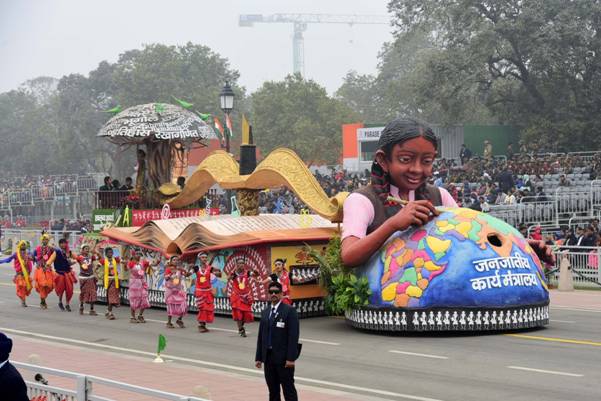
- 13 Jul 2025
In News:
In a significant milestone for tribal education in India, nearly 600 students from Eklavya Model Residential Schools (EMRSs) across 12 States have successfully cleared top national-level entrance exams like IIT-JEE (Mains & Advanced) and NEET 2024, as per the recent performance assessment by the Ministry of Tribal Affairs. This marks a remarkable improvement in academic outcomes for Scheduled Tribe (ST) students in government-run residential schools.
Breakdown of Performance (2024-25):
- IIT-JEE Mains: 218 students qualified; ~25 expected to secure admission in NITs.
- IIT-JEE Advanced: 34 students qualified; 18 likely to get admission into IITs.
- NEET: 344 students qualified; 3 expected to be placed in AIIMS, others in top government medical colleges.
This is the first comprehensive data compilation for EMRS performance in national competitive exams, a sharp increase from earlier years when only a few dozen tribal students achieved similar success.
Government Support & Outreach:
To further encourage these meritorious students, the Ministry of Tribal Affairs is launching a dedicated outreach programme:
- Students will be actively supported and hand-held through the post-matric scholarship application process.
- The Scholarship Division of the Ministry will proactively connect with all qualifying students to ensure they receive their entitled financial support.
- This initiative reflects a paradigm shift from passive support to active facilitation.
Institutional and Policy Framework:
- EMRS is a flagship scheme under the Ministry of Tribal Affairs, aimed at providing quality residential education from Class 6 to 12 to tribal students in remote and underdeveloped regions.
- Introduced in 1998, the programme was revamped in 2018–19 to enhance infrastructure and expand coverage.
- Schools are being established in blocks with >50% tribal population and at least 20,000 tribal persons.
- The government has targeted the establishment of 728 EMRSs by 2026.
- The National Education Society for Tribal Students (NESTS), an autonomous body under the Ministry, is tasked with operationalizing these schools.
Key Features of EMRS:
- Co-educational residential schools from Class VI to XII.
- Follow CBSE curriculum; completely free education.
- Special focus on local tribal culture, sports, and skill development.
- Each school has a capacity of 480 students, with gender parity in enrolment.
- Reservation norms: 10% for non-ST students; 20% under sports quota for ST students excelling in sports.
- Infrastructure includes academic blocks, hostels, teacher accommodations, labs, sports grounds, and cultural activity spaces.
Recent Initiatives and Recognition:
- The success is partly attributed to strategic partnerships with reputed coaching institutes facilitated by NESTS for IIT-JEE and NEET preparation.
- Around 85% of EMRS students belong to Scheduled Tribes, including Particularly Vulnerable Tribal Groups (PVTGs).
- The achievements were acknowledged in a high-level review meeting chaired by Union Tribal Affairs Minister Jual Oram and MoS Durgadas Uikey, who lauded the efforts of teachers, administrators, and students.
Advanced Towed Artillery Gun System (ATAGS)
- 12 Jul 2025
In News:
The Advanced Towed Artillery Gun System (ATAGS) marks a significant milestone in India’s defence modernization. Developed indigenously under the ‘Make in India’ initiative, the system is poised to replace the Indian Army’s ageing artillery with cutting-edge, high-performance firepower.
Key Facts:
- Calibre: 155 mm / 52 calibre
- Maximum Range: Up to 48 km, among the longest for towed artillery globally
- Developer: Defence Research and Development Organisation (DRDO) through ARDE (Pune)
- Production Partners: Bharat Forge Ltd and Tata Advanced Systems Ltd
Project Timeline & Cost:
- Project initiated in 2012 and completed within 12 years
- In March 2025, the Defence Ministry signed contracts worth ?6,900 crore for procurement of 307 ATAGS units and associated 6×6 towing vehicles
- Delivery scheduled over five years
Salient Features of ATAGS:
- Firing Modes: Burst, Intense, and Sustained fire
- Firing Capacity: Up to five rounds per minute, 60 rounds per hour
- Automation: Fully electric gun-laying and ammunition handling, replacing conventional hydraulics for enhanced reliability and reduced maintenance
- Shoot-and-Scoot Capability: Quick repositioning post firing to avoid counter-battery fire
- Rapid Deployment: Becomes operational within 90 seconds
- Mobility: Towed by a 6×6 high mobility vehicle, suitable for desert and mountainous terrain
- Ammunition Compatibility: Supports all 155 mm ammunition types including high-explosive, smoke, illumination, and precision-guided shells
- Minimum Range Advantage: Capable of achieving shortest minimum range at high elevation angles
- Operating Conditions: Designed for extreme climates
Strategic Significance:
- Artillery Modernization: Replaces vintage, smaller-calibre guns, enhancing range, accuracy, and tactical mobility
- Indigenous Content: Over 80% components sourced domestically, contributing to Aatmanirbhar Bharat
- Mission Mode Achievement: Described as an "exemplary mission-mode success" by the Ministry of Defence
- Multi-Sector Collaboration: Joint effort between DRDO, Indian Army, public and private sector manufacturers
Broadcasting Infrastructure and Network Development (BIND) Scheme
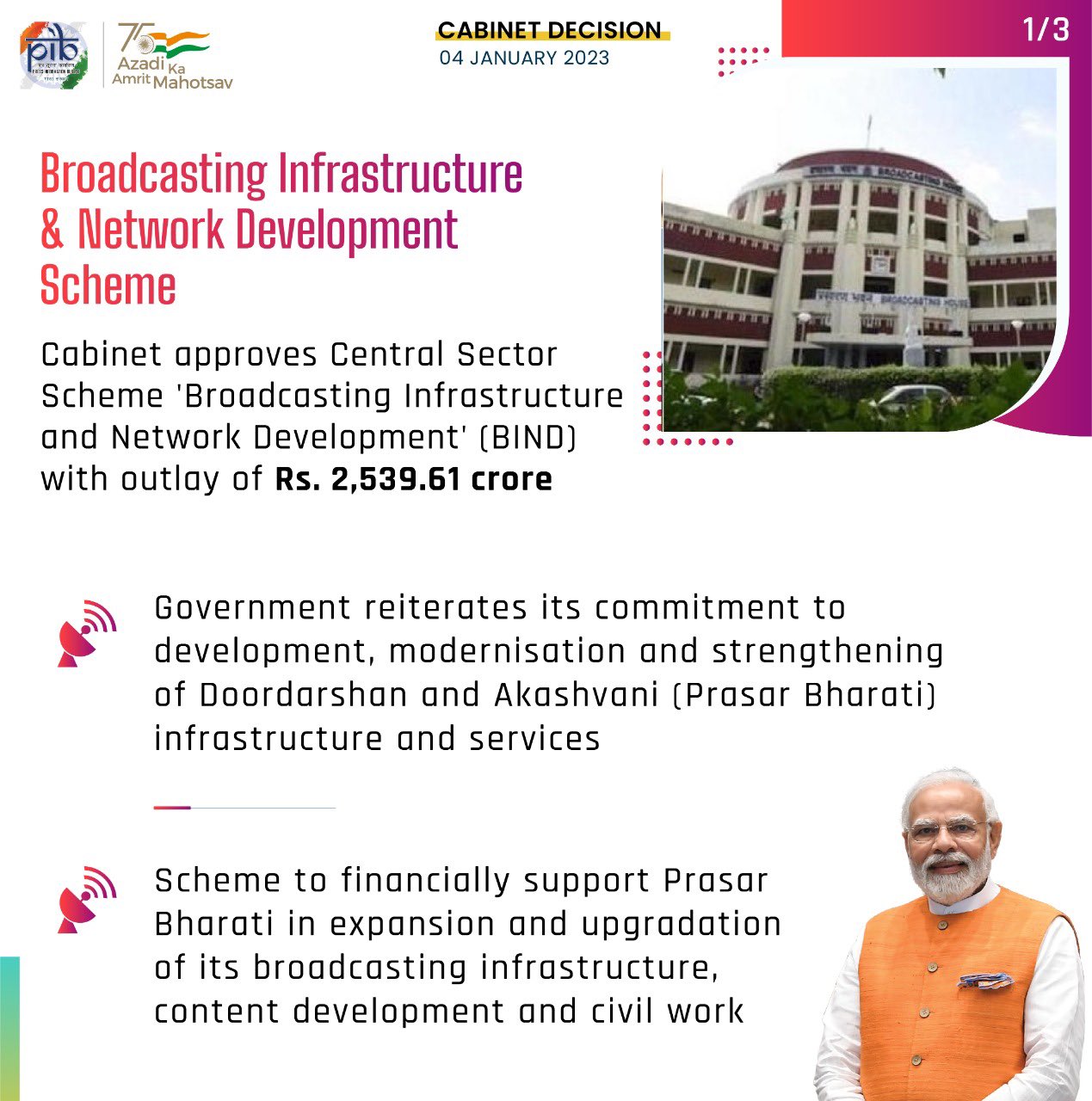
- 12 Jul 2025
In News:
The Government of India has proposed the establishment of a new Akashvani Kendra in Ujjain, Madhya Pradesh, under the Broadcasting Infrastructure and Network Development (BIND) Scheme.
About BIND Scheme
- Type: Central Sector Scheme
- Implementing Agency: Ministry of Information and Broadcasting
- Beneficiary: Prasar Bharati (All India Radio and Doordarshan)
- Objective: To provide financial support for:
- Expansion and modernization of broadcasting infrastructure
- Content development for domestic and international audiences
- Civil works related to Prasar Bharati’s operations
Key Features
- Facilitates technological upgradation of All India Radio (AIR) and Doordarshan (DD)
- Enhances reach in border, Left-Wing Extremism (LWE)-affected, and strategic regions
- Focuses on high-quality and diverse content
- Expands the capacity of the DTH platform, enabling more channels for viewers
- Aims to boost AIR FM coverage from 59% to 66% of India's geographical area and from 68% to 80% of the population
Significance
- Supports regional broadcasting, especially in underserved and aspirational districts
- Promotes cultural preservation and grassroots-level development narratives
- Expected to create indirect employment in manufacturing and broadcast services sectors
- Aids in ensuring last-mile delivery of public communication and information services
The proposed Akashvani Kendra in Ujjain aligns with the broader vision of ‘Viksit Bharat’, focusing on inclusive media access and robust public broadcasting infrastructure. It underscores the growing synergy between the Centre and States to enhance media penetration and communication outreach.
Coartem Baby
- 12 Jul 2025
In News:
In a significant breakthrough in global health, Switzerland has approved Coartem Baby, the first malaria treatment specifically designed for newborns and infants weighing 2–5 kg. Developed by Novartis in collaboration with the Medicines for Malaria Venture (MMV) and international health partners, this pediatric formulation is set to fill a critical treatment gap in malaria-endemic regions.
About Coartem Baby:
- What it is: A pediatric formulation of the antimalarial drug artemether-lumefantrine, customized for babies under 6 months of age (2–5 kg weight range). It is also known as Riamet Baby in some countries.
- Developed by: Novartis, in partnership with MMV, with support from the governments of Switzerland, UK, Netherlands, World Bank, and the Rockefeller Foundation.
- Approval path: Authorized under Swissmedic’s Global Health Products pathway, with fast-track approvals expected in eight African nations: Burkina Faso, Ivory Coast, Kenya, Malawi, Mozambique, Nigeria, Tanzania, and Uganda
Key Features:
- Infant-Specific Design:
- Dose ratio adapted for immature liver function
- Dissolves easily in liquids, including breast milk
- Cherry-flavoured for easier administration
- Public Health Impact:
- Addresses treatment needs of ~30 million newborns born annually in malaria-endemic African countries
- Targets the most vulnerable group previously excluded from clinical trials and vaccination coverage
- Safety Advantage:
- Eliminates the risk of off-label dosing from older children’s formulations
- Offers a clinically proven, age-appropriate treatment alternative
- Access Model: Will be distributed on a largely not-for-profit basis in malaria-endemic countries
Why it matters:
- Fills a Long-standing Treatment Gap: Until now, no antimalarial drug was approved for infants weighing less than 4.5 kg, despite their high risk.
- Impact on Child Mortality:
- As per 2023 data, 597,000 malaria deaths occurred globally, with ~75% among children under 5, mostly in Africa
- The approval of Coartem Baby could drastically reduce mortality in this group
Key Facts about Malaria:
- Cause: Life-threatening illness caused by Plasmodium parasites, transmitted by infected female Anopheles mosquitoes
- Most Dangerous Species:
- Plasmodium falciparum
- Plasmodium vivax
- Transmission: Not contagious person-to-person, but can spread via infected blood or needles
- Symptoms (appear 10–15 days after bite):
- Fever, chills, vomiting, headache
- Severe: seizures, breathing difficulty, jaundice, dark urine, coma, death
- Immunity: Partial immunity can develop in endemic regions, complicating diagnosis
Accelerator Mass Spectrometry (AMS) Dating
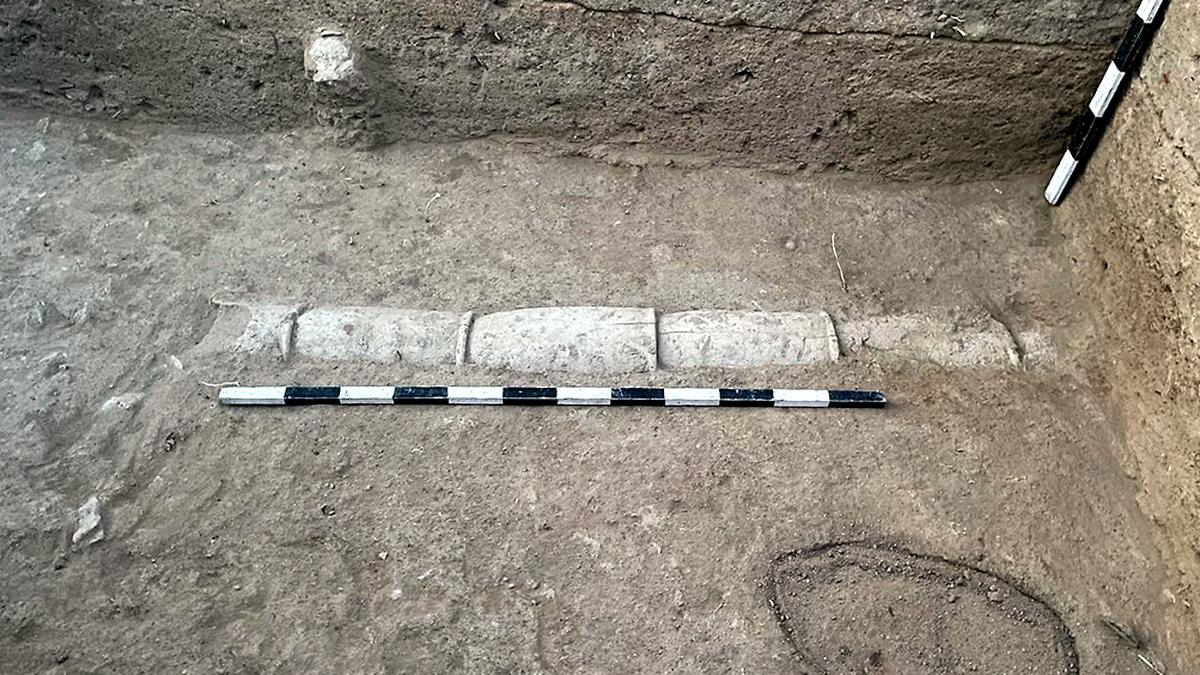
- 12 Jul 2025
In News:
The Tamil Nadu State Department of Archaeology (TNSDA) has sent 23 charcoal samples from seven archaeological excavation sites to the Beta Analytic Laboratory in the United States for Accelerator Mass Spectrometry (AMS) dating, aiming to establish an accurate chronology of the cultural deposits unearthed during the 2024–25 excavation season.
Key Discoveries:
- Keeladi: Over 500 antiquities, 100 inscribed potsherds, including red-slipped ware with fish motifs.
- Porpanaikkottai: From 11 trenches, 1,792 antiquities such as pottery, glass beads, and bangles were found.
- Tirumalapuram: A stone slab chamber with urn burials—a first in Tamil Nadu’s megalithic excavation record.
What is AMS Dating?
- A high-precision radiocarbon dating technique that measures the Carbon-14 (C-14) content in archaeological samples.
- Unlike conventional radiometric methods, AMS counts individual atoms of C-14, not their radioactive decay.
How It Works:
- Sample Preparation: Organic samples like charcoal are chemically treated and converted to graphite.
- Ion Generation: A cesium beam bombards the graphite, generating negatively charged carbon ions.
- Acceleration: Ions are propelled by a tandem electrostatic accelerator to high kinetic energies.
- Stripping & Detection:
- Ions pass through a stripping chamber to become positively charged.
- Magnetic fields separate C-12, C-13, and C-14 isotopes based on mass.
- C-14 atoms are counted to calculate the sample’s age.
Advantages of AMS Dating:
|
Feature |
AMS Dating |
Conventional Radiocarbon Dating |
|
Sample Size |
As little as 20 mg |
Requires ≥10 grams |
|
Precision |
Higher – atom-level count |
Lower – based on decay measurement |
|
Time |
Results within hours to days |
1–2 days or more |
|
Destructiveness |
Less destructive, ideal for rare artifacts |
More sample consumed |
|
Sensitivity |
Detects trace C-14 levels in minute samples like seeds, blood, etc. |
Limited sensitivity |
Applications of AMS:
- Archaeology: Dating of charcoal, wood, bones, pottery layers.
- Climate Science: Carbon mapping in marine and sediment systems.
- Geology/Oceanography: Sediment and core dating.
- Biomedical Research: Drug microdosing, tracing labeled compounds.
Admiralty (Jurisdiction and Settlement of Maritime Claims) Act, 2017
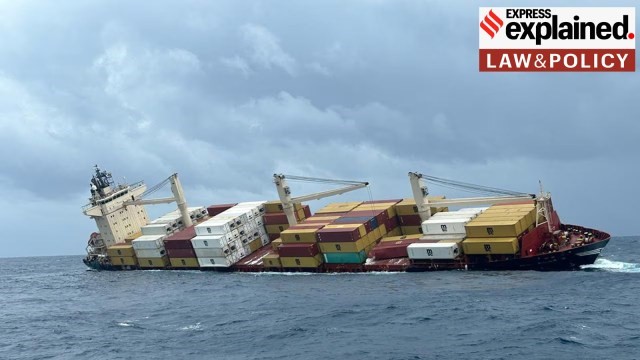
- 12 Jul 2025
In News:
In a rare legal move, the Kerala High Court ordered the conditional arrest of the Liberian container ship MSC Akiteta II, anchored at Vizhinjam Port. The Kerala government filed an admiralty suit seeking ?9,531 crore compensation for alleged environmental and economic damage caused by the sinking of MSC Elsa III.
Legal Framework: Admiralty (Jurisdiction and Settlement of Maritime Claims) Act, 2017
Purpose:
- Consolidates and updates maritime laws in India.
- Replaces outdated colonial legislations like:
- Admiralty Court Act, 1861
- Colonial Courts of Admiralty Acts of 1890 and 1891
- Relevant provisions of Letters Patent, 1865
Applicability:
- Applies to all vessels, regardless of owner’s residence or domicile.
- Exemptions:
- Inland vessels under the Inland Vessels Act, 1917
- Warships and other government vessels used for non-commercial purposes
- Foreign government vessels used for non-commercial purposes (as notified)
Key Provisions:
Section 4 – Maritime Claims:
High Courts can adjudicate disputes related to:
- Damage to vessels or marine environment
- Oil pollution and hazardous cargo
- Ownership or possession of a vessel
- Loss of life or injury due to vessel operations
- Carriage agreements (goods/passengers)
- Claims for unpaid wages, port dues, or cargo losses
Section 5 – Arrest of Vessels:
- Courts may order “arrest” of a ship to secure a maritime claim.
- Arrest can be made even if the ship is not directly involved but is owned by the liable party.
- It serves to ensure that compensation or security is provided before the vessel is released.
- Claimants may be asked to furnish an unconditional undertaking to compensate for wrongful arrest, if proved later.
Jurisdictional Expansion:
- Earlier limited to Bombay, Calcutta, and Madras High Courts.
- Now extended to Kerala, Karnataka, Odisha, Telangana, and Andhra Pradesh as well.
- Jurisdiction covers territorial waters up to 12 nautical miles, including seabed, subsoil, and airspace.
In Rem vs In Personam:
- Legal action can be initiated directly against the vessel (in rem) or against the owner/operator (in personam), based on the nature of the claim.
National Maritime Domain Awareness (NMDA) Project
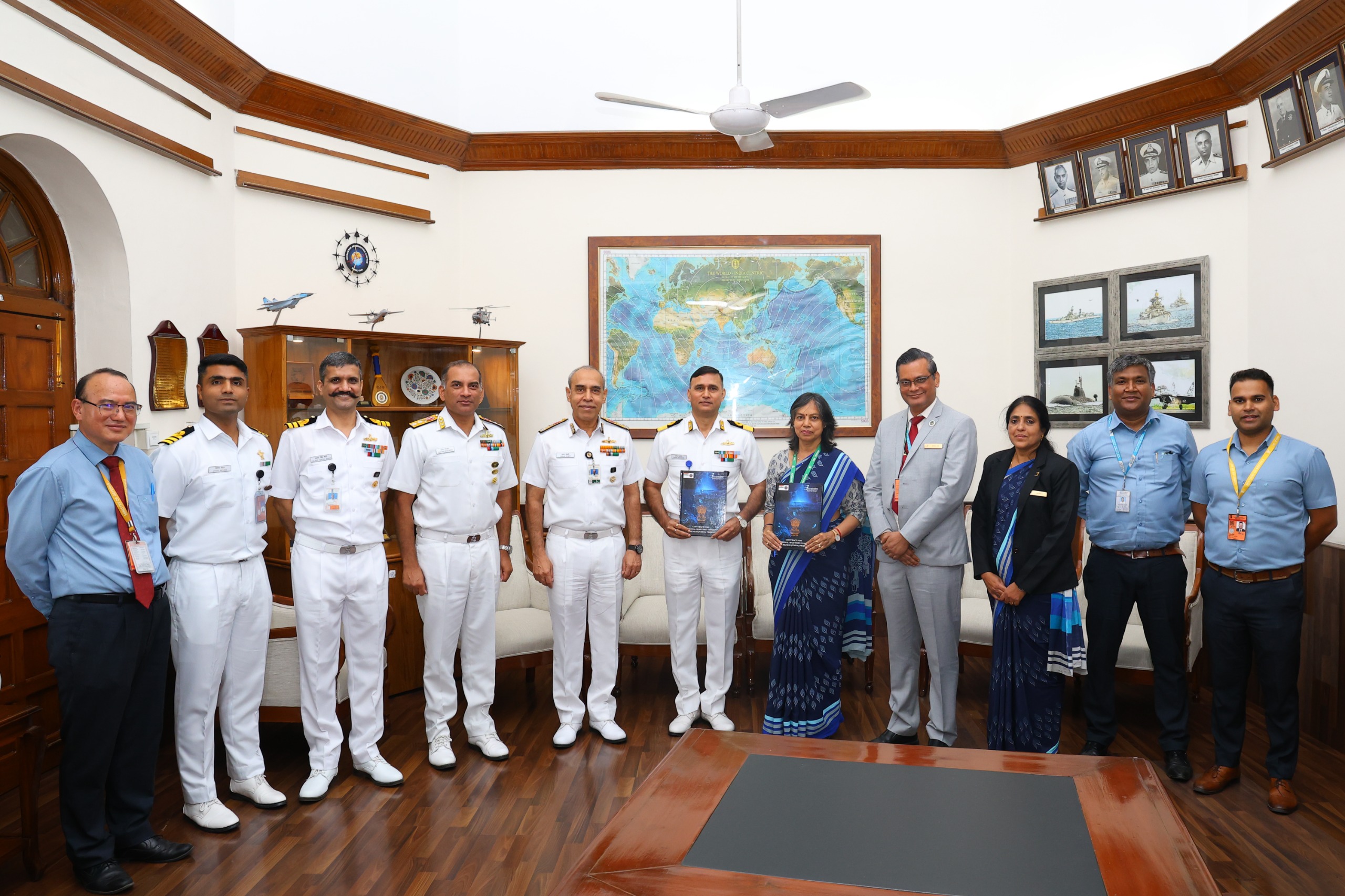
- 11 Jul 2025
In News:
The Indian Navy has signed a significant contract with Bharat Electronics Limited (BEL), Bengaluru for the implementation of the National Maritime Domain Awareness (NMDA) Project, a strategic initiative to strengthen India’s maritime and coastal security infrastructure.
Key Objectives and Scope
- Purpose: The NMDA Project aims to create a unified, real-time maritime surveillance and information-sharing framework to safeguard India's vast coastline and maritime interests.
- It seeks to enhance coordination among maritime stakeholders, including national agencies, coastal states, and union territories.
Major Components of the Project
- Upgrade of NC3I Network: The existing National Command, Control, Communication and Intelligence (NC3I) Network will be upgraded to a more advanced NMDA Network.
- AI Integration: Artificial Intelligence-enabled software will be deployed to enable smart surveillance, automated threat detection, and informed decision-making.
Multi-Agency NMDA Centre
- The Information Management and Analysis Centre (IMAC) at Gurugram — currently the nodal agency of the NC3I Network — will be transformed into a Multi-Agency NMDA Centre.
- The upgraded centre will include representatives from 15 national agencies across seven key ministries, such as Defence, Shipping, Petroleum, and Fisheries, ensuring seamless inter-agency coordination.
Operational and Strategic Benefits
- Integrated Maritime Picture: The system will link various stakeholders to provide a comprehensive operational view of India’s maritime domain.
- Enhanced Response: It will improve response mechanisms to maritime threats, search and rescue operations, environmental incidents, and other contingencies.
- Data Integration: Inputs from sectors such as commercial shipping and fisheries will be integrated into the system for improved situational awareness.
Execution and Administration
- The project will be implemented on a turnkey basis and administered by the Indian Navy.
- BEL will act as the lead system integrator, delivering both hardware and AI-enabled software solutions for the project.
Miniature Plasma Loops

- 11 Jul 2025
In News:
A significant discovery by Indian and international astronomers has unveiled the existence of miniature plasma loops in the lower layers of the Sun’s atmosphere, shedding new light on how the Sun stores and releases magnetic energy—a long-standing mystery in solar physics.
- These loops are tiny in scale, measuring 3,000–4,000 km in length and less than 100 km in width, making them difficult to detect with earlier instruments. Despite their short lifespan of only a few minutes, they offer crucial insights into magnetic reconnection—a process where tangled magnetic field lines snap and realign, releasing immense energy.
- The research was led by scientists at the Indian Institute of Astrophysics (IIA), Bengaluru, under the Department of Science and Technology (DST), in collaboration with global institutions including NASA, the Max Planck Institute, and the Big Bear Solar Observatory (BBSO).
Key Findings and Instruments Used
- The team used high-resolution imaging and multi-wavelength spectroscopy, combining data from the Goode Solar Telescope (BBSO), NASA’s IRIS, and the Solar Dynamics Observatory (SDO).
- The loops were observed in the H-alpha spectral line from hydrogen atoms—crucial for studying the solar chromosphere.
- Spectroscopic data from IRIS revealed non-thermal broadening of spectral lines, indicating explosive magnetic activity.
- Plasma jets erupting from the tops of these loops point to reconnection-driven events, similar to those that cause large-scale solar eruptions.
- Using Differential Emission Measure (DEM) analysis, the plasma inside these tiny loops was found to reach temperatures of several million degrees, which is unexpectedly high for regions in the dense chromosphere.
Why It Matters
- Although coronal loops in the outer solar atmosphere have been studied for decades, these miniature loops offer a unique window into the fine-scale dynamics of the Sun's magnetic environment. Understanding them is crucial for grasping the mechanisms behind solar flares, coronal heating, and space weather phenomena that impact Earth.
Future Prospects
- The findings highlight the need for next-generation solar observatories. India’s upcoming National Large Solar Telescope (NLST)—a 2-meter aperture facility proposed near Pangong Lake, Ladakh—aims to provide sharper images of the Sun’s chromosphere and better magnetic field data.
Great Hornbill Sighting

- 11 Jul 2025
In News:
In a rare and ecologically significant event, the Great Hornbill (Buceros bicornis), Kerala’s State Bird, was recently spotted in the coastal belt of Kakkampara, near Ezhimala in Kannur district. This area lies well outside the species’ typical forested habitats, making the sighting both unusual and important for biodiversity assessments.
About the Great Hornbill
- The Great Hornbill, also known as the great Indian hornbill or great pied hornbill, is one of the largest members of the hornbill family.
- It is primarily found in the Western Ghats, forests along the Himalayas, and parts of Southeast Asia.
- Its preferred habitat includes wet evergreen and moist deciduous forests at elevations between 600 to 2000 meters.
- This large, vividly colored bird measures between 95 to 120 cm in length with a wingspan of 151 to 178 cm, and typically weighs around 3 kilograms.
- The hornbill is easily identifiable by its prominent casque, a hollow structure on top of its large yellow bill. Males and females look similar, although males can be distinguished by their red irises and slightly larger casques, whereas females have white irises.
- Hornbills are primarily frugivorous, feeding on a variety of forest fruits, especially figs. However, they are opportunistic and may also consume small reptiles, birds, and mammals.
- A distinctive feature of the Great Hornbill is the tinted oil secreted by its preen gland, which gives its feathers, bill, and casque a yellow to reddish hue during grooming.
Conservation Status and Legal Protection
- The Great Hornbill is listed as ‘Vulnerable’ on the IUCN Red List due to habitat loss, hunting, and fragmented populations.
- In India, it is provided the highest level of protection under Schedule I of the Wildlife (Protection) Act, 1972, making it illegal to hunt or trade the species.
Ecological Importance of the Ezhimala Sighting
The occurrence of the Great Hornbill in a coastal region far from its usual forest range is considered a valuable ecological indicator. Experts believe such sightings could hint at changing habitat patterns, microhabitat availability, or even displacement due to habitat disturbance in core forest areas. The area around Ezhimala, despite human habitation, appears to sustain enough ecological richness to attract such a rare forest species.
India’s Battery Passport System
- 11 Jul 2025
In News:
The Government of India is preparing to implement a Battery Passport framework to enhance safety, traceability, and export readiness of electric vehicle (EV) batteries. The initiative is being spearheaded by NITI Aayog in collaboration with multiple ministries and stakeholders.
What is a Battery Passport?
A Battery Passport is a digital identity assigned to each EV battery, embedded in a QR code, which stores complete lifecycle information. This includes:
- Origin and manufacturing details
- Chemical composition and configuration
- Performance metrics and carbon footprint
- Date of manufacture and service history
- End-of-life data for recycling and reuse
The system assigns each battery a unique ID, akin to an Aadhaar for batteries, ensuring transparency and traceability across its lifecycle.
Key Features:
|
Feature |
Description |
|
QR Code Integration |
Allows users and service providers to scan and access battery details |
|
Lifecycle Tracking |
Monitors battery data from production to disposal |
|
Unique Digital Identity |
Each battery is individually identifiable, preventing cell mismatch |
|
Real-Time Monitoring |
Tracks performance, degradation, and usage patterns |
|
Standardised Data Format |
Includes manufacturer info, batch ID, composition, carbon metrics |
|
Controlled Data Access |
Enables secure sharing with regulators, manufacturers, and recyclers |
|
EU Compliance Ready |
Aligns with European Union regulations for batteries above 2 kWh |
Why is it Needed?
- Battery Safety: Addresses concerns due to frequent EV fire incidents linked to faulty or mismatched battery cells.
- Battery Swapping: Ensures interoperability and standardisation, essential for the upcoming battery-swapping policy.
- Export Promotion: Positions Indian batteries to comply with global traceability norms, especially in EU markets.
- Lifecycle & Performance Transparency: Batteries make up ~40% of EV cost; users benefit from informed decision-making.
- Circular Economy: Facilitates reuse, recycling, and end-of-life recovery to promote sustainability.
Expected Benefits
- Improved EV safety and reliability
- Enhanced consumer confidence
- Boost to India’s EV exports
- Support for circular economy in battery usage
- Industry-wide quality and compliance enforcement
Vera C. Rubin Observatory
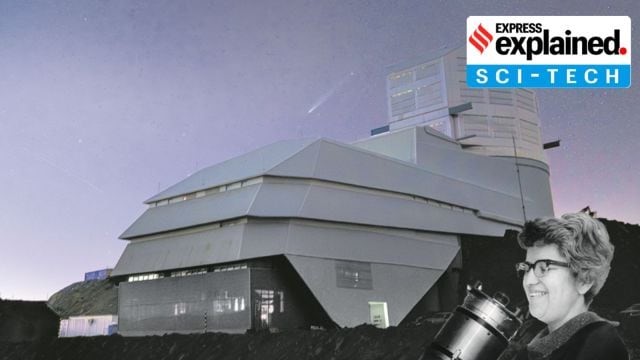
- 11 Jul 2025
In News:
The Vera C. Rubin Observatory in Chile has unveiled its first stunning images, highlighting the capabilities of its 3,200-megapixel digital camera — the most powerful ever constructed.
Location and Background:
- Situated 8,684 feet above sea level on Cerro Pachón mountain, Chilean Andes.
- Named after Vera C. Rubin, the astronomer who first provided evidence for dark matter in the 1970s.
- Joint initiative of the U.S. Department of Energy (DOE) and the National Science Foundation (NSF).
Objective:
The observatory aims to conduct an unprecedented 10-year survey of the southern sky, addressing critical questions like:
- Structure and formation of the Milky Way
- Existence of Planet 9
- Detection of potentially hazardous asteroids
- Nature of dark matter and dark energy
Key Features:
1. Simonyi Survey Telescope
A state-of-the-art telescope, unique for:
a) Wide Field of View:
- Captures an area equivalent to 40 full Moons in a single shot.
- Utilizes a three-mirror design:
- Primary Mirror: 8.4 m
- Secondary Mirror: 3.5 m
- Tertiary Mirror: 5 m (part of primary)
- Enables scanning of the entire visible sky every three nights.
b) Largest Digital Camera in the World:
- Size: Comparable to a small car
- Weight: 2,800 kg
- Resolution: 3,200 megapixels
- Sensor sensitivity: Detects objects 100 million times dimmer than visible to the naked eye
- Has six optical filters to capture various wavelengths (e.g., UV for hot stars, IR for distant galaxies)
c) Fastest Slewing Capability:
- Adjusts from one celestial target to another in just five seconds
- Enables up to 1,000 images per night
Scientific Potential and Impact
- Will collect 20 terabytes of data every night, generating nearly 10 million alerts per night for any detected changes in the sky.
- Already identified 2,104 new asteroids, including 7 near-Earth objects, using only 10 hours of preliminary data.
- Expected to catalogue:
- 5 million+ asteroids
- 100,000 near-Earth objects
- More than double the total known asteroids within a year of full operation
- Facilitates a high-resolution map of the universe’s structure—vital to understand the distribution of dark matter and dark energy, which together constitute 95% of the universe.
Sheesh Mahal
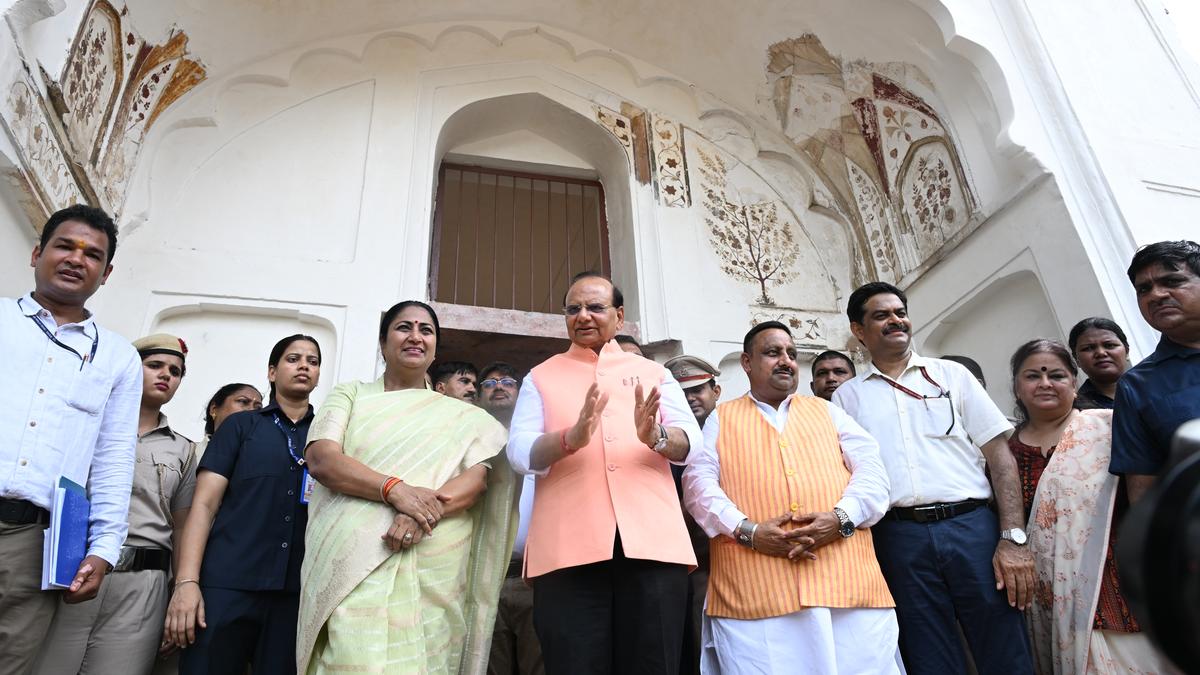
- 10 Jul 2025
In News:
The Sheesh Mahal, a 17th-century Mughal-era palace located in Shalimar Bagh, North Delhi, was recently restored and reopened to the public by the Union Culture and Tourism Minister. The restoration was carried out by the Archaeological Survey of India (ASI) and the Delhi Development Authority (DDA).
About Sheesh Mahal
- Built in 1653 by Izz-un-Nisha Begum, wife of Mughal Emperor Shah Jahan.
- Inspired by and a replica of Shalimar Bagh in Kashmir, designed as a royal retreat from Shahjahanabad.
- The garden was originally called Aizzabad Garden, later renamed Shalimar, meaning “abode of pleasure”.
- The palace was the site of Aurangzeb’s first coronation in 1658.
- Declared a monument of national importance in 1983, under ASI protection.
Architectural Features
- Constructed using red sandstone and brick masonry.
- Features archways, three-arched dalans, and a central hall with compartments on each wing.
- A Baradari (pavilion) lies in the main building with a water channel passing through it.
- Houses mirror-worked chambers with paintings in Kangra and Rajasthani qalam, depicting poetic imagery by Keshav, Surdas, and Bihari.
- Adjacent structure served as a Hamam (bathhouse).
Restoration Highlights
- ASI restored the palace’s original heritage features.
- DDA recreated the traditional Mughal Char Bagh-style landscape.
- Traditional materials used: Lime surkhi, lakhori bricks, gud (jaggery), belgiri, and urad dal.
- An old baradari and three heritage cottages were also restored.
New Additions for Public Engagement
- Two heritage cottages repurposed:
- The Readers Café Corner – a literary café.
- Café Shalimar – for general visitors.
2nd Edition of the NER District SDG Index
- 10 Jul 2025
In News:
NITI Aayog, in collaboration with the Ministry of Development of North Eastern Region (MoDoNER) and with technical support from UNDP, released the second edition of the North Eastern Region District SDG Index (2023–24).
About the NER District SDG Index
- First Edition: Released in August 2021
- Current Edition: Covers 121 districts across the 8 North Eastern States
- Developed By: NITI Aayog, MoDoNER, and UNDP
- Purpose:
- Monitor district-wise progress on Sustainable Development Goals (SDGs)
- Provide evidence-based planning, resource allocation, and intervention strategies
- Ensure localisation of SDGs and leave no one behind
Scoring Categories
Districts are classified into four categories:
- Achiever: Score = 100
- Front Runner: Score 65–99
- Performer: Score 50–64
- Aspirant: Score < 50
Composite Score Range:
- Highest: Hnahthial, Mizoram – 81.43
- Lowest: Longding, Arunachal Pradesh – 58.71
Key Highlights
- 85% of districts showed an increase in composite scores.
- All districts of Mizoram, Sikkim, and Tripura attained Front Runner status.
- Hnahthial (Mizoram) emerged as the best-performing district.
- Nagaland entered the Top 10 with 3 districts.
- Sikkim showed the most consistent intra-state performance with a score range of just 5.5 points.
- Assam saw notable improvements in Zero Hunger, Quality Education, Clean Water & Sanitation, and Decent Work & Economic Growth.
Top Performing Districts
Significance
- Supports the Viksit Bharat @2047 vision by targeting SDG achievement by 2030.
- Enhances cooperative federalism by aligning state and district efforts with national goals.
- Acts as a diagnostic and planning tool for identifying gaps and prioritising interventions.
UAE Golden Visa Scheme
- 10 Jul 2025
In News:
The United Arab Emirates (UAE) has introduced a nomination-based pilot Golden Visa programme targeting skilled individuals from India and Bangladesh. However, recent rumours around a ?23 lakh “lifetime visa” triggered misinformation, later debunked by UAE authorities.
What is a Golden Visa?
- A long-term residency visa allowing foreign nationals to live, work, or study in the UAE without a local sponsor.
- Designed to attract investors, entrepreneurs, scientists, and skilled professionals.
- Offers 5 to 10 years of renewable residency, and in some cases, lifetime validity under specific frameworks.
Key Features of the UAE Golden Visa Scheme
|
Feature |
Details |
|
Residency |
Long-term (5–10 years); in some cases lifetime under nomination |
|
Sponsorship |
Not required (self-sponsored) |
|
Eligibility Categories |
Investors, entrepreneurs, scientists, doctors, artists, athletes, PhD holders, exceptional students |
|
Benefits |
Sponsor family and domestic staff; multiple entry; no need to stay in UAE continuously |
|
New Nomination-Based Model |
Pilot phase launched for India and Bangladesh — selection based on professional merit and contributions |
|
Application Process |
Managed through UAE’s official channels; some remote application facilities (e.g., OneVASCO centres) available |
|
No Minimum Investment Requirement (in new model) |
Unlike earlier versions requiring AED 2 million+ in assets or business |
Controversy: ?23 Lakh ‘Lifetime Golden Visa’ Rumour
- A viral rumour claimed that Indians could buy a lifetime UAE Golden Visa for ?23.3 lakh (AED 1,00,000).
- Debunked by UAE Government within 48 hours as false and misleading.
- Originated from a press release by Rayad Group, later withdrawn and discredited.
- UAE authorities clarified: No consultancy is authorised to process Golden Visas outside official channels.
- Golden Visas are not available for simple purchase; eligibility is merit-based, not transactional.
Eligibility vs. Misconception
- Golden Visas are for High Net-Worth Individuals (HNWIs) and exceptional talent — not for general migration or middle-class aspirations.
- Traditional routes still require investments of AED 2 million (~?4.67 crore) or equivalent in real estate or business.
Comparison with Other Countries’ Golden Visa Models
|
Country |
Investment Requirement |
|
Portugal |
€500,000 real estate / job creation / capital transfer |
|
Greece |
€250,000 property (rising in urban areas) |
|
Italy |
Startups, bonds, or public projects |
|
Singapore |
SGD 2.5 million under Global Investor Programme |
|
Grenada |
$235,000 donation or $270,000 property for citizenship |
|
UAE (Traditional) |
AED 2 million in real estate or business assets |
Significance for India-UAE Relations
- Enhances people-to-people links under the India–UAE Comprehensive Economic Partnership Agreement (CEPA).
- Offers Indian professionals access to UAE’s innovation, business, and academic ecosystem.
- Promotes economic diversification of UAE beyond oil — with India as a strategic partner.
Amaravati Quantum Valley Declaration (AQVD)
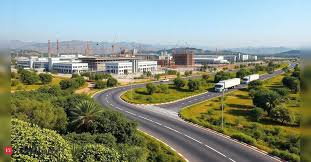
- 10 Jul 2025
In News:
The Government of Andhra Pradesh has officially approved the Amaravati Quantum Valley Declaration (AQVD), aiming to transform Amaravati into India’s first Quantum Valley and a global hub for quantum technologies.
What is AQVD?
- A strategic framework signed by the Andhra Pradesh Government, IBM, TCS, L&T, academia, and startups.
- It envisions a collaborative ecosystem for quantum computing, communication, sensing, and chip development.
- Seeks to align with India’s National Quantum Mission (NQM) to position Amaravati as a deep-tech capital.
Key Features and Targets
- Investment Goals: Total investment target of $1 billion by 2029, with $500 million by 2027.
- QChipIN: Creation of India’s largest open quantum testbed, integrating quantum computers and enabling hands-on innovation.
- Focus Areas: Quantum computing, quantum chip design, sensing technologies, and secure quantum communication.
- Skilling & Research: Encourages development of quantum talent and promotes industry-academia synergy.
Quantum Computing – Core Concepts
- Qubit: Basic unit of quantum data, unlike classical bits, can be in a state of superposition (0 and 1 simultaneously).
- Superposition: Enables parallel processing.
- Entanglement: Qubits can be interlinked, allowing instantaneous state sharing.
- Quantum Gates: Analogous to classical logic gates but work on qubits to perform complex operations.
Strategic & National Significance
- Dual-Use Technology: Quantum computing impacts national security, health, climate modeling, logistics, cryptography, and more.
- Data Sovereignty: Reduces dependence on foreign cloud-based quantum platforms.
- Global Competitiveness: Puts India on the map with nations like the US, China, and the EU in the quantum race.
Related National Initiatives
- National Quantum Mission (NQM):
- Launched with ?6,003 crore outlay.
- Target: Develop quantum computers with 50–1000 qubits by 2031.
- QpiAI-Indus (2025): India’s first full-stack quantum computer with 25 superconducting qubits.
- ISRO-SAC Projects: Satellite-based Quantum Key Distribution (QKD) for ultra-secure communications.
- Quantum Materials: Focus on superconductors and topological materials for robust devices.
Challenges Ahead
|
Challenge |
Description |
|
Decoherence |
Qubits are unstable and prone to error. |
|
Scalability |
Building large-scale, fault-tolerant systems is difficult. |
|
Cost |
Requires ultra-cold cryogenic systems and electromagnetic shielding. |
Japonica Rice
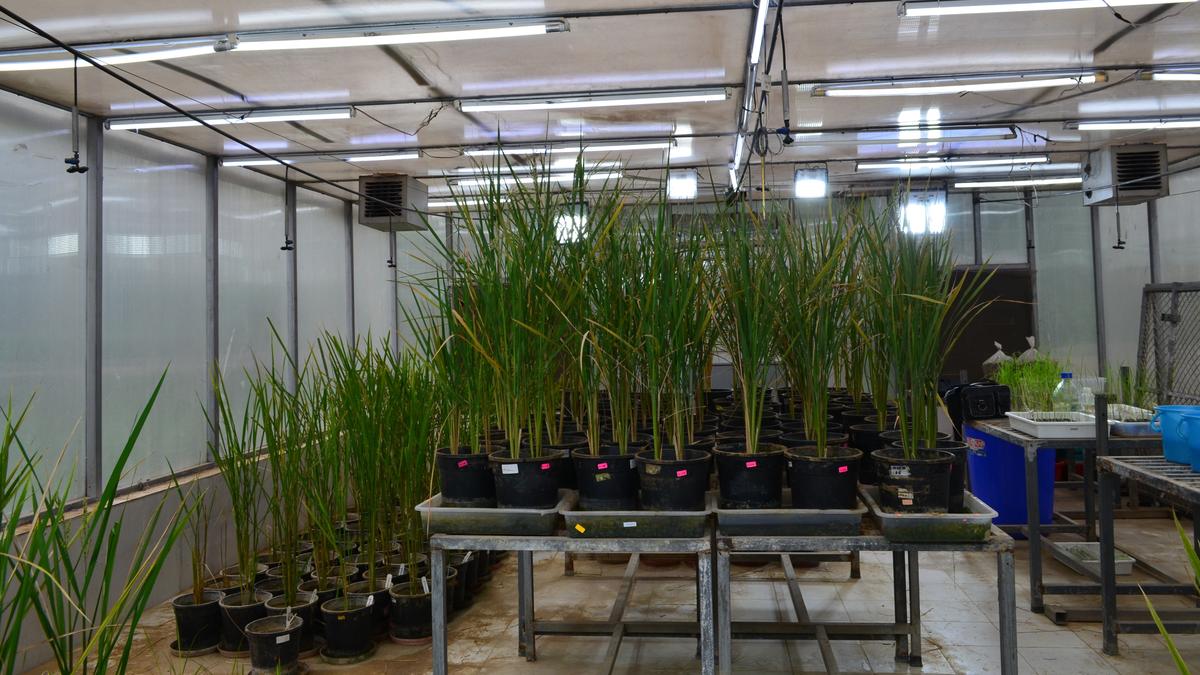
- 10 Jul 2025
In News:
The National Institute of Plant Genome Research (NIPGR), New Delhi, has successfully used CRISPR-Cas9 gene-editing technology to develop japonica rice lines with enhanced phosphate uptake, leading to up to 40% higher yield under limited fertilizer conditions. The research is published in the Plant Biotechnology Journal.
Background: Phosphorus and Agriculture
- Phosphorus (P) is vital for plant growth, involved in photosynthesis, energy transfer, and root development.
- However, only 15–20% of phosphate fertilizers are absorbed by crops; the rest is lost due to leaching or chemical fixation in soils.
- India imports ~4.5 million tonnes of DAP (Diammonium Phosphate) annually, making it crucial to improve P-use efficiency.
The Innovation: CRISPR-Based Precision Editing
- Target Gene: OsPHO1;2, a phosphate transporter responsible for P movement from root to shoot.
- Repressor Gene Identified: OsWRKY6, a negative regulator of OsPHO1;2.
- Initial approach (complete knockout of repressor) caused negative effects due to loss of other essential functions.
- Final strategy: Only the 30 base-pair binding site of OsWRKY6 on the promoter was deleted using CRISPR-Cas9, ensuring:
- Increased transporter expression
- Normal functioning of other plant processes
- Enhanced phosphate transfer and absorption
Key Outcomes:
- Yield Increase:
- 20% with full phosphate dose
- 40% with only 10% of recommended fertilizer
- Improved panicle number and seed count
- No compromise on seed size, starch content, or quality
- Roots acted as efficient phosphate sinks, absorbing more P from soil
- Gene-editing localized to promoter site, ensuring minimal genetic disturbance
Safety and Regulatory Assurance
- No off-target effects: Verified using leading in silico tools and genome analysis
- No foreign DNA in final seeds: Foreign genes (e.g., Cas9, Agrobacterium vector) eliminated via Mendelian segregation
- Plants with precise edits were screened and only accurate lines were cultivated further
Significance for India
- Phosphorus-deficient soils are common across India, especially in alkaline or acidic regions
- Potential application to indica rice varieties, widely grown in India
- Supports sustainable agriculture by reducing fertilizer usage and environmental runoff
- Strengthens food security and reduces import dependency on fertilizers
About Japonica Rice:
- One of the two main varieties of Oryza sativa (the other is Indica)
- Short, sticky grains; grown primarily in Japan, Korea, China, and other East Asian countries
- Model variety used: Nipponbare, due to ease of genetic manipulation
- Japonica is commonly used in research; adaptation to Indian indica cultivars is under process
National Overseas Scholarship Scheme
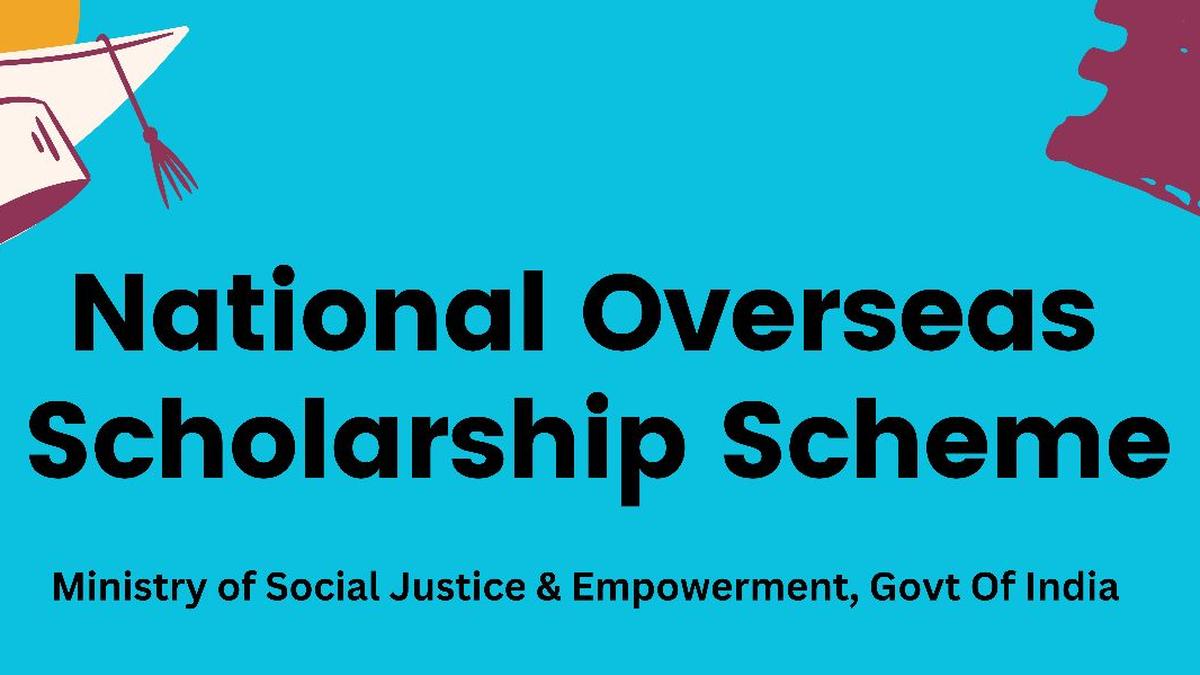
- 09 Jul 2025
In News:
The Ministry of Social Justice and Empowerment has come under scrutiny after withholding provisional award letters for 66 out of 106 selected candidates under the National Overseas Scholarship (NOS) scheme for the 2025–26 cycle. This development has raised concerns regarding funding gaps, administrative bottlenecks, and the future of the scheme intended to uplift marginalised students through access to global education.
About the National Overseas Scholarship Scheme
- The NOS is a Central Sector Scheme aimed at enabling students from socially and economically disadvantaged communities to pursue postgraduate (Master’s) and doctoral (Ph.D.) education abroad in top-ranking universities.
- It provides financial assistance for tuition, living expenses, contingency costs, and travel.
- Administered by: Ministry of Social Justice and Empowerment
- Target Beneficiaries:
- Scheduled Castes (SCs)
- Denotified, Nomadic, and Semi-Nomadic Tribes
- Landless Agricultural Labourers
- Traditional Artisans
- Eligibility Criteria:
- Academic Qualification:
- Master’s: Bachelor’s degree with ≥ 60%
- Ph.D.: Master’s degree with ≥ 60%
- Age Limit: Not more than 35 years as on April 1 of the selection year.
- Income Limit: Annual family income should not exceed ?8 lakh.
- University Criteria: Unconditional admission in Top 500 QS-ranked institutions.
- Other Conditions:
- A maximum of 2 students per family (second eligible only if slots remain).
- Not already settled or studying abroad.
- Key Features:
- Total Annual Slots: 125
- 115 for SCs, 6 for Denotified Tribes, 4 for Labourers/Artisans
- 30% reserved for women candidates
- Two-Phase Selection:
- First: QS Top 500 mandatory
- Second: Open to broader university lists
- State Cap: Maximum 10% slots per state to ensure geographic diversity
Ongoing Evaluation and Policy Review
- The government is currently conducting a performance evaluation of the NOS scheme ahead of its 16th financial cycle (2026–27). This includes assessing issues related to fund disbursal, slot utilization, and implementation gaps.
- A Parliamentary Standing Committee on Social Justice and Empowerment had earlier flagged:
- Insufficient scholarship amounts
- Persistent delays in fund release
- Underutilization of slots
- Need for expanding coverage and increasing annual slots
17th BRICS Summit 2025
- 09 Jul 2025
In News:
The 17th BRICS Summit was held in Rio de Janeiro, Brazil under the theme:
“Strengthening Global South Cooperation for a More Inclusive and Sustainable Governance.”
The summit concluded with the adoption of the Rio de Janeiro Declaration, marking a strategic shift towards BRICS expansion, inclusive multilateralism, and South-South cooperation.
What is BRICS?
- BRICS is an intergovernmental platform of emerging economies originally comprising Brazil, Russia, India, China, and South Africa.
- The term BRIC was coined by economist Jim O’Neill in 2001.
- The grouping evolved from informal dialogue (1st Summit in 2009, Yekaterinburg) to a structured cooperation framework.
- In 2024–25, BRICS underwent expansion and is now referred to as BRICS+.
Key Highlights of the 17th BRICS Summit 2025
1. Expansion of Membership
- Indonesia formally joined BRICS in 2025, becoming its first Southeast Asian member.
- Eleven new BRICS+ partner countries were welcomed: Belarus, Bolivia, Kazakhstan, Cuba, Nigeria, Malaysia, Thailand, Vietnam, Uganda, Uzbekistan.
- The expansion aims to reshape global power dynamics, promote multipolarity, and deepen Asia-Africa-Latin America cooperation.
2. Rio de Janeiro Declaration: Major Themes
A. Global Governance Reform
- Strong call for reforming UNSC, IMF, WTO to reflect contemporary geopolitical and economic realities.
- Supported the UN Summit of the Future's “Pact for the Future”, including the Global Digital Compact and Declaration on Future Generations.
- Emphasized greater participation of the Global South in international decision-making.
B. Peace and Security
- Condemned terrorism in all forms; specifically denounced the Pahalgam attack in India.
- Called for zero tolerance for terrorism and decisive global action against sponsors of terror.
- Opposed securitizing climate change; advocated development-centric responses to global challenges.
C. Technology and Responsible AI
- Released a Statement on Global AI Governance promoting a balance between innovation and regulation.
- Proposed the creation of a BRICS Science & Research Repository to facilitate open access for Global South researchers.
D. Climate Action
- Reaffirmed commitment to the Paris Agreement and UNFCCC principles, especially Common But Differentiated Responsibilities (CBDR).
- Supported Brazil’s hosting of COP-30 (Belem) and endorsed India’s bid for COP-33 in 2028.
- Launched the BRICS Leaders’ Framework on Climate Finance to enhance climate adaptation and finance equity.
E. Economic and Financial Cooperation
- Reviewed the BRICS Economic Partnership Strategy 2025; agreed to frame the 2030 Strategy, focusing on:
- Digital economy
- Trade and investment
- Financial integration
- Sustainable development
- Emphasized inclusive, rules-based multilateral trade systems.
- Launched BRICS Multilateral Guarantee Mechanism (BMG) under New Development Bank (NDB) to catalyze infrastructure and climate finance.
F. Social and Cultural Priorities
- Focus on inclusive development through:
- Empowerment of youth and women
- Support for persons with disabilities
- Urbanization and migration management
- Recognized demographic transitions as opportunities for sustainable growth.
India at BRICS 2025
India played a pivotal role in shaping key summit outcomes and announced its BRICS Chairship for 2026, themed around: Building, Resilience, Innovation, Cooperation, and Sustainability.
India’s Key Interventions:
- Global Financial Reform: Advocated for de-dollarization and diversification of global trade currencies.
- Digital Governance: Pushed for interoperable, inclusive digital public infrastructure.
- Institutional Reform: Reiterated the urgent need to restructure global governance institutions.
- Climate Finance: Urged equitable climate financing mechanisms for developing nations.
On BRICS Currency:
- India rejected the idea of a common BRICS currency, but supported local currency trade under a National Currency Settlement Framework.
- Refused to settle Russian oil trade in Chinese Yuan, indicating resistance to Chinese monetary dominance within BRICS.
Geopolitical Implications and U.S. Response
- With BRICS now representing 45% of the global population and 35% of world GDP, the bloc's rise has triggered concern in Western circles.
- The U.S., under former President Donald Trump, warned of:
- 10% tariff on countries aligning with BRICS’ "anti-American" stances.
- 100% tariff if BRICS pursues de-dollarization, viewing it as a direct challenge to U.S. economic interests.
Discovery of Penico
- 09 Jul 2025
In News:
Archaeologists have recently uncovered a significant archaeological site in northern Peru—an ancient city named Penico, estimated to be around 3,500 years old. The discovery sheds new light on early urban development, trade networks, and cultural evolution in pre-Inca South America.
Location and Time Period
- Geographic Location: Penico is located in the Barranca Province of northern Peru, approximately 200 km north of Lima, the capital.
- Altitude: The site is situated on a hillside terrace, around 600 metres above sea level.
- Estimated Age: The city is believed to have been founded between 1800 BCE and 1500 BCE, roughly during the same period as early civilizations in Egypt, Sumeria, and the Indus Valley.
Key Features of the Site
Urban and Architectural Highlights:
- The city is laid out around a central circular plaza, encircled by at least 18 identified stone-and-mud structures.
- Structures include:
- Ceremonial temples
- Residential complexes
- Public gathering areas with sculpted wall reliefs
Notable Artifacts:
- Clay figurines depicting human and animal forms
- Pututus (conch shell trumpets), traditionally used for long-distance communication
- Beaded necklaces and ceremonial artifacts crafted from shells and stones
Cultural and Historical Significance
Strategic Importance:
- Penico’s elevated location likely served both practical and symbolic purposes—protecting against natural disasters such as floods or landslides, while also enhancing the visibility and monumentality of its structures.
- The city’s placement made it a vital trading nexus, linking communities across the Pacific coast, Andean highlands, and the Amazon basin.
Link to the Caral Civilization:
- Penico is situated near the ancient city of Caral, considered the oldest known civilization in the Americas (dating back to 3000 BCE in the Supe Valley).
- Researchers suggest that Penico represents a cultural continuation or evolution of the Caral society, which declined due to climatic disruptions.
- The discovery of Penico offers valuable insight into how civilizations adapted and transitioned post-Caral, particularly in terms of urban planning, trade, and ceremonial practices.
Comparative Civilizational Context:
- Despite emerging in geographic isolation, Penico developed contemporaneously with Bronze Age civilizations of Mesopotamia, the Nile Valley, and South Asia, showcasing parallel patterns in complex societal development.
International Treaty on Plant Genetic Resources for Food and Agriculture (ITPGRFA)
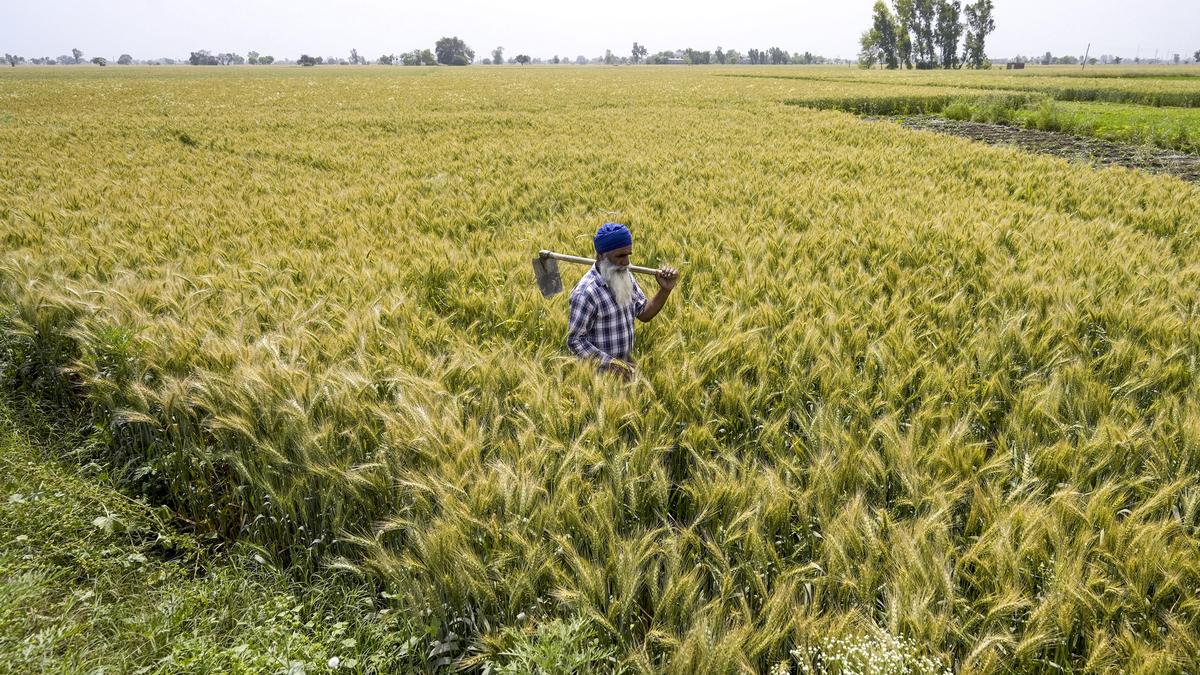
- 09 Jul 2025
In News:
India has raised strong objections to proposed amendments to the International Treaty on Plant Genetic Resources for Food and Agriculture (ITPGRFA)—also known as the Plant Treaty—during recent deliberations in Peru. The concerns stem from potential implications for India’s sovereign rights over plant genetic resources and its traditional farming practices.
About the Plant Treaty
The Plant Treaty is a legally binding international agreement, adopted by the Food and Agriculture Organization (FAO) in 2001 and enforced from 2004. India is a signatory to the treaty. It is aligned with the Convention on Biological Diversity (CBD) and supports the FAO’s Global Plan of Action.
Key Objectives:
- Conservation and sustainable use of plant genetic resources for food and agriculture (PGRFA).
- Equitable sharing of benefits arising from the use of these resources.
- Ensuring food security and preserving agrobiodiversity, especially for climate-resilient agriculture.
Core Features of the Treaty
- Multilateral System (MLS) of Access and Benefit-Sharing:
- Covers 64 major crops (e.g., rice, wheat, maize, pulses) listed in Annex I.
- Facilitates global access to plant genetic materials among member nations.
- Ensures benefit-sharing through:
- Technology transfer
- Capacity-building
- Commercialization revenues
- Standard Material Transfer Agreement (SMTA):
- A legal framework that governs the access, transfer, and exchange of genetic materials under the MLS.
- Farmers' Rights (Article 9):
- Recognizes the rights of farmers to save, use, exchange, and sell farm-saved seeds.
- Acknowledges indigenous knowledge and the contributions of local communities.
- Encourages inclusion of farmers in decision-making processes.
- Global Information System (Article 17): Facilitates data-sharing on plant genetic resources globally.
- Benefit-sharing Fund (BSF): Supports farmers and public institutions in developing countries to conserve genetic diversity, enhance crop productivity, and build resilience to pests and climate change.
India’s Concerns Over the Proposed Amendments
The new proposal seeks to expand the scope of Annex I, making it mandatory for countries to share all plant germplasm through the MLS under a uniform SMTA framework.
Why India Opposes the Proposal:
- Erosion of Sovereignty: It may weaken India’s control over its vast indigenous plant genetic wealth.
- Legal Conflict: The proposal could override India’s national laws governing access and benefit-sharing.
- Impact on Traditional Practices: Smallholder and tribal farmers who rely on traditional seed-saving and exchange systems may be adversely affected.
- Threat to Biodiversity Conservation: Centralized control over plant genetic materials could hinder community-led conservation efforts.
Alluri Sitarama Raju
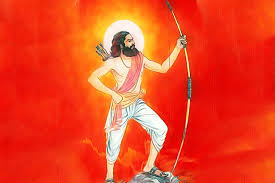
- 09 Jul 2025
In News:
During the 128th birth anniversary celebration of Alluri Sitarama Raju, the Union Defence Minister lauded his valiant role in India’s freedom movement. The Minister also reiterated the government’s commitment to ending Maoist extremism by August 2026.
Alluri Sitarama Raju
- He was a revolutionary figure revered for leading a tribal resistance against British colonial authority. Although he did not belong to a tribal community himself, he championed the cause of indigenous people, earning their deep respect and admiration.
- He was born on 4 July 1897 in Mogallu village, near Bhimavaram, located in present-day Andhra Pradesh. His revolutionary activities were concentrated in the Eastern Ghats’ Agency areas of the state.
Historical Context
- Early Life and Spiritual Turn: After receiving basic education in his village and later in Visakhapatnam, Alluri chose a life of renunciation around the age of 18. As a sanyasi, he traversed forested and hilly regions, developing a close bond with tribal communities.
- Gandhian Influence and Shift to Armed Struggle: Initially influenced by Mahatma Gandhi’s Non-Cooperation Movement, he urged tribal people to disengage from colonial institutions. However, disillusioned by the ineffectiveness of non-violence in protecting tribal rights, he resorted to armed rebellion.
- Role in the Freedom Struggle
- The Rampa Rebellion (1922–1924): Alluri became the face of the Rampa Rebellion, launched in protest against the Madras Forest Act, 1882, which curtailed traditional tribal practices like Podu cultivation and led to forced displacement. Additionally, tribals were subjected to unpaid labour for constructing colonial infrastructure, fueling widespread anger.
- Guerrilla Tactics and Resistance: Raju organized tribal youth into a guerrilla army that attacked British police outposts, looted weapons, and eliminated British officers, causing considerable concern for the colonial administration.
- Martyrdom: His growing influence and success made him a prime target for the British, who announced a ?10,000 bounty for his capture. He was eventually apprehended through deception and executed on 7 May 1924, reportedly tied to a tree and shot dead.
Legacy
- Revered as “Manyam Veerudu” or the Hero of the Jungle, Alluri’s life epitomizes courage and sacrifice.
- The Government of Andhra Pradesh commemorates July 4 as a state festival in his honour.
- He remains a powerful symbol of tribal resistance and justice in India's freedom narrative.
Nipah Virus
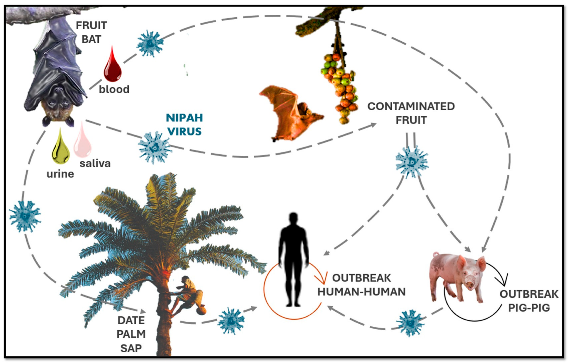
- 08 Jul 2025
In News:
The Kerala government has initiated a serological surveillance programme in response to the recurrent outbreaks of the Nipah virus (NiV) in the northern districts of the state. Notably, this marks the eighth outbreak in as many years within Kerala’s high-risk zones.
About Nipah Virus (NiV):
What is Nipah Virus?
- Zoonotic Nature: The Nipah virus is a highly infectious zoonotic pathogen, transmitted primarily from animals (especially bats) to humans.
- It can cause illnesses ranging from mild flu-like symptoms to fatal brain inflammation (encephalitis).
- Case Fatality Rate: Ranges between 40% and 75%, depending on healthcare accessibility and regional factors.
History of Outbreaks:
|
Country |
Outbreak Details |
|
Malaysia |
First outbreak recorded in 1999 among pig farmers. |
|
Bangladesh |
Repeated annual outbreaks since 2001. |
|
India |
Significant outbreaks in West Bengal (Siliguri) and Kerala (8 episodes since 2018). |
Reservoir and Transmission:
Natural Host:
- Fruit bats of the Pteropodidae family (genus Pteropus) are the natural reservoirs.
- The virus is shed through bat saliva, urine, and feces, often contaminating fruits or surfaces.
Modes of Transmission:
- Animal to Human:
- Direct contact with infected animals (especially pigs or bats).
- Consumption of contaminated items like raw date palm sap or fruit.
- Human to Human:
- Close contact with infected persons, especially bodily fluids.
- High risk in hospital settings among caregivers and healthcare workers.
Symptoms and Disease Progression:
- Initial Symptoms: Fever, headache, sore throat, muscle pain, and vomiting.
- Advanced Cases: Severe respiratory issues, seizures, encephalitis, and altered mental status.
- Incubation Period: Typically 4–14 days, may extend up to 45 days.
- Post-recovery Complications: Around 20% of survivors may suffer long-term neurological effects such as personality changes or seizures.
Diagnostic Tools:
- RT-PCR: Detects viral RNA in blood, urine, throat swabs, or cerebrospinal fluid.
- ELISA: Identifies presence of NiV-specific antibodies.
- Advanced Virology Labs: Use virus isolation and genome sequencing methods.
Kerala’s Serological Surveillance Initiative:
- The state has launched a targeted serological survey using pseudovirus neutralization assays.
- The survey focuses on human and domestic animal populations living near previously identified Nipah hotspots.
- Objectives:
- Track antibody prevalence in high-risk populations.
- Understand spillover mechanisms from animal to human.
- Identify potential animal reservoirs and transmission routes.
- Enhance early warning capabilities to prevent future outbreaks.
Pethia dibrugarhensis
- 08 Jul 2025
In News:
A team of Indian researchers has identified a new species of freshwater fish in the Brahmaputra River near Maijan, Dibrugarh (Assam). The species has been named Pethia dibrugarhensis, in reference to its place of discovery.
Discovery Details:
- The discovery was made during a freshwater biodiversity survey conducted by:
- ICAR–Central Inland Fisheries Research Institute (CIFRI) – Barrackpore & Guwahati centres
- Manipur University
- The findings were published in the international journal National Academy Science Letters (Springer Nature).
About the Species:
- Family: Cyprinidae (the carp family)
- Genus: Pethia
- Common Group: Barbs (small indigenous freshwater fish)
- Habitat: Found in moderately fast-flowing stretches of the Brahmaputra, with a mud-sand-stone substrate. It shares its habitat with other small indigenous fish species native to northeastern India.
Distinctive Characteristics:
- Incomplete lateral line
- A prominent black blotch on both dorsal and ventral sides of the caudal peduncle
- Absence of humeral marks and barbels
- These unique morphological traits set it apart from other known species in the genus Pethia.
Significance:
- The discovery highlights the rich and underexplored aquatic biodiversity of the Brahmaputra river system.
- It underscores the importance of systematic ichthyofaunal surveys for biodiversity conservation, especially in ecologically sensitive regions like the Northeast.
- According to the researchers, documenting such species is critical before they are impacted by environmental degradation and habitat loss.
AIR LORA
- 08 Jul 2025
In News:
The Indian Air Force (IAF) is reportedly exploring the procurement of AIR LORA, an advanced air-launched ballistic missile system, aimed at strengthening its long-range precision strike capability.
About AIR LORA Missile System:
- Origin: Developed by Israel Aerospace Industries (IAI), AIR LORA (Long-Range Artillery) is a next-generation air-to-surface ballistic missile designed for high-impact strike missions.
- Role: Optimized to target high-value and fortified enemy assets, such as:
- Military command centers
- Airbases
- Critical infrastructure
- Naval vessels, especially in coastal and contested maritime zones
Key Features and Specifications:
|
Parameter |
Details |
|
Length |
5.2 meters |
|
Diameter |
0.624 meters |
|
Launch Weight |
~1,600 kg |
|
Payload Capacity |
Up to 600 kg |
|
Warhead Types |
High Explosive (HE) or submunitions |
|
Maximum Range |
~400 km |
|
Speed |
Supersonic |
Technological Capabilities:
- Autonomous Fire-and-Forget System:
- Post-launch, the missile requires no further guidance from the aircraft.
- Supports mid-course re-targeting, allowing dynamic adaptation to battlefield changes.
- Navigation and Guidance:
- Employs advanced INS/GNSS (Inertial Navigation System/Global Navigation Satellite System).
- Features robust anti-jamming systems, ensuring operability in highly contested electronic warfare environments.
- Operational Versatility:
- All-weather, 24/7 deployable
- Can be integrated as a standalone weapon or via an aircraft’s avionics.
- Terminal trajectory shaping and 90° steep-attack profile enhance target precision and survivability against air defences.
- Combat Proven: Boasts high mission success rates due to its supersonic speed, GNSS immunity, and precision terminal guidance system.
Strategic Relevance for India:
- Enhances the IAF’s standoff strike capabilities, allowing engagements beyond the reach of enemy air defences.
- Provides the ability to strike deep targets with minimal risk to pilots or aircraft.
- Strengthens India's deterrence posture, especially in regions with highly fortified enemy positions or naval assets.
Atomic Energy Regulatory Board (AERB)
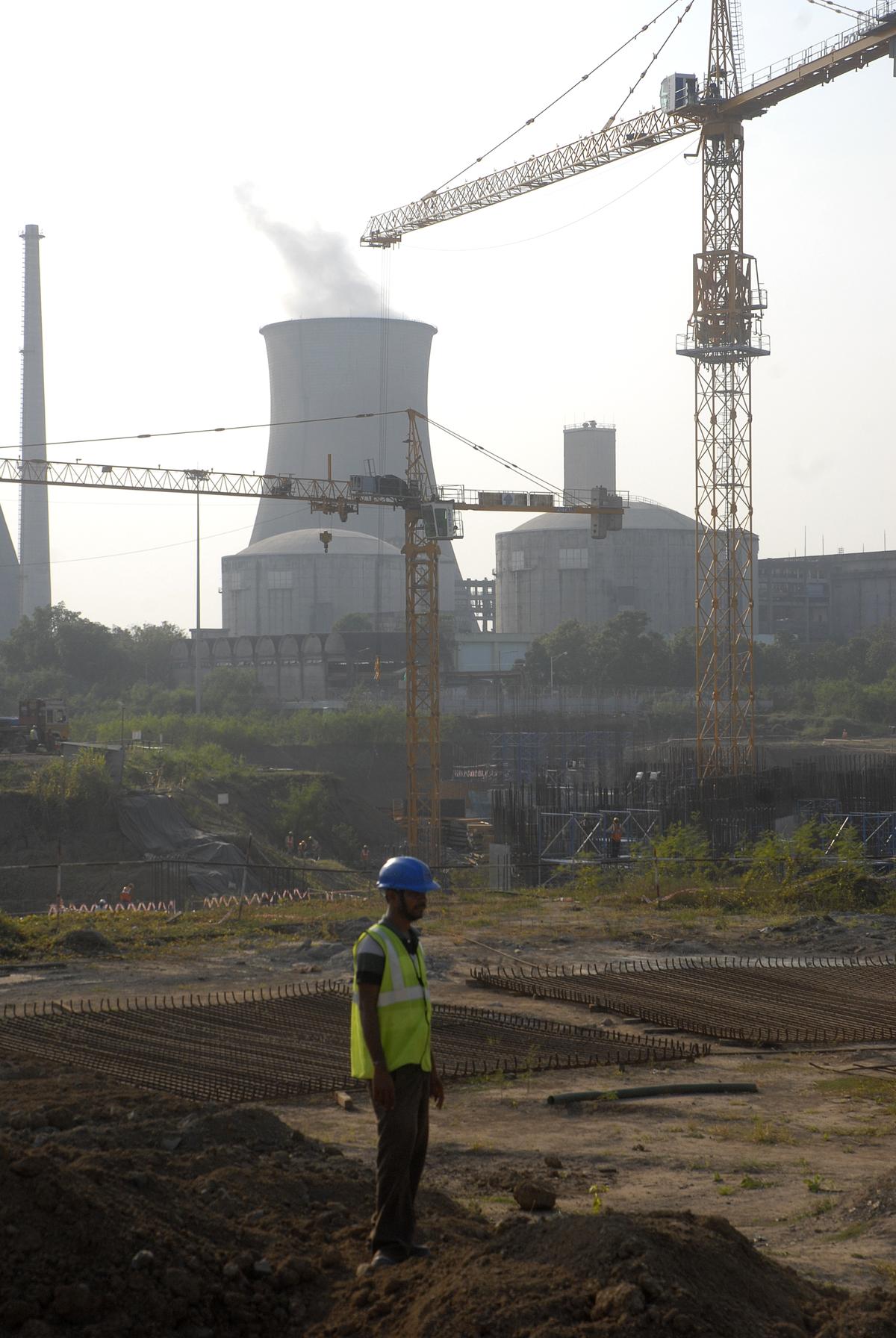
- 08 Jul 2025
In News:
India’s nuclear regulator, the Atomic Energy Regulatory Board (AERB), has granted the Licence for Operation of Units 3 and 4 of the Kakrapar Atomic Power Station (KAPS) in Gujarat — India’s first indigenously developed 700 MWe Pressurised Heavy Water Reactors (PHWRs).
Key Highlights:
- Operational Approval: The AERB concluded multi-stage design and commissioning safety reviews before granting the licence for both reactors.
- KAPS-3: Achieved full-power commissioning in August 2023.
- KAPS-4: Achieved full-power commissioning in August 2024.
- Licence Details:
- Issued on July 3, 2025.
- Valid for a period of five years.
- Granted to the Nuclear Power Corporation of India Limited (NPCIL).
Significance of the Development:
- These reactors are part of India’s first fleet of 700 MWe PHWRs, marking a major milestone in the country’s indigenous nuclear energy capabilities.
- The licensing process involved rigorous multi-tiered safety assessments spanning the full lifecycle:
- Siting
- Construction
- Commissioning
- Full-power operation
- Review was conducted with contributions from AERB and technical support organisations, involving over 15 years of evaluation.
India’s PHWR Progression:
|
Design |
Capacity |
Number |
Remarks |
|
PHWR |
220 MWe |
15 |
Operational |
|
PHWR |
540 MWe |
2 |
Operational |
|
PHWR |
700 MWe |
2 (KAPS-3 & 4) |
Now Licensed |
- The 700 MWe PHWR design is an upgraded version of the 540 MWe model.
- A similar 700 MWe reactor began commercial operation at Rawatbhata (Rajasthan) in March 2025.
Broader Impact:
- The licence is a boost to NPCIL’s fleet-mode approach, which involves building 10 such 700 MWe PHWRs across India.
- It reinforces India’s commitment to self-reliance in nuclear technology under the broader Atmanirbhar Bharat initiative.
- It enhances the nation's ability to meet low-carbon energy targets through domestic nuclear capacity.
National Biobank
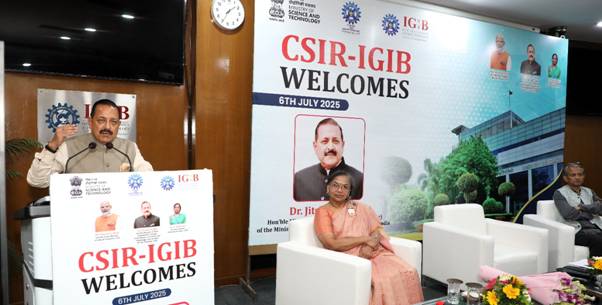
- 08 Jul 2025
In News:
The Union Minister of State (Independent Charge) for Science & Technology recently inaugurated the Phenome India “National Biobank” at the CSIR-Institute of Genomics and Integrative Biology (IGIB).
About the National Biobank:
- The National Biobank will act as the backbone of a nationwide cohort study, aimed at collecting comprehensive genomic, lifestyle, and clinical data from 10,000 individuals across India.
- It is a part of the Phenome India Project, focusing on long-term health tracking of participants over several years.
- Designed to reflect India's diverse geography, ethnicity, and socio-economic backgrounds, it ensures inclusivity in data collection.
- The biobank will enable researchers to:
- Uncover disease patterns and gene-environment interactions.
- Study individual responses to therapies within the Indian population context.
- Aid in early diagnosis and precision medicine, especially for complex diseases like:
- Diabetes
- Cancer
- Cardiovascular disorders
- Rare genetic conditions
Phenome India Project (PI-CheCK):
- Full Name: Phenome India – CSIR Health Cohort Knowledgebase (PI-CheCK)
- Launched by: Council of Scientific and Industrial Research (CSIR) on 7th December 2023
- Objective: To build India-specific risk prediction models for cardio-metabolic diseases, including:
- Diabetes
- Liver diseases
- Cardiac conditions
- Significance: India’s first pan-India longitudinal health monitoring study focused specifically on cardio-metabolic health.
- Sample Cohort: ~10,000 individuals (primarily CSIR employees, pensioners, and spouses) from 17 states and 24 cities.
- Data Collection Includes:
- Clinical questionnaires
- Lifestyle and dietary assessments
- Anthropometric measurements
- Imaging and scanning data
- Extensive biochemical and molecular data
Green Climate Fund

- 07 Jul 2025
In News:
- The Green Climate Fund (GCF) has approved over USD 120 million to support climate adaptation initiatives in Ghana, the Maldives, and Mauritania, with technical development by the UN Environment Programme (UNEP).
- The projects aim to build climate resilience among vulnerable populations through nature-based solutions, climate-resilient agriculture, early warning systems, and water security enhancements.
- These initiatives are critical in delivering adaptation finance to regions like Small Island Developing States (SIDS) and the Sahel, addressing some of the most urgent climate vulnerabilities and are expected to benefit over 3.5 million people.
Project Highlights by Country:
Ghana: Agroecological Resilience in Northern Regions
- Total funding: USD 70 million (USD 63 million GCF grant).
- Objective: Strengthen climate resilience in eight districts across North East, Upper East, and Upper West Ghana.
- Key Interventions:
- Improve access to climate data and early warnings.
- Enable dry-season farming via water storage.
- Restore 28,000 hectares of degraded land to improve water retention and soil health.
- Impact:
- Direct benefits for 619,000 people.
- Early warning systems to reach 2.9 million.
- Improved food security for 120,000 individuals.
- Implementing agencies: Ghana EPA and Ghana Meteorological Agency.
Maldives: Early Warning and Risk Reduction in a SIDS
- Total funding: USD 25 million.
- Project Name: Toward Risk-Aware and Climate-Resilient Communities (TRACT).
- Focus: Expand multi-hazard early warning systems and build national capacity under the Early Warnings for All (EW4All) initiative.
- Risks Addressed: Rising sea levels, storm surges, heatwaves, and coastal erosion threatening agriculture, fisheries, and tourism.
- Impact:
- Coverage for over 500,000 people.
- Special emphasis on remote and marginalized communities, including women and children.
Mauritania: Ecosystem Restoration in the Sahel
- Total funding: USD 33 million (USD 30 million GCF grant).
- Objective: Address desertification, drought, and water scarcity across four vulnerable regions.
- Key Activities:
- Build green-grey infrastructure to stabilize sand dunes.
- Improve water access for farming and land rehabilitation.
- Promote climate-resilient agriculture to reduce food imports.
- Impact:
- 85,000 people to benefit directly; 145,000 indirectly.
- 2,100 hectares of land to be protected.
- Supports the Great Green Wall Initiative—Africa’s flagship response to desertification.
Institutional Roles and Significance:
- The UNEP, as a global leader in environmental governance, has played a key role in contextualizing science-based, locally led climate solutions.
- The GCF, under the Paris Agreement framework, remains the largest international climate fund, supporting countries in implementing their Nationally Determined Contributions (NDCs).
Chautal
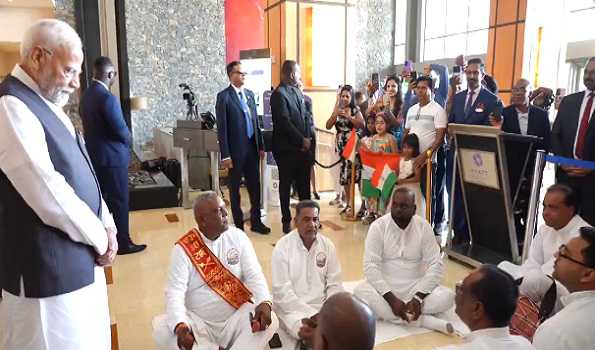
- 07 Jul 2025
In News:
During the recent state visit of the Indian Prime Minister to Trinidad and Tobago, a notable cultural highlight was the performance of the traditional Bhojpuri Chautal, reflecting the deep-rooted Indian heritage in the Caribbean diaspora.
Understanding Chautal
- Chautal (also spelled Chartaal or Chowtaal) is a 12-beat rhythmic cycle (taal) integral to Hindustani classical music.
- It is primarily used to accompany vocal forms such as Dhrupad and Dhamar, as well as instrumental music.
- The term “Chautal” can be interpreted as "four claps", hinting at its vibhag (sectional) structure.
Structural Interpretations:
- One tradition describes it as comprising four vibhags of 4, 4, 2, and 2 beats (matras), respectively.
- An alternative view equates its structure with Ektal, dividing the cycle into six segments of 2 beats each.
Musical Characteristics and Cultural Context
- Chautal is closely associated with the pakhawaj, a barrel-shaped percussion instrument, giving it a powerful and resonant character.
- Unlike the subtle and intricate rhythms of the tabla, Chautal emphasizes strength and gravity in performance.
- Beyond classical settings, Chautal holds cultural significance in Bhojpuri folk traditions, especially during festivals and religious gatherings.
Significance in the Indian Diaspora
The inclusion of Chautal in Trinidad and Tobago’s ceremonial welcome reflects the preservation and celebration of Indian classical and folk arts among overseas Indian communities, particularly those with Bhojpuri ancestry.
Gini Index
- 07 Jul 2025
In News:
According to the World Bank’s Spring 2025 Poverty and Equity Brief, India has emerged as the fourth most equal society globally, with a Gini Index of 25.5—outperforming all G7 and G20 nations. Only the Slovak Republic (24.1), Slovenia (24.3), and Belarus (24.4) rank ahead.
This achievement marks a significant improvement from India’s Gini score of 28.8 in 2011 to 25.5 in 2022, reflecting a steady narrowing of income inequality and growing social equity.
Key Highlights:
Gini Index Comparison (2022-2023):
|
Country |
Gini Index |
|
Slovak Republic |
24.1 |
|
Slovenia |
24.3 |
|
Belarus |
24.4 |
|
India |
25.5 |
|
China |
35.7 |
|
United States |
41.8 |
|
Germany (G7) |
~31.4 |
|
United Kingdom (G7) |
~34.4 |
|
France (G7) |
~32.4 |
|
Japan (G7) |
~32.9 |
Poverty Reduction Achievements:
- 171 million people lifted out of extreme poverty (2011–2023).
- Population living under $2.15/day fell from 16.2% (2011–12) to 2.3% (2022–23).
- Under revised poverty line of $3.00/day, poverty fell to 5.3% in 2022–23.
Drivers of Income Equality:
a) Financial Inclusion:
- Jan Dhan Yojana: Over 55.69 crore bank accounts opened (as of June 2025).
- Enabled Direct Benefit Transfers (DBT), reducing leakages and ensuring targeted welfare.
b) Digital Infrastructure:
- Aadhaar: Over 142 crore issued (as of July 2025), enabling real-time, identity-based service delivery.
- DBT savings: Over ?3.48 lakh crore by March 2023.
c) Universal Healthcare Access:
- Ayushman Bharat: Over 41.34 crore health cards issued.
- Covers ?5 lakh per family/year; now extended to all citizens aged 70+ under Ayushman Vay Vandana.
- Over 32,000 empanelled hospitals ensure access to treatment.
d) Empowerment of Marginalized Communities:
- Stand-Up India: Loans worth ?62,807 crore disbursed to SC/ST and women entrepreneurs.
- PM Vishwakarma Yojana: Nearly 30 lakh artisans registered for credit and marketing support.
Significance for India and the World:
India’s low Gini score demonstrates that economic growth and social equity can be pursued together. The country’s targeted welfare architecture, digital governance tools, and inclusive schemes have created a replicable model for other developing nations.
As global inequality widens, India’s success offers a template for countries seeking to integrate economic reforms with social protection mechanisms to foster inclusive development.
Tokara Islands
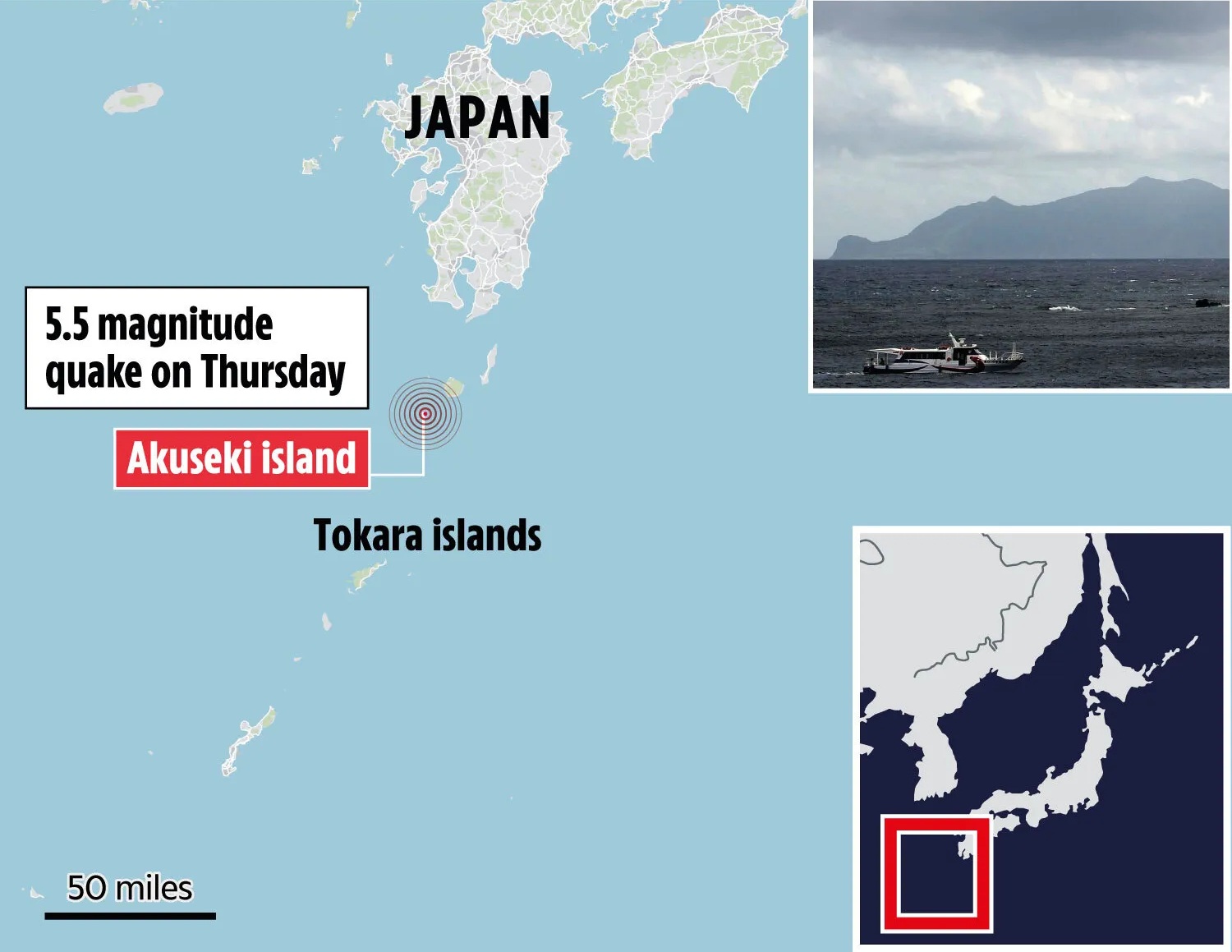
- 07 Jul 2025
In News:
In an unusual seismic episode, over 1,000 earthquakes have struck the Tokara Islands in southern Japan since June 1, 2025, triggering panic, evacuation orders, and heightened concerns about a potential larger earthquake. The persistent tremors—several of which registered magnitudes of 5.5 or higher—have had a significant psychological and logistical impact on the island's residents.
About Tokara Islands:
- Located south of Kyushu and north of the Amami Islands, the Tokara archipelago (also called Toshima Islands) consists of seven inhabited and five uninhabited islands.
- The inhabited islands include Kuchinoshima, Nakanoshima, Suwanosejima, Tairajima, Akusekijima, Kodakarajima, and Takarajima.
- Administered by Toshima Village, it is Japan’s longest village, stretching over 160 km.
- Nakanoshima is the largest and most populated island; it is dominated by Mount Otake (979 m).
- The islands lie in a subtropical-temperate climate zone, receiving around 2,700 mm of rainfall annually.
- Geologically, they are situated in one of the most earthquake-prone zones globally.
Variable Rate Reverse Repo (VRRR)
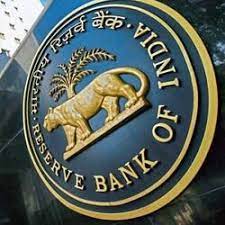
- 07 Jul 2025
In News:
The Reserve Bank of India (RBI) recently carried out a 7-day Variable Rate Reverse Repo (VRRR) auction worth ?1 lakh crore. This measure was taken to manage the surplus liquidity in the banking system, which had surged to approximately ?3.75 lakh crore.
What is VRRR?
The Variable Rate Reverse Repo (VRRR) is a liquidity management tool employed by the RBI to absorb excess funds from commercial banks for a specified period. Unlike the fixed reverse repo rate, the VRRR rate is determined through an auction mechanism, allowing market forces to decide the interest rate.
Key Characteristics:
- Auction-Based Interest Rate: Interest is not fixed but discovered through competitive bidding.
- Time-Bound Operation: Typically conducted for durations like 7, 14, or 28 days.
- Liquidity Management Tool: Helps the RBI withdraw excess liquidity from the financial system.
- Repo Rate Ceiling: The interest rate in VRRR operations cannot exceed the current repo rate.
- Flexible Tenor: RBI may modify the duration of VRRR auctions based on prevailing liquidity conditions.
Objective of VRRR
- To mop up surplus liquidity from the banking system.
- To help regulate short-term interest rates and support effective transmission of monetary policy.
- To foster a market-driven interest rate environment in the short-term interbank market.
How VRRR Functions
- Auction Announcement: RBI declares the amount and duration of the VRRR operation.
- Bid Submission: Banks submit bids with the amount and the interest rate at which they are willing to park funds with RBI.
- Rate Determination: RBI accepts bids at or above the cut-off rate, determined by the auction.
- Interest Earnings: Banks earn interest at the accepted rate over the auction tenure.
Implications of VRRR Operations
- On the Money Market: Tightens liquidity, leading to an uptick in short-term rates such as the call money rate and TREPS.
- On the Bond Market: May cause short-term government and corporate bond yields to rise, increasing borrowing costs.
- On Banks:
- Offers an avenue to earn returns on idle funds, improving short-term profitability.
- Temporarily locks up funds, which may reduce immediate availability for lending or investment.
This mechanism is a vital part of the RBI's toolkit to maintain financial stability and ensure efficient transmission of monetary policy.
3 by 35 Initiative
- 06 Jul 2025
In News:
Amid shrinking official development assistance (ODA) and growing health burdens, the World Health Organization (WHO) has launched the 3 by 35 Initiative—a global call to action to increase taxes on three harmful products: tobacco, alcohol, and sugary drinks. The goal is to raise their real prices by at least 50% by the year 2035, tailored to each country’s context.
Why the Initiative?
- Noncommunicable Diseases (NCDs)—like cardiovascular diseases, cancers, and diabetes—are the leading cause of death and disability worldwide.
- Tobacco use causes over 7 million deaths annually; alcohol and sugary drinks significantly contribute to the global NCD burden.
- Health taxes are a proven strategy to curb harmful consumption while generating domestic revenue for health and development.
Economic Potential:
- A one-time 50% price increase via taxation could generate:
- US$ 3.7 trillion over five years
- ~US$ 740 billion per year (approx. 0.75% of global GDP)
- Estimated to raise US$ 1 trillion in public revenue over the next decade while reducing product consumption.
Key Objectives of 3 by 35:
- Reduce Harmful Consumption:
- Discourage use of tobacco, alcohol, and sugary drinks.
- Mitigate NCDs and associated healthcare costs.
- Mobilize Domestic Revenue:
- Strengthen public financing without reliance on external aid.
- Support progress toward Sustainable Development Goals (SDGs).
- Build Healthier, Resilient Economies:
- Improve economic productivity through healthier populations.
- Channel revenue toward health services, nutrition, and education.
Strategic Actions:
- Mobilize Countries:
- Engage leaders, finance and health ministries, and civil society.
- Provide platforms for peer learning and global recognition.
- Support Country-Led Policies:
- Offer technical support for health tax design, legal reform, and implementation.
- Promote evidence-based, locally tailored solutions.
- Build Commitments and Partnerships:
- Foster multi-sector collaboration and civil society engagement.
- Shift public and political narratives around health taxation.
Governance and Collaboration:
- Led by WHO and supported by:
- National governments
- Civil society and academic institutions
- Development partners and multilateral organizations
C-FLOOD
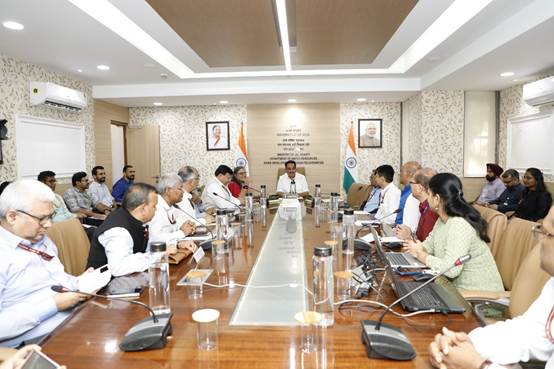
- 06 Jul 2025
In News:
In a significant advancement in disaster risk management, Union Minister of Jal Shakti Shri C.R. Patil inaugurated C-FLOOD, a Unified Inundation Forecasting System. Developed under the National Supercomputing Mission (NSM), C-FLOOD marks a pivotal step toward strengthening India's flood preparedness and mitigation strategy.
What is C-FLOOD?
C-FLOOD is a web-based, real-time flood forecasting platform designed to deliver two-day advance inundation forecasts at village-level resolution. It provides:
- Flood inundation maps
- Water level predictions
- Localized early warnings to support disaster response and planning.
Developing Agencies:
- Centre for Development of Advanced Computing (C-DAC), Pune
- Central Water Commission (CWC)
- National Remote Sensing Centre (NRSC)
Developed in collaboration with the Ministry of Jal Shakti, Ministry of Electronics & IT (MeitY), and Department of Science & Technology (DST).
Key Features:
- 2-Day Village-Level Forecasts: Localized and high-resolution predictions up to the gram panchayat level.
- Advanced 2-D Hydrodynamic Modelling: Simulations run on High-Performance Computing (HPC) systems under NSM.
- Multi-Basin Coverage: Initially operational in the Mahanadi, Godavari, and Tapi river basins, with future expansion planned.
- Unified Data Integration: Combines outputs from national and regional flood models into one platform.
- Disaster Portal Linkage: Designed for integration with the National Disaster Management Emergency Response Portal (NDEM).
- Climate-Adaptive Governance: Supports flood forecasting in regions vulnerable to climate-induced extreme weather events.
Strategic Importance:
- Disaster Risk Reduction: Enables timely warnings, efficient evacuations, and minimizes loss of life and property.
- Scientific & Operational Integration: Bridges hydrological modelling with on-ground responses.
- Supports Viksit Bharat @2047 Vision: Contributes to climate-resilient water governance.
- Promotes Inter-Agency Synergy: Encourages coordination among CWC, C-DAC, NRSC, and disaster management bodies.
Government Directions and Future Path:
During the inauguration, the Union Minister emphasized:
- Wide dissemination of C-FLOOD to enhance public awareness.
- Expansion to all major river basins through comprehensive inundation studies.
- Improved accuracy via satellite data validation and ground-truthing.
- Integration with NDEM for real-time emergency response.
The minister lauded the collaborative spirit of CWC, C-DAC, and NRSC, and reaffirmed the government's commitment to proactive and technology-driven disaster management.
Status of Youth in Agrifood Systems

- 06 Jul 2025
In News:
The Food and Agriculture Organization (FAO) has released the “Status of Youth in Agrifood Systems” report, emphasizing that youth empowerment in agriculture could significantly reduce global unemployment and enhance food security, with the potential to boost global GDP by 1.4% (approx. $1.5 trillion).
Key Insights from the Report:
Declining Youth Engagement in Agriculture:
- The share of youth employed in agrifood systems has dropped from 54% in 2005 to 44%, even though many low-income countries remain heavily dependent on youth labour in agriculture.
Youth NEET Crisis:
- Over 20% of global youth (ages 15–24) are Not in Employment, Education, or Training (NEET).
- Young women are twice as likely to fall into this category compared to men.
- Addressing NEET status, particularly among those aged 20–24, could raise global output, with 45% of potential gains stemming from agrifood-related employment.
Urban-Rural Divide:
- 54% of youth now reside in urban areas, while only 5% of rural youth participate in industrial agrifood systems — posing challenges for future agricultural labour availability.
Climate Vulnerability:
- Around 395 million rural youth live in regions projected to experience reduced agricultural productivity due to climate change and extreme weather events.
Rising Food Insecurity Among Youth:
- Youth facing moderate to severe food insecurity has grown from 16.7% (2014) to 24.4% (2023), with severe impacts in Africa and conflict-affected areas.
FAO’s Strategic Recommendations:
Inquire More:
- Close data gaps related to youth roles in agrifood systems.
- Promote evidence-based, youth-responsive policies.
Include More:
- Ensure youth participation in decision-making at local, national, and international levels.
- Foster inclusive governance for both rural and urban youth.
Invest More:
- Job Creation: Facilitate decent employment opportunities on farms and in agrifood value chains.
- System Modernization: Invest in rural infrastructure, digital tools, and agricultural innovation.
- Resource Access: Improve youth access to land, credit, markets, training, and technology.
- Safe Migration: Develop regulated migration pathways for youth involved in agriculture and related sectors.
Russia recognizes Taliban-led Government in Afghanistan
- 06 Jul 2025
In News:
Russia has become the first nation to officially recognize the Taliban-led Islamic Emirate of Afghanistan, formalizing diplomatic relations with the regime that took control in 2021.
Context and Significance:
- This development comes amid limited international recognition of the Taliban government, which took over Kabul in 2021 after the withdrawal of U.S. and NATO forces.
- Russia’s move could reshape regional diplomacy in Central and South Asia, potentially influencing other neighboring powers like China, Iran, and the UAE, which has also shown warming ties.
- The decision also reflects Russia's strategic interests in counterterrorism cooperation, regional stability, and its broader geopolitical competition with the West.
Profile of Russia
Geographical Overview:
- Continent: Northern Eurasia, straddling both Eastern Europe and Northern Asia
- Area: Approximately 17 million square kilometers, making it the largest country in the world
- Time Zones: Spans across 11 time zones
- Capital City: Moscow
Neighbours and Boundaries:
- Land Borders: Shares land borders with 16 countries—more than any other nation:
- In Europe: Norway, Finland, Estonia, Latvia, Lithuania, Poland (via Kaliningrad), Belarus, Ukraine
- In Asia: Georgia, Azerbaijan, Kazakhstan, Mongolia, China, North Korea
- Maritime Borders:
- United States (via the Bering Strait)
- Japan (via the Sea of Okhotsk)
- Major Mountain Ranges:
- Ural Mountains: Traditional boundary between Europe and Asia
- Caucasus Mountains: Includes Mount Elbrus, Europe’s highest peak
- Altai, Sayan, and Kamchatka ranges in Siberia
- Key Rivers and Lakes:
- Volga River: Longest river in Europe
- Lena, Yenisei, and Ob Rivers: Flow through Siberia into the Arctic Ocean
- Lake Baikal: World’s deepest and oldest freshwater lake
- Lake Ladoga: Largest lake in Europe by area
- Climatic and Vegetation Zones:
- Encompasses tundra, taiga (boreal forest), steppes, and semi-deserts
- Permafrost regions in Siberia restrict infrastructure and habitation
Roll Cloud
- 06 Jul 2025
In News:
A striking atmospheric event unfolded over Portugal’s coastline during a severe European heatwave, where beachgoers and weather enthusiasts witnessed a rare roll cloud. The phenomenon occurred as cooler Atlantic air met the hot, dry continental air, producing a visually stunning and scientifically intriguing cloud formation.
What is a Roll Cloud?
A roll cloud is an uncommon, tube-shaped, low-altitude cloud formation that appears to rotate horizontally along its axis. Unlike funnel clouds, it is not connected to any thunderstorm base or rotating system.
Typical Occurrence Zones:
- Frequently spotted in coastal areas, particularly where oceanic and continental air masses interact
- Notably seen in regions like:
- U.S. Great Plains
- Gulf of Carpentaria, Australia (famous for “Morning Glory” clouds)
- Atlantic coasts of Europe
Formation Mechanism:
- Air Mass Interaction: Roll clouds develop when cool, moist maritime air confronts hot, dry air from land, creating instability.
- Temperature Inversion: A thermal inversion layer traps cooler air beneath a warmer layer, suppressing vertical air movement.
- Gravity Waves: As dense cool air undercuts warm air, it creates gravity waves—oscillations within the lower atmosphere.
- Adiabatic Cooling: The ascending portion of the wave cools rapidly, leading to condensation and cloud formation.
- Detached Structure: The cloud remains independent of any parent cloud system, often forming a long, horizontal roll.
Cloud Characteristics:
- Shape: Long, tubular, and low-lying—can stretch over hundreds of kilometers
- Motion: Appears to roll horizontally like a barrel
- Timing: Often forms during early morning hours
- Orientation: Aligns with low-level wind flow, sometimes influenced by sea breeze or nocturnal land breeze fronts
Why are Roll Clouds important?
- Serve as visual indicators of atmospheric instability and changing weather conditions
- Though not hazardous, they reflect mesoscale meteorological processes
- May signal localized shifts in temperature or wind that could precede storm activity in some environments
- Their presence also highlights the interplay between land-sea thermal contrasts, especially relevant in the context of climate variability
Motor Vehicle Aggregator Guidelines (MVAG) 2025
- 05 Jul 2025
In News:
The Ministry of Road Transport and Highways has released the Motor Vehicle Aggregator Guidelines (MVAG), 2025, updating the 2020 norms to accommodate evolving urban transport trends — including bike taxis, electric vehicles (EVs), and app-based autorickshaws.
Overview
- Legal Basis: Formulated under the Motor Vehicles Act, 1988, MVAG provides the regulatory foundation for digital ride-hailing platforms such as Ola, Uber, and Rapido.
- Issuing Authority: Ministry of Road Transport and Highways, Government of India
Key Provisions of MVAG 2025
Driver Welfare and Remuneration
- Revenue Sharing:
- Drivers using own vehicles must receive minimum 80% of the fare.
- For aggregator-owned vehicles, the share must be at least 60%.
- Insurance Requirements:
- Health cover of ?5 lakh
- Term life insurance of ?10 lakh for each driver
- Skill Enhancement: Drivers in the lowest 5% rating bracket to undergo quarterly training
Passenger Safety and Accountability
- Travel Insurance: Mandatory coverage of ?5 lakh per passenger
- Complaint Resolution:
- Issues must be addressed within 3 working days
- Aggregators must notify passengers of outcomes
- Fare Transparency: Charges apply only from pick-up to drop-off location
Fare Regulation and Surge Pricing
- Base Fare Governance: State governments to decide base fare for each vehicle type
- Dynamic Pricing Limits:
- Aggregators may charge as low as 50% below base fare or up to 2x the base fare cap
- Designed to curb excessive surge pricing and ensure fare predictability
Cancellation Penalties
- Symmetrical Accountability:
- 10% penalty (capped at ?100) for riders or drivers cancelling without valid reason
- Acceptable cancellation grounds must be clearly listed on platforms
Legitimisation of Bike Taxis
- Policy Recognition:
- For the first time, private two-wheelers (non-transport motorcycles) may be used for commercial ride services, pending state-level approval
- Legal clarity for platforms operating in regulatory grey zones
EV Integration and Inclusivity
- EV Adoption Targets: States may enforce annual targets for aggregator fleets to switch to electric vehicles
- Accessible Vehicles Mandate: Aggregators must include vehicles equipped to serve persons with disabilities (Divyangjan)
Enhanced Driver Onboarding Standards
- Screening and Health Protocols: Mandatory police verification, medical fitness, and psychological evaluation before onboarding
- Training Mandates: Induction training for new drivers and annual refresher programs for all
Grievance Redressal & Licensing
- Mandatory Officer Appointment: A Grievance Redressal Officer must be designated with contact details published on the platform
- Centralised Licensing Portal: A unified digital portal to streamline aggregator licensing, renewals, and deposit management
Enforcement and Penalties
- Penalty Range: Fines for non-compliance range from ?1 lakh to ?1 crore
- Escalation for Repeat Offences: Repeat violations can lead to license suspension (up to 3 months) and possible revocation
Significance of MVAG 2025
- Aligns India’s mobility ecosystem with sustainable transport goals, passenger safety, and driver welfare
- Encourages EV transition, inclusive access, and regulated digital transport economy
- Brings regulatory clarity for emerging services like bike taxis
RBI’s New Policy on Pre-Payment Charges
- 05 Jul 2025
In News:
In a move aimed at enhancing fair lending practices and improving access to affordable credit, the Reserve Bank of India (RBI) has prohibited pre-payment penalties on floating-rate loans availed by individuals and Micro and Small Enterprises (MSEs). The new norms will come into effect from January 1, 2026, and will apply to all loans and credit facilities sanctioned or renewed on or after this date.
Key Provisions of the RBI Guidelines
Ban on Pre-Payment Charges:
- Applicable to:
- Individuals taking floating-rate loans for non-business purposes, even with co-borrowers.
- Individuals and MSEs availing business loans.
- Individuals taking floating-rate loans for non-business purposes, even with co-borrowers.
- Lenders prohibited from imposing pre-payment penalties include:
- Commercial Banks (except SFBs, RRBs, Local Area Banks)
- Tier 4 Urban Cooperative Banks
- NBFCs in the Upper Layer (NBFC-UL)
- All India Financial Institutions (AIFIs)
- For smaller institutions like Small Finance Banks, RRBs, Tier 3 Urban Cooperative Banks, State and Central Co-op Banks, and NBFCs in the Middle Layer (NBFC-ML), the exemption from pre-payment charges applies to loans up to ?50 lakh.
Early Closure of Overdraft/Cash Credit:
- If the borrower informs in advance and closes the account on time, no pre-closure charges can be levied.
- If the lender requests prepayment, no charges are permitted in such cases either.
Transparency and Disclosure Requirements
- Lenders must clearly disclose the applicability or non-applicability of pre-payment charges in:
- Sanction letters
- Loan agreements
- Key Facts Statement (KFS) (where applicable)
- Any charges not explicitly disclosed as per these guidelines cannot be imposed.
Pre-Payment Without Lock-in
- Pre-payment (partial or full) can be made without any lock-in period, and irrespective of the source of funds.
Rationale Behind the Move
- The RBI noted that inconsistent practices regarding pre-payment fees have led to customer disputes.
- Ensuring easy and affordable finance for MSEs is “of paramount importance,” the central bank emphasized.
Policy Continuity and Legal Update
- All earlier RBI circulars and guidelines regarding pre-payment charges stand repealed.
- The final guidelines were issued after considering public feedback on the draft circular (February 2025).
Significance for MSEs and Borrowers
- Enhances credit mobility and refinancing freedom for borrowers.
- Prevents penalty-driven disincentives for early loan closure.
- Aligns with the RBI’s broader goal of financial consumer protection and MSME support.
Overseas Citizen of India (OCI)
- 05 Jul 2025
In News:
During his official visit to Trinidad and Tobago, the Prime Minister of India announced a significant policy update: Indian-origin persons up to the sixth generation residing in Trinidad and Tobago will now be eligible for the Overseas Citizen of India (OCI) card.
This move strengthens India's outreach to its diaspora, especially in regions with deep-rooted historical ties dating back to indentured migration.
About Overseas Citizen of India (OCI)
What is OCI?
The OCI card is a form of permanent residency granted to foreign nationals of Indian origin, enabling them to live, work, and travel in India without requiring a visa.
- Introduced: August 2005
- Legal Basis: Citizenship (Amendment) Act, 2005
- Administered by: Ministry of Home Affairs, Government of India
- Objective: To foster long-term engagement between India and its diaspora communities by offering them residency and economic/cultural participation rights—without conferring dual citizenship.
Eligibility Criteria (Section 7A of Citizenship Act, 1955)
An individual is eligible if they are a foreign national who:
- Was a citizen of India on or after 26 January 1950,
- Was eligible for Indian citizenship on that date, or
- Belonged to a territory that became part of India after 15 August 1947
Also eligible:
- Children, grandchildren, or great-grandchildren of eligible persons
- Minor children with one or both parents as Indian citizens
- Spouses of Indian citizens or OCI holders, if marriage has lasted 2+ years
Not eligible if: The individual or their ancestors were ever citizens of Pakistan, Bangladesh, or other countries notified by the Indian government
Key Features of the OCI Card
- Lifelong, multiple-entry visa to India
- No police reporting required, regardless of duration of stay
- Work and study rights similar to Indian citizens (no separate visa needed)
- Economic parity with NRIs in areas such as:
- Education (e.g., admissions, fee structure)
- Financial services and bank accounts
- Real estate (excluding agricultural land)
- Can buy residential and commercial property in India
- Not eligible for:
- Voting rights
- Holding constitutional posts (e.g., President, MP, Judge)
- Government employment
- Digital-friendly: Application, renewal, and status tracking available via the official OCI Portal
Significance of the Latest Announcement
- Extending OCI eligibility to the sixth generation acknowledges the deep historical diaspora links between India and the Caribbean, particularly descendants of indentured laborers.
- This strengthens India's soft power, promotes people-to-people diplomacy, and enhances economic and cultural ties with Indian-origin communities abroad.
India’s First Transgender Clinic
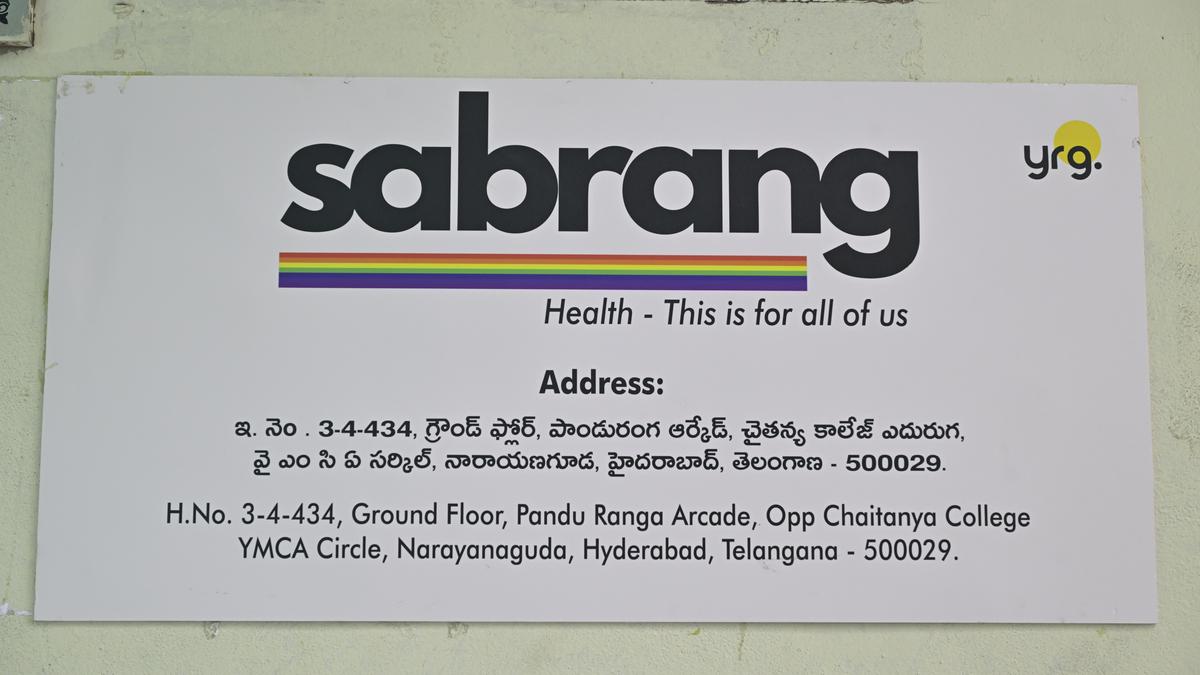
- 05 Jul 2025
In News:
India’s first healthcare facility entirely led and managed by transgender individuals — formerly known as Mitr Clinic — has reopened in Hyderabad under a new name, Sabrang Clinic, after a brief closure in January 2025 due to a USAID funding freeze.
Launched in 2021 in Narayanguda, Mitr Clinic was a pioneering initiative providing trans-affirmative healthcare services, and was notable for being completely staffed by members of the transgender community. Over 3,000 patients were served during its initial phase.
Revival and Funding
- Funding Setback: Operations were suspended in January 2025 following the withdrawal of USAID support.
- Renewed Support: The clinic resumed services in May 2025 after securing three-year funding from Tata Trusts, at a rate of ?1,500 per person per year (compared to ?1,900 under USAID).
- Supporting Partners: Core clinical staff is now funded by Tata Trusts, while senior positions are jointly supported by YRG Care, an NGO associated with the earlier model.
Current Setup and Services
Services Offered:
- General health services
- Counselling and clinical consultations for:
- Hormone Replacement Therapy (HRT)
- Gender Affirmation Surgeries
- Breast Augmentation
- Mental Health
- HIV/STI testing and treatment
- Psychological support
Clinic Team:
- 1 Medical Officer
- 1 Nurse
- 1 Counsellor
- 2 Outreach Workers
Operating Hours: Monday to Saturday, 10 a.m. – 6 p.m.
During the shutdown, the team continued online consultations and medicine delivery, sustaining community outreach until new funding was secured.
Legacy and Policy Impact
- The Telangana Government, inspired by Mitr Clinic’s model, launched Maitri Clinics in all 33 districts, adopting a trans-inclusive healthcare approach.
- While collaboration with State agencies was considered, the Sabrang team opted for independent operation to ensure quicker service resumption and retain community trust.
Expanded Vision: Why ‘Sabrang’?
- The new name, Sabrang (meaning "all colours"), reflects a broader, inclusive healthcare mission.
- It now aims to serve not only transgender persons but also queer, gender-diverse, and other marginalized groups who face similar healthcare barriers.
Chemical Industry – Powering India’s Participation in Global Value Chains
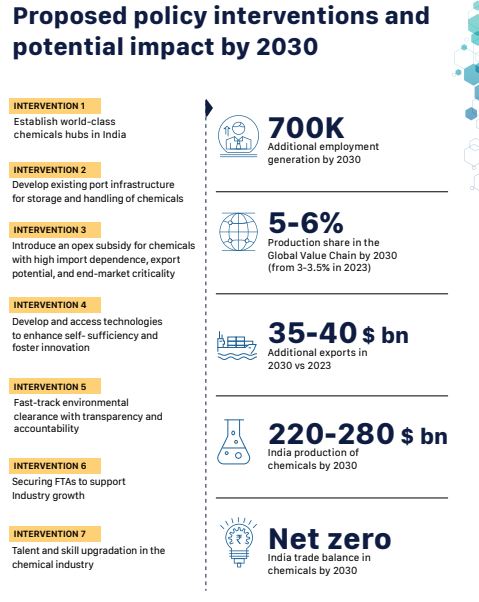
- 05 Jul 2025
In News:
NITI Aayog has released a comprehensive report envisioning India’s transformation into a global chemical manufacturing hub with a projected 12% share in global value chains (GVCs) and USD 1 trillion in output by 2040.
Current Landscape of India’s Chemical Industry
- Significant Economic Contributor: India is the 6th largest chemical producer globally and 3rd in Asia, contributing over 7% to manufacturing GDP. Key linkages: Pharmaceuticals, textiles, agriculture, and construction.
- Fragmented Sector Structure: Dominated by MSMEs, the sector suffers from lack of integrated value chains and modern infrastructure. Example: Cluster-based growth is concentrated in Gujarat, Maharashtra, and Tamil Nadu.
- Low Global Integration: India’s 3.5% share in global chemical value chains reflects weak backward integration and poor export competitiveness. The trade deficit in 2023 was USD 31 billion.
- High Import Dependence: Heavy reliance on China and Gulf countries for feedstocks and specialty chemicals. Example: Over 60% of critical Active Pharmaceutical Ingredients (APIs) are sourced from China.
- Negligible R&D Investment: India invests only 0.7% of industry revenue in R&D, far below the global average of 2.3%, limiting innovation in green and specialty chemicals.
- Regulatory and Procedural Hurdles: Environmental clearance (EC) delays (up to 12–18 months) and procedural bottlenecks lead to cost and time overruns.
- Skilling Deficit:
A 30% shortage of skilled professionals in green chemistry, process safety, and nanotechnology. Example: ITIs and vocational programs lag behind industry requirements.
Emerging Opportunities
- Green Chemistry Revolution: Global shift toward sustainable chemicals presents new market opportunities.
- Geopolitical Realignment: Rising distrust of China globally enables India to emerge as an alternate supplier.
- FTA Leverage: India’s Free Trade Agreements (FTAs) with UAE, EU, and ASEAN can enhance tariff-free access to major markets.
- Make in India Ecosystem: Policy support through PLI schemes, Petroleum, Chemicals and Petrochemicals Investment Regions (PCPIRs), and chemical parks.
- Job Creation Potential: The sector could generate 7 lakh skilled jobs by 2030, particularly in petrochemicals, research, and logistics.
Persistent Challenges
- Feedstock Vulnerability: Over-dependence on crude oil and naphtha imports poses price and supply risks.
- Outdated Industrial Clusters: Legacy clusters lack modern safety systems, storage infrastructure, and waste treatment facilities.
- High Logistics Costs: Freight costs are 2–3 times higher than global averages, reducing export competitiveness.
- Regulatory Complexities: Absence of single-window clearances, frequent policy shifts, and inter-state inconsistencies deter investments.
- Weak Industry-Academia Linkages: Poor collaboration leads to low patent output and limited skill development.
NITI Aayog’s Recommendations
- Develop World-Class Chemical Hubs: Upgrade existing clusters and establish empowered committees. Suggested hubs: Paradeep, Dahej, Vizag. Introduce a dedicated Chemical Infrastructure Fund.
- Opex-Based Incentives: Offer operational subsidies linked to import substitution and export potential.
- Boost Technology Access & R&D:
- Establish an industry-academia interface under the Department of Science and Technology (DST).
- Enable technology transfer from global MNCs.
- Streamline Environmental Clearances:
- Simplify processes via DPIIT audit mechanisms.
- Ensure greater transparency and faster approvals.
- Strengthen Skill Development:
- Expand and modernize ITIs and specialized institutes.
- Introduce tailored courses in polymer science, green chemistry, and process safety.
- Negotiate Chemical-Specific FTAs:
- Incorporate product-specific clauses.
- Simplify rules of origin and documentation processes.
Kolhapuri Chappals

- 04 Jul 2025
In News:
Italian luxury fashion house Prada, after public criticism, has acknowledged that its Men’s Spring/Summer 2026 collection sandals were inspired by India’s traditional handcrafted footwear — the Kolhapuri chappals, a product with Geographical Indication (GI) status.
About Kolhapuri Chappals
Origin:
- Named after Kolhapur city in Maharashtra, India
- Handcrafted tradition dates back to the 13th century
Design & Craftsmanship:
- Made from 100% leather (cow, buffalo, or goat)
- Vegetable-tanned using natural dyes – non-toxic and eco-friendly
- Typicallyopen-toed with a T-strap design
- Traditionally in tan and brown shades with oil, natural, or polish finishes
- Time-intensive craftsmanship – can take up to six weeks per pair
Cultural & Economic Value:
- Recognised under the Geographical Indications (GI) Act of India
- Symbol of sustainable fashion, durability, and local artisanal skill
- Leather molds to feet over time, ensuring custom comfort and longevity
The Controversy: Cultural Appropriation vs Cultural Inspiration
- Criticism emerged after Prada launched sandals resembling Kolhapuris without credit
- Public and media backlash led to acknowledgement of Indian inspiration
- Highlights the importance of:
- Ethical recognition of traditional knowledge and cultural heritage
- Protection of GI-tagged products from unauthorized imitation
- Global awareness of India’s artisanal heritage
Financial Stability Report – June 2025
- 04 Jul 2025
In News:
The Reserve Bank of India (RBI) recently released the Financial Stability Report for June 2025.
What is the Financial Stability Report (FSR)?
- The Financial Stability Report (FSR) is a biannual publication by the Reserve Bank of India (RBI).
- It presents the collective assessment of the Sub-Committee of the Financial Stability and Development Council (FSDC-SC) regarding:
- Resilience of the Indian financial system
- Emerging systemic risks
- Outlook for macro-financial stability
Key Highlights – FSR June 2025
Macroeconomic & Global Outlook
- India remains a key driver of global growth, supported by strong macroeconomic fundamentals and prudent policies.
- Risks to growth include:
- Prolonged geopolitical tensions
- Trade and supply chain disruptions
- Weather-related uncertainties impacting agricultural output
Banking Sector Performance
- Gross Non-Performing Asset (GNPA) ratio:
- Stands at 2.3% as of March 2025, a multi-decadal low
- May rise modestly to 2.5% in baseline and 2.6% under adverse conditions by March 2027 (based on stress tests on 46 banks covering 98% of SCB assets)
- Capital Adequacy Ratios (CAR):
- Remain well above regulatory thresholds across the sector
- Even under severe stress scenarios, banks maintain adequate buffers — indicating robust financial health
Non-Banking Financial Companies (NBFCs)
- NBFCs are in good financial health with:
- Strong capital buffers
- Robust earnings
- Improving asset quality
- Continued financial resilience contributes to the overall stability of the financial system
Domestic Demand and Inflation Outlook
- Growth remains domestically driven
- Food inflation outlook favorable:
- Price moderation observed
- Crop output at record levels, supporting price stability
Significance for Financial Policy
- The report signals that India’s financial institutions are resilient and well-equipped to absorb economic shocks
- RBI's stress-testing framework confirms systemic soundness
- Reinforces India's investor confidence, especially in volatile global conditions
Research Development and Innovation (RDI) Scheme
- 04 Jul 2025
In News:
The Union Cabinet, chaired by the Prime Minister, has approved the Research Development and Innovation (RDI) Scheme with a corpus of ?1 lakh crore to strengthen India’s innovation ecosystem and boostprivate sector R&D investments.
Objective of the RDI Scheme
The scheme is designed to:
- Provide long-term financing or refinancing at low or nil interest rates
- Stimulate private sector investment in R&D and innovation
- Overcome existing funding challenges for private research
- Support sunrise and strategic sectors to drive:
- Innovation
- Technology adoption
- National competitiveness
- Economic security and self-reliance
Key Aims
- Encourage private sector participation in high-TRL (Technology Readiness Level) R&D projects
- Fund transformative innovation in sunrise domains
- Enable acquisition of critical and strategic technologies
- Facilitate the establishment of a Deep-Tech Fund of Funds (FoF)
Funding Structure
The RDI Scheme will operate on a two-tiered funding mechanism:
First Tier: Special Purpose Fund (SPF) under ANRF
- Housed within the Anusandhan National Research Foundation (ANRF)
- Acts as the primary custodian of funds
Second Tier: Fund Allocation & Disbursal
- SPF will allocate funds to multiple 2nd-level fund managers
- Mode of financing:
- Long-term concessional loans (low or nil interest)
- Equity financing, particularly for startups
- Contributions to Deep-Tech Fund of Funds (FoF) or other RDI-focused FoFs
Governance & Implementation
- Governing Board of ANRF (chaired by the Prime Minister): Provides strategic direction
- Executive Council (EC) of ANRF:
- Approves scheme guidelines
- Recommends fund managers
- Determines project types and sectors
- Empowered Group of Secretaries (EGoS):
- Led by the Cabinet Secretary
- Approves scheme changes, sectors, fund managers
- Monitors performance of the scheme
- Nodal Department:Department of Science and Technology (DST) is the nodal ministry for implementation.
Employment Linked Incentive (ELI) Scheme
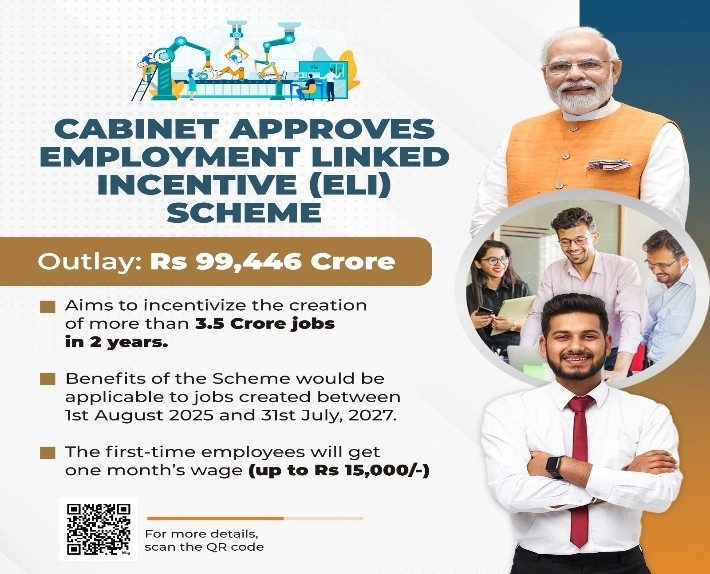
- 04 Jul 2025
In News:
The Employment Linked Incentive (ELI) Scheme is a flagship initiative of the Government of India aimed at formal job creation, especially for youth and in the manufacturing sector. It was announced in the Union Budget 2024–25 and came into implementation following cabinet approval.
Recent Update (July 2025 Cabinet Decision)
- EPFO registrationand Aadhaar seeding deadline:30 June 2025
- Job coverage period:1 August 2025 – 31 July 2027
Objectives
- Promote formal employment by incentivising employers
- Encourage first-time EPFO registration for workers
- Target high employment-generating sectors like manufacturing
- Provide direct income support and EPFO reimbursement subsidies
Key Components – 3 Schemes under ELI
|
Scheme |
Focus |
Key Beneficiaries |
Duration |
Central Outlay |
Estimated Beneficiaries |
|
Scheme A |
First-time employment |
New EPFO-enrolled youth |
3 years |
?23,000 crore |
210 lakh |
|
Scheme B |
Job creation in manufacturing |
Employers hiring ≥50 non-EPFO workers |
6 years |
?52,000 crore |
30 lakh |
|
Scheme C |
Support to employers |
All employers creating net new jobs |
6 years |
?32,000 crore |
50 lakh |
Detailed Scheme Benefits & Conditions
Scheme A: First-Time Employment
- Direct cash benefit: ?15,000 (?7,500 x 2 instalments)
- 1st installment: After 6 months of continuous EPFO-linked employment
- 2nd installment: After 12 months + completion of financial literacy course
- Condition: Exit before 12 months = employer must refund benefit
Scheme B: Job Creation in Manufacturing
- Eligibility: Employer must have 3-year EPFO record; hire ≥50 non-EPFO or 25% baseline
- Salary cap for subsidy: ?25,000/month (overall salary ≤ ?1 lakh)
- Incentive structure:
- Year 1: 24% of salary (employee + employer EPFO contribution)
- Year 2: 24%
- Year 3: 16%
- Year 4: 8%
- Refund clause: If employee leaves before 12 months
Scheme C: Support to Employers
- Eligibility:
- Employers with <50 workers: Hire ≥2 net new
- ≥50 workers: Hire ≥5 net new
- Subsidy per employee/month:
- ?1,000 (salary ≤ ?10,000)
- ?2,000 (?10,001–?20,000)
- ?3,000 (?20,001–?1 lakh)
- Duration: 2 years, extendable to 4 years for large job creators
Eligibility Criteria
- Employees:
- Salary < ?1 lakh/month
- Must be EPFO-registered with Aadhaar–UAN–bank linkage
- Employers:
- Must create net new jobs over EPFO baseline
- For Scheme B: 3-year EPFO record required
Application Process (Current Status)
- No dedicated ELI portal yet
- Via EPFO portal:
- UAN activation and Aadhaar seeding
- Employer-led EPFO registration
- Completion of Financial Literacy Course (for Scheme A)
Significance
- Reduces informal employment
- Supports youth entering formal jobs for the first time
- Incentivises hiring in labour-intensivemanufacturing
- Promotes EPFO inclusion and financial literacy
Challenges
- Compliance burden on small enterprises
- Ensuring retention to avoid refund liabilities
- Monitoring duplication between schemes
- Delay in scheme-specific digital portal rollout
E-Voting System

- 04 Jul 2025
In News:
For the first time in India, e-voting through a mobile app was used in the Bihar municipal elections (June 28, 2025) for six municipal councils in Patna, Rohtas, and East Champaran districts.
About the E-Voting System
- App Used:E-SECBHR, developed by Centre for Development of Advanced Computing (C-DAC)
- Target Groups:
- Senior citizens
- Persons with disabilities
- Pregnant women
- Others unable to reach polling booths
How It Works
- Installation: App available for Android users.
- Registration: Voter must link mobile number as per the electoral roll.
- Verification: Through voter ID number and facial recognition.
- Voting: Vote via app or Bihar Election Commission’s website on polling day.
Security Measures to Ensure Fairness
- Limited Logins: One mobile number can be used by only two registered voters.
- Facial Recognition: Used to verify identity during login and voting.
- Blockchain Technology:
- Ensures immutability of vote data.
- Prevents tampering or alteration of records.
National Turmeric Board Inaugurated in Telangana
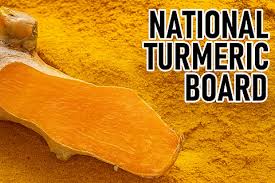
- 03 Jul 2025
In News:
The Union Home Minister inaugurated the headquarters of the National Turmeric Board in Nizamabad, Telangana, addressing a long-standing 40-year demand of turmeric farmers in the region.
About the National Turmeric Board (NTB):
- Established by: Government of India
- Status: Statutory body
- Location:Headquartered in Nizamabad, Telangana – popularly known as the "Turmeric Capital of India"
Administrative Oversight:
- Functions under the Ministry of Commerce and Industry
- Operates in coordination with the Ministries of AYUSH, Agriculture, Pharmaceuticals, and Cooperation
Governing Composition:
- Chairperson appointed by the Central Government
- Secretary from the Department of Commerce
- Members from:
- Relevant central ministries
- Turmeric-producing states (e.g., Telangana, Maharashtra, Meghalaya)
- Farmer groups, exporters, and research institutions
Objectives of the Board:
- Promote value addition, branding, and marketing of turmeric products
- Ensure better prices to farmers by reducing intermediaries
- Promote global recognition of turmeric’s medicinal value
- Upgrade logistics and quality infrastructure to meet global standards
- Support training, research, and skill development in turmeric cultivation and utilization
Key Functions:
- Develop an end-to-end export ecosystem for turmeric
- Promote GI-tagged organic turmeric in international markets
- Ensure compliance with global food and safety standards
- Coordinate with the Spices Board, National Cooperative Exports Ltd., and other cooperatives for export promotion
Turmeric in India: An Overview
Botanical Information:
- Scientific Name:Curcuma longa
- A rhizomatous herbaceous plant, valued for its use in cooking, dyeing, and traditional medicine
- Commonly known as the "Golden Spice"
Agro-Climatic Conditions:
- Grown in tropical climates, requires 20–30°C temperature and high rainfall
- Prefers well-drained loamy soils
- Cultivated under both rain-fed and irrigated conditions
Production and Exports (2022–23):
- Area under cultivation: 3.24 lakh hectares
- Total production: 11.61 lakh tonnes
- India's global share: Over 75% of world turmeric production
- Varietal diversity: Over 30 indigenous varieties cultivated
- Exports: 1.53 lakh tonnes valued at USD 207.45 million
- Target: USD 1 billion in turmeric exports by 2030
- Top export destinations:Bangladesh, UAE, USA, Malaysia
CRISPR-Based Gene Switch for Climate-Resilient Agriculture
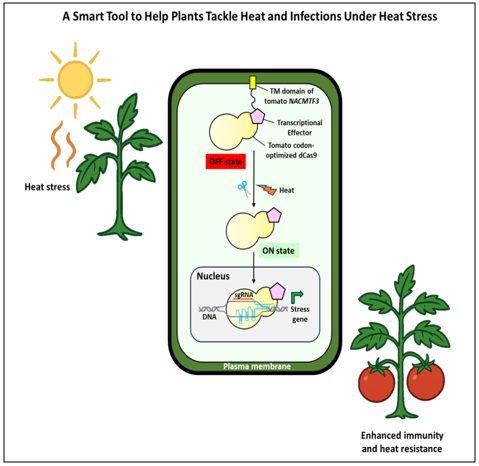
- 03 Jul 2025
In News:
Scientists at the Bose Institute, Kolkata, under the Department of Science and Technology (DST), have developed a modified CRISPR-based molecular tool to enhance plant resilience against heat stress and bacterial infections. The research is published in the International Journal of Biological Macromolecules.
What is the Innovation?
- The tool is a modified version of the CRISPR system called dCas9 (dead Cas9), which does not cut DNA.
- Instead, it functions as a stress-responsive gene switch, turning defense and heat-tolerance genes on or off only when the plant is under stress (e.g., high temperature or pathogen attack).
How Does It Work?
- The switch is held outside the plant cell’s nucleus using a tomato-derived protein domain (NACMTF3 TM domain).
- Under stress conditions, such as heat waves or bacterial infection, the tether is released.
- The dCas9 switch then enters the nucleus, activating genes that help the plant combat the stress.
Key Functional Genes Activated:
|
Gene |
Function |
|
CBP60g, SARD1 |
Activate immune response to bacterial infection (e.g., Pseudomonas syringae) |
|
NAC2, HSFA6b |
Enhance heat tolerance, retain water, and improve overall health |
Salient Features of the Tool:
- Non-invasive: Unlike traditional CRISPR, this version does not edit the DNA, making it safer and more acceptable.
- Energy-efficient: The switch is activated only when needed, minimizing unnecessary energy use by the plant.
- Dual Protection: Shields plants from both heat stress and pathogenic infections.
- Eco-friendly and crop-compatible: Based on naturally occurring proteins, tested successfully in tomato, potato, and tobacco.
Significance and Impact:
- Climate-Resilient Agriculture: Helps plants survive in rising temperatures and unpredictable weather.
- Food Security: Boosts productivity in solanaceous crops like tomato, potato, brinjal, and chilli.
- Smart Farming Solution: Offers a model for sustainable and precision agriculture globally.
- Global Applicability: Can be adapted to other food crops affected by climate change and disease outbreaks.
Hong Kong International Convention (HKC)
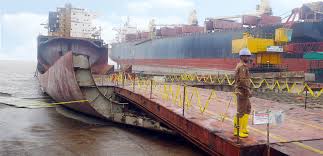
- 03 Jul 2025
In News:
The Hong Kong International Convention (HKC) for the safe and environmentally sound recycling of ships officially came into force on June 26, 2025.
About HKC:
- The HKC is a global treaty adopted under the aegis of the International Maritime Organization (IMO) to regulate the safe and environmentally sustainable recycling of ships that have reached the end of their operational life.
Objectives:
- Protect human health, especially that of shipbreaking workers.
- Prevent environmental pollution during ship dismantling.
- Control and manage hazardous materials such as asbestos, heavy metals, and hydrocarbons.
- Ensure safe waste handling and disposal practices in recycling yards.
Key Provisions:
- Inventory of Hazardous Materials (IHM):Ships must maintain an IHM listing all hazardous substances on board.
- Ship Recycling Plan (SRP):A certified SRP must be approved before the ship is sent for dismantling.
- Recycling Completion Certificate:Recycling facilities must issue this certificate within 14 days of dismantling completion.
- Third-Party Audits and Certification:Classification societies recognized by the IMO will conduct compliance audits and issue relevant certifications.
- Authorized Recycling Yards:The convention promotes the use of regulated and approved facilities for ship recycling to ensure compliance with international safety and environmental norms.
Significance:
- Strengthens global maritime safety and sustainable shipbreaking practices.
- Encourages modernization and regulation of recycling yards, especially in developing countries like India and Bangladesh.
- Aligns ship recycling with UN Sustainable Development Goals (SDGs), particularly those on health, environment, and decent work.
Operation Deep Manifest
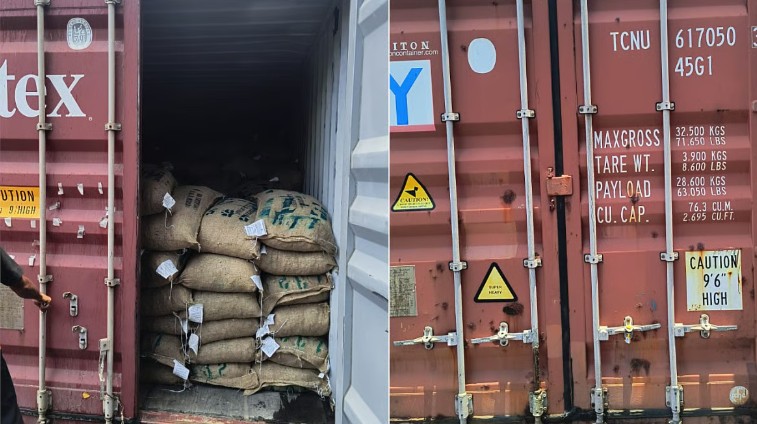
- 03 Jul 2025
In News:
The Directorate of Revenue Intelligence (DRI), under the Central Board of Indirect Taxes and Customs (CBIC), Ministry of Finance, launched “Operation Deep Manifest”, resulting in the seizure of Pakistani-origin goods worth ?9 crore.
Key Highlights:
- Seizure Details:39 containers carrying 1,115 metric tonnes of goods—primarily dry dates—were intercepted at Nhava Sheva Port. These goods were falsely declared as originating from the UAE.
- Route Manipulation:The consignments were illicitly routed via Dubai’s Jebel Ali Port after being shipped from Karachi, Pakistan, to obscure their true origin. Shipping documents were falsified and containers were switched during transshipment to evade detection.
- Violation of Policy:This seizure comes after India’s comprehensive ban on Pakistani-origin goods, which took effect on May 2, 2025, following the Pahalgam terror attacks. This replaced the earlier 200% customs duty imposed post-Pulwama (2019) and represents a zero-tolerance economic policy toward Pakistan.
- Financial and Security Links:Investigations uncovered financial linkages with Pakistani and UAE-based entities, pointing to an organized smuggling network with possible illicit financial flows and national security implications.
- Enforcement Action:A partner from one of the importing firms was arrested on June 26, and further criminal and financial investigations are ongoing.
Significance:
- National Security:Helps prevent economic infiltration from hostile states and curbs funding channels that could support anti-national activities.
- Trade Compliance:Acts as a deterrent against third-country transshipment—a common method to bypass sanctions or import bans.
- Tech-Driven Enforcement:Utilized document forensics, data analytics, and container surveillance to detect misdeclarations and track suspect cargo routes.
- Reinforces Policy Posture:Strengthens India's position of economic disengagement with Pakistan in response to cross-border terrorism.
Cell Broadcast System

- 03 Jul 2025
In News:
The Department of Telecommunications (DoT), in collaboration with the National Disaster Management Authority (NDMA), is piloting a Cell Broadcast (CB) system to enhance emergency communication and deliver real-time disaster alerts across India.
What is the Cell Broadcast System?
Cell Broadcasting is a telecommunication technology that enables mobile network operators to send geographically targeted text alerts to all mobile devices in a specific area. Unlike traditional SMS, CB messages are broadcast simultaneously to all phones within a cell tower’s coverage, ensuring instant delivery even during network congestion.
Key Features and Benefits:
- Instantaneous alerts during emergencies like earthquakes, tsunamis, lightning strikes, and industrial disasters.
- Indigenously developed by the Centre for Development of Telematics (C-DOT).
- Language inclusivity: Messages can be broadcast in multiple Indian languages.
- Particularly effective in high-density areas and during network overloads.
Integration with Existing Systems:
This CB system complements the existing Integrated Alert System (SACHET), which:
- Has delivered over 6,899 crore SMS alerts.
- Covers all 36 States and Union Territories.
- Supports 19 Indian languages.
- Is based on the Common Alerting Protocol (CAP) as recommended by the International Telecommunication Union (ITU).
Once fully deployed, the Cell Broadcast system will strengthen India’s disaster preparedness, ensuring wider, faster, and more inclusive dissemination of critical alerts.
Magnetic Resonance-guided Focused Ultrasound (MRgFUS) technology
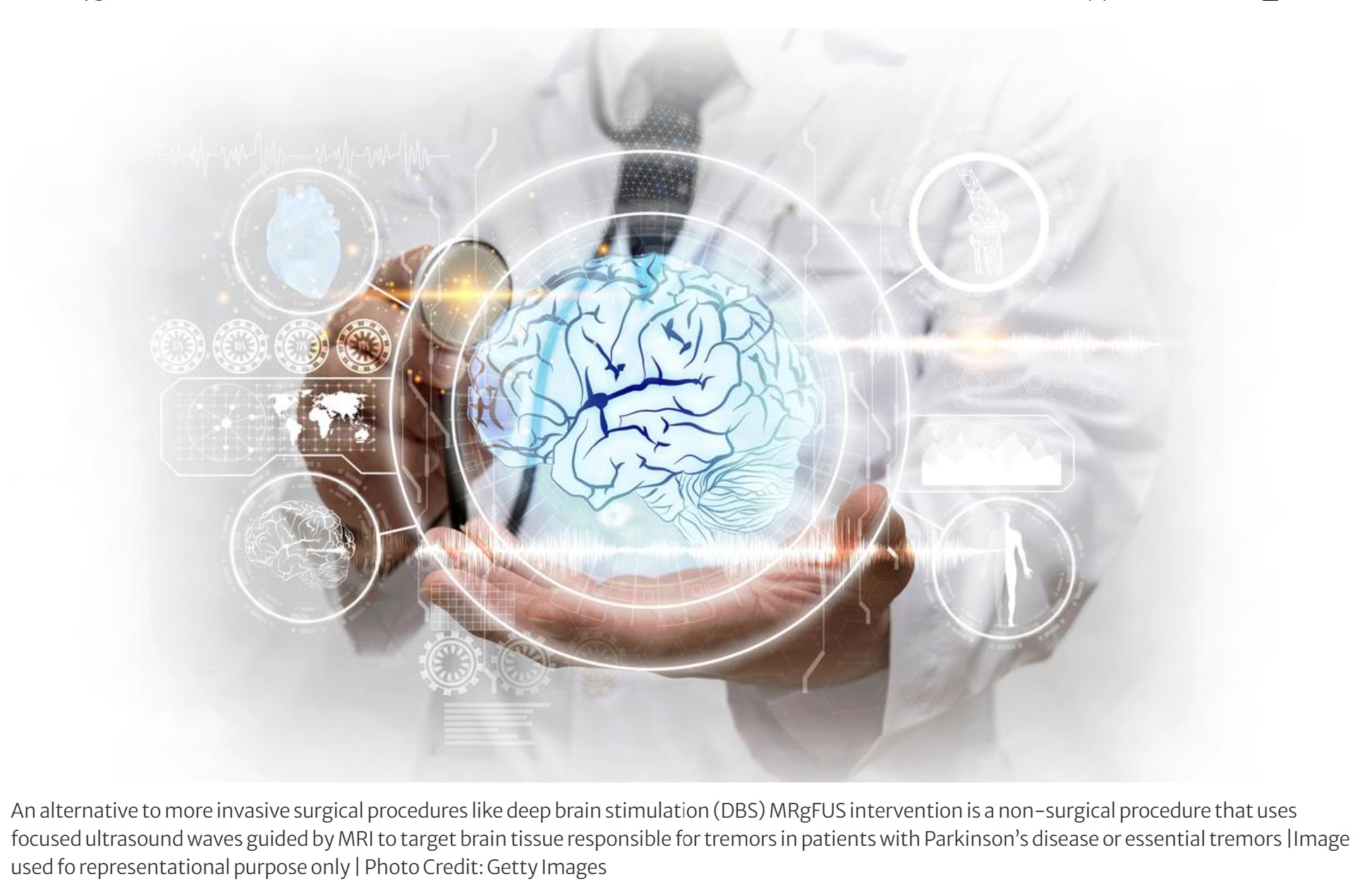
- 02 Jul 2025
In News:
India has recently introduced Magnetic Resonance-guided Focused Ultrasound (MRgFUS) technology, marking a significant advancement in non-invasive neurological treatment. This technique is now being offered in select hospitals, providing new hope for patients suffering from Essential Tremor (ET) and Tremor-Dominant Parkinson’s Disease (TD-PD) — two common but debilitating neurological disorders.
What is MRgFUS?
MRgFUS is a non-surgical, incisionless medical intervention that uses high-intensity focused ultrasound energy, guided by real-time MRI, to target and ablate precise regions of brain tissue responsible for tremors, especially in the thalamus, a key brain relay centre.
Unlike traditional procedures like Deep Brain Stimulation (DBS) that require surgery and implants, MRgFUS is performed without any cuts or anaesthesia and allows immediate symptom relief with minimal recovery time.
Key Features of MRgFUS
- Incisionless procedure: No need for surgical opening of the skull
- MRI-guided precision: Real-time monitoring and adjustment
- Rapid recovery: Hospital stay of 1–2 days
- No implants or batteries: One-time treatment
- Immediate results: Visible tremor relief during the procedure itself
Medical Significance
Essential Tremor (ET):
- Affects ~1% of global population
- Incidence increases with age: ~5% of people over 60
- Not life-threatening but impairs daily life — eating, writing, speaking
- Leads to social isolation, anxiety, and functional disability
MRgFUS offers a safe, effective, and non-invasive solution for patients who are unwilling or unfit for brain surgery.
Availability in India
MRgFUS has been introduced in several advanced medical centres:
- Sir Ganga Ram Hospital, Delhi – First private hospital in North India to offer the procedure
- AIIMS, Delhi – First government institution to adopt it
- Royal Care Super Speciality Hospital, Coimbatore – Pioneer centre in India
- KIMS Hospitals, Telangana
As of mid-2025, over 200 patients in India have undergone the procedure successfully, with more than 25,000 globally.
Cost and Duration
- Procedure Cost: ?19–23 lakh
- Duration: 1–3 hours
- Performed by: A multidisciplinary team of neurologists, neurosurgeons, and neuroradiologists
Global Context and Technological Backing
- Insightec, a global leader in MRgFUS technology, is facilitating its expansion in India.
- The company is also exploring new clinical applications for the same technology in other neurological disorders beyond ET and Parkinson’s.
India Energy Stack (IES)
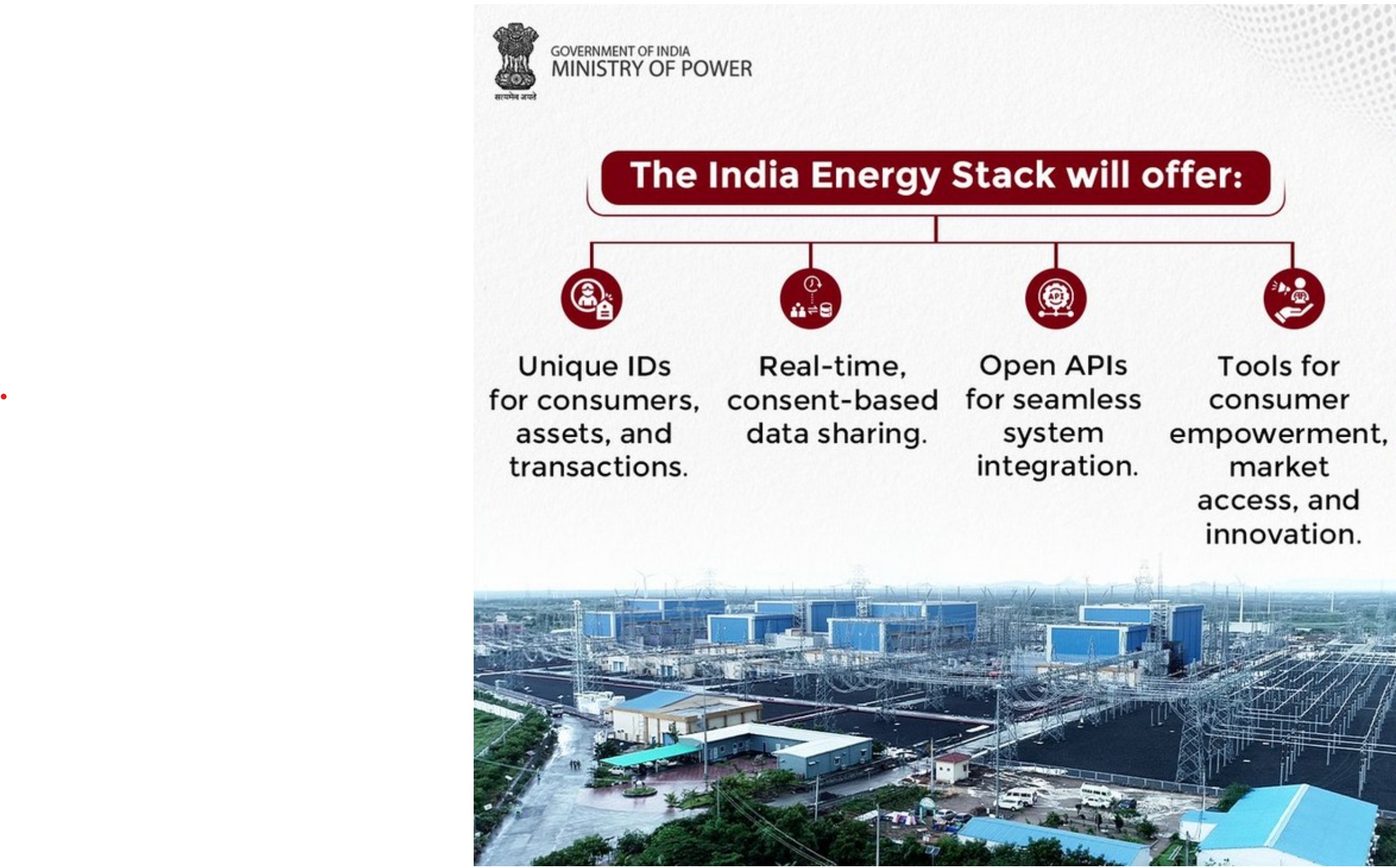
- 02 Jul 2025
In News:
In a transformative move aimed at digitising India’s power sector, the Ministry of Power has announced the conception of the India Energy Stack (IES) — a Digital Public Infrastructure (DPI) initiative designed to build a unified, secure, and interoperable digital ecosystem across the energy value chain.
This effort aligns with India’s goals of achieving a $5 trillion economy and meeting its Net Zero commitments, while addressing the growing complexities of a rapidly evolving energy landscape marked by renewables, electric vehicles, and consumer-centric markets.
What is India Energy Stack (IES)?
The India Energy Stack is envisioned as a standardised, open, and secure digital infrastructure to:
- Streamline operations in the power sector
- Empower consumers with access to real-time, consent-based data
- Integrate renewable energy into the national grid
- Enhance the efficiency of Distribution Companies (DISCOMs)
The initiative is spearheaded by the Ministry of Power, drawing inspiration from successful DPI models like Aadhaar (identity) and UPI (digital payments).
Core Features of IES
- Unique IDs: Assigned to consumers, assets, and energy transactions
- Real-time Data Sharing: Consent-based access for secure and accountable data exchange
- Open APIs: Enabling seamless integration across utility systems and third-party applications
- Consumer Empowerment Tools: Market access platforms, billing transparency, demand response options, and innovation support
- Interoperability: Standardised protocols for all stakeholders in the electricity ecosystem
Implementation Strategy
1. Proof of Concept (PoC) – 12 Months
A year-long pilot phase will test the India Energy Stack using real-world scenarios in partnership with selected utilities and DISCOMs.
2. Utility Intelligence Platform (UIP)
The UIP is a modular, analytics-driven application built on the India Energy Stack. It aims to:
- Provide real-time insights to utilities, policymakers, and regulators
- Enable smart energy management
- Enhance decision-making for grid operations and consumer services
3. Pilot Regions
The PoC will be conducted in collaboration with DISCOMs in:
- Mumbai
- Gujarat
- Delhi
Institutional Framework
- A dedicated Task Force has been established by the Ministry of Power.
- It includes experts from:
- Technology domain
- Power sector operations
- Regulatory bodies
- The Task Force will guide:
- System architecture design
- Pilot implementation
- National scale-up strategy
Expected Outcomes
- India Energy Stack White Paper for public consultation
- UIP deployment in pilot cities
- National roadmap for phased rollout of IES across all states and UTs
- Improved grid stability, energy access, and transparency in service delivery
- Enhanced integration of renewable energy sources into the mainstream grid
Significance for India’s Power Sector
The India Energy Stack has the potential to be a game-changer for the power sector, enabling:
- Modernisation of legacy systems
- Digital empowerment of consumers
- Efficient energy trading and billing
- Decentralised and democratised power governance
As India undergoes its green energy transition, IES will serve as the digital spine supporting clean, accountable, and consumer-centric power distribution.
At Sea Observer Mission

- 02 Jul 2025
In News:
In a major milestone for regional security, the QUAD nations — India, Japan, the United States, and Australia — have launched their first-ever 'At Sea Observer Mission'. This cross-embarkation initiative, conducted under the Wilmington Declaration, seeks to deepen maritime interoperability, operational coordination, and domain awareness in the Indo-Pacific region.
This move signifies the QUAD’s growing shift from diplomatic coordination to practical maritime collaboration, in line with the vision outlined at the QUAD Leaders’ Summit in September 2024.
Key Features of the At Sea Observer Mission
- Participating Nations: India, Japan, USA, and Australia — the four QUAD countries.
- Agencies Involved:
- Indian Coast Guard (ICG)
- Japan Coast Guard (JCG)
- United States Coast Guard (USCG)
- Australian Border Force (ABF)
- Vessel Involved:USCGC Stratton (US Coast Guard Cutter) currently en route to Guam.
- Observer Teams: Two officers from each country, including women officers, embarked for the mission.
- Format:Cross-embarkation, where officers from different countries are hosted on board a partner nation's ship to enable firsthand operational learning.
Objectives and Strategic Relevance
- Strengthening Maritime Security
- Promotes collective surveillance, intelligence sharing, and maritime law enforcement.
- Enhances preparedness against common threats such as illegal fishing, piracy, smuggling, and disaster response.
- Boosting Interoperability and Coordination
- Lays groundwork for real-time joint operations and coordinated patrols.
- Encourages standardization of practices and communication protocols across QUAD navies and coast guards.
- Upholding the Rules-Based Order: Reinforces commitment to a Free, Open, Inclusive, and Rules-Based Indo-Pacific, countering unilateral actions and grey-zone threats in the region.
Indian Perspective: SAGAR and IPOI
India’s participation in the mission reflects its broader strategic vision of SAGAR (Security and Growth for All in the Region). It also aligns with India’s leadership in the Indo-Pacific Oceans Initiative (IPOI), particularly in the pillars of:
- Maritime Security
- Capacity Building and Resource Sharing
- Disaster Risk Reduction and Management
- Maritime Ecology and Maritime Resources
India's active role demonstrates its commitment to multilateral maritime cooperation, gender inclusivity, and regional stability.
Long-Term Implications: Toward a 'QUAD Coast Guard Handshake'
The ‘At Sea Observer Mission’ represents a foundation for the future institutionalisation of QUAD maritime security cooperation, informally dubbed the ‘QUAD Coast Guard Handshake.’ This aims to:
- Foster trust and operational familiarity
- Improve collective resilience against emerging maritime challenges
- Create a responsive, inclusive, and rule-abiding Indo-Pacific maritime domain
Space-Based Surveillance-III Programme
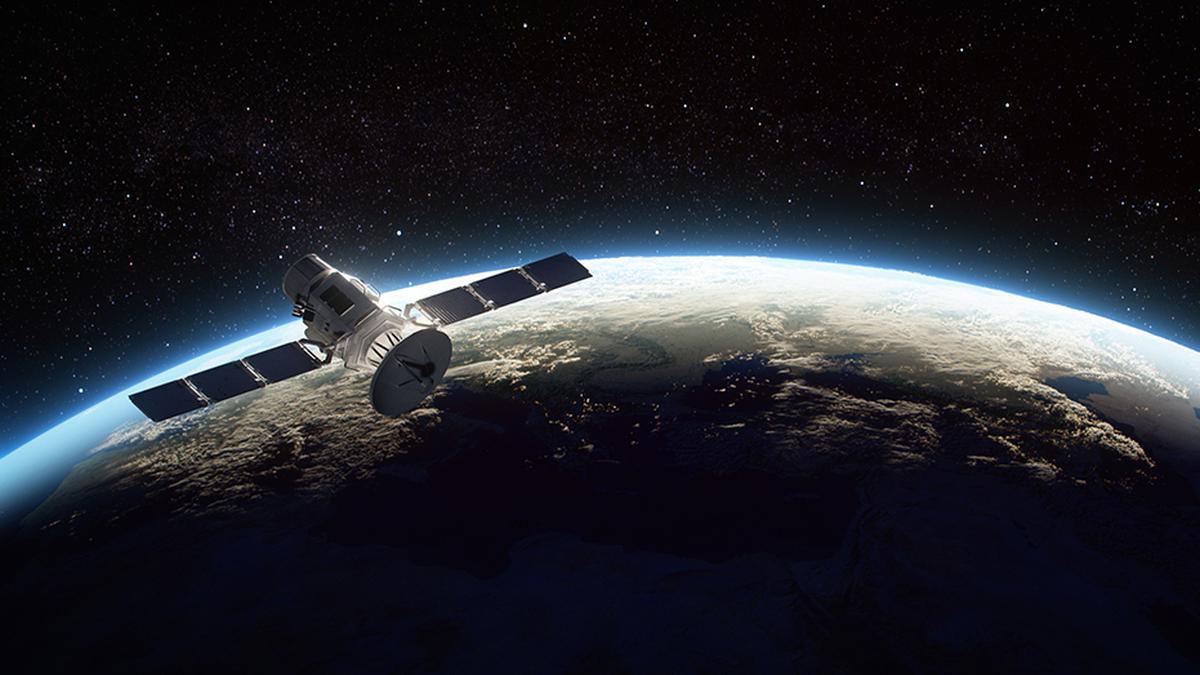
- 02 Jul 2025
In News:
Building on critical lessons from Operation Sindoor, where satellite surveillance played a pivotal role in precision military responses, the Union Government has decided to fast-track the launch of 52 dedicated surveillance satellites. The move is aimed at enhancing real-time, all-weather, and round-the-clock monitoring of India’s land and maritime borders, particularly with China and Pakistan.
The decision comes amid growing emphasis on space-based intelligence, surveillance, and reconnaissance (ISR) capabilities to counter modern threats, including drones and hypersonic weapons.
SBS-III Programme: Overview
The Space-Based Surveillance-III (SBS-III) programme was approved in October 2023 by the Cabinet Committee on Security (CCS) chaired by the Prime Minister. It is India’s most ambitious defence space project to date.
Key Features of SBS-III:
- Total Satellites: 52 dedicated military satellites
- ISRO: Will build and launch 21 satellites
- Private Sector: Will develop 31 satellites
- Launch Timeline:
- First launch by April 2026
- Full constellation targeted by end of 2029
- Project Cost: ?26,968 crore (approx. $3.2 billion)
- Supervising Agency:Defence Space Agency (DSA) under the Integrated Defence Staff (IDS), Ministry of Defence
Strategic Objectives and Capabilities
- Surveillance Reach and Coverage
- Wider coverage of China, Pakistan, and Indian Ocean Region (IOR)
- Reduced revisit times: Faster and more frequent imaging of sensitive areas
- Capability to monitor airfields, military bases, and staging grounds deep inside adversary territory
- Operational Orbits
- Satellites to operate in both Low Earth Orbit (LEO) and Geostationary Orbit (GEO) for layered coverage
- Designed to counter China’s anti-satellite (ASAT) capabilities including kinetic and electronic warfare systems
Technology and Innovations
- Artificial Intelligence (AI) Integration
- Satellites will use AI-powered decision-making to enhance image processing, target detection, and threat identification
- Ability to interact with each other and form a Geo-Intelligence (GeoInt) network for real-time intelligence sharing
- Small Satellite Launch Vehicles (SSLV)
- ISRO to transfer SSLV technology to private players
- Enables rapid satellite deployment during emergencies, ensuring strategic agility and resilience
Lessons from Operation Sindoor
During Operation Sindoor, Indian defence forces used satellite-based surveillance to track drone and missile trajectories, providing precise actionable intelligence. This success underscored the need for:
- High-resolution radar imaging
- Day-night and all-weather capabilities
- Faster intelligence turnaround time
These operational insights directly influenced the SBS-III mission design and its urgency.
Defence Space Agency (DSA)
- Established in 2019, replacing the Integrated Space Cell
- Operates under the Ministry of Defence’s Integrated Defence Staff (IDS)
- Coordinates with ISRO, DRDO, and Armed Forces on:
- Space warfare strategy
- Protection of Indian space assets
- Integration of ISR data with battlefield operations
Eight Years of GST
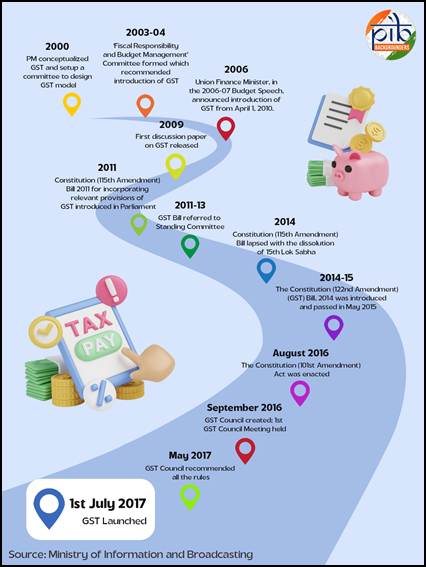
- 02 Jul 2025
In News:
The Goods and Services Tax (GST) was implemented on 1st July 2017, aiming to unify India’s fragmented indirect tax system into a single, nation-wide tax. It replaced multiple central and state levies such as excise duty, service tax, VAT, and others.
By simplifying the tax structure and improving transparency, GST aimed to enhance compliance, remove tax cascading, and create a common national market. As of 1st July 2025, GST has completed eight years.
Key Highlights of 2024–25
- In the financial year 2024–25, GST collections reached an all-time high of ?22.08 lakh crore, representing a growth of 9.4% over the previous year. The average monthly collection was ?1.84 lakh crore. The number of active GST taxpayers crossed 1.51 crore.
- According to the Deloitte GST@8 survey, 85% of respondents across industries reported a positive experience with GST, highlighting improvements in compliance, transparency, and ease of doing business.
Structure of the GST System
Components of GST
GST operates under a dual model:
- Central GST (CGST) and State GST (SGST) for intra-state transactions.
- Integrated GST (IGST) for inter-state transactions and imports.
Rate Structure
The GST Council has approved a multi-tier rate structure:
- Standard slabs of 5%, 12%, 18%, and 28% apply to most goods and services.
- Special lower rates include 0.25% on rough diamonds, 1.5% on cut and polished diamonds, and 3% on gold, silver, and jewellery.
- A Compensation Cess is levied on select goods such as tobacco, aerated drinks, and luxury cars to compensate states for revenue loss during the transition.
Key Features of GST
- Destination-Based Tax: GST is levied at the place of consumption, rather than origin. This ensures equitable revenue distribution and smooth credit flow across the supply chain.
- Input Tax Credit (ITC): Businesses can claim credit for taxes paid on inputs. This eliminates the cascading effect of taxes and reduces overall costs.
- Threshold Exemption: Small businesses with turnover below ?40 lakh for goods and ?20 lakh for services are exempt from GST, reducing the compliance burden on micro-enterprises.
- Composition Scheme: Businesses with turnover up to ?1.5 crore (goods) and ?50 lakh (services) can opt for a simplified tax scheme with fixed rates and minimal paperwork.
- Digital Compliance: All processes—from registration to return filing and payments—are conducted online through the GSTN portal. This digital-first approach enhances transparency and efficiency.
- Sector-Specific Exemptions: Essential sectors such as healthcare and education are either exempt or taxed at concessional rates to ensure affordability.
- Revenue Sharing: GST enables seamless credit transfers and transparent revenue sharing between the Centre and States, strengthening cooperative fiscal federalism.
Impact of GST
On MSMEs
- GST has provided major relief to micro, small, and medium enterprises by raising exemption thresholds and simplifying compliance. The introduction of the composition scheme allows them to pay tax at a flat rate with simplified filing.
- The Trade Receivables Discounting System (TReDS) has also expanded access to credit. As of May 2024, four digital platforms were operational, with over 5,000 buyers and 53 banks and 13 NBFCs registered as financiers.
- Other initiatives include quarterly return filing for businesses with turnover up to ?5 crore and SMS-based NIL return filing, reducing administrative hassle for small taxpayers.
On Consumers
- GST has benefited consumers by lowering tax rates on essential goods such as cereals, edible oils, sugar, and snacks. A study by the Finance Ministry found that GST led to an average household saving of 4% in monthly expenses.
- The expansion of the tax base from 60 lakh registered taxpayers in 2017 to over 1.51 crore in 2025 has enabled the government to rationalize rates further.
On the Logistics Sector
- The removal of inter-state check posts and the introduction of e-way bills have significantly improved logistics efficiency. Transport time has reduced by over 33%, and businesses no longer need to maintain warehouses in every state. This has facilitated the creation of centralized, tech-enabled supply chains.
Revenue Performance Over Time
Since its launch, GST collections have shown consistent growth. In 2020–21, collections stood at ?11.37 lakh crore. They rose to ?14.83 lakh crore in 2021–22, ?18.08 lakh crore in 2022–23, ?20.18 lakh crore in 2023–24, and finally to ?22.08 lakh crore in 2024–25. This reflects improved compliance, economic recovery, and digital enforcement.
GST Council and Its Role
Constitutional Basis: The GST Council was constituted under Article 279A of the Constitution following the passage of the 122nd Constitutional Amendment Act. The Council was formally set up after Presidential assent on 8th September 2016.
Composition: The Council includes:
- Union Finance Minister as Chairperson
- Union Minister of State (Finance/Revenue)
- State Finance Ministers
- Special representation in case of constitutional emergency (Article 356)
Major Decisions: Since its inception, the GST Council has met 55 times and taken several reform-oriented decisions:
- Introduced e-way bills, e-invoicing, and the QRMP scheme
- Reduced GST on under-construction affordable housing from 8% to 1%
- Lowered GST on electric vehicles from 12% to 5%, and exempted large EV buses
- Streamlined compliance through auto-populated returns and QR codes
- Rationalized GST slabs, reducing items in the 28% slab from 227 to 35
- Set up GST Appellate Tribunals with Principal Bench in New Delhi
- Rolled out Aadhaar-based biometric authentication and clarified rules for vouchers
- Recommended full GST exemption on gene therapy and a legal framework for Invoice Management System
Skills for the Future
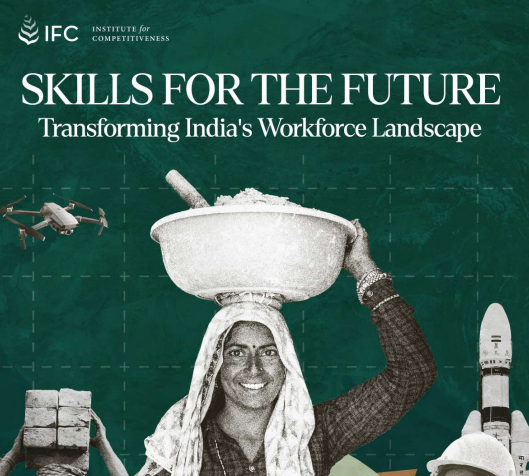
- 01 Jul 2025
In News:
Recently, theUnion Minister Jayant Chaudhary (MoS, Independent Charge – Ministry of Skill Development and Entrepreneurship, and MoS – Ministry of Education) unveiled the report "Skills for the Future: Transforming India’s Workforce Landscape", prepared by the Institute for Competitiveness (IFC). This data-driven report critically analyses India’s skilling ecosystem using PLFS 2023–24 and other datasets.
Significance of Skilling for India’s Development
- Demographic Dividend: India has one of the world’s youngest populations. Skilling is crucial to leverage this before population ageing sets in (by 2047).
- Economic Growth: A 1% rise in Gross Enrolment Ratio (GER) at the tertiary level increases GDP by 0.511% (Parika, 2020).
- Employment Creation: India needs to create 5 lakh non-farm jobs annually till 2030 (Economic Survey 2023–24).
- Global Competitiveness: Leadership in EVs, AI, biotechnology, and green energy demands a future-ready workforce.
Key Findings from the Report (PLFS 2023–24 Based)
1. Skill Distribution
- 88% of India’s workforce is in low-competency jobs (Skill Levels 1 & 2).
- Only 10–12% are employed in high-skill roles (Skill Levels 3 & 4).
- Only 4.5% of the workforce has received formal vocational training.
2. Education-Skill Mismatch
- Only 8.25% of graduates are in roles matching their skill level.
- Over 50% of graduates are employed in lower-skill jobs.
- Severe case of overqualification and underutilization of educational capital.
3. TVET and Sectoral Gaps
- Top 5 Sectors (66% of vocational enrolment):
- Electronics
- IT & ITeS
- Textiles & Apparel
- Healthcare & Life Sciences
- Beauty & Wellness
- Skill Deficits are critical in high-growth sectors like green tech, AI, biotech, and EVs.
4. Wage Inequality by Skill Level
Skill Level Avg. Annual Wage
Level 1 Rs.98,835
Level 2 Rs.1.26 lakh
Level 3 Rs.2.81 lakh
Level 4 Rs.3.94 lakh
46% of the workforce earns less than ?1 lakh/year, highlighting a major economic disparity.
5. Regional Disparities
- Low-Skilled States: Bihar, Assam (95% in Skill Levels 1 & 2)
- Higher-Skill States: Kerala, Chandigarh
- Migration and brain drain observed in low-skill, low-growth regions
Challenges Identified
- Skill-Education Mismatch: Graduates in low-skill jobs; vocational roles filled by underqualified informal workers.
- Weak TVET-Industry Linkage: Existing courses not aligned with Industry 4.0 or green economy needs.
- Low GER and Transition Dropout: Higher secondary GER at 57.56%, tertiary GER still below 30%.
- Gender & Social Exclusion: Low skilling access for women, SC/STs, rural youth.
- Data & Outcome Gaps: No central skill repository or real-time job-skill tracking.
Recommendations from the Report
- Institutional Reforms
- Launch a National Skill Gap Survey
- Establish a Central Skill Data Repository for real-time, evidence-based policymaking
- Curriculum & TVET Overhaul
- Update NCO codes (National Classification of Occupations)
- Integrate vocational training in schools
- Scale up PMKVY, NAPS, and credit-linked certifications
- Industry & Market Linkages
- Incentivise hiring of certified skilled labour
- Link industry wage structures to skill certifications
- Encourage industry-led training programs
- Targeted Inclusion & Regional Empowerment
- Empower State Skill Missions
- Prioritise high-potential regions and sectors
- Target women, SC/STs, informal sector workers
- Education Pipeline Strengthening
- Raise GER at higher secondary and tertiary levels
- Promote flexible, modular skilling programs for working populations and school dropouts
Digital Initiatives for Maritime Sector
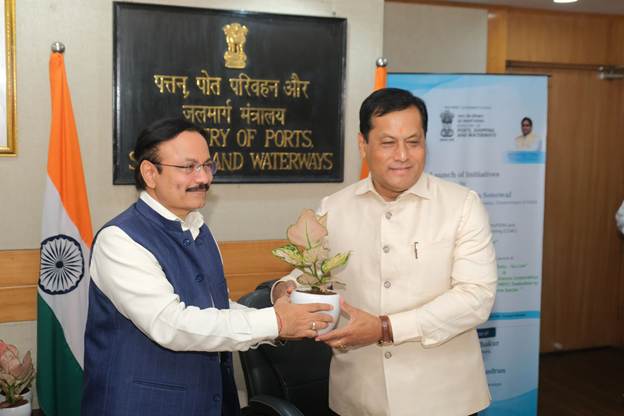
- 01 Jul 2025
In News:
Recently, the Union Minister for Ports, Shipping and Waterways, Shri Sarbananda Sonowal, launched a series of digital and sustainability-driven initiatives aimed at modernising India’s maritime sector. These reforms are aligned with the Maritime India Vision 2030 and Amrit Kaal Vision 2047.
Major Digital and Policy Initiatives Launched
1. Digital Centre of Excellence (DCoE)
- MoU signed between: MoPSW and Centre for Development of Advanced Computing (CDAC)
- Objective: Accelerate digital transformation across Indian ports
- Key Features:
- Application of AI, IoT, Blockchain to optimize maritime logistics
- Drive real-time operational upgrades
- Support green and sustainable port operations
- Strategic Alignment: Supports Atmanirbhar Bharat, Viksit Bharat @2047
2. SAGAR SETU Platform
- Type: Unified digital interface for maritime trade and EXIM operations
- Go-Live Date: 26th June 2025
- Integration: Connects 80+ ports and 40+ stakeholders
- Objective:
- Streamline cargo and vessel documentation
- Enable paperless, seamless, and transparent logistics
- Improve Ease of Doing Business (EoDB)
- Linked with: PM Gati Shakti National Master Plan
3. DRISHTI Framework
- Full Form: Data-driven Review Institutional System for Tracking Implementation
- Purpose: Real-time monitoring of projects under Maritime India Vision 2030
- Key Pillars:
- KPI Monitoring
- Progress & Achievements Tracking
- Organisational Oversight
- Functional Cell Coordination
- Strategic Value: Informed decision-making, faster project delivery
4. Standardised Scale of Rates (SOR) Template for Major Ports
- Objective: Standardise port tariffs to remove inconsistencies and improve transparency
- Features:
- Uniform structure for port tariffs
- Digitally comparable rates across ports
- Ports retain flexibility for local economic conditions
- Expected Impact:
- Enhances investor confidence
- Improves user experience
- Aligns with global maritime practices
Sustainability & Clean Energy: Hydrogen Transition Roadmap
Gateway to Green Report
Title: Gateway to Green — Assessing Port Readiness for Green Hydrogen Transition in India
- Released by: Ministry of Ports in collaboration with the Indian Ports Association (IPA)
- Objective: Transform Indian ports into green hydrogen hubs by 2030
- Strategic Goals:
- Produce 5 million tonnes of Green Hydrogen by 2030
- Develop infrastructure for production, storage, and export
- Leverage India’s maritime geography for clean energy leadership
- Targeted Ports for Hydrogen Transition:
- V.O. Chidambaranar Port
- Paradip Port
- Deendayal Port
- Jawaharlal Nehru Port
- Mumbai Port
- Cochin Port
- Key Action Areas:
- Land allocation for hydrogen projects
- Demand stimulation and investor facilitation
- International collaborations for knowledge and finance
- Shared infrastructure models
Strategic Relevance for India
- Economic Impact:
- Enhances trade competitiveness and reduces logistics cost
- Modernises infrastructure to global benchmarks
- Boosts Make in India and port-led development
- Digital Governance:
- Promotes data-driven decision-making
- Enables real-time monitoring and performance tracking
- Environmental Sustainability:
- Aligns with India’s National Hydrogen Mission
- Ports act as catalysts for clean energy transition
International Potato Research Center
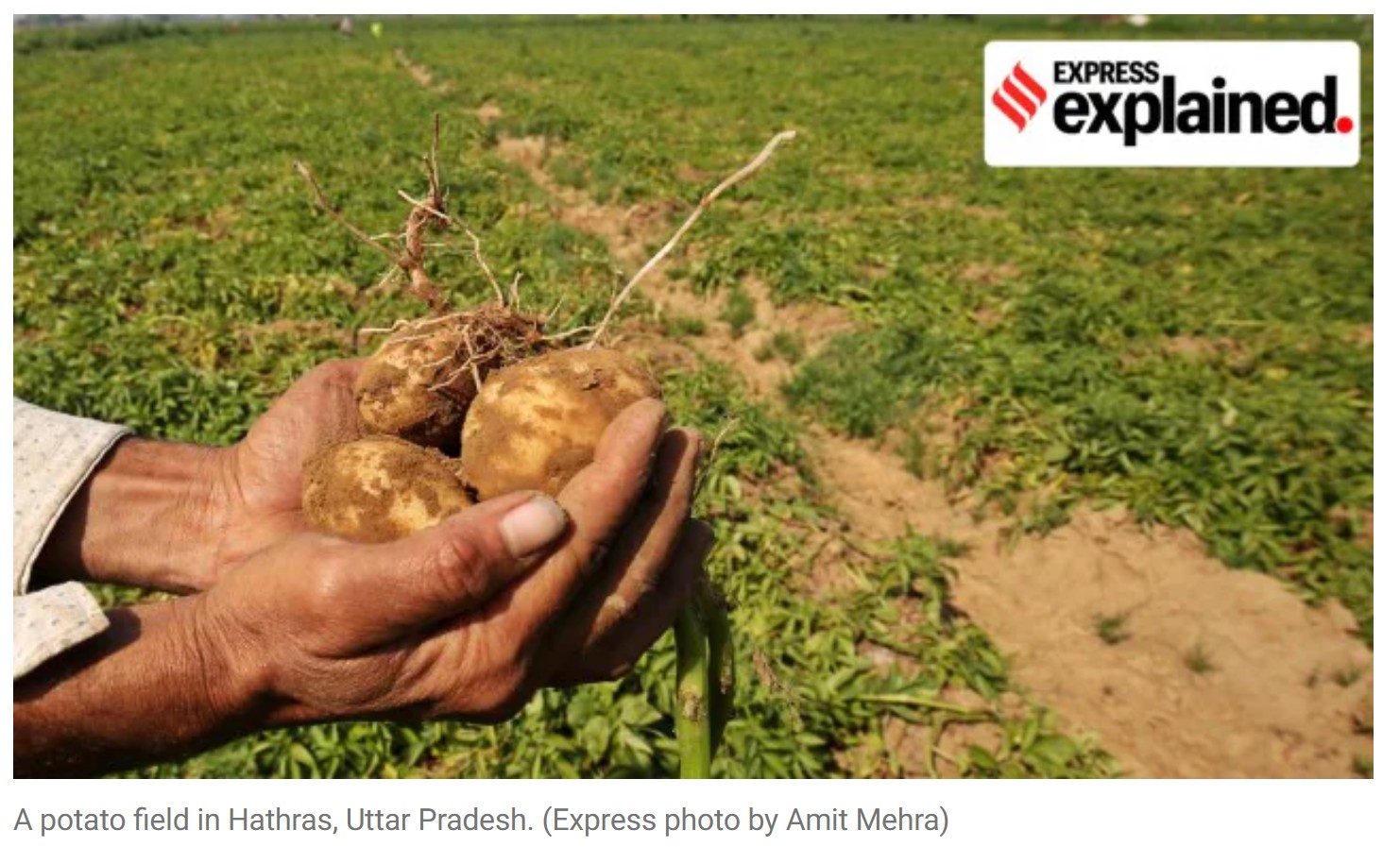
- 01 Jul 2025
In News:
- On June 25, 2025, the Union Cabinet approved the establishment of the CIP-South Asia Regional Center (CSARC) in Agra, Uttar Pradesh.
- The center will function as a regional wing of the International Potato Center (CIP) headquartered in Lima, Peru.
About CIP
- Founded: 1971
- Headquarters: Lima, Peru
- Focus Crops: Potato, Sweet Potato, and Andean roots & tubers
- Global Presence: South America, Africa, Asia
- India Operations: Since 1975, through partnership with ICAR
About CIP-South Asia Regional Center (CSARC)
- Location: Singna, Agra district, Uttar Pradesh
- Land Provided: 10 hectares (by UP Government)
- Total Project Cost: ?171 crore
- Indian Contribution: ?111.5 crore
- CIP Contribution: ?60 crore
- Implementing Ministry: Ministry of Agriculture & Farmers’ Welfare
Objectives of the Center
- Improve productivity of potato and sweet potato
- Promote climate-resilient, disease-free varieties
- Enhance post-harvest management and value addition
- Boost domestic seed production
- Support exports and food processing industries
- Increase farmer income, employment, and nutritional security
Why is this Significant?
- Potato is the 3rd most consumed crop globally (after rice and wheat)
- Sweet potato ranks 6th globally (after maize and cassava)
- India is the 2nd largest producer and consumer of potato
- Current average yield in India:
- Potato: ~25 tonnes/ha (Potential: >50 tonnes/ha)
- Sweet Potato: ~11.5 tonnes/ha (Potential: ~30 tonnes/ha)
- Establishment of CSARC will:
- Reduce dependency on seed imports
- Improve access to global germplasm
- Help bridge the yield gap
Global and National Context
- China is the largest potato producer (78.24 million tonnes, 2020)
- India is second (51.3 million tonnes, 2020)
- Top Potato-Producing States in India (2020–21):
- Uttar Pradesh (~15 million tonnes)
- West Bengal (~15 million tonnes)
- Bihar (~9 million tonnes)
Related Agricultural Research Institutions in India
- ICAR-CPRI, Shimla – Potato research
- ICAR-CTCRI, Thiruvananthapuram – Sweet potato and tuber crops
- IRRI-SARC, Varanasi – Regional center of International Rice Research Institute
CIP Centers Outside Peru
- China Center for Asia-Pacific (CCCAP) – Established in 2017 in Beijing, China
- India's CSARC (Agra) will be the second major CIP center outside Peru
Operation Bihali
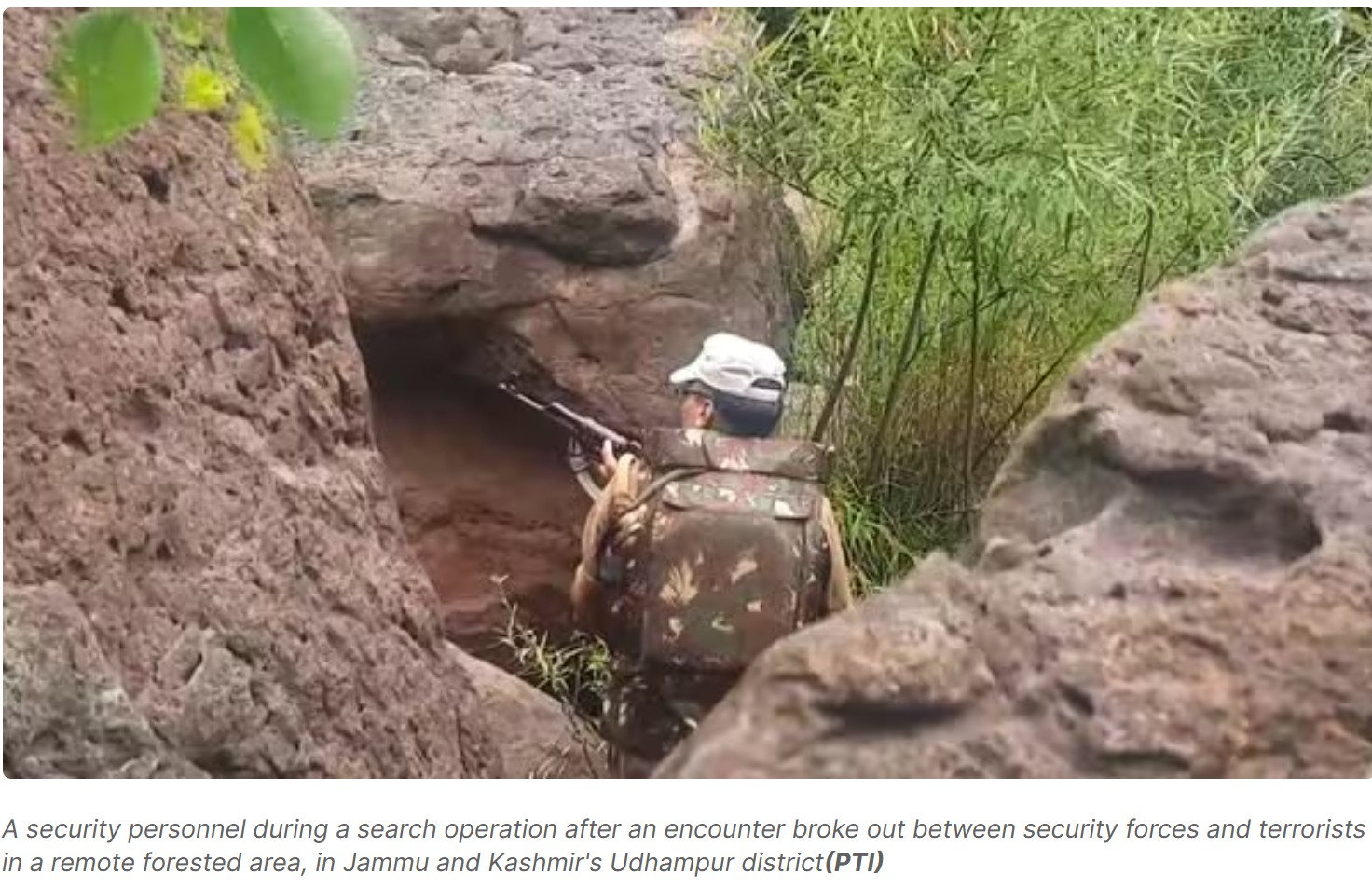
- 01 Jul 2025
In News:
A Jaish-e-Mohammad (JeM) terrorist was neutralized and three others were cornered in Operation Bihali, a high-risk counter-terror operation conducted in the Basantgarh area of Udhampur district, Jammu & Kashmir.
About Operation Bihali
Aspect Details
Type of Operation Counter-terrorism
Objective Neutralize a group of 4 JeM terrorists and prevent cross-border attacks
Location Basantgarh region, Udhampur district, J&K
Launched by Jointly by Indian Army Para Commandos and J&K Police
Operational Command Under the White Knight Corps
Intelligence Basis Based on 12 months of surveillance identifying the terrorist group
Key Significance
- Neutralization of JeM Threat: Thwarted potential attacks and ensured regional stability.
- Intelligence-Led Operation: Reflects enhanced surveillance and coordination between civil and military forces.
- Strategic Impact:
- Disrupted terror infiltration routes along sensitive zones.
- Reinforced India's proactive counter-insurgency posture in Jammu & Kashmir.
- Strengthened local security infrastructure in vulnerable border districts.
19th National Statistics Day
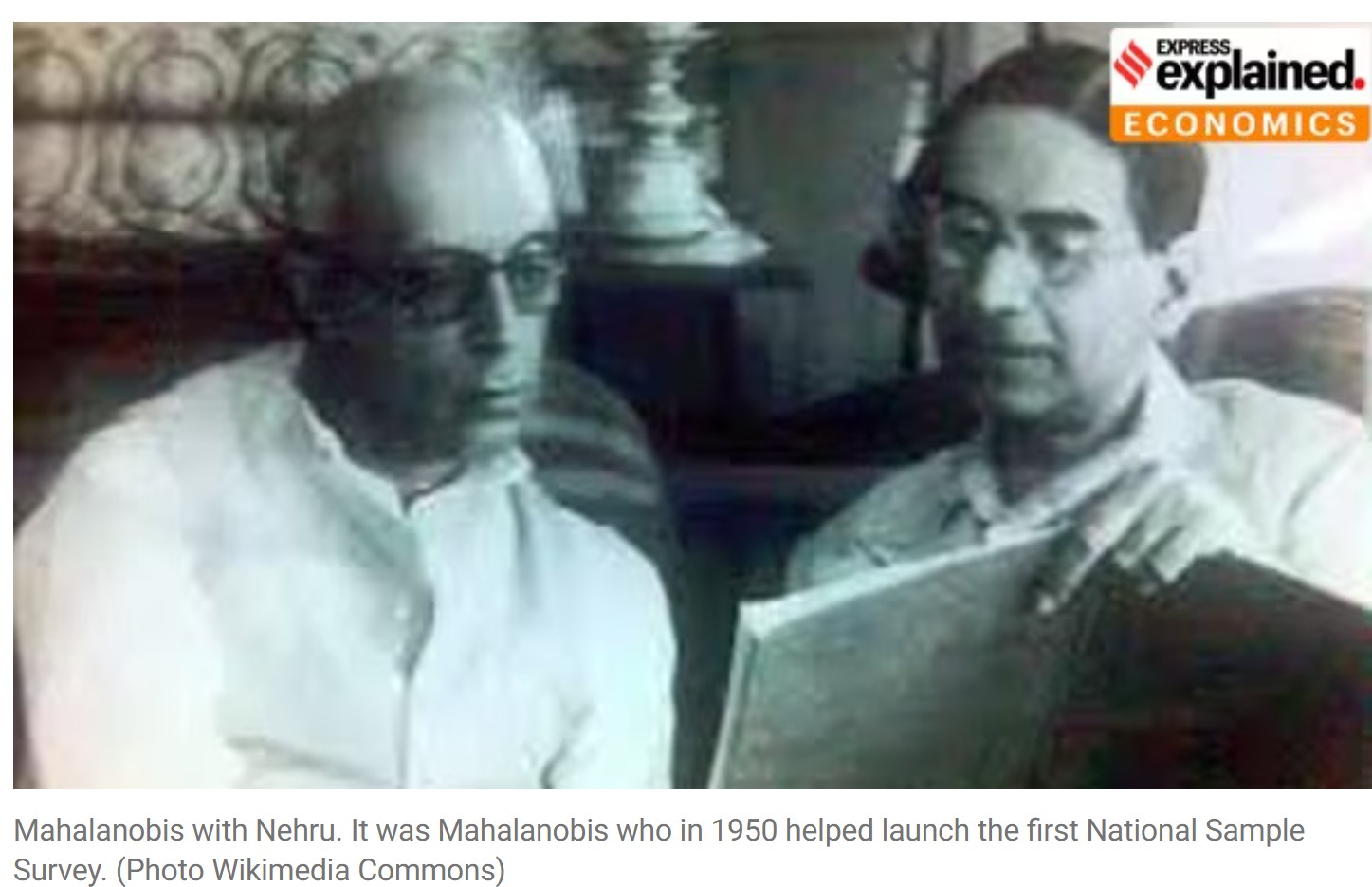
- 01 Jul 2025
In News:
MoSPI celebrates 19th Statistics Day honouring Prof. P.C. Mahalanobis and 75 years of National Sample Survey.
Key Highlights:
June 29 is observed as National Statistics Day in India to commemorate the birth anniversary of Prof. Prasanta Chandra Mahalanobis (1893–1972), widely regarded as the Father of Indian Statistics. The 2025 theme is "75 Years of National Sample Survey (NSS)".
The day is dedicated to promoting the role of statistics in nation-building and policy formulation, especially among the youth.
Key Contributions of P.C. Mahalanobis
1. Architect of India’s National Sample Survey (NSS)
- In 1950, Prof. Mahalanobis pioneered the National Sample Survey, India's first scientific and large-scale household data collection system.
- NSS is a large-scale, nationwide socio-economic data collection initiative conducted by the National Sample Survey Office (NSSO) under the Ministry of Statistics and Programme Implementation (MoSPI).
- Key Objectives of the NSS: Generate high-quality data to inform public policy, planning, and developmental programs.Conduct household surveys on:
- Consumption expenditure
- Employment & unemployment
- Health and education
- Migration and the informal sector
- Undertake the Annual Survey of Industries (ASI) to evaluate industrial performance.
- Support the agricultural sector by supervising crop area and yield estimation.
- Provide price statistics for rural and urban India to monitor inflation and cost-of-living changes.
- Key Features of the NSS
- All-India Scientific Coverage: Surveys conducted in both rural and urban areas using stratified multi-stage sampling methods.
- Organizational Structure – Four Major Divisions
Division Function
Survey Design & Research Division (SDRD) Survey planning, design, and methodology (HQ: Kolkata)
Field Operations Division (FOD) Data collection via 170+ regional offices (HQ: Delhi/Faridabad)
Data Processing Division (DPD) Data validation, tabulation, processing for surveys like PLFS & ASI
Survey Coordination Division (SCD) Coordinates survey activities and publishes Sarvekshana journal
- Multi-Thematic and Integrated Surveys
- Consumption patterns
- Employment trends (via Periodic Labour Force Survey - PLFS)
- Health and morbidity
- Education, migration, and social welfare indicators
- Support for Agriculture and Industry: Strengthens crop statistics and supports the ASI Web Portal for industrial data validation.
- Digital Integration & Real-Time Processing:Modernization efforts include urban sampling frame maintenance, tablet-based data collection, and real-time monitoring tools.
2. Mahalanobis Distance (1936)
- A multivariate statistical measure used to identify outliers and data anomalies.
- It quantifies the distance of a data point from a distribution, factoring in correlations between variables.
- Widely applied in fields such as public health, market research, and machine learning.
3. Flood Control and Environmental Planning
- In the 1920s, Mahalanobis used historical data to guide flood mitigation in Bengal and Odisha.
- His studies disproved incorrect assumptions (e.g., rising river beds) and recommended drainage improvements and dam construction.
- His early estimates contributed to the Hirakud Hydroelectric Project, inaugurated in 1957.
4. Institution Building: Founder of ISI & Sankhya Journal
- Founded the Indian Statistical Institute (ISI) in Kolkata in 1931, a premier research institute for statistics and mathematics.
- Launched ‘Sankhya’, India’s first statistical journal, fostering academic and applied research.
5. Role in National Planning & Technology Advocacy
- Chief architect of the Second Five-Year Plan, which introduced the Mahalanobis Model — emphasizing heavy industries and public sector-led growth.
- Advocated for digital computing in India. However, during the Cold War, the U.S. denied India access to the UNIVAC computer, fearing Mahalanobis’s pro-Soviet leanings.
Biographical Snapshot
Attribute Details
Born 29 June 1893, Kolkata (then Calcutta)
Education Presidency College; King's College, Cambridge
Field Statistics, Economic Planning, Data Science
Key Institutions Indian Statistical Institute (ISI), NSS, Planning Commission
Died 28 June 1972
